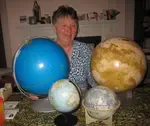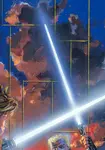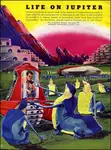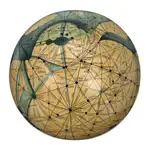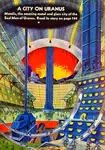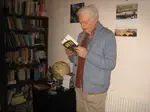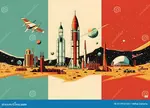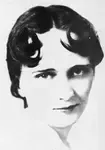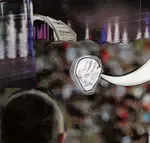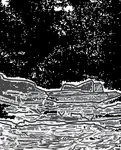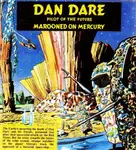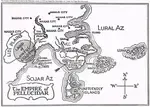- Home
- >
gazetteer
of the
haunted worlds:
fictional auras of really mapped places
on the earth, the moon and mars
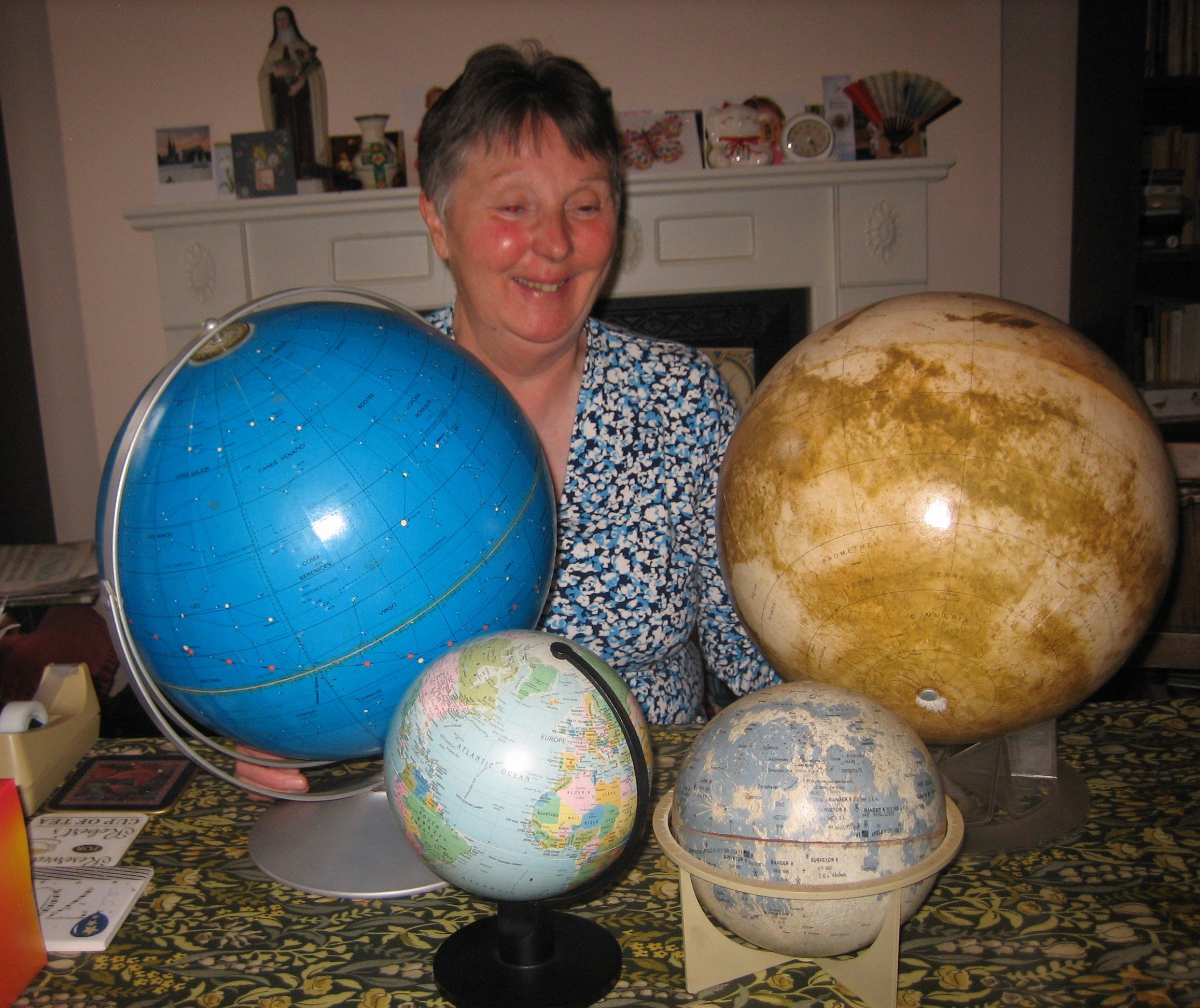 My spouse hugging the celestial orbs
My spouse hugging the celestial orbsNote from Zendexor: This page, begun 19th November 2023, was conceived in the hope that it might encourage readers to appreciate the double story/fact dimension of our Earth-Moon system, replete as it is with names that are mentioned both fictionally and realistically, its truths thus borrowing a shimmer from the glorious and limitless iconography of the sf imagination. The further decision to include some Martian references is discussed in Extending the Gazetteer to cover Mars.
Note added 21st June 2024: Stretching the definition of "fictional aura" I have added the might-have-been aura of landing sites that were never used, planned for the cancelled lunar missions of Apollo 18, 19 and 20.
[ + link to: America's own haunting ]
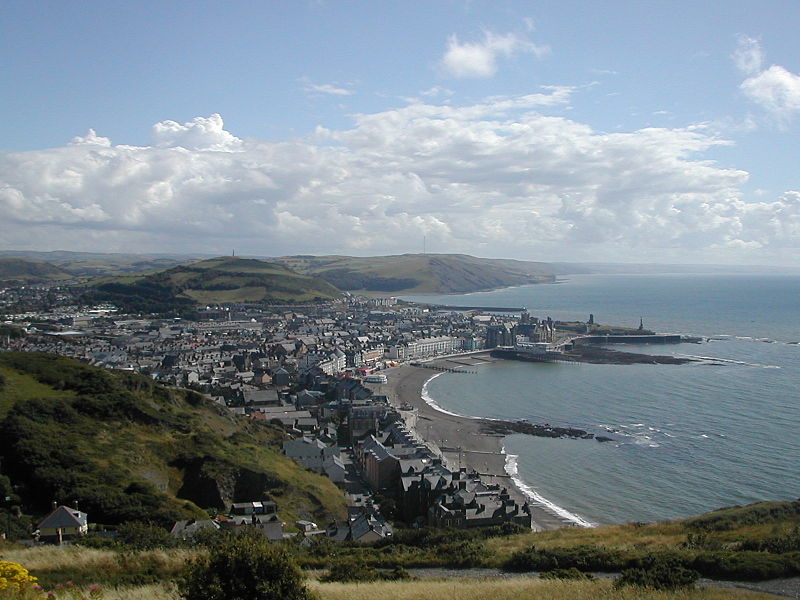
Aberystwyth, Ceredigon / Cardiganshire, Wales:
Spaceman Chris Godfrey visits a cantankerous old scientist who may be the only hope left to save the world from the falling Moon, in Hugh Walters' The Last Disaster (1978):
...The old man, with Chris following, went out to the recently cut lawn. In the distance Chris could see the town of Aberystwyth, and beyond that glistened the sea. Over to the left was the Professor's beloved University, home of one of the finest collections of books in the world...
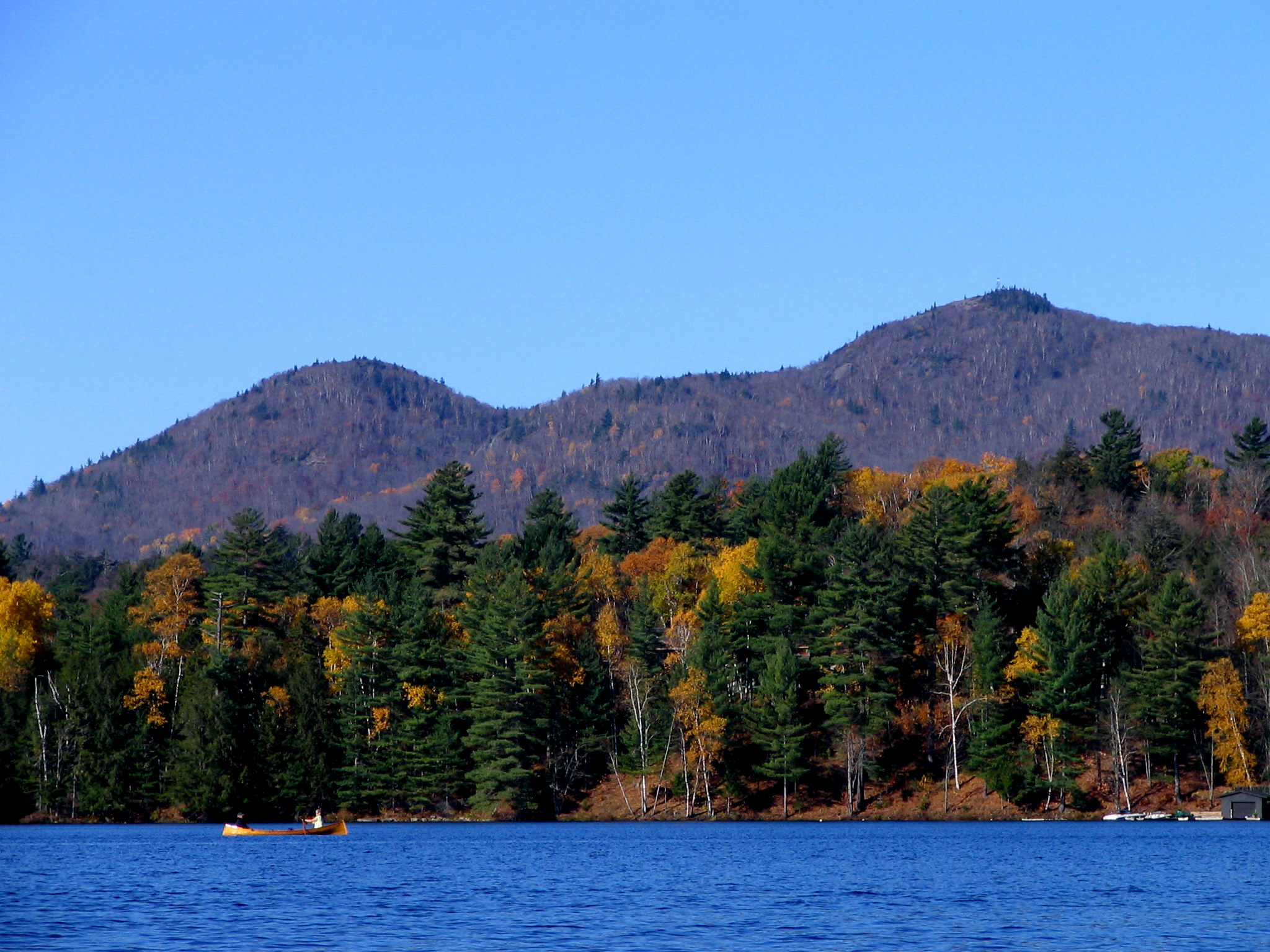 Upper St.Regis Lake
Upper St.Regis Lakethe Adirondacks, New York, USA:
While on a fishing holiday in the St Regis range of lakes in this mountain range, the narrator of Howard Fast's The Large Ant (Fantastic Universe, February 1960) sees an alien and instantaneously kills it in a fear-response, to his later consternation and regret.
...I keep trying to think back, to recreate the moment when I saw it standing at the foot of my bed in the fishing shack. I keep trying to dig out of my memory a clear picture of what it looked like...
The Adirondacks are the scene of a brief idyll snatched from the fight against the parasitic alien invaders from Titan in Heinlein's The Puppet Masters (1951). Agent "Sam" Nivens introduces his new bride to his mountain cabin:
...I found her staring at the shack. "Sweetheart, it's beautiful!"
"You can't beat the Adirondacks," I agreed. There was a slight haze with the sun low in the west, giving that wonderful, depth upon depth, stereo look.
She glanced at it and said, "Yes, yes - but I didn't mean that. I meant your - our cabin. Let's go inside, right now."
"Suits," I agreed, "but it's really just a simple shack." Which it was - not even an indoor pool. I had kept it that way; when I came up here I didn't want to feel that I had brought the city with me...
Aeria: See Sinus Sabaeus.
See also Syrtis Major, of which Aeria is the western boundary.
In Patrick Moore's Mission to Mars (1955), the first Martian expedition has crashed and transmits its position (p.29):
'Yorke calling Woomera. The "Hermes" has landed in latitude 10 north,
longitude 310... Our landing was faulty. Rocket is damaged beyond
repair...'
On p.32: '...We know where they are; if the position they gave us is correct, the "Hermes" is lying in the desert of Aeria, some way from the borders of the vegetation tracts that we call the Syrtis Major and the Deltaton Sinus...'
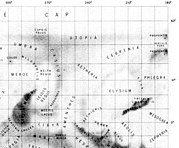 In the middle. South of Utopia and north-west of Elysium.
In the middle. South of Utopia and north-west of Elysium.Aetheria:
This is the region in which the protagonist's plane crash-lands, leading to an accidental discovery of vital importance - Martian fauna - in Arthur C Clarke's 1951 novel The Sands of Mars.
"There seem to be hills all around us: we were lucky to get down in one piece. Good Lord - there's a cliff here on this side - another few metres and we'd have gone smack into it!"
"Any idea where we are?" Gibson called to the pilot.
This tactless remark earned him a very stony stare.
"About 120 east, 20 north. The storm can't have thrown us very far off course."
"Then we're somewhere in the Aetheria," said Gibson, bending over the maps. "Yes - there's a hilly region marked here. Not much information about it."
"It's the first time anyone's ever landed here - that's why. This part of Mars is almost unexplored: it's been thoroughly mapped from the air, but that's all."
[Note that you won't find Aetheria on the official map of Mars' albedo features by using the co-ordinates mentioned in the above extract. Instead, the region is to be found at longitude 240. In other words, it appears one must subtract the 120 from 360, which suggests to me that some time between the 1950s and about 1970 there was a switch away from E and W figures and to a single-measure 0-360 longitude; somewhat analogous to a change from a.m./p.m. to a 24-hour clock.]
In Lin Carter's The City Outside the World (1977), the region gets a mention on page 34:
When they rode out of the Dragon Gate, they had headed due north, Ryker knew. They were now in one of the talcum-soft desert regions called "Dustlands", an empty space on the map which the old Earth astronomers had filled in with the name Aetheria...
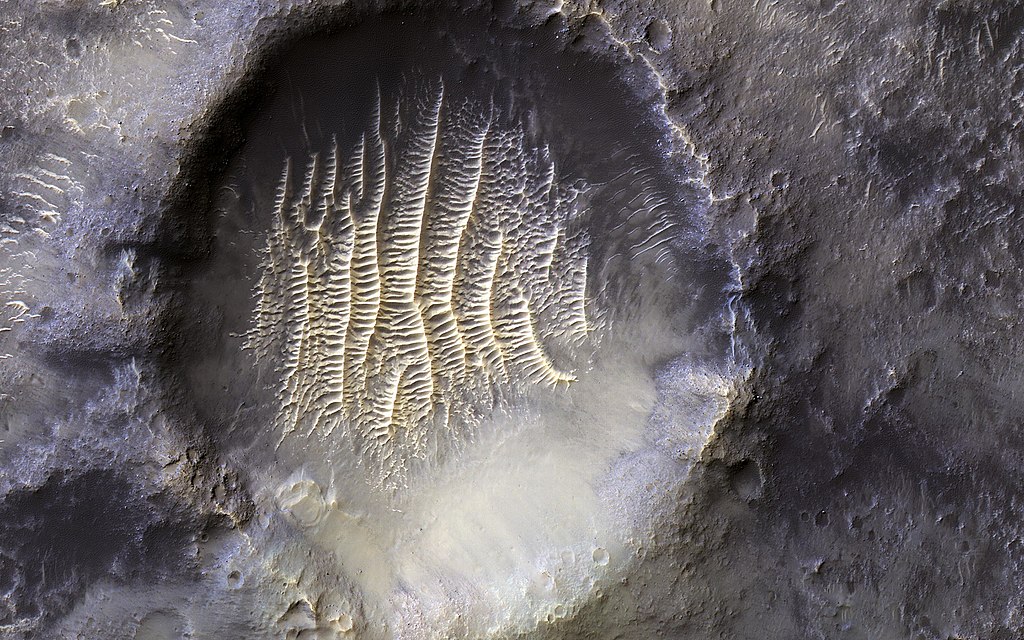
Airy:
This crater is the location of the Martian Prime Meridian (selected as such by the Mariner 9 Geodesy/Cartography Group in 1972). It is also where lies the hidden Martain Eden in the 1974 novel by Lin Carter, The Valley Where Time Stood Still, which is part of his tetralogy The Mysteries of Mars. See the extract, A secret valley below a mist-layer on Mars, and the subsequent comment by Lone Wolf.
Albuquerque, New Mexico, USA:
See the reference to Los Angeles' growth, in Fred and Geoffrey Hoyle's Fifth Planet (1963).
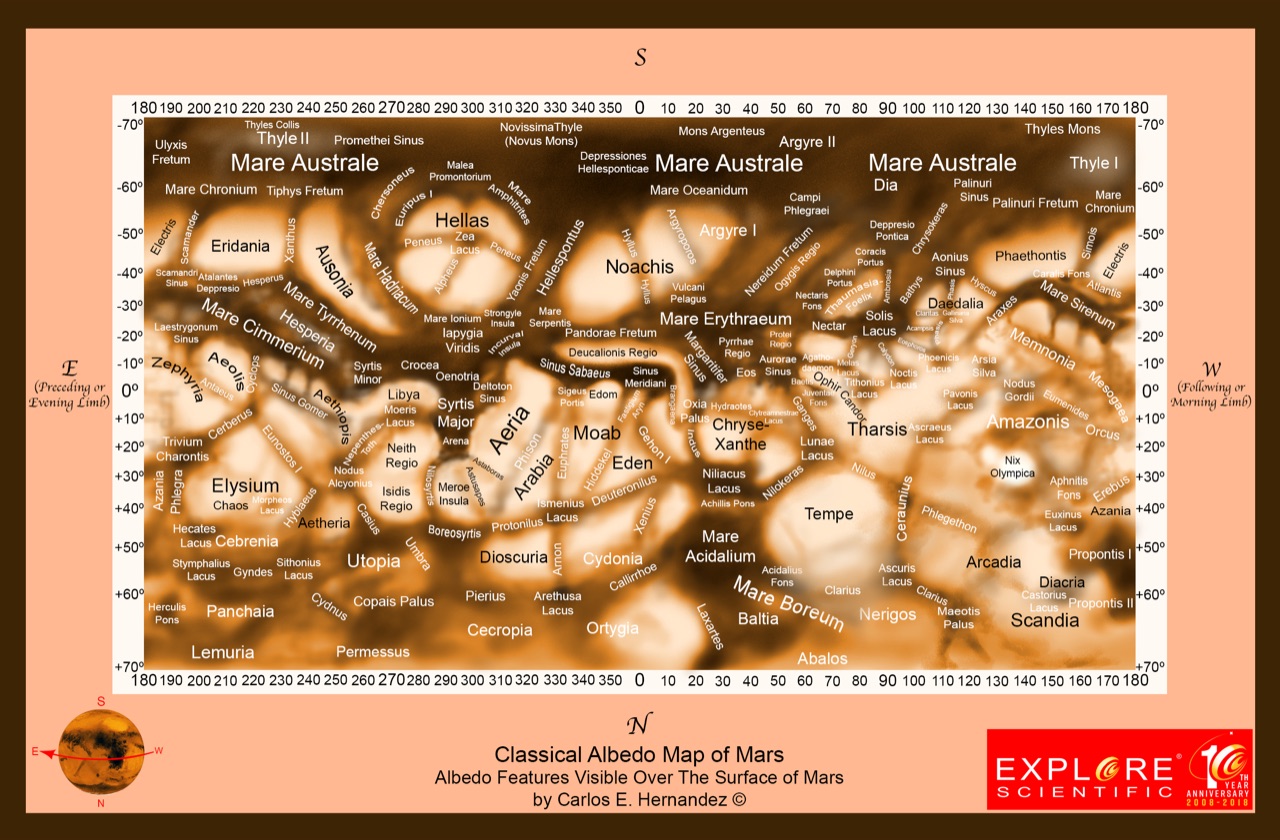 look for longtitude 250, latitude +30
look for longtitude 250, latitude +30Alcyonius Nodus:
From Lin Carter's 1977 novel The City Outside the World, page 34:
...West, however, they would only have to ride three hundred miles or so to reach the low, rocky hills of Alcyonius Nodus. There, at least, they could find shelter in the caves which the tides of ancient oceans had cut into the cliffs which had once been the coastline of an old continent. And, perhaps, they could find food as well...
And on page 50: ...The mesa of Alcyonius Nodus was as it had ever been, a barren tableland of dead, sterile rock. And it had been thus for millions of years, surely, or anyway since the great oceans of prehistoric Mars began to dry up. Once, perhaps, it had been a broad and fertile island, against whose cliffy shores the lost oceans had burst in shattering spray...
Aldershot, Hampshire (close to the border with Surrey), England:
This town's associations with the British Army gain it a brief mention in the eighth chapter of H G Wells' The War of the Worlds (1898):
...The military authorities were certainly alive to the seriousness of the business. About eleven, the next morning's papers were able to say, a squadron of hussars, two Maxims, and about 400 men of the Cardigan regiment, started from Aldershot...
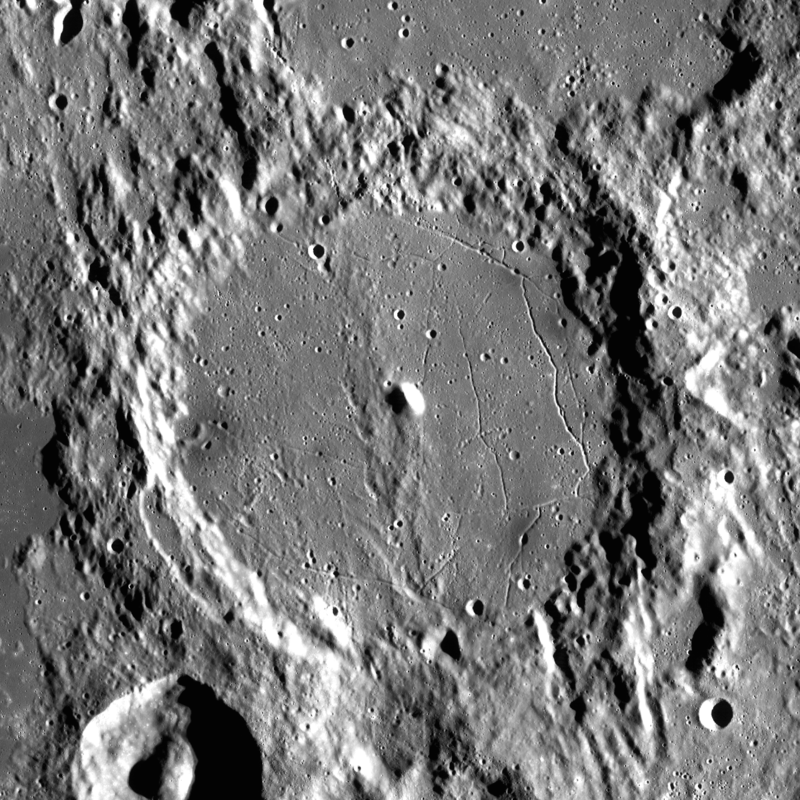 from Lunar Orbiter
from Lunar OrbiterAlphonsus:
Pioneer astronaut Jeff Stevens lands here in The Man in the Moon by Mack Reynolds (Amazing Stories, July 1950).
...He was down! Unbelievably, he was down. The Alice was resting on her hydraulic stilts in Alphonsus Crater; he'd succeeded - thus far...
...He peered through his plastic windows. The view wasn't as strange as it might have been; there were portions of New Mexico and Arizona which didn't look so very different. The ringwall surrounding the crater was high and spectacular, somewhat like the Sierra Nevadas seen from the east; the floor seemed to be covered with find sand or pumice, perhaps dust would be the more accurate term. A supreme wasteland, beautiful in its desolation...
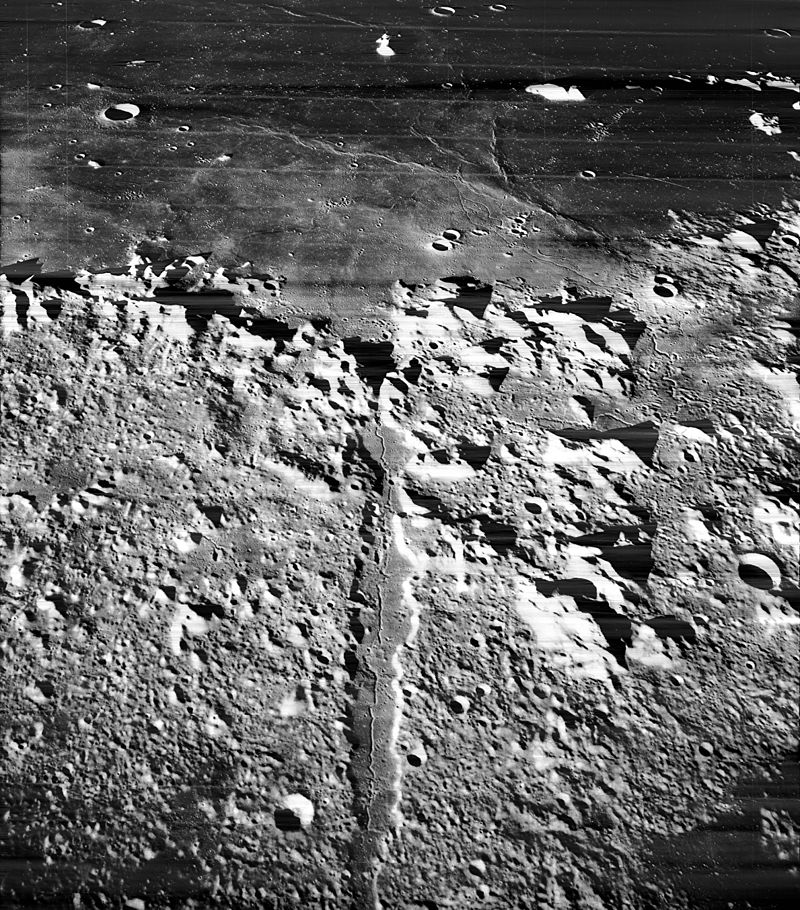 from Lunar Orbiter 5
from Lunar Orbiter 5the Alpine Valley:
Location of the lunar base of far-future Earth's corrupt Overseer, in The Fury Out of Time (1965), by Lloyd Biggle Jr.
The moon base was enormous. A gigantic dome pimpled with observation bubbles, it lay at the jagged edge of the Mare Imbrium, in the yawning mouth of the great Alpine Valley gorge. At the other end of a connecting tube was a smaller dome, the landing dome, and the complex viewed from above gave the impression of a lopsided dumbbell. Nearby were a number of lesser domes, surmounting a complex network of underground tunnels.
The base was enormous - and virtually empty. At some time in the distant past it had been a thriving city, perhaps a crucial steppingstone in man's first awkward lurch toward the stars...
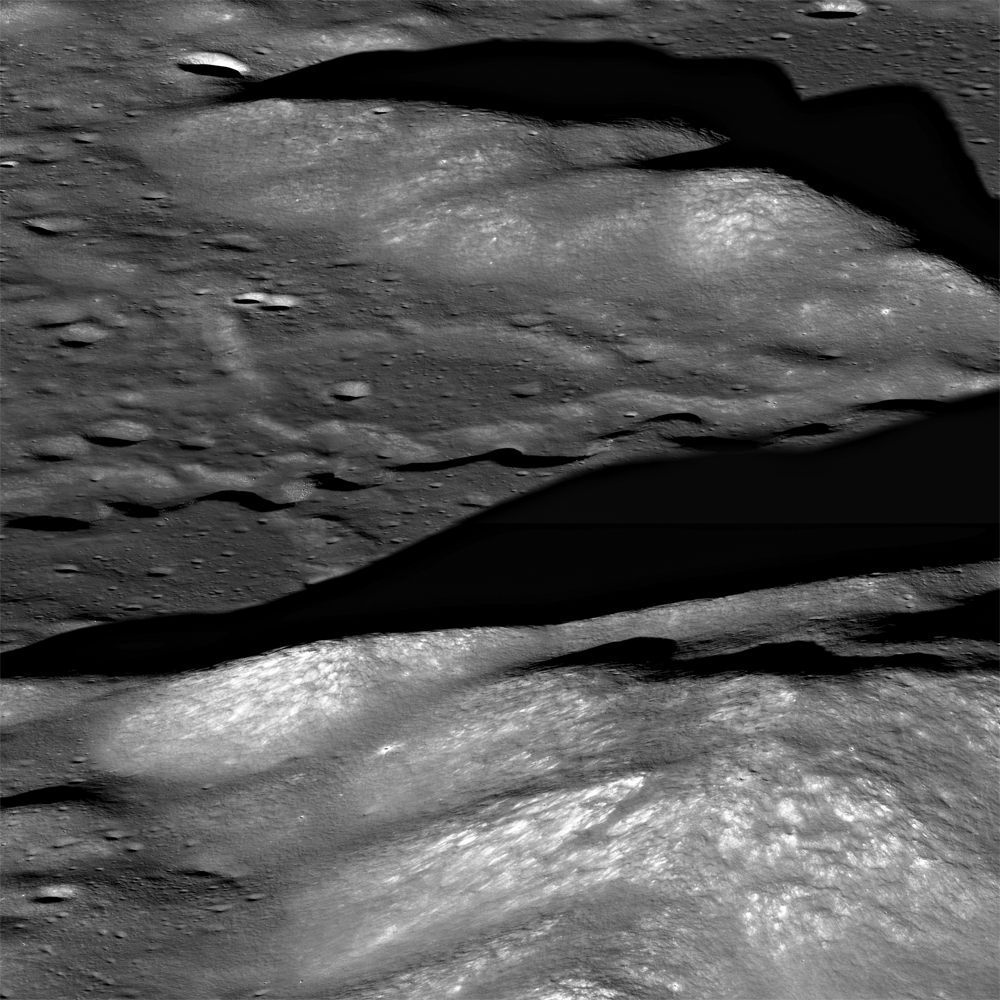
the lunar Alps:
In Poul Anderson's short story The Light (Galaxy, March 1957) the narrator, one of a crew of astronauts who think they are first on the Moon, says:
...we landed at the foot of the Lunar Alps, not far from the crater Plato. It was rugged country, but our gear had been designed for such a place...
...It was eerie. I've been in deserts on Earth, but they don't blaze so bright, they aren't so absolutely dead, and the rocks aren't so huge and razor-cornered. The southern horizon was hear; I thought I could see the surface curve away and tumble off into a foam of stars...
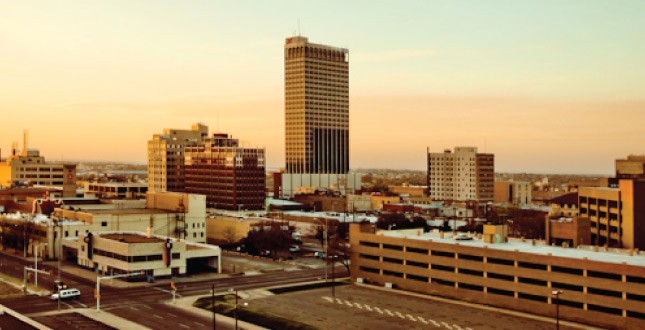
Amarillo, Texas, USA:
Miss Perth, secretary to Dr Eric Sweetscent in Philip K Dick's Now Wait for Last Year (1966), came from this city to work in Tijuana.
...this time she had sprayed herself a shiny blue, inlaid with sparkling fragments that reflected the outer office's overhead lighting... Miss Perth smiled at him engagingly, showing spotless ebony teeth, a chilling affectation which had migrated with her from Amarillo, Texas, a year ago...
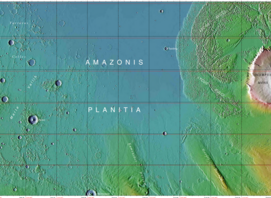
Amazonis, Mars: see Strymon.
The President of Texas sends a message to the Martians, with whom Earth is as war, suggesting a swap in order to negotiate the return of Private Terwilliger Appleby whose secret talents make him vital to the Terran war effort, in Evan Hunter's wacky tale, Terwilliger and the War Machine (Universe, September 1954):
"...Our offer follows: for the safe return of this man, we will exchange our ten billion dollar Death Ray machine. You will remember this devastating weapon as the same one which annihilated twelve of your men in the battle of Amazonis Bulge..."
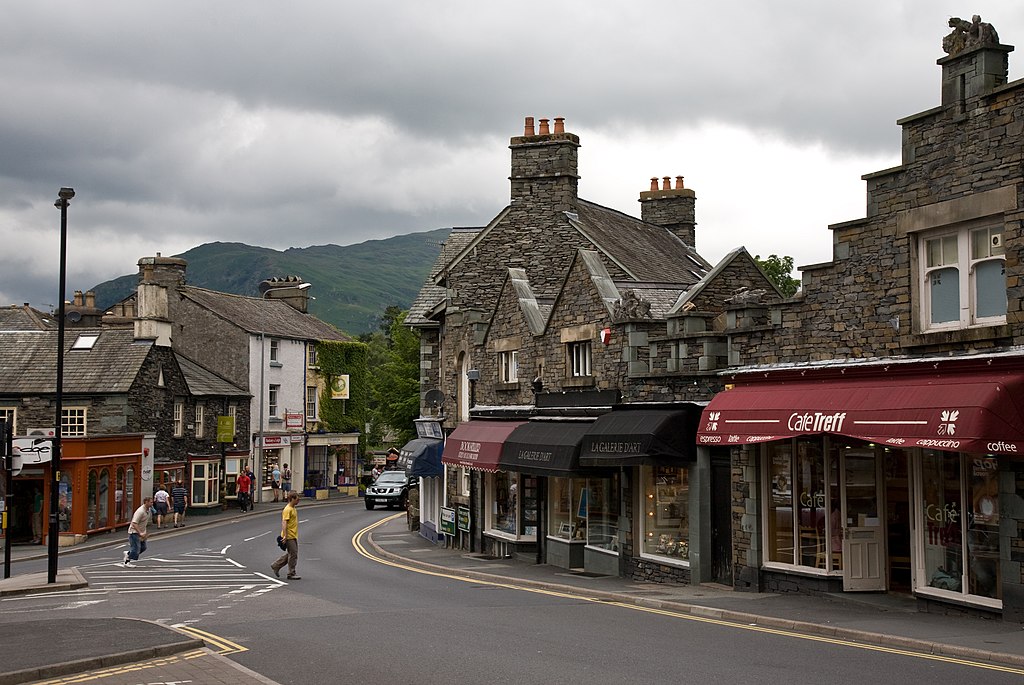
Ambleside, Westmorland, England:
One of the Lake District's most extremely beautiful towns, which I have often visited.
Somewhat strangely, it is also the fictional location of a secret government computer (a hundred feet underground) in the sf novel The Doomsday Brain (1967) by Paul Tabori.
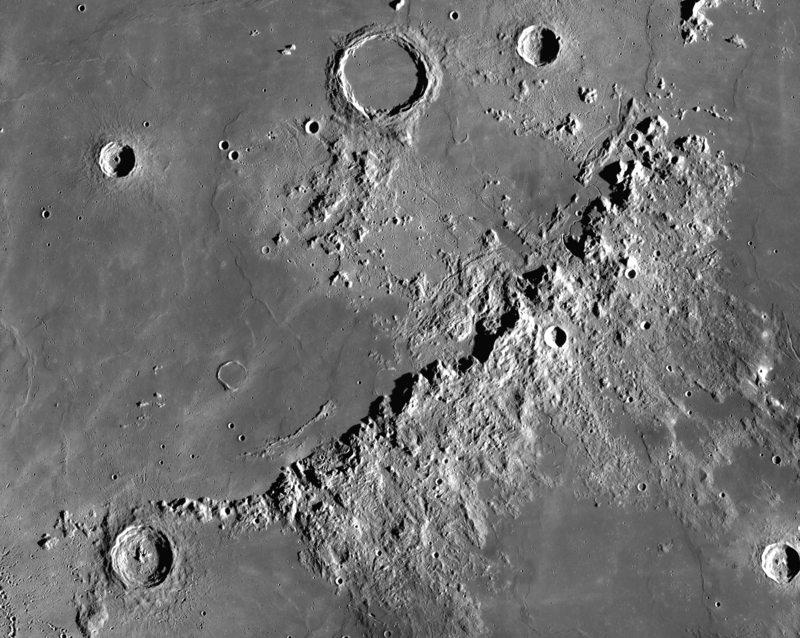
the lunar Apennines:
In the opening chapter of Earthlight (1955) by Arthur C Clarke, the protagonist is travelling by monorail from Sinus Medii to Plato at a time when the long lunar night is approaching. As the car emerges from behind a cliff his eyes are smitten by a sudden view of the mountain range whose summits are lit by the gradually setting Sun.
...There, marching across the sky in flaming glory, were the peaks of the Apennines, incandescent in the last rays of the hidden sun. The abrupt explosion of light left Sadler almost blinded; he shielded his eyes from the glare, and waited until he could safely face it again. When he looked once more the transformation was complete. The stars, which until a moment ago had filled the sky, had vanished. His contracted pupils could no longer see them: even the glowing Earth now seemed no more than a feeble patch of greenish luminosity. The glare from the sunlit mountains... had eclipsed all other sources of light.
The peaks floated in the sky, fantastic pyramids of flame. They seemed to have no more connection with the ground beneath them than do the clouds that gather above a sunset on Earth. The line of shadow was so sharp, the lower slopes of the mountains so lost in utter darkness, that only the burning summits had any real existence...
This area of the Moon suffers the attentions of the megalomaniac Mason Chard in the novella Life Eternal by Eando Binder (Thrilling Wonder Stories, February 1938):
"Mason Chard, the Immortal, speaks! I speak to all the Solar System, and to all of its so-called ruling element. My ship, the Invincible - formerly the Cometoid - hovers over the moon of Earth. You all know the illimitable powers of this ship, but I invite the eyes of Earth to watch the center of the moon, the mountain range known to astronomers as the Apennines. Watch it for the next hour!"
Millions of eyes on the night side of Earth watched and saw a small spark blaze in the center of the Lunar disc. It grew and widened until it was a fiery incandescent diamond, spewing out a shower of sparkles that spattered over the entire moon's face. Some terrific holocaust of supernal fire, comparable to the Sun's blazing furnace, was creating a deep, molten puddle on the moon! The Apennines are mentioned in the nineteenth-century novel by André Laurie
/Paschal Grousset/, The Conquest of the Moon: A Story of the Bayouda, London
1889 [original French edition: “Les Exilés
de la Terre: Selene Company Limited”, Paris 1887]) - see the extract, Discovery of an ancient monument on the Moon.
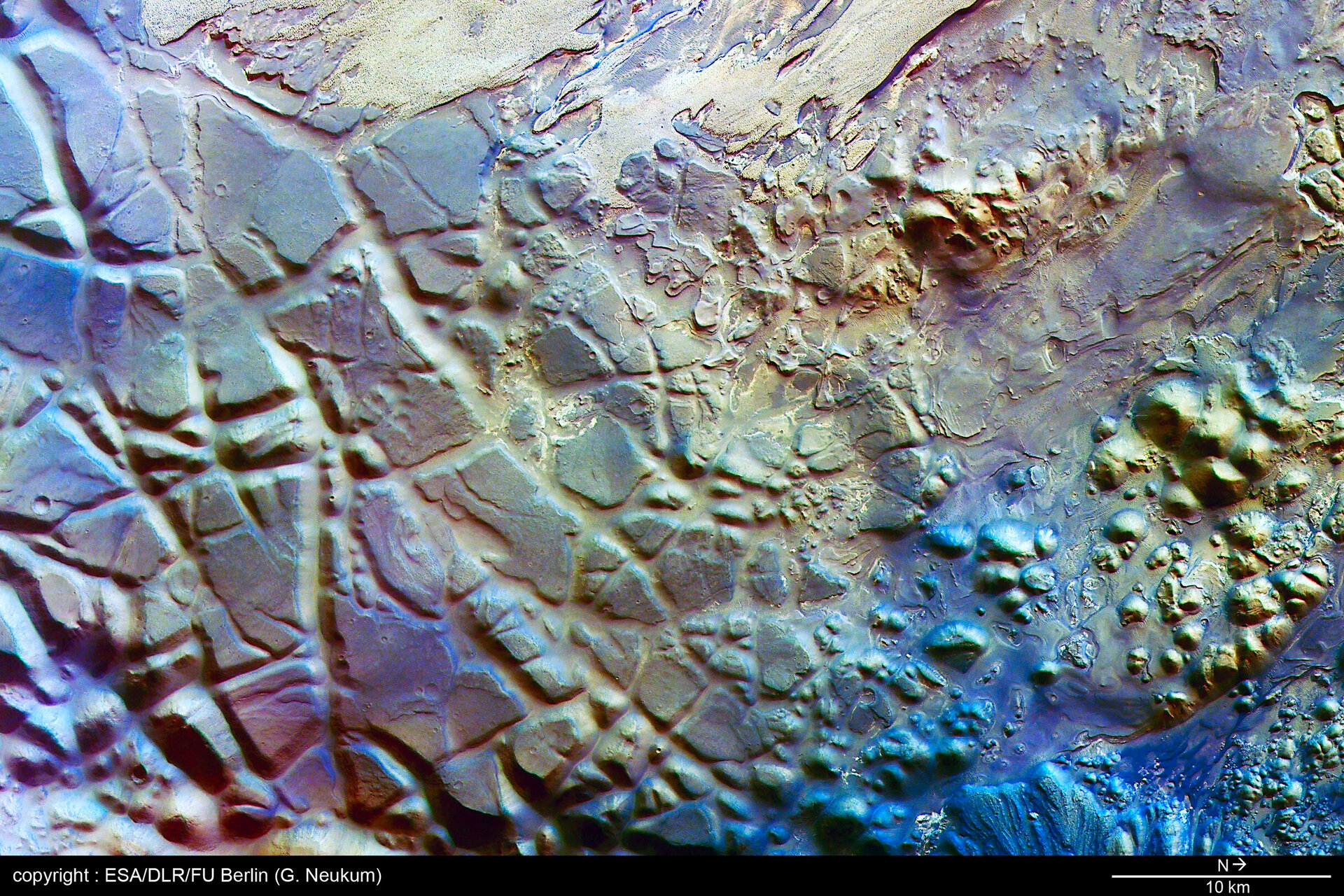 in false colour - very false for the Red Planet - but let the blue of Aram Chaos count as an emotional tinge for the story
in false colour - very false for the Red Planet - but let the blue of Aram Chaos count as an emotional tinge for the storyAram:
This is a region of Mars mentioned in Lin Carter's The Valley Where Time Stood Still (1974): the protagonist, M'Cord, encounters the native Thaklar
...on the Martian equator, at the northernmost tip of the Aram Desert.
However, in seeking a picture to go with this entry I was faced with a problem: how to deduce from the text whether to go for an image of Aram Dorsum or for one of Aram Chaos. Co-ordinates given online indicate that they are not far from each other, east of Margaritifer Sinus (this agrees with the text in the story) and in Arabia Terra. But what decided me was to learn online that Aram Dorsum is an alternative, newer term for Oxia Palus - which is mentioned elsewhere in the book! So the Aram Desert is a different stage on M'Cord's journey; hence, Aram Chaos it is, not Aram Dorsum.
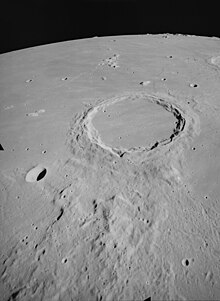 from Apollo 15
from Apollo 15Archimedes (crater):
See the extract from Ray Cummings' Brigands of the Moon (1930).
In Arthur C Clarke's The Secret (This Week, 11th August 1963), a top journalist is invited to the Moon, where from a politically embarrassed Medical Division he eventually hears the explosive secret of lunar longevity:
When he had landed at Archimedes Spaceport, the Chief Administrator had been obviously glad to see him, and had shown a personal interest in his tour. Transportation, accommotation, and official guide were all arranged. U.N.S.A. trusted him, for his stories had always been accurate, his attitude friendly. Yet the tour had gone sour; he did not know why, but he was going to find out.
He reached for the phone and said: "Operator? Please get me the Police Department. I want to speak to the Inspector General..."
Stranded spaceman Hansen, in H B Fyfe's Moonwalk (Space Science Fiction, November 1952), on his trek to reach safety, has to climb the crater's outer ringwall:
He was faced by a forty-five degree slope. If he could negotiate it for about thirty feet, he would reach another ramp. He looked down, and wondered if it would be easier to slide down to a lower terrace which would eventually lead higher than his present position.
"No time," he said dazedly.
He began to scrabble his way up the incline, not one too difficult to climb on Luna. The sun-powered rock [sic - should be sun-powdered?] flaked off beneath his hands, elbows, knees and feet. He slid back about as fast as he climbed...
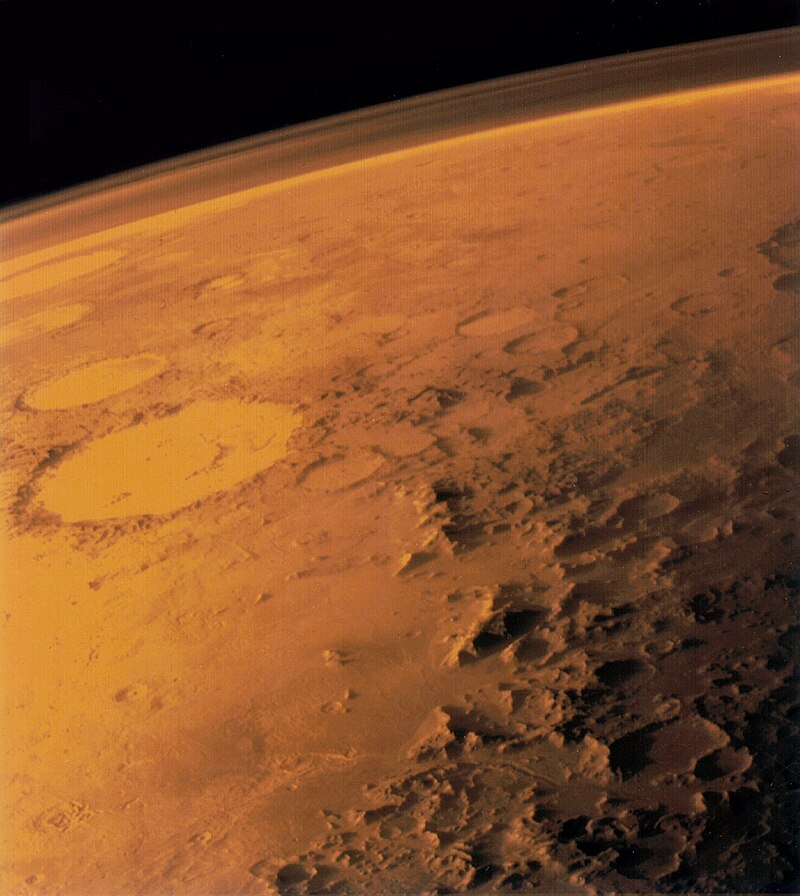 Argyre's southern rim, with crater Galle (Viking 1 orbiter image)
Argyre's southern rim, with crater Galle (Viking 1 orbiter image)Argyre:
The Sands of Mars (1951) by Arthur C Clarke contains one reference to this region. (Trigger warning: the extract contains the nasty k-word which tin-eared metrication freaks encourage as a substitute for "miles", and which I try to avoid using on this site; unfortunately it's rather embedded in Clarke's text.)
"...as there aren't any good roads on Mars, we have to take it easy. I'm doing sixty now. On rough ground you'll be lucky to average half that."
"And what about range?" said Mackay obviously still a little nervous.
"A good thousand kilometres on one charge, even allowing pretty generously for heating, cooking, and the rest. For really long trips we tow a trailer with spare power cells. The record's about five thousand kilometres; I've done three before now, prospecting out in Argyre. When you're doing that sort of thing, you arrange to get supplies dropped from the air."
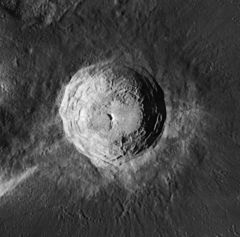
Aristarchus (crater):
This is the most active site on the Moon for observations of TLPs (Transient Lunar Phenomena), and thus a ripe candidate for tales unwritten about native lunar life. In published fiction, we have the following reference (of a different kind) in Imperial Earth (1975) by Arthur C Clarke:
"What about the Bank of Selene? Isn't it supposed to be more adventurous?"
"Don't believe all you've read about the Gnomes of Aristarchus; they're as careful as anyone else. They have to be. Bankers on Earth can still go on breathing if they make a bad investment..."
Cranky opinions, and statements which purport to be factual but which belong to pseudo-science rather than science, occupy a literary space in which fiction and non-fiction overlap. The science writer Charles A Wood refers to some interesting examples of this in his article Active Aristarchus? (Sky & Telescope, January 2003) in which he discusses observers' theories about the crater:
...One of its most remarkable features is a series of radial dark banks that stretch up the west wall. Keen-eyed amateur astronomers have observed these features for more than a century and have offered various theories to account for them, including the notion that the banks are vegetation...
the Aristarchus Plateau - see Schröter's Valley.
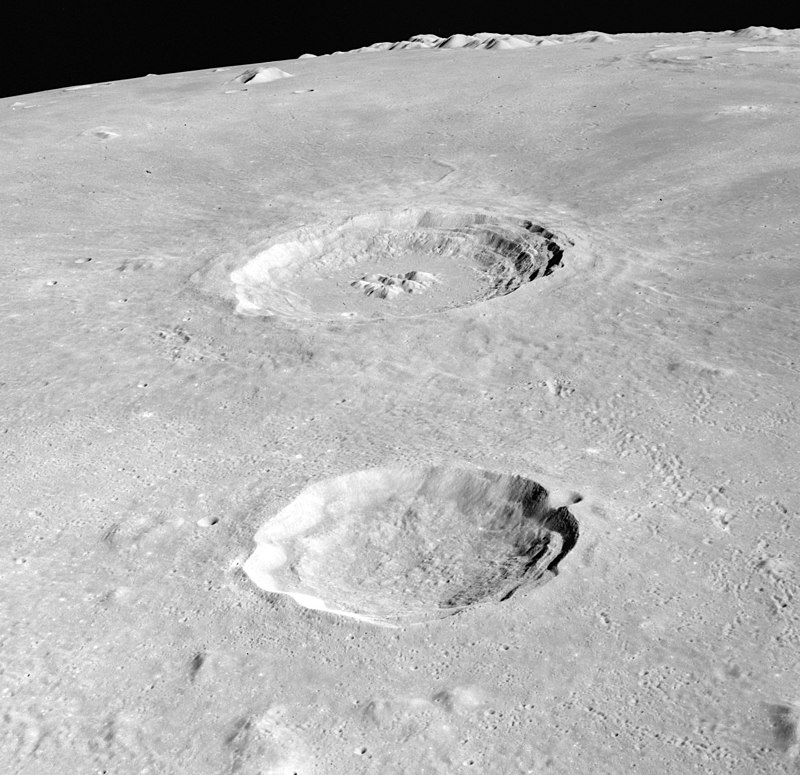 Aristillus (top) and Autolycus - from Apollo 15
Aristillus (top) and Autolycus - from Apollo 15Aristillus (crater):
Stranded astronaut Paul Hansen, in H B Fyfe's Moonwalk (Space Science Fiction, November 1952) is trying to trek to safety across the Mare Imbrium.
He saw that he was standing on higher ground lighter than usual, and tinted pale yellow. Remembering passing several areas, he slowly realized that they must be rays from Aristillus, traces of vaporized minerals blown out across the surrounding territory when the crater had been formed. It meant, for what it might be worth, that he was getting near Archimedes. Some of the rays of Aristillus reached the larger crater...
Arlington, Virginia, USA:
Paul Burke, assistant director of research in a government department, and the main protagonist in Jack Vance's The Brains of Earth (1966), is returned to Earth after a harrowing abduction during which aliens forcibly cleanse him of the invisible "nopal", a parasite whose absence causes more problems than its presence: people sense how he has changed, and their nopals insipire them with hostility.
....he came to the outskirts of Arlington, where he lived in an unpretentious apartment. A gnawing at the stomach reminded him that he had eaten nothing for eight hours, and then only a bowl of Xaxan porridge. In front of a brightly-lit sandwich-and-malt shop he slowed and halted, looked uncertainly through the windows. A group of teenagers lounged in knotty-pine booths; two young labourers in 'Frisco jeans sat hunched over hamburgers at the counter. Everyone seemed preoccupied with his own affairs, although all the nopal in the room shimmered nervously and peered out the window toward Burke...
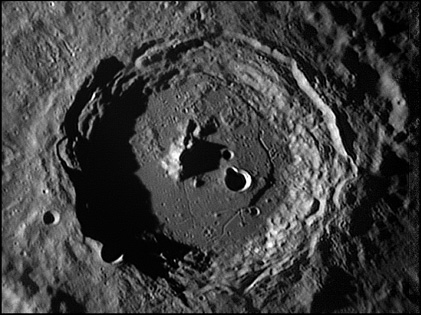
Arzachel:
From Mack Reynolds' The Man in the Moon (Amazing Stories, July 1950):
...Stoddard must have landed in Arzachel Crater ten days or so before and realized his only chance was to make it to Alphonsus on foot. He had probably had a small amount of liquid oxygen remaining in his fuel tanks after the crash; using it, he'd conserved his bottled oxygen for the spacesuit and remained in his rocket for a week, in hopes some of the others would make a successful landing in Alphonsus and prepare the base in time for his arrival.
He'd then plowed his way over the heights of the ringwall of Arzachel, then over the ringwall of Alphonsus by some superhuman effort...
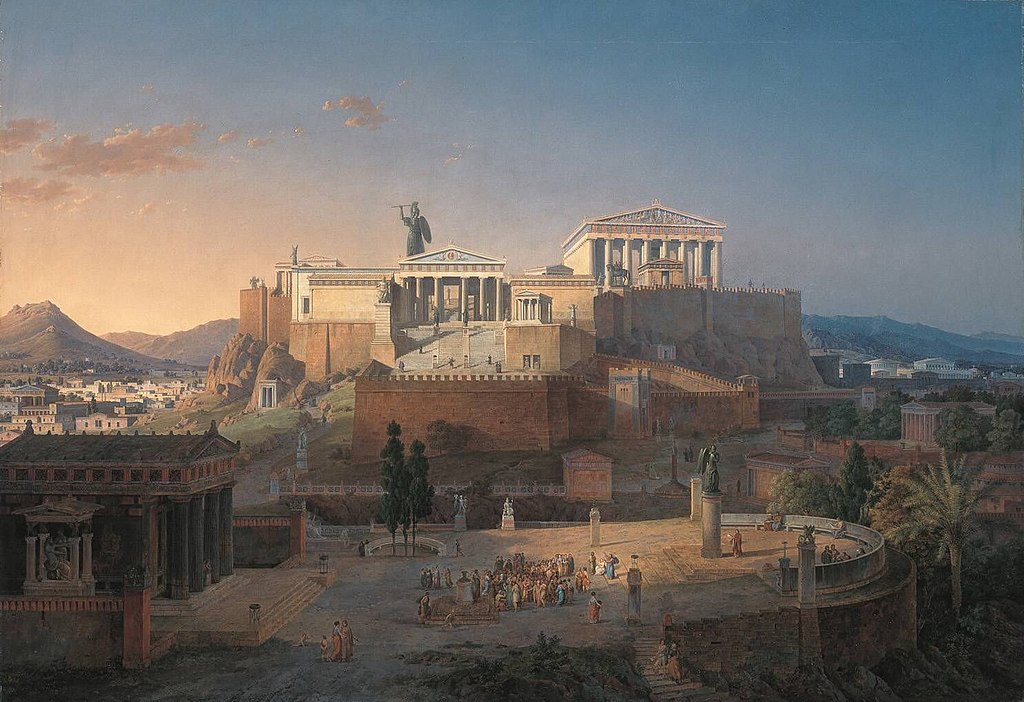
Athens, Greece:
The time-mixing recounted in Fred Hoyle's October the First is Too Late (1966) allows a window of opportunity for party of explorers from 1966 Britain to visit classical Athens. The narrator, a musician, tells of their reception (the year turns out to be 425 BC).
We were met three miles out by civic dignitaries. I could tell nothing of what was said, for in the beginning I had only the crudest knowledge of the language, picked up from Morgan and Anna on the few days of our voyage from Britain. Morgan took on the task of explaining our position. He spoke clearly and slowly. His inflexion provided the populace at large with a considerable source of amusement. Yet his commanding height, combined with a Welsh flair for erudition, had a disarming effect on his audience. Clearly we were well received.
All I could tell was that we were escorted under favourable circumstances into the city. We arrived at length at an open area where about a thousand people had quickly gathered at the news of our arrival. The place of our congregation was a discussion area, of the name Agora, I learned later. There seemed to be nothing for it but that Morgan should give an account of the manner of our journey from the north, through the Pillars of Hercules, the western Mediterranean, and thence to Athens. I was surprised at the length of his speech. Only later did I realize that time was a commodity not in short supply in this community. It would have been taken as an insult, when so many were gathered together, to have spoken tersely... [p107]
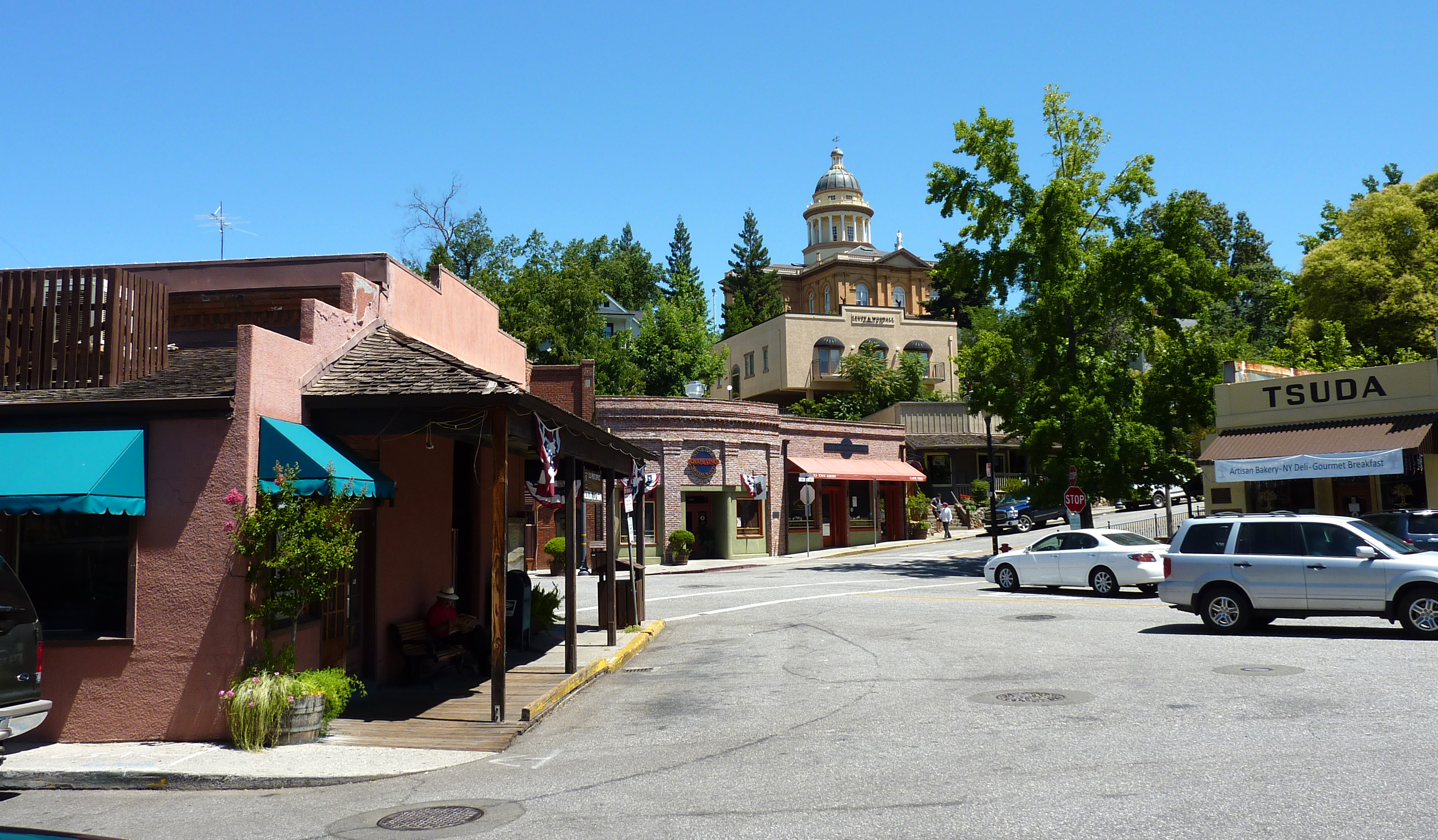
Auburn, California, USA:
This is where Clark Ashton Smith lived most of his life.
The town features in the opening of his story The Root of Ampoi (The Arkham Sampler, Spring 1949; Tales of Science and Sorcery, 1964):
A circus had arrived in Auburn. The siding at the station was crowded with long lines of cars from which issued a medley of exotic howls, growls, snarls and trumpetings...
...And then I saw the giant, who was slightly more than eight feet tall and magnificently built, with no sign of the disproportion which often attends gigantism...
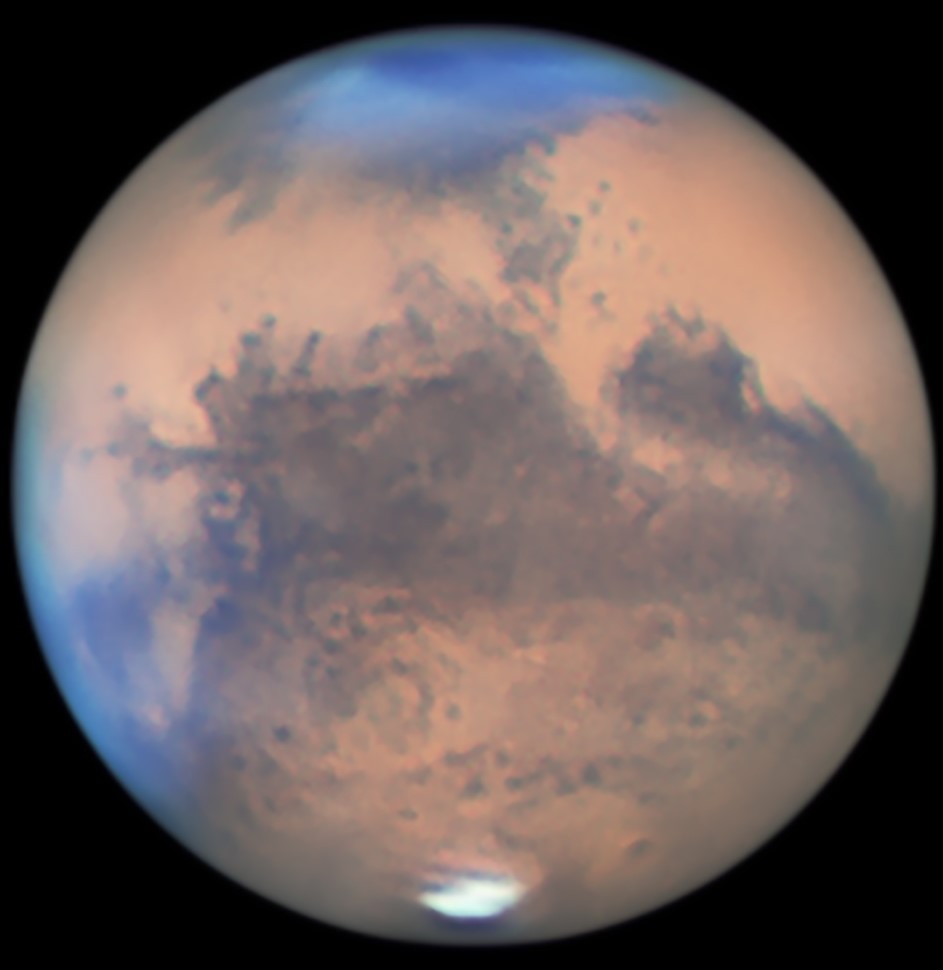 In the middle: Lat. 15 South, Long. 310.
In the middle: Lat. 15 South, Long. 310.Aurorae Sinus:
The site of the larger of the two colonies in Arthur C Clarke's 1951 novel, The Sands of Mars, this is where the protagonist lands on the Red Planet.
Gibson first glimpsed the settlement as a tiny white patch on the horizon, against the dark background of the Aurorae Sinus. The pilot swung the ship round in a great whistling arc to the south, losing altitude and shedding his surplus speed. As the rocket banked, Gibson had a momentary picture of half a dozen large, circular domes, clustered closely together. Then the ground was rushing up to meet him, there was a series of gentle bumps, and the machine rolled slowly to a standstill.
He was on Mars. He had reached what to ancient man had been a moving red light among the stars, what to the men of only a century ago had been a mysterious and utterly unattainable world - and what was now the frontier of the human race.
the Bahamas:
...The route I had charted through the channel north of Great Abaco Island turned out to be a sloping ridge of black mud from which a salty ocean breeze blew an odor of broken drains. It was dawn before I found a clear passage north of Great Bahama, now a mountain range on a new subcontinent, a series of green peaks raised above rolling plains of stinking gray sands, shining in the ominous dawn. Far away on my port beam I saw shapes resting on the former sea bottom: the rusted hulks of drowned steamers, the gaunt ribs of wooden sailing vessels, sunk long ago... - Keith Laumer, Catastrophe Planet (1966), p.83
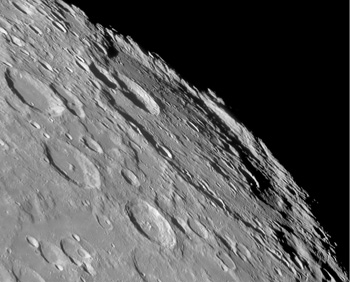
Bailly (crater):
From R W Mackleworth's Starflight 3000 (1972):
"I'm standing on the edge of the Bailly Crater: the southern wall." He pointed to the southeast. "Milcon have their fortress in the Doerful Mountains. In the old days this was called the Third Quadrant. I come from an island called Riphaen in the Mare Nubium."
Hart looked irritated. "These names are known to everyone."
Boldre laughed at him. "But how many know they were given long before this planet was inhabitable? How many know it was barren and airless - a dead world until some genius on Earth bred an organism that could break down rock to form an atmosphere?"
Hart nodded slowly. "That's little enough but sufficient for Milcon."
The threat was clear...
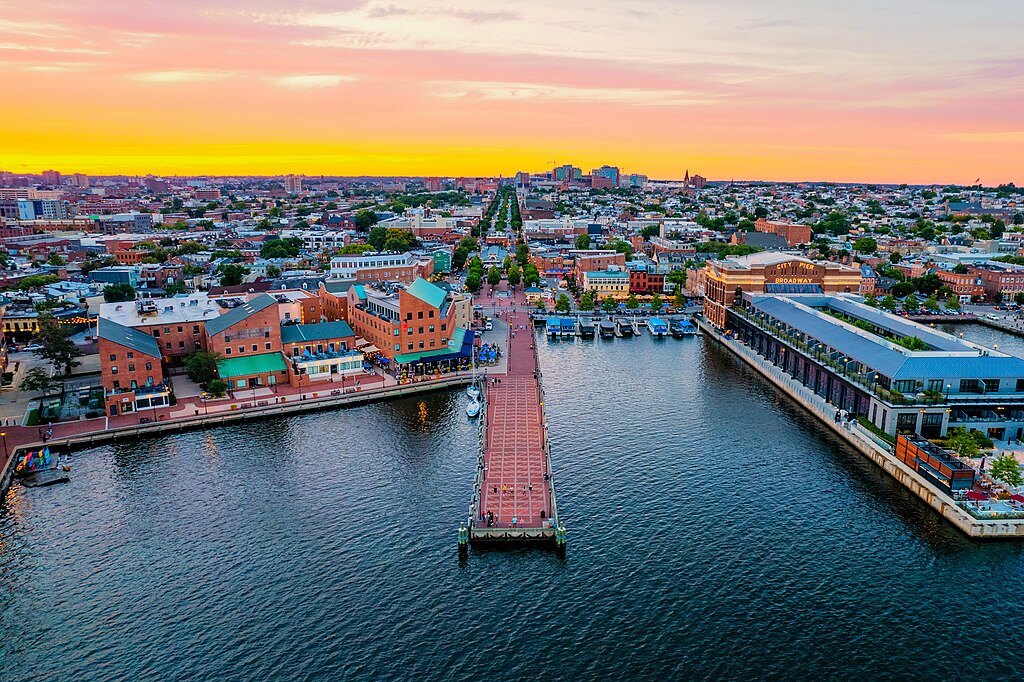
Baltimore, Maryland, USA:
An agent named Cussick comes to report the possible existence of a super-dangerous man - one who can foresee the future - in Philip K Dick's The World Jones Made (1956). The year is 1995 and the world is run according to the political doctrine of Relativism... but if someone can be sure of the truth, that threatens to blow up the whole fragile set-up.
At four o'clock the police car picked him up and carried him back to Baltimore. Cussick was seething. Excitedly, he lit a cigarette, stubbed it out, and lit another. Maybe he had something, maybe not. The Baltimore secret-service buildings stood like a vast cube of concrete on the surface of the earth, a mile outside the city. Around the cube jutted metallic dots: coordinate block houses that were the mouths of elaborate subsurface tunnels. In the blue spring sky lazily flitted a few robot interception aerial mines...
the Banda Sea:
Clark Ashton Smith's The Letter From Mohaun Los (Wonder Stories, August 1932; see the Fictional Dates page for the years 1940 and 1941) is a novella whose title refers to a missive which has been sent to Earth from a far world and is found floating in the Banda Sea "between Celebes and the Spice Islands".
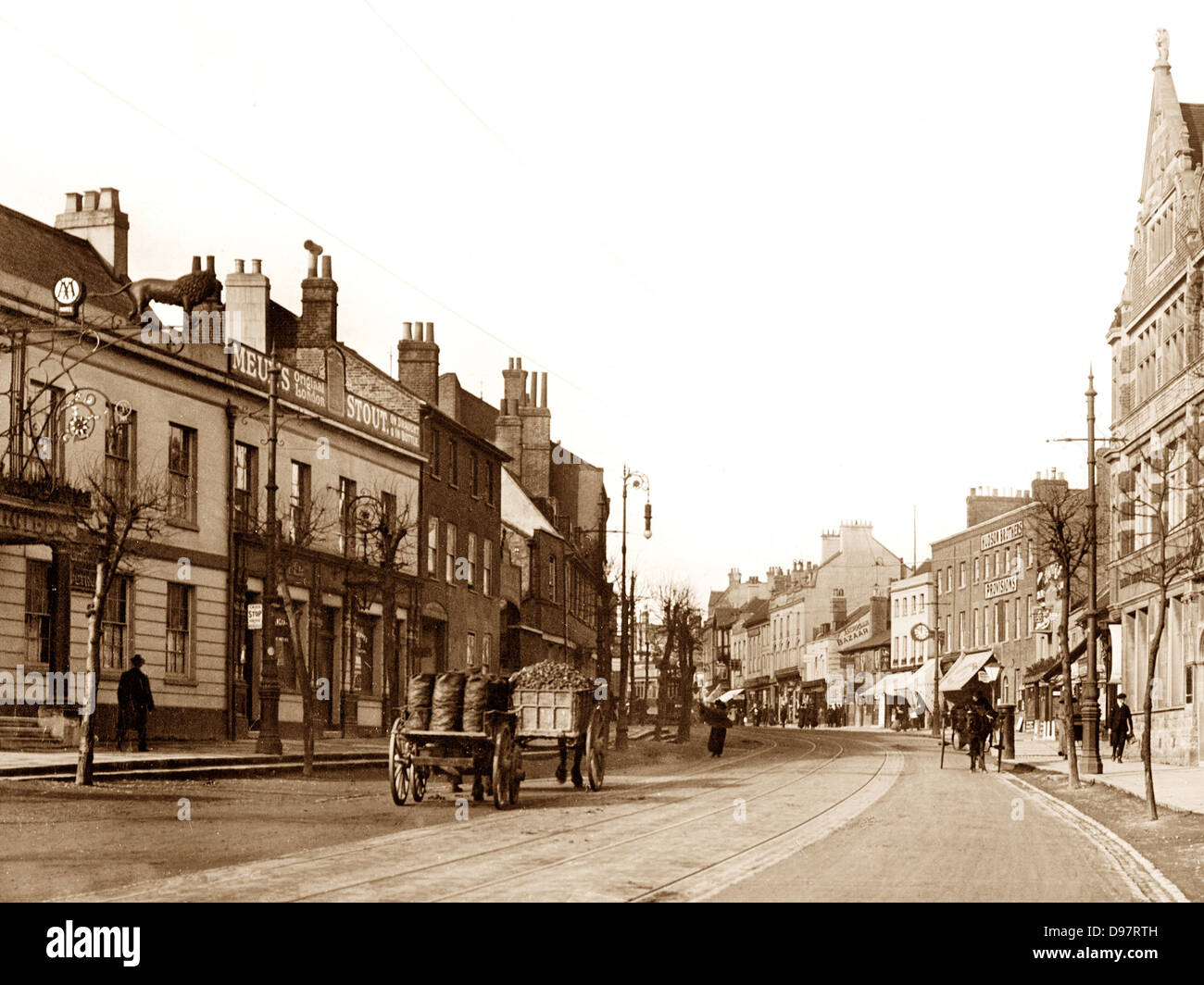 around 1900
around 1900Barnet, Hertfordshire, England:
Fugitives from the invading Martians crowd the area in H G Wells' The War of the Worlds (1898).
...The main road was a boiling stream of people, a torrent of human beings rushing northward, one pressing on another. A great bank of dust, white and luminous in the blaze of the sun, made everything within twenty feet of the ground grey and indistinct, and was perpetually renewed by the hurrying feet of a dense crowd of horses and men and women on foot, and by the wheels of vehicles of every description.
"Way!" my brother heard voices crying. "Make way!"
It was like riding into the smoke of a fire to approach the meeting-point of the lane and road; the crowd roared like a fire, and the dust was hot and pungent. And, indeed, a little way up the road a villa was burning and sending rolling masses of black smoke across the road to add to the confusion...
Barnham, Sussex, England:
This is where Dr Charles Howard Gilley creates the B.E.A.S.T. of Charles Eric Maine's 1966 novel. Gilley's "Biological Evolutionary Animal Simulation Test" is programmed to evolve on magnetic tape inside a computer, but the thing is trying to get out...
From Chapter Three:
How to site a top secret Ministry research establishment. Choose a quiet spot with access to a road in a developed rural area where drainage, water and electricity facilities are readily available. Woodland is preferable, to screen the proposed building from the casual observer. Erect something that looks like a small clinic of red brick and glass, but sink the main laboratories deep into the ground so that, like an iceberg, the greater part of the establishment is submerged. Then build a twelve-foot wall round the whole thing and install a check point at the main gate. Finally, to attract spies and make absolutely sure that the site is pin-pointed on the missile target maps of every country engaged in the Cold War, put up a big sign announcing: Ministry of Defence - Private Property - No Unauthorised Admittance...
Note: when recently re-reading the novel I didn't expect that Barnham actually exists, but it does, as does nearby Eastergate which is also mentioned in the book; however the village of "Rapton" where the final show-down occurs was, it seems, invented by the author.
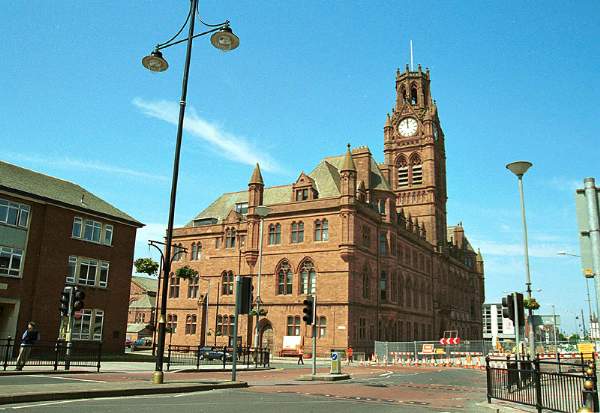
Barrow-in-Furness, Lancashire, England:
The mind of Ray Jerome, in an alien body on Mercury, meeting another transferred Terran, in Bob Shaw's Fire Pattern (1984):
"Name's Joe Thwaite," the stranger said. "Spinster of this parish for the last eleven years, but before that resident in the beautiful township of Barrow-in-Furness."
"Barrow-in-Furness?" Jerome began to feel lost. "Isn't that in England?"
"Certainly is. Best town in the whole ruddy country."
Jerome was still adrift between two worlds. "But you don't have an English accent."
"And you don't have an American one. Not any more." Thwaite produced a gnomish grin. "Accents are mainly a matter of muscle development, and you've got Dorrinian speech centres now..."
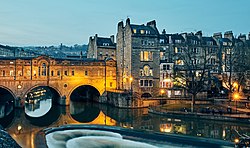
Bath, Somerset, England:
This is the town where lived Arthur Willis, who unfortunately for himself hired a robot who looked indistinguishably like himself, in the macabre epistolary tale Robot's Dozen by G L Lack (New Writings in SF - 10 (1966)).
Rentarobot Ltd,
London, W.15.
Dear Sir,
Thank you very much for your prompt and efficient service. The robot you supplied to take care of my house and garden while I was away on holiday on the continent proved (if you will excuse the term) a model of perfection...
It turns out he spoke too soon. (See 1979, 7th ref.)
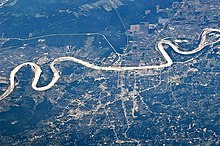
Baton Rouge, Louisiana, USA:
Amid earthquake and ruin the dying sailor relates his return from a disastrous Antarctic expedition in Keith Laumer's Catastrophe Planet (1966):
"I made landfall south of Baton Rouge in four days. Played it cagy, brought her into a bayou mouth at night, kept out of sight behind flooded-out houses. Left the boat hidden and got into town. Tried to get a message off to a contact in Washington, but no luck. Chaos in the town. Famine was beginning to pinch them. All the refugees from the coast and from the fault areas further west. Air like a foundry, soot everywhere, and more tremors every day..."
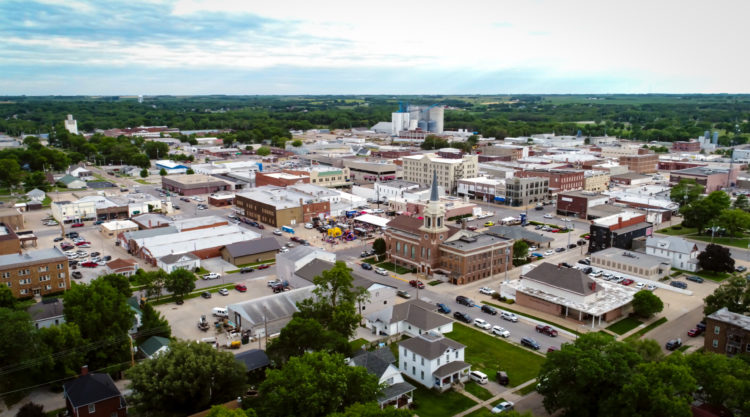
Beatrice, Nebraska, USA:
In Keith Laumer's classic invasion-novel The House in November (1969), the protagonist awakes from a trance to find that all the other inhabitants of his home town are mentally in thrall.
...Gillian shrank away from him as he came down the steps. "Jeff, you look sick. You're having some kind of attack. Lie down, and I'll call Dr. Everet - "
"I've never felt better in my life - " Mallory started and broke off abruptly. Through the window on the landing he saw the familiar street, clear of fog now, the big, old-fashioned houses, steep-gabled, the leafless trees above them. But beyond, where the steeple of the Methodist church should have been, a tower rose up and up into the morning sky. It was big, his engineer's eye told him: hundreds of feet in diameter, and so tall that its flaring top was lost in the high haze. The material was pale green, glassy, translucent. An incredible structure, sprung up overnight like an enchanted mushroom.
"Gill - what is it?"
"The Star Tower, of course." She stared into his face. Her eyes had a glazed, remote look...
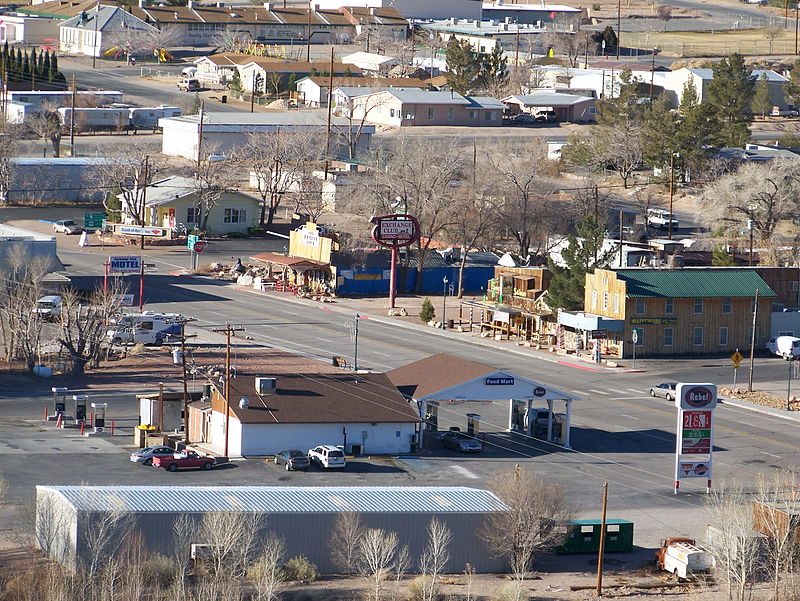
Beatty, Nevada, USA:
Inventor Courtney Edwards, who shrinks spectacularly in Submicroscopic by S P Meek (Amazing Stories, August 1931), is looking for a place in which to do his work:
...one day while flying from Salt Lake City to San Francisco, I passed over a verdant little valley hidden in the almost inaccessible crags of the Timpahute range in southern Nevada. I abandoned my trip temporarily and landed at Beatty to make inquiries. Not a person could I find who had ever heard of my hidden valley. Even the old desert rats professed ignorance of its location and laughed at me when I told them that I had seen flowing water and deciduous trees in the barren stretches of the Timpahutes...
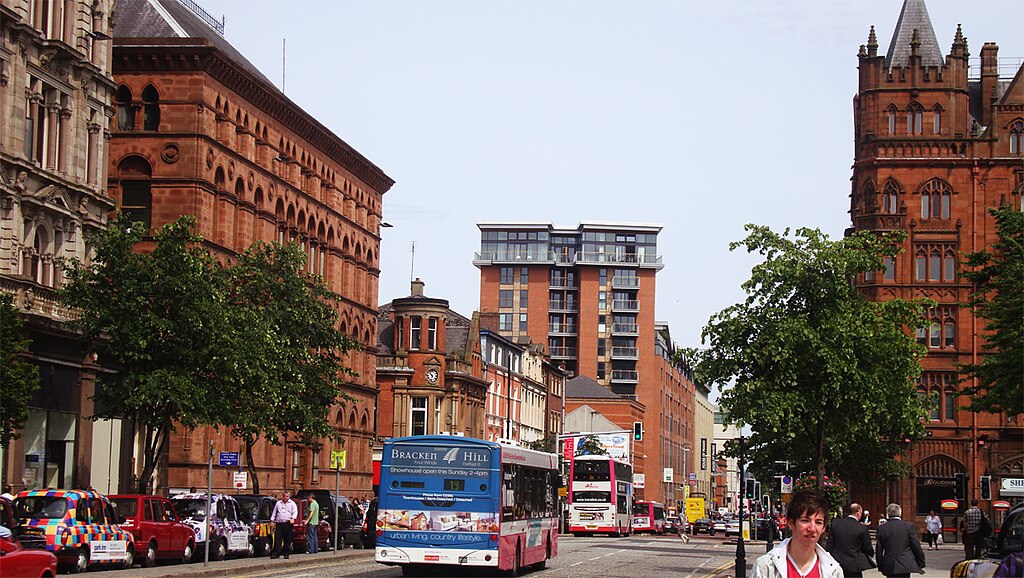
Belfast, County Antrim, Northern Ireland, UK:
Roland Crane, pursuing clues about the mysterious Map Country, comes to Belfast in the second chapter of Kenneth Bulmer's Land Beyond the Map (1965).
...Though he tramped the fascinating alleyways of Smithfield, amid the noise and bustle, penetrating into the quieter, dusty and time-corroded sections, and turned over so many tattered books - all guide books - that he wondered how anyone ever found their way about without them, he did not turn up a guide book with a torn map in the back. Correction - he turned up many guide books with ripped and frail maps in the back; but that warning zephyr he knew would creep up his spine when he found the right one did not happen...
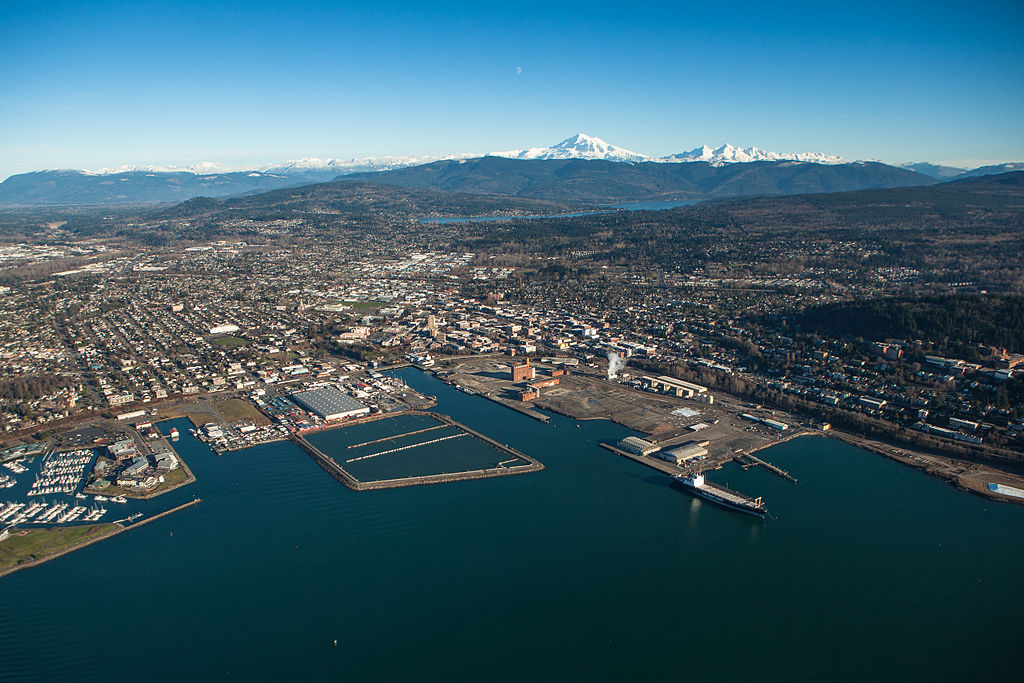
Bellingham, Washington State, USA:
Secret construction site and eventual launch site of the nuclear-bomb-powered spaceship Michael, in Niven and Pournelle's alien-invasion epic Footfall (1985). When the reader is introduced to the area,
...It was a bright clear spring day, with brilliant sunshine, the kind of day that made it worth while living through Bellingham's rainy seasons. The snow-covered peaks of Mount Baker and the Twin Sisters stood magnificently above the foothills to the east. The view was impressive even to a native; it was enough to have Angelenos gawking. They stood near the old Bellingham city hall, a red brick castle complete with towers and Chuckanut granite, and alternately looked out across the bay to the San Juan Islands, then back to the mountains...
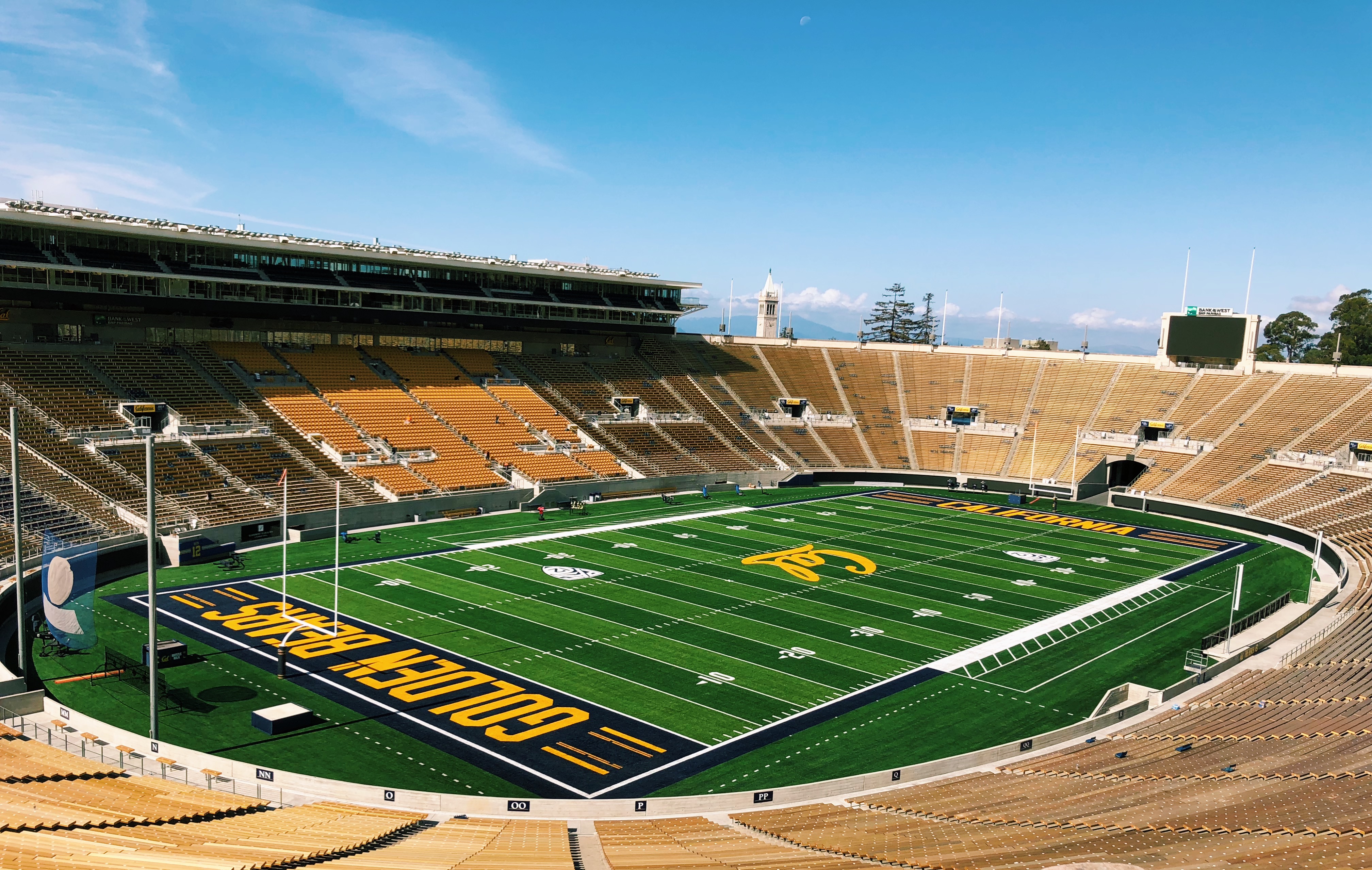 the stadium at Berkeley
the stadium at BerkeleyBerkeley, California, USA:
From Seedling of Mars by Clark Ashton Smith (Wonder Stories Quarterly, Fall 1931, as The Planet Entity):
It was in the fall of 1947, three days prior to the annual football game between Stanford and the University of California, that the strange visitor from outer space landed in the middle of the huge stadium at Berkeley where the game was to be held.
Descending with peculiar deliberation, it was seen and pointed out by multitudes of people in the towns that border on San Francisco Bay...

Berlin, Germany:
From a 1965 novel, Damon Knight's The Other Foot, we get a conception of the German capital in the year 2002, in which, somewhat surprisingly, interstellar travel has been achieved and both the Zoo and the shops have received creatures from far worlds. One of them finds himself transferred to a human body and wanders, bewildered.
...Here in the middle of the city, the streets were as bright as if it were day. Over the tesselated pavements people were wandering. Music drifted seductively from an open doorway; all the scarlet blossoms of the Antarean airweed, clinging to the sides of the buildings, were open and exuding a fresh pungence.
In one of the brilliant display windows, as he passed, the young man saw a row of green creatures in glass cages - sluggish globular animals about the size of a tomato, with threads of limbs and great dull green eyes...
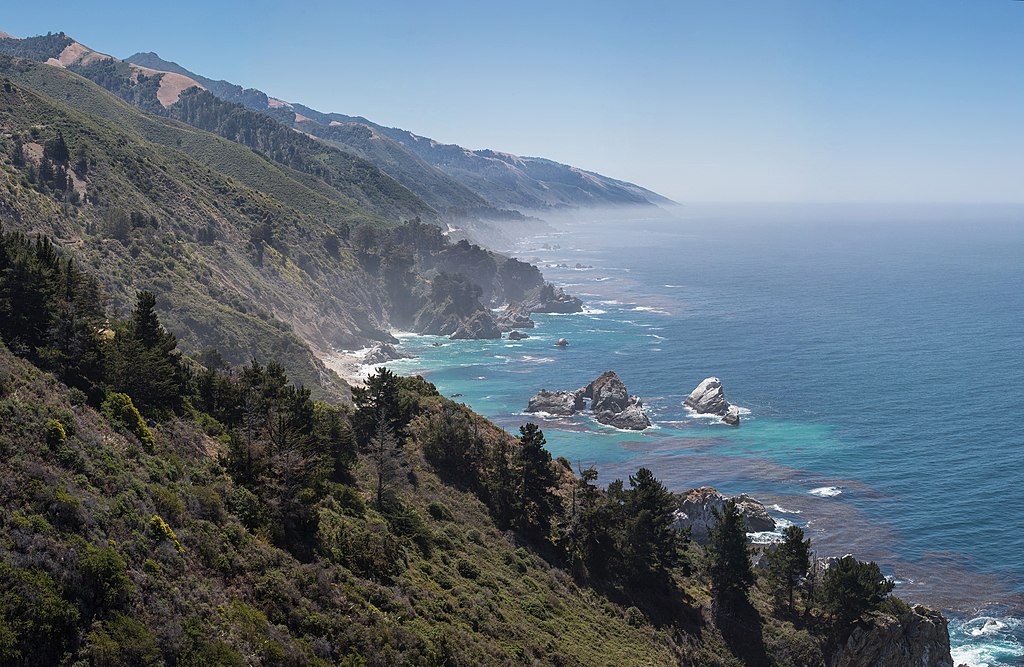
Big Sur, California, USA:
On the run from the State, from the mob and from a lab-grown monster, Travis Cornell and the genetically-engineered genius-dog "Einstein" hide out in sparsely populated countryside, at the start of part two of Watchers (1987) by Dean R Koontz.
...Travis and Einstein went for a walk across the grassy hills and through the woods behind the house they had bought in the beautiful California coastal region called Big Sur.
On the treeless hills, the autumn sun warmed the stones and cast scattered cloud shadows. The breeze off the Pacific drew a whisper from the dry golden grass. In the sun, the air was mild, neither hot nor cool. Travis was comfortable in jeans and a long-sleeved shirt.
He carried a Mossberg short-barreled pistol-grip pump-action 12-gauge shotgun. He always carried it on his walks. If he ever encountered someone who asked about it, he intended to tell them he was hunting rattlesnakes...
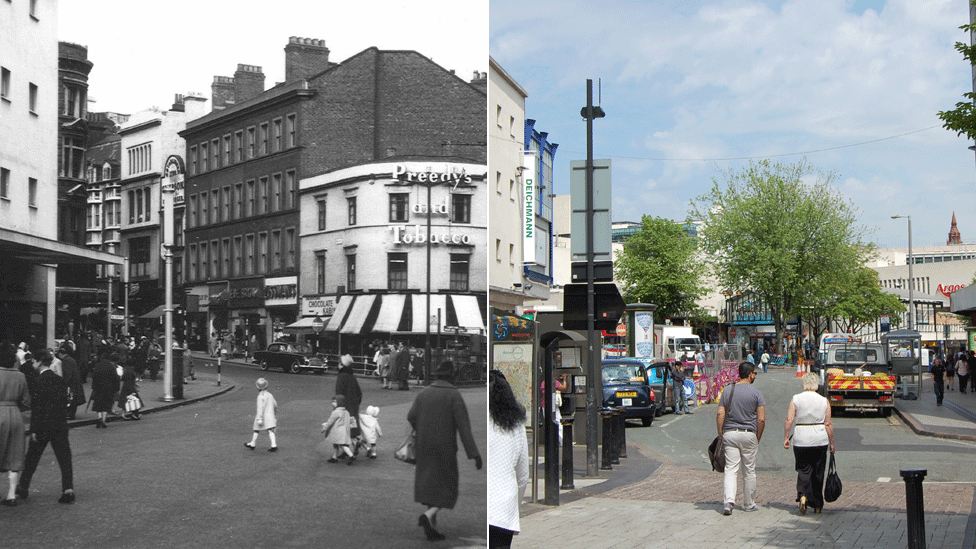
Birmingham, England:
Chapter eleven of Dan Morgan's The Uninhibited (1961) - in which most of the characters are undercover agents from an extrasolar planet - begins:
Birmingham was alive with the brisk impersonality of a big city in the early morning. The air that flowed through the open windows of the car had a chill which caught at the nostrils. Keenan's mind was crisp and alert with the expectancy of danger, despite the long night drive. He might be entering the very heart of the enemy's activity and he could not afford to relax for a moment...
Bloomington, USA:
Poul Anderson mentions the place more than once in For the Duration (Fantastic Universe, March 1957), but tantalisingly does not specify whether it is is Bloomington, Illinois or Bloomington, Indiana. Perhaps readers from those states might be able to tell from internal evidence, which of them it is. If so, please tell me!
...There was a handpicked Congress in Bloomington, and a frightened little shadow of a President, and a rubber-stamp Supreme Court...
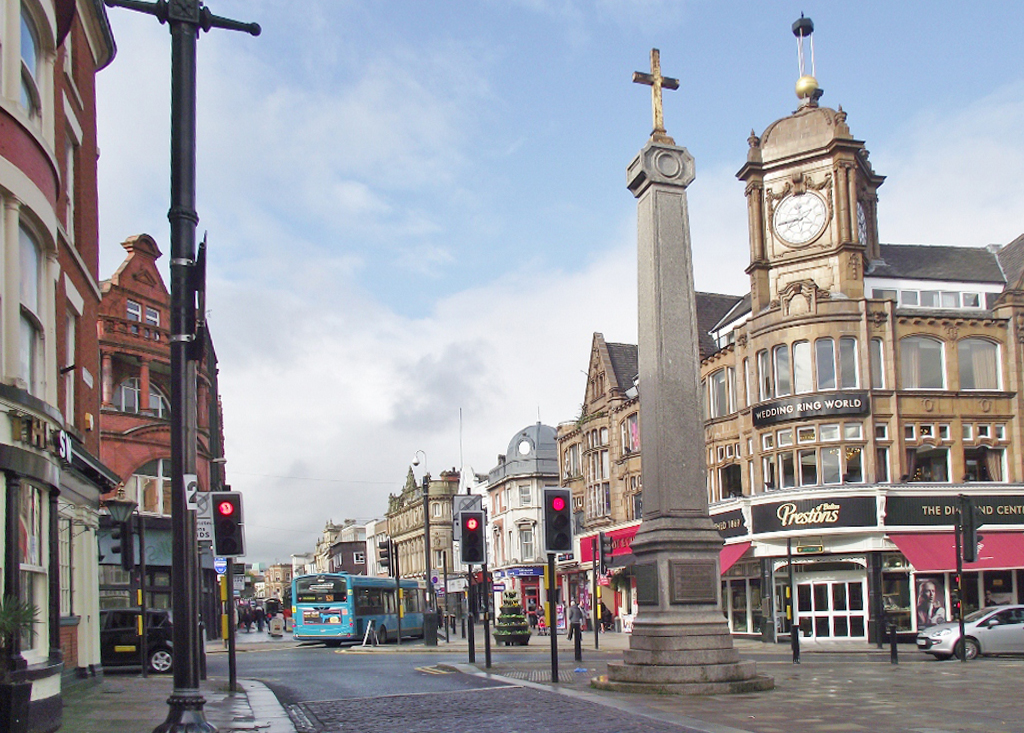
Bolton, Lancashire, England:
Mathematician Lucas Hutchman, on the run, looking for a place to hide, decides against the Lake District:
...It would be better to lose himself in a population centre and - if he did not want to arrive conspicuously in the dead of night - to pick one fairly near at hand. He pulled off the highway and consulted a road map.
The nearest town of any size was Bolton which, to Hutchman's mind, was the epitome of the traditionally humdrum life of provincial England...
- from Bob Shaw's The Peace Machine (1971, 1985).
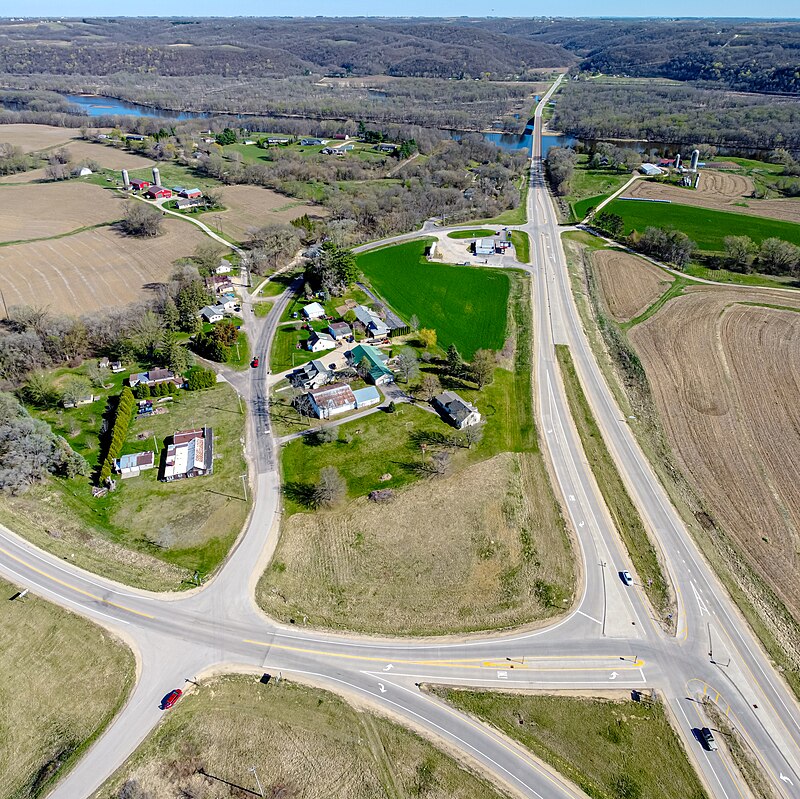
Bridgeport, Wisconsin, USA:
Man of destiny Asher Sutton, travelling back in time from the year 7990, heads for this town as it was in 1977, to close a cause-and-effect loop in a war to preserve freedom for the galaxy in Clifford Simak's Time And Again (1951):
Bridgeport dreamed in its rock-hemmed niche alongside the swiftly flowing river. The summer sun beat down into the pocket between the tree-mantled cliffs with a fierceness that seemed to squeeze the last hope of life and energy out of everything... out of the weather-beaten houses, out of the dust that lay along the street, out of leaf-wilted scrub and bush and beaten rows of flowers.
The railroad tracks curved around a bluff and entered the town, then curved around another bluff and were gone again, and for the short space of this arc out of somewhere into nowhere they shone in the sun with the burnished sharpness of a whetted knife. Between the tracks and river the railroad station drowsed...
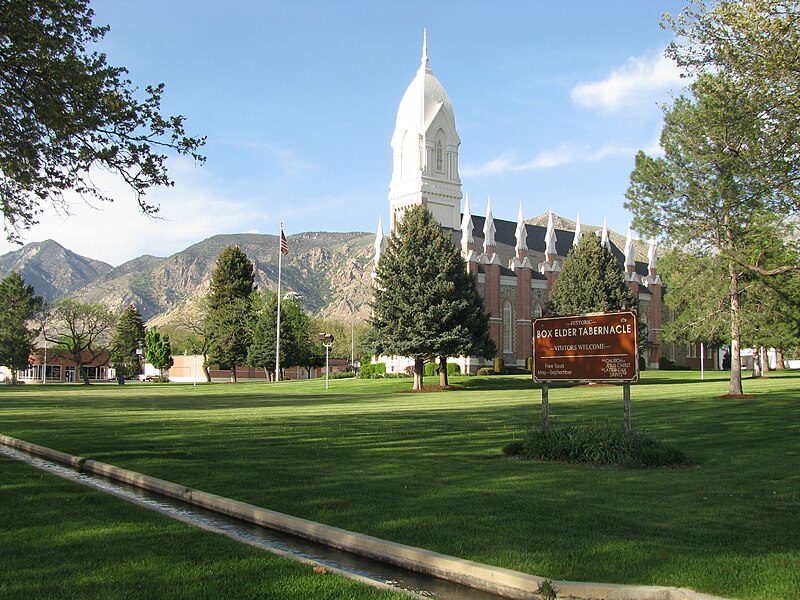
Brigham City, Utah, USA:
In Poul Anderson's "Psychotechnic League" series tale Un-Man (Astounding, January 1953), set in the year 2004, UN agent Robert Naysmith, striving to prevent a Nationalist plot against UN rule in the post-World-War-III world, comes to this city in an attempt to rescue the widow of a murdered fellow-agent from the plotters.
...Brigham City, Utah was not officially a colony, having existed long before the postwar resettlements. But it had always been a lovely town, and had converted itself almost entirely to modern layout and architecture...
...The houses nestled in their screens of lawn and trees, the low half-underground homes of small families. Men and women, some in labouring clothes, were about on the slideways, and there were more children in sight, small bright flashes of color laughing and shouting, than was common elsewhere. The Mormon influence, Naysmith supposed; free-marriage and the rest hadn't ever been very fashionable in Utah. Most of the fruit-raising plantations were still privately owned small-holdings too, using cooperation to compete with the giant government-regulated agricultural combines...
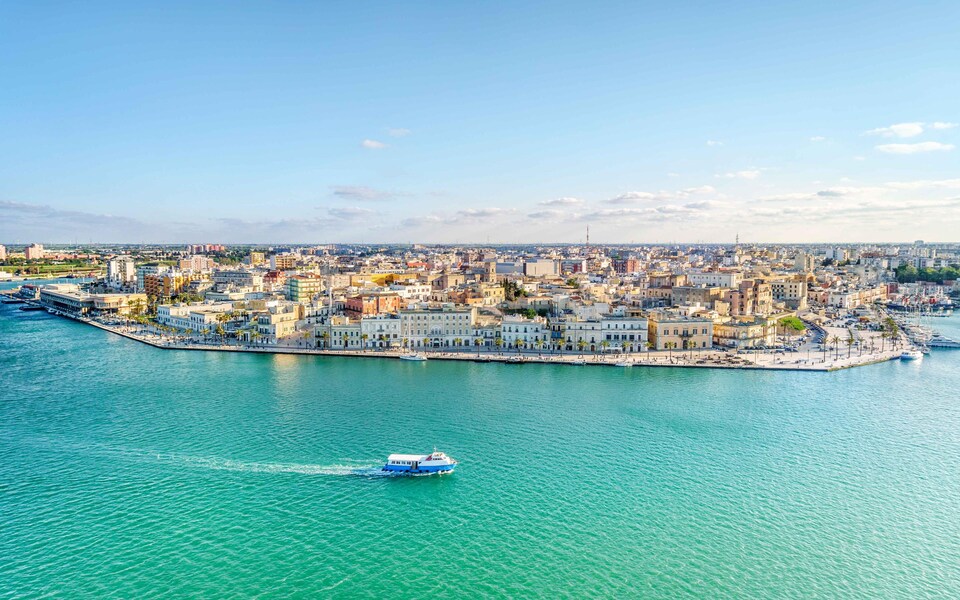
Brindisi, Apulia, Italy:
Chapter 1 of the final novel in the Starwolf trilogy, World of the Starwolves (1968) by Edmond Hamilton, shows us the old star-captain John Dilullo in what he thinks is retirement.
...He sat on the browned, sun-warmed grass on the side of the low hill, hunched with his knees drawn up, looking in his gray coverall like an old rock set in the slope. And Dilullo's face had something rock-like in it too, a roughly carved face of harsh planes, his hair graying at the edges.
He looked down at the streets and buildings of Brindisi, at the cape and the mole and the little islands, with beyond them the blue Adriatic shimmering in the hot Italian sun. He knew the old city very well, but it had changed since he had hurried through it as a boy on his way to school.
Working and studying, to get to be a starman, he thought. And what did the stars give me when I got to them? Danger and worry and sweat, and when I went out to them once too often I came back to find that everybody and everything I had was gone...
Bristol, Pennsylvania, USA:
Birthplace of Poul Anderson, 25 November 1926.
Bromley, Kent, England (Bromley is now part of Greater London):
162 High Street, Brolmely, was the birthplace of H G Wells, 21st September 1866.
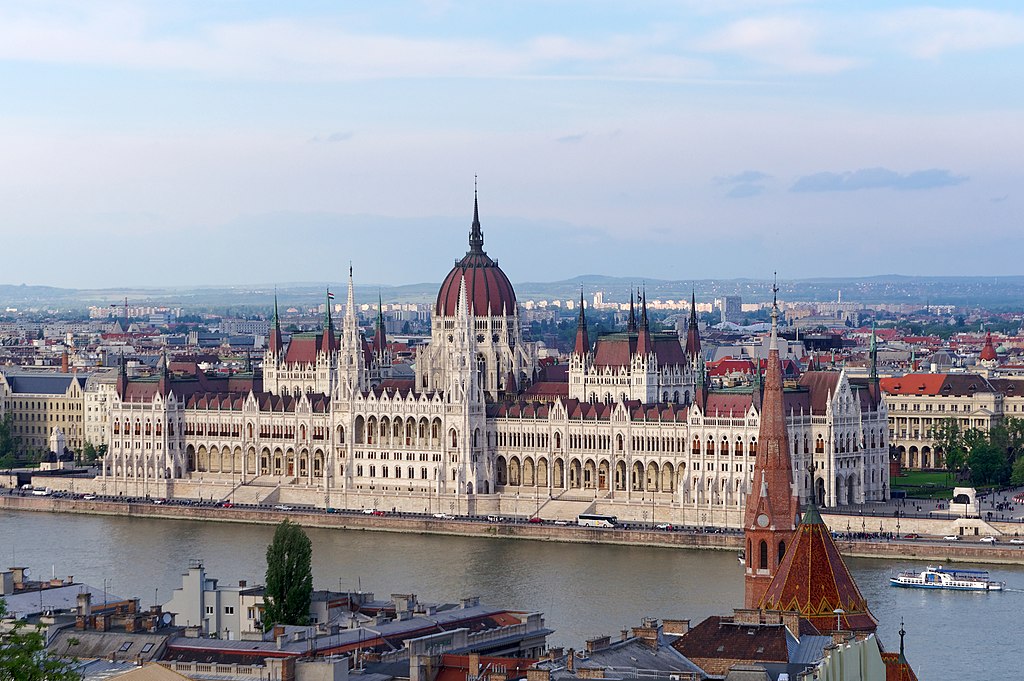
Budapest, Hungary:
In chapter six of James Blish's Earthman, Come Home (1955), we encounter this now-nomadic metropolis far out in space as the domain of the "King of the Okie jungle", a pack of desperate flying cities which the craggy, authoritarian ruler of Budapest is trying to discipline.
The centre of government of the King's city was enormously impressive: ancient, stately, marmoreal. It was surrounded on a lower level by a number of lesser structures of equally heavy-handed beauty. One of these was a heavy, archaic cantilever bridge for which Amalfi could postulate no use at all; it spanned an enormously broad avenue which divided the city in two, an avenue which was virtually untravelled; the bridge, too, carried only foot traffic now, and not much of that.
He decided finally that the bridge had been retained only out of respect to history...
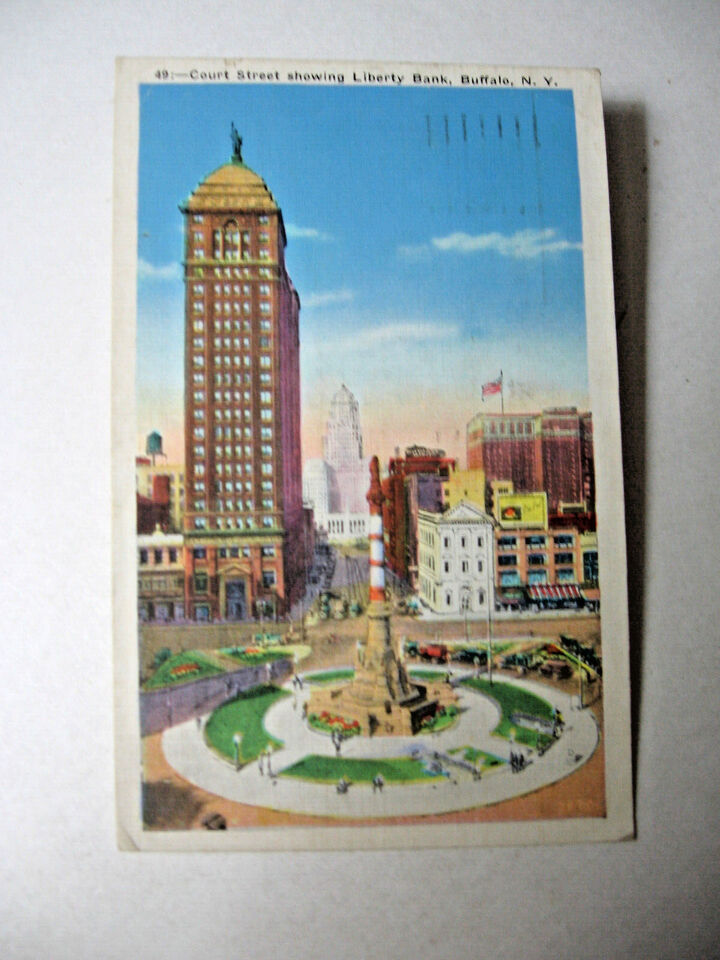 1936 postcard
1936 postcardBuffalo, New York, USA:
At the start of the rather mind-boggling novel Dinosaur Beach (1971) by Keith Laumer, "Time-sweeper" agent Ravel is living happily in this city in 1936, when he starts to remember who he really is and that he must leave on a mission to save reality.
It was a pleasant summer evening. We were sitting on the porch swing, Lisa and I, watching the last of the pink fade out of the sky and listening to Fred Hunnicut pushing a lawn mower over his weed crop next door. A cricket in the woodwork started up his fiddle, sounding businesslike and full of energy. A car rattled by, its weak yellow headlights pushing shadows along the brick street and reflecting in the foliage of the sycamores that arched over the pavement. Somewhere a radio sang about harbor lights.
A pleasant evening, a pleasant place. I hated to leave it...
Bullialdus:
For a reference in William F Temple's Shoot at the Moon (1966) see Mare Nubium.
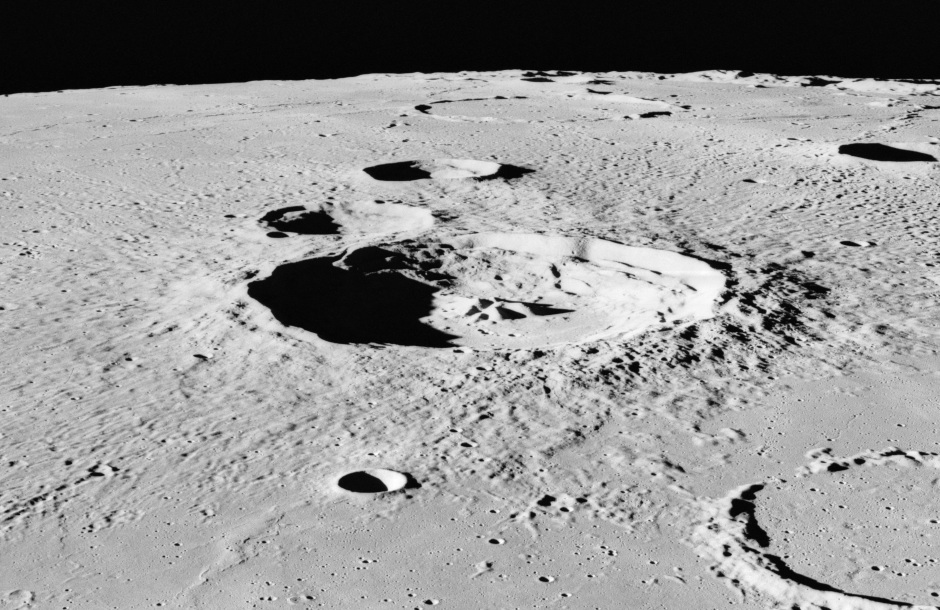 Bullialdus from Apollo 16
Bullialdus from Apollo 16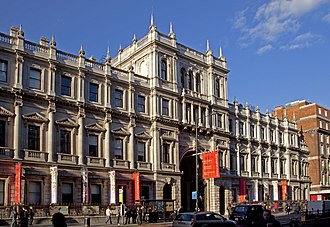
Burlington House, Mayfair, London, England:
In chapter two of Fred Hoyle's 1957 novel The Black Cloud, this building, headquarters of a number of learned societies, is the scene of the meeting of the British Astronomical Association at which Chris Kingsley, Professor of Astronomy at Cambridge, first hears of observations that imply the intrusion of what comes to be known as the Cloud. At first he doesn't believe it. He thinks it's a hoax by the Astronomer Royal, who responds:
"Kingsley, if you imagine that I would go to the trouble of staging an elaborate - hoax as you call it, primarily with the object of deceiving you, of taking a rise out of you, then all I can say is that you flatter yourself unduly."
"Let's put it this way," answered Kingsley. "There are two hypotheses that I can make. Both at first sight seem incredible, but one of them must be right. One hypothesis is that a hitherto unknown body with a mass of the same order as Jupiter has invaded the solar system. The second hypothesis is that the Astronomer Royal has taken leave of his senses. I don't want to give offence, but quite frankly the second alternative seems to me less incredible than the first..."
Butler, Missouri, USA:
Birthplace of Robert A Heinlein (7th July 1907).
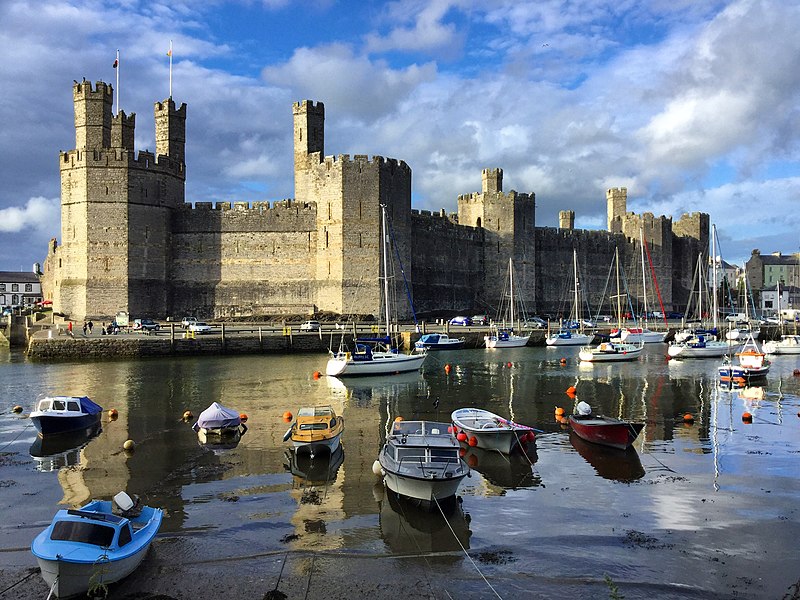
Caernarfon, Wales:
In the memorable third chapter of Edmond Hamilton's The Closed Worlds (1968), second volume of the Starwolf trilogy, interstellar outlaw Morgan Chane, exiled from the pirate world Varna, returns incognito to his ancestral town on Earth:
Chane walked the streets of the old town, narrow ways, with old buildings, that slanted down towards the sea. The day was dark with great clouds and a mist and spume blew in from the ocean; the worn stones under his feet were wet and glistening. The wind was raw and boisterous, muttering of coming gales.
He liked this place. It was almost as grim and harsh as Varna. And he liked the people, though they had looked at him with neither any particular friendship nor hostility. He suddenly realized that it was their voices he liked. They talked in a queer, lilting way, just the way his father had talked, and he remembered that his father had called it the "singsong".
There did not seem to be very much in this small place of Carnarvon, except a big hulking wreck of a castle down by the sea, so he went that way. The place was ancient and battered but had a sort of grandeur under the stormy sky. There was an old man in a uniform coat at the gate who sold tickets. Chane bought a ticket and started in...
..."And so you came from America? Of course, that was where David went, long ago. Is it a good job you have there?"
"I'm not there very much," Chane said. "I've worked in starships for a long time."
He thought how Dilullo would react to that discreet description of a Starwolf's profession, and smiled a little...
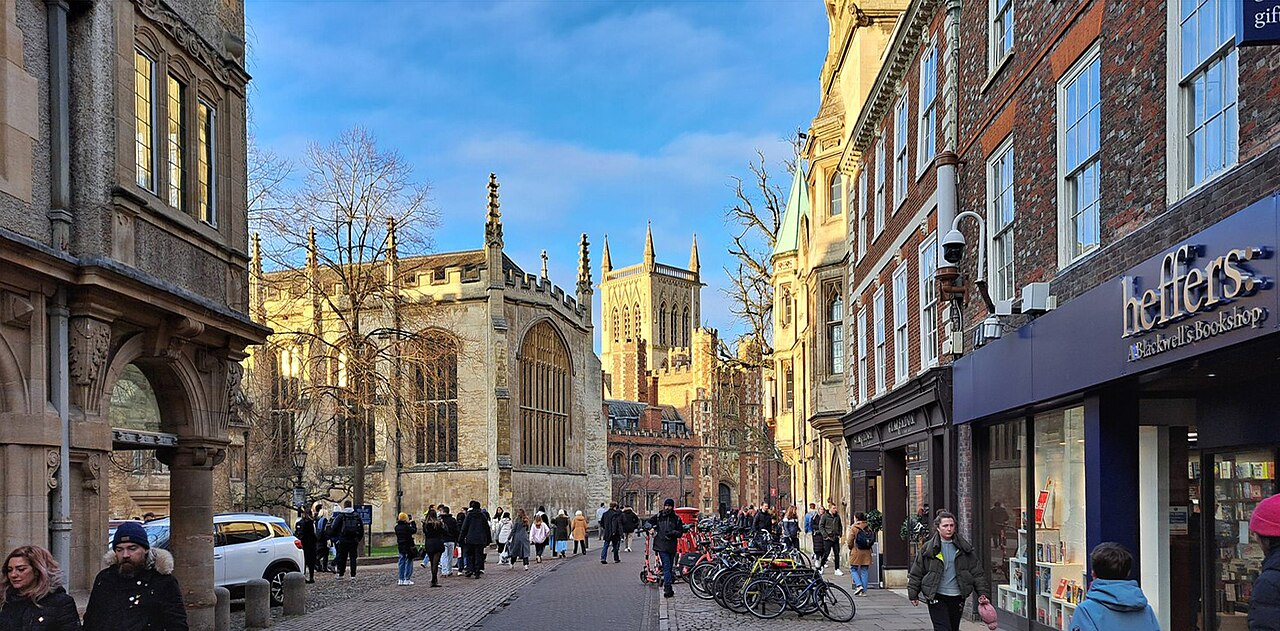
Cambridge, Cambridgeshire, England:
Much of Fred Hoyle's 1985 novel Comet Halley is set in the university and town.
...It was a Saturday afternoon in late October, one of those unforgettable Cambridge afternoons with a cloudless sky that make you feel there should be a smell of wood-smoke over the whole town. The undergraduates were "up" for a brand new academic year, undergraduates young enough to feel the whole world opening out before them. It was an afternoon with sounds travelling in the crisp air, so that even as far away as the Cavendish Laboratory you could hear sporadic roars from the large crowd assembled at the University rugby ground in Grange Road...
Hoyle's earlier novel The Black Cloud (1957) is also connected with Cambridge though not quite so strongly. Chris Kingsley, the hero, is a brilliant young don who is the first to guess at the true nature of the Cloud that has invaded the Solar System.
...it was cold, rainy, and a thin mist covered the town of Cambridge. Kingsley worked all through the morning and into mid-afternoon before a blazing fire in his College rooms. He worked steadily, writing an astonishing scrawl of symbols...
At about three-thirty he went out of College, thoroughly muffled up and sheltering under his umbrella a voluminous sheaf of papers. He worked his way by the shortest route to Corn Exchange Street, and so into the building where the computing machine was housed, the machine that could do five years of calculation in one night. The buildign had once been the old Anatomy School and was rumoured by some to be haunted, but this was far from his mind as he turned from the narrow street into the side door...
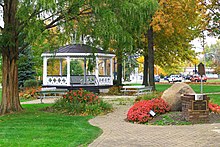
Canfield, Ohio, USA:
Leigh Brackett's post-disaster novel The Long Tomorrow (1955) opens at Canfield (or what's left of it - cities now being forbidden):
Len Colter sat in the shade under the wall of the horse barn, eating pone and sweep butter and contemplating a sin. He was fourteen years old, and he had lived all of them on the farm at Piper's Run, where opportunities for real sinning were comfortably few. But now Piper's Run was more than thirty miles away, and he was having a look at the world, bright with distractions and gaudy with possibilities. He was at the Canfield Fair...
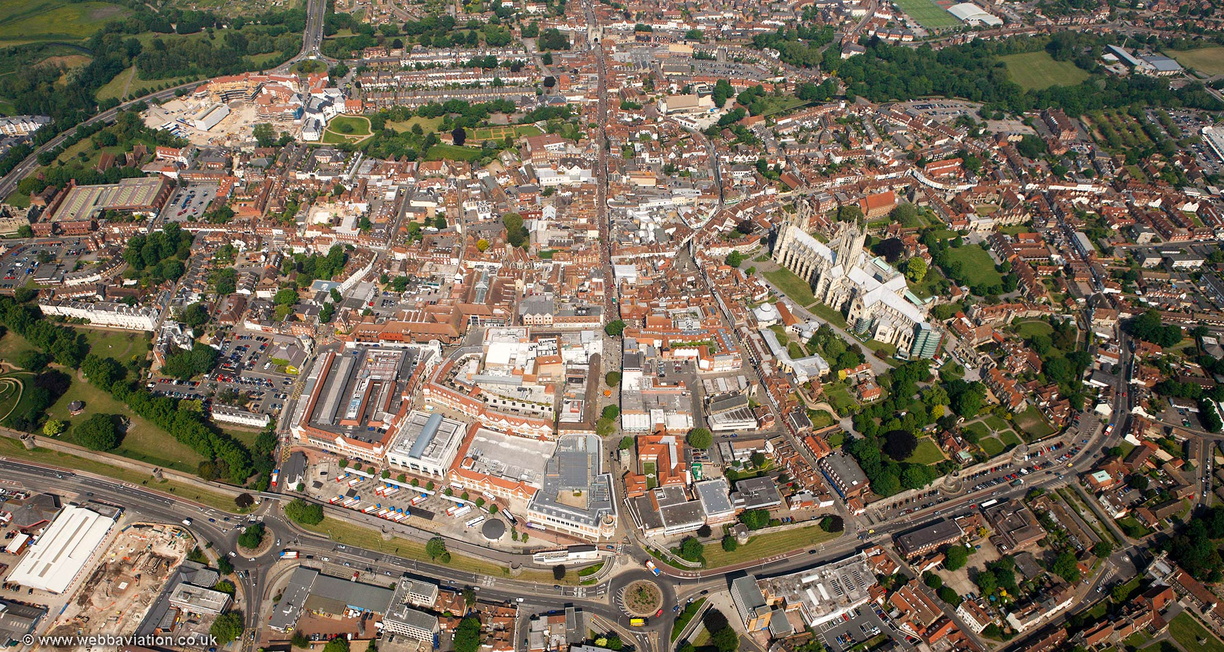
Canterbury, Kent, England:
Time patrolmen Everard and Whitcombe come to Dark-Age Canterbury (A.D. 461) in order to track down a rogue time-traveller who is plotting to change history, in Poul Anderson's Time Patrol (The Magazine of Fantasy and Science Fiction, May 1955):
...Everard led the way to a crumbling Roman road and towards the city. There was a goodly traffic, mostly farmers driving creaky ox-carts of produce in to market. A pair of vicious-looking guards halted them at the gate and demanded their business. This time they were the agents of a trader on Thanet who had sent them to interview various artisans here. The hoodlums looked surly till Whitcombe slipped them a couple of Roman coins; then the spears went down and they were waved past.
The city brawled and bustled around them, though again it was the ripe smell which impressed Everard most. Among the jostling Jutes, he spotted an occasional Romano-Briton, disdainfully picking a way through the muck and pulling his shabby tunic clear of contact with these savages. It would have been funny if it weren't pathetic...
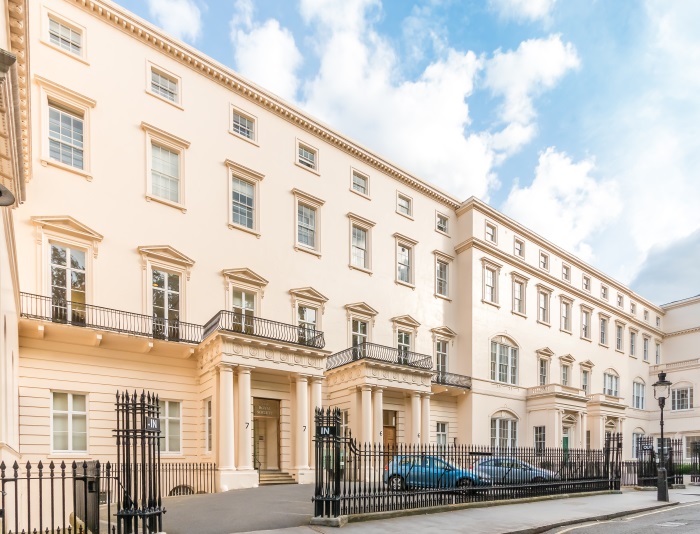 the Royal Society
the Royal SocietyCarlton House Terrace, London, England:
In the opening chapter of Fred and Geoffrey Hoyle's cosmic disaster novel Inferno (1973), in which (spoiler alert) the galactic centre becomes a quasar and the radiation fries most of the Earth's mid-latitudes, the Scottish hero is about to be given the job in Australia which leads to the terrible discovery.
...dinner over, he set off walking again, out along Shaftesbury Avenue, Piccadilly Circus, Lower Regent Street, into Carlton House Terrace. At No.6 he pressed the 'night porter' button, announced himself into a small microphone and opened the door as soon as the electrically operated lock came free.
He slept like a log in the countryside, especially out of doors, but sleep never came easily in big cities and he wondered how he would fare tonight. The Royal Society, here in Carlton House Terrace, was commendably far from the heavy traffic. Even so he could hear a general outside hum...
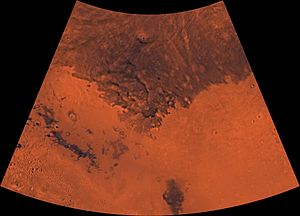
Casius, Mars:
Telescopic albedo feature at 40 degrees North and 100 degrees East, named by Schiaparelli.
From p51 of Lin Carter's The City Outside the World (1977):
They rode west, then north awhile until the mighty wall of the great plateau darkened the horizon to the north. Reaching the foot of the plateau, they skirted it, riding west until sundown, and slept that night in the mouth of one of the innumerable ravines into which the cliffs of Casius were cloven.
The following day they caught their first glimpse of the broad Nilosyrtis. Once this canal had been a mighty river, perhaps, flowing down into the lowlands from the mountainous heights of Casius, and watering the Old City which stood at the northern extremity of that huge peninsula now called Syrtis Major...
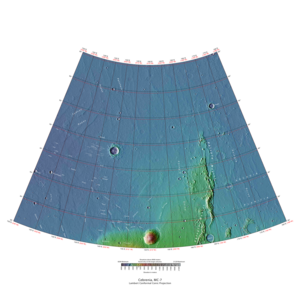
Cebrenia:
Centred on 50 degrees North, 150 degrees East, this area is mentioned in chapter 4 of the volume in Lin Carter's Mysteries of Mars series called The City Outside the World (1977).
The protagonist Ryker, while in Aetheria, reflects that:
...Due east was an even broader expanse of powdery desert called Cebrenia, which stretched on for twelve hundred miles or so before the mesalike bulk of Propontis rose to block the way...
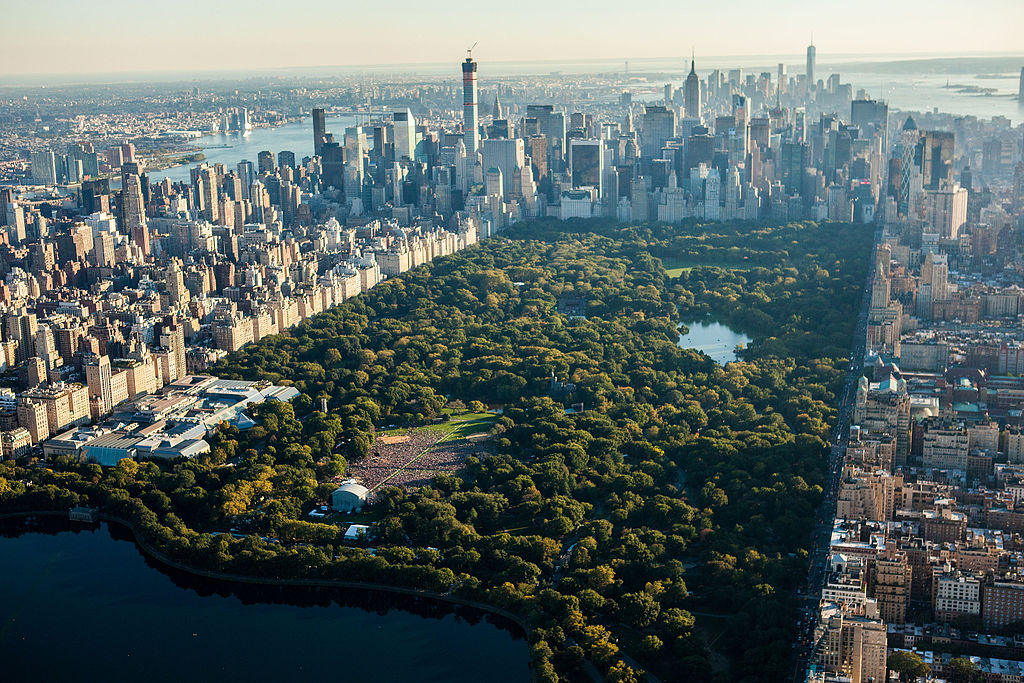
Central Park, New York City, USA:
After a global pandemic has wiped out most of humanity, Isherwood Williams wanders across the USA looking for other survivors, in George R Stewart's Earth Abides (1949). The passages in italics are reflections either by the protagonist (who is a geographer) or by the author.
An island within an island, the green oblong of the Park will remain. It has open soil where the rain penetrates. The sun shines upon it. In the first season the grass grows tall; the seeds fall from the trees and buses, the birds bring in more seeds. Give it two seasons, three seasons, and the eager saplings are sprouting. Give it twenty years, and it is a jungle of second growth with each tree straining upward to gain light above its fellows, and the hardy natives, fast-growing ash and maple, crowding out the soft exotics which man once planted there. You hardly see the bridle path any more; leaf-litter lies thick on the narrow roads. Give it a hundred years, and you walk in full-grown forest, scarcely knowing that man was ever there except where the stone arch still spans the under-pass, making a strange cave. The doe walks in the woods, and the wild-cat leaps upon the rabbit, and the bass jumps in the lake...
[see also Manhattan]
Chaos II:
I have not been able to find an online map reference to this region of Mars, but I feel inclined to trust Arthur C Clarke that the area exists (and not just as a terrain-type applied to many separate locations). I hope to find some reference to it in due course or perhaps a reader may help out. Anyhow, in Clarke's Transit of Earth (Playboy, January 1971) he gives it a memorable mention:
There are no oceans here on Mars, nor have there been for at least five billion years. But there is life of some kind, down there in the badlands of Chaos II, which we never had time to explore.
Those moving patches on the orbital photographs. The evidence that whole areas of Mars have been swept clear of craters, by forces other than erosion. The long-chain, optically active carbon molecules picked up by the atmospheric samplers.
And, of course, the mystery of Viking 6. Even now, no one has been able to make any sense of those last instrument readings, before something large and heavy crushed the probe in the still, cold depths of the Martian night...
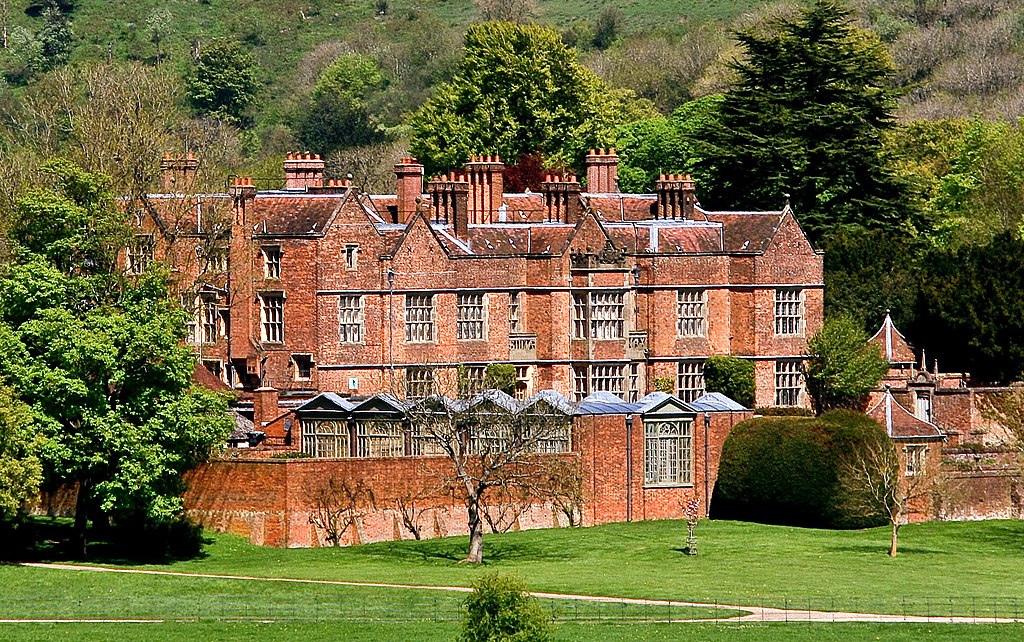
Chequers, Buckinghamshire, England:
In a confused situation of unexplained news blackout from America and imexplicably strange signals from elsewhere, the narrator of Fred Hoyle's October the First is Too Late (1966) is at first treated with suspicion on his arrival in Britain with a group of scientists from the observatories in Hawaii.
We were taken to what was obviously the headquarters of some intelligence unit. Men in uniform, men in civilian clothes, were walking around in a strained, taut way. The American officers were quickly separated from the rest of us. In fact only John and myself and the Australian crew were in civvies. We were shown into rough sleeping quarters. John took this without comment. With a grin he said to me, "They'll soo change their tune."
The following morning, after an unappetizing breakfast, two officers came... We were taken to a waiting car...
The car headed out into west London. It kept on into the country for an hour or thereabouts. At last we turned in at the gates of a pretty flossy place. The house was vaguely familiar.
"Chequers," grinned John. "I told you they'd change their tune."
We were received courteously by the Prime Minister himself. There were a number of other guests, quite a mob of them. The Prime Minister introduced us round...
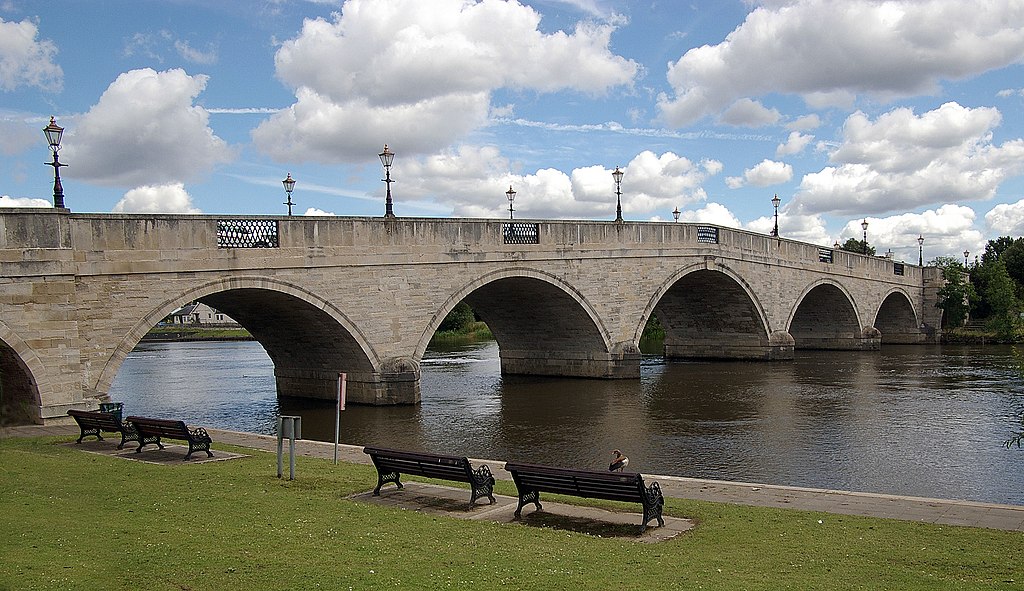
Chertsey, Surrey, England:
This town lies in the invading Martians' target area in H G Wells' The War of the Worlds (1898):
...Quickly, one after the other, one, two, three, four of the armoured Martians appeared, far away over the little trees, across the flat meadows that stretch towards Chertsey, and striding hurriedly towards the river. Little cowled figures they seemed at first, going with a rolling motion and as fast as flying birds.
Then, advancing obliquely towards us, came a fifth. Their armoured bodies glittered in the sun, as they swept swiftly forward upon the guns, growing rapidly larger as they drew nearer. One on the extreme left, the remotest, that is, flourished a huge case high in the air, and the ghostly terrible Heat-Ray I had already seen on Friday night smote towards Chertsey, and struck the town...
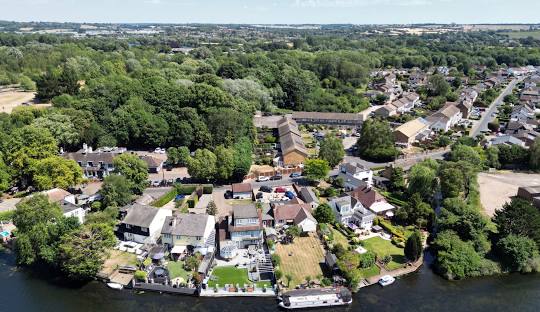
Cheshunt, Hertfordshire, England:
The narrator of John Wyndham's alien-contact novel Chocky (1968), David Gore, is a man with few close relatives, who marries one Mary Bosworth, from a family so numerous that "...I had a feeling of being engulfed". He moves with his new wife after their honeymoon to
...a small house in Cheshunt - a strategic position for easy contact with most elements of the Bosworth ganglion...
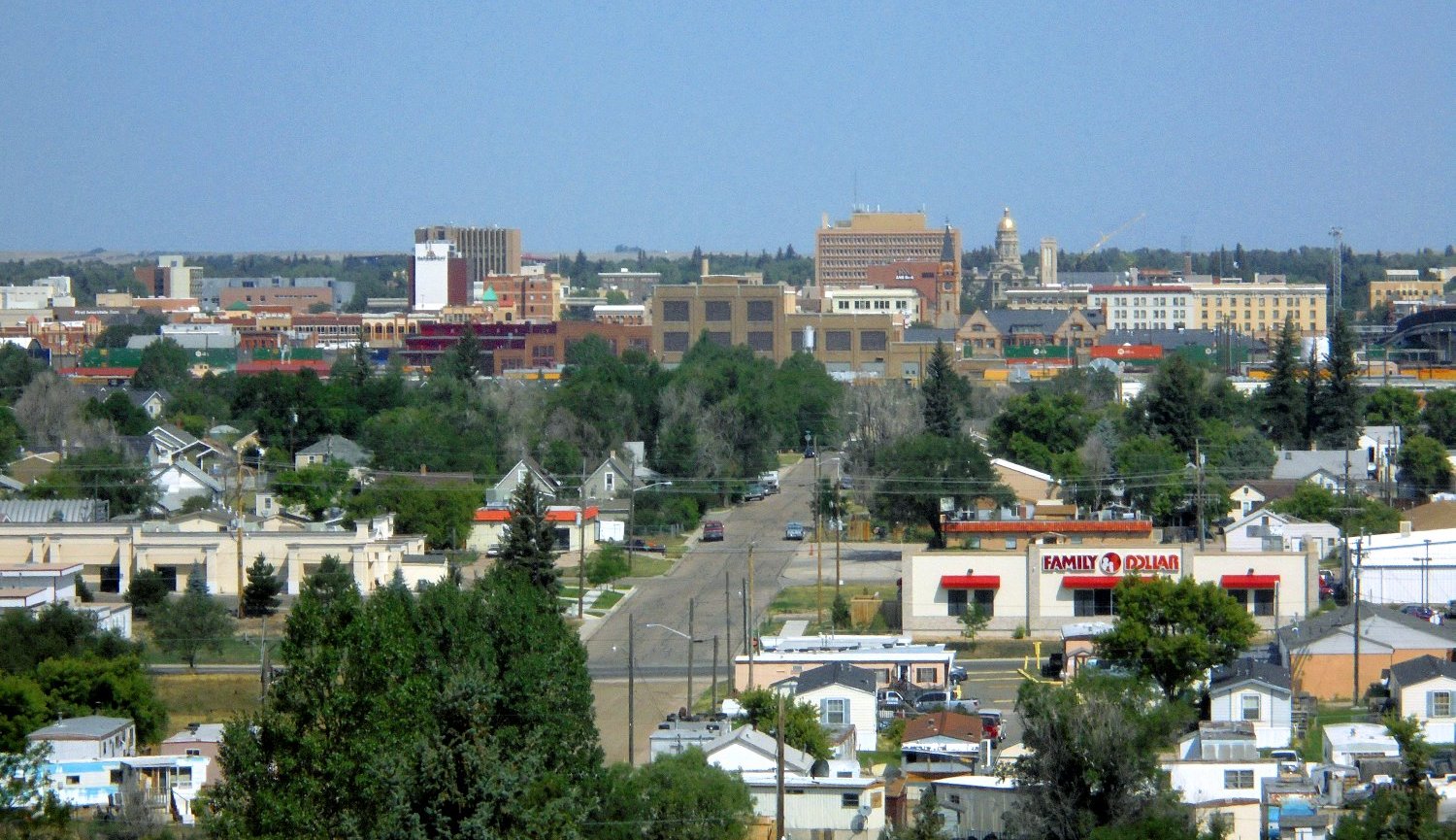
Cheyenne, Wyoming, USA:
Currently a state capital, this city will undergo a further rise in status in the future described by Philip K Dick's Now Wait For Last Year (1966), in which Earth, in the year 2055, is at war with an arthropodal species from the Proxima Centauri system:
...On Terra at the UN capital city, Cheyenne, Wyoming, in addition to those in POW camps, there existed a herd of captured, defanged reegs, maintained on public exhibition by the Terran military establishment. Citizens could file past and gawk and ponder at length the meaning of these exoskeletoned beings with six extremities in all, capable of progressing linearly at a great rate on either two or four legs. The reegs had no audible vocal apparatus; they communicated beewise by elaborate, dancelike weavings of their sensory stalks...
In the same author's The Penultimate Truth (1964), a novel about a huge political deception in which most of the population are fooled into remaining underground because they are made to think World War Three is still raging, Nicholas St James nevertheless emerges on to the surface and, after narrowly escaping death at the hands of hostile "leadies" (robots), finds refuge in the ruins of Cheyenne.
...From the mangled, badly distributed chunks that once had been high buildings, streets, the intricate, strong structures of a major city, four men rose to intercept Nicholas St James. "How come," the first of them said, and all were bearded, ragged, but evidently healthy, "no leadies detected you?"
Utterly weary, Nicholas stood for a time and then he seated himself on a broken stone, fished futilely in his coat pocket for a cigarette...

Chicago, Illinois, USA:
Poul Anderson in Mirkheim (1977) gives us a 26th-century view of Chicago:
Seen from an activated transparency in Nicholas van Rijn's penthouse atop the Winged Cross, Chicago Integrate was a godland of spires, towers, many-colored walls, crystalline vitryl, gracefully curving trafficways, flickering emblems, here and there a stretch of trees and greensward, the sky and the lake as aglitter with movement as the ground itself...
Back in the Twentieth Century, a pilot named Morlake in A E van Vogt's The Earth Killers (Super Science Stories, April 1949) is test-flying a new plane when he encounters a nuclear bomb making a vertical descent towards Chicago in the year 1979. With a much more jaundiced view of the city than van Rijn's, Morlake nevertheless tries to divert the bomb, willing to sacrifice his own life:
...Plans too fleeting to be comprehended multiplied and coalesced. Impersonal plans involving death for his body. Impersonal, because the city below was not his city. No one in it knew about him or cared about him, not even a secondary girl friend. He hated the place. Windy, dirty, wretched, miserable, hot in summer, cold in winter...
Visitors from other worlds find lodgement in Raymond Z Gallun's Hotel Cosmos (Astounding Science Fiction, July 1938):
Viewed casually, the building wasn't very remarkable. Just a beautiful, skyward sweep of glittering chromium, like many of the other structures of twenty-third century Chicago.
It wasn't till you discovered its nature that you received a kind of icy, majestic thrill. Its name, flashing in brilliant lights at night, was Hotel Cosmos. Within its walls lay a haven for every kind of intelligent extraterrestrial creature who dared to cross the interplanetary and interstellar distances to the alien Earth...
Returning to Poul Anderson: in Un-Man (Astounding, January 1953), set after World War III when the UN is trying to establish its authority, the genetically-engineered Martin Donner is captured by anti-UN nationalist conspirators.
He must be in Chicago, Donner decided through a wave of sickness. One of the vast moldering regions that encompassed the inhabited parts of the dying city - deserted, not worth destroying as yet, the lair of rats and decay. Sooner or later, some agricultural outfit would buy up the nominal title from the government which had condemned the place and raze what had been spared by fire and rot. But it hadn't happened yet, and the empty slum was a good hideaway for anybody...
Chicago suffers from a plague brought by a criminal who, unbeknownst to contemporaries, has arrived from the year 10,221, in a tale by Robert Moore Williams, The Red Rash Deaths (Imaginative Tales, July 1957):
...Chicago was a frantic city. Every police officer in town was on the alert. Federal men were present by the scores.
Who was the killer? What were his motives? Where did he come from? What method did he use in his killings? The science of 1970 was baffled...
Chicago was the birthplace of Phillip K Dick, 16 December 1928.
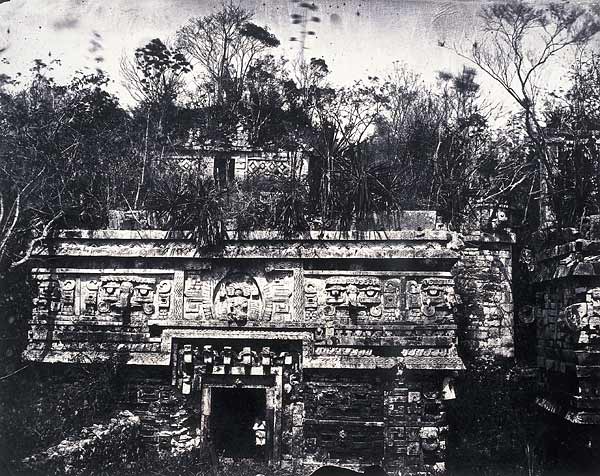
Chichen Itza, Yucatan, Mexico:
The mystery of this Mayan site is woven into the Lovecraft-inspired novel The Philosopher's Stone (1969) by Colin Wilson.
...no power of adaptation. They stayed in their cities until the land that fed them was exhausted: then there was no alternative to a mass migration.
This was not the whole explanation. There was something more sinister here. Why was the social structure so rigid? Why was the priesthood so dominant? Behind Maya civilization lay the conception of the Great Secret, a mystery symbolized by the enormous heads of serpents in their temples. The priests held a secret that was so terrifying that the world might be destroyed if it was ever revealed. It was the priests who had ordered the mass migration. And they believed they were under orders from Someone Else...
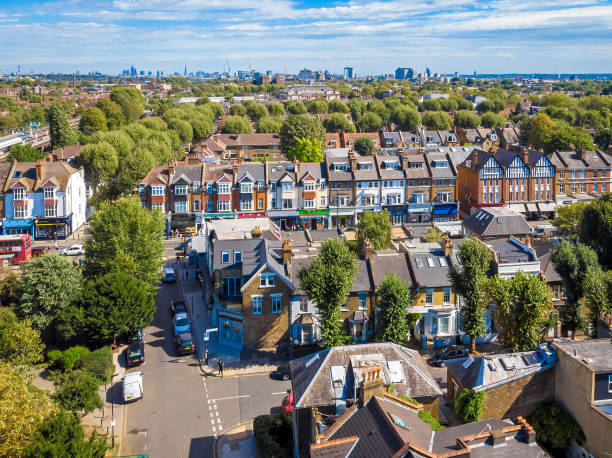
Chiswick, Hounslow, London, England:
In John Christopher's climate-change novel The World In Winter (1962)
an African nation, intending to lay claim to frozen Britain, sends an expedition which explores the Thames area.
...They found human life again at Chiswick. At first there were odd figures on the banks of the frozen river, some retreating, as the Hovercraft approached, into the hinterland of buildings, others - bolder or more curious - staring and gesticulating...
...By Chiswick Bridge the activity was greater and more purposive. A mob that had gathered on the left bank spilled out on to the bridge itself... They shook their fists and howled inaudible curses. Some stooped down and rummaged in the snow, looking for stones which they threw at the Hovercraft.
Abonitu said, smiling: "The natives seem unfriendly..."
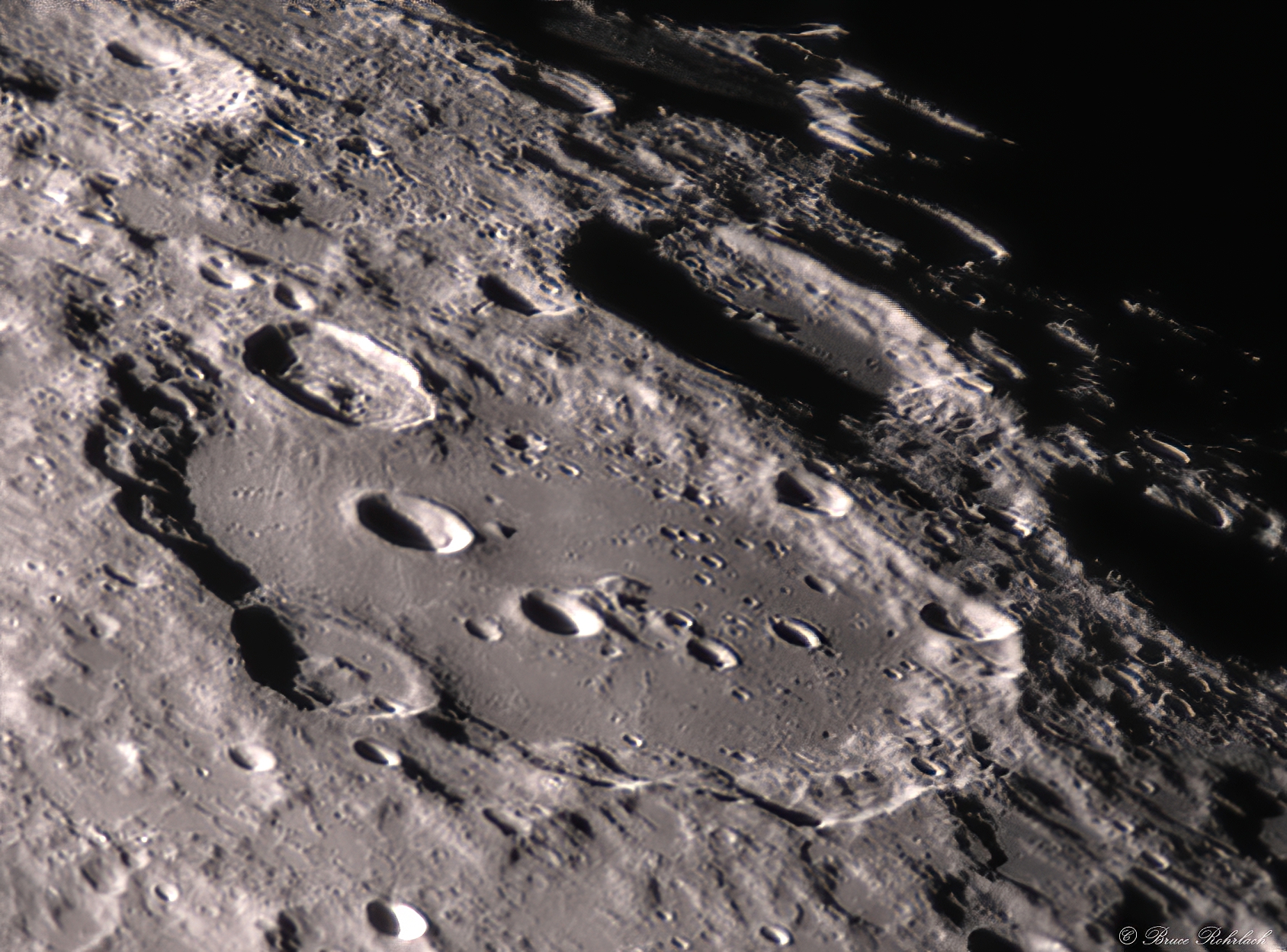
Clavius (crater):
Location of the hiding-place chosen for a scientific discovery in The Key (Fantasy and Science Fiction, October 1966) by Isaac Asimov.
Urth said solemnly, "I would suggest you search the shaded rim of Clavius, at that point where the Earth is nearest the zenith..."
The crater provides an important location in Clarke's 2001: A Space Odyssey (1968):
Clavius, a hundred-and-fifty miles in diameter, is the second largest crater on the visible face of the Moon, and lies in the centre of the Southern Highlands. It is very old; ages of vulcanism and bombardment from space have scarred its walls and pock-marked its floor. But since the last era of crater-formation, when the debris from the asteroid belt was still battering the inner planets, it had known peace for half a billion years.
Now there were new, strange stirrings on and below its surface, for here Man was establishing his first permanent bridgehead on the Moon. Clavius Base could, in an emergency, be entirely self-supporting...
A different slant on the area's administrative side is given by the same author in his shipping-disaster novel A Fall of Moondust (1961). Chapter 7 begins:
In Clavius City, Chief Administrator Olsen and Tourist Commissioner Davis had just finished conferring with the Legal Department. It had not been a cheerful occasion; much of the time had been discussing the waivers of responsibility which the missing tourists had signed before they boarded Selene...
On page 42, Commodore Hansteen, trapped with the other passengers in the dust-cruiser Selene, reflects:
...By now, he should have been on the other side of the Moon, back in Clavius City. He had a lunch engagement at the Lunar Hilton, and after that a trip to - but there was no point in thinking about a future that could never exist...
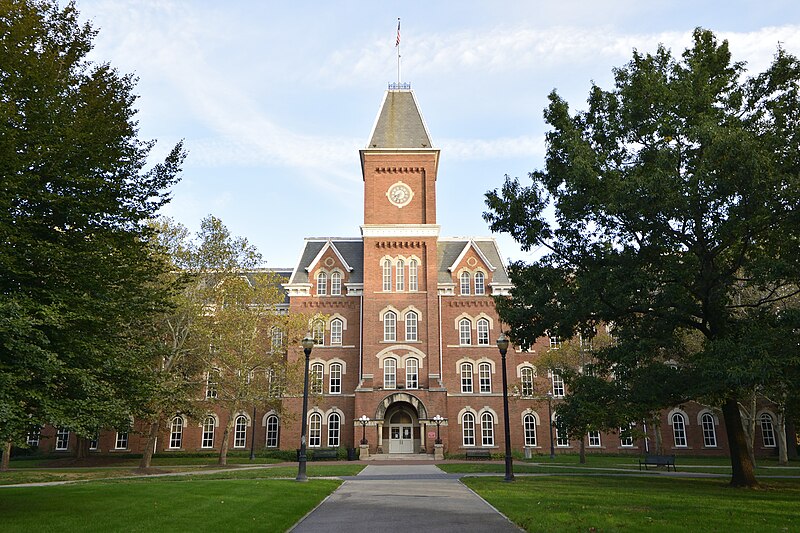
Columbus, Ohio, USA:
Honor White Jackson, from the half-forgotten Mars colony described in The Iron Thorn (1967) by Algis Budrys, finally reaches Earth on the intelligent spacecraft "Susiem", with a touch-down at Columbus, where he finds a decadent culture over-dependent upon mobile computer-units like swarms of intelligent insects.
...Earth was pastorally gree, its hillocks crowned by elms, its infrequent, low buildings stark white. "This is the site of the Associated Universities docking facilities," Susiem said as Jackson stared out through the open airlock hatch... "There have been social changes on Earth since my last communication from the Project. I have just been assured that you will be brought up to date on these changes by another source..."
...Jackson looked up at Susiem's height. She was beginning to ring. He noticed a swarm of bright, dancing insects whirling around the very tip of her prow. They bulleted in from over the top of the nearest hillock in a stream that thickened rapidly...
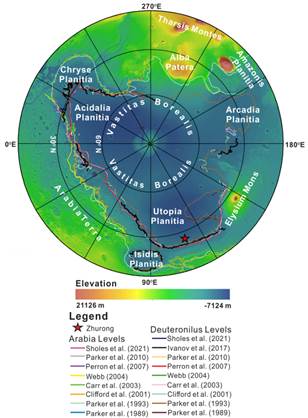 Copais Palus is at 54 degrees 40 minutes North, 80 degrees zero minutes East.
Copais Palus is at 54 degrees 40 minutes North, 80 degrees zero minutes East.Copais:
Harl Vincent in Lost City of Mars (Astounding Stories, February 1934) refers to a city Copais, whereas on old maps of Mars it was a lake (Copais Lacus) and nowadays it is a "swamp" (Copais Palus):
SPRINGING up, as if in actual miniature
reproduction, was one of the canal cities of Mars. There was a section of
dryland territory on the one side of moonlit Canal Pyramus, the spires and
minarets and glistening nickel-cobalt roadways of the city on the other. Lights
of many ronsals, the vehicles whose elongated bodies were supported
a few feet above the roads by the energies with which they were charged, could
be discerned plainly. The traffic was that of mid-evening, proceeding at a
leisurely pace.
“It’s Copais!” breathed Coler. “Right!” said Kal.
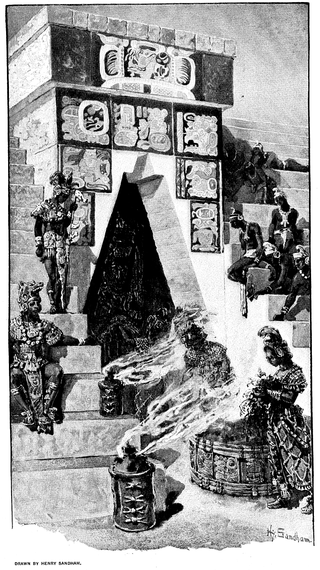 painting by Henry Sandham, 1898
painting by Henry Sandham, 1898Copán, Honduras:
In Edmond Hamilton's novella Lords of the Morning (Thrilling Wonder Stories, August 1952) archaeologist Ed Martin, investigating Maya ruins, undergoes involuntary mental time-travel whereby his mind is transferred to the body of one Pedro Yanez, sixteenth-century conquistador. (And an unsuspected connection between the Maya and the planet Venus becomes apparent during the violent and tragic adventure.)
...Copan, that mightiest of old Mayan cities, lost and forgotten for centuries with the Empire that had built it. So long lost and so well forgotten, that Martin had not credited Stephen's account of an expedition under one Hernando de Chaves that attacked a rich and living Copan early in the Sixteenth Century.
Now he would know. He was marching with Hernando de Chaves... The sun was hot, and he was trapped in alien flesh...
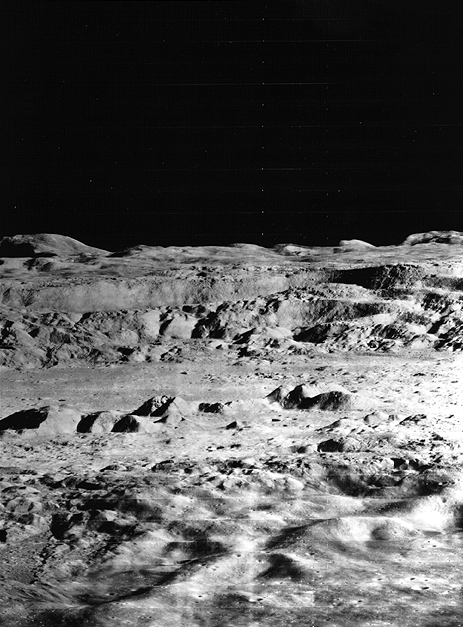 Copernicus from Lunar Orbiter 2
Copernicus from Lunar Orbiter 2Copernicus:
For a reference in William F Temple's Shoot at the Moon (1966) see Mare Nubium.
In James P Hogan's Inherit the Stars (1977), a fifty-thousand-year-old humanoid corpse is discovered in a cave near the base named "Copernicus Three".

Copernicus' interior would have also been a likely destination for Apollo 20, had that mission not been cancelled. The risks of a landing amid such topography might have been considerable, but the fascination of the terrain could have made it worth while. The fantastic image shown here above reveals huge boulders that have slid down the slopes of one of the mountains on the crater-floor. See the article, Lost Moon: Reconstructing the Missions of Apollos 18, 19, and 20 (Part 2).
Back to golden age sf: Raymond Z Gallun in Trail Blazer (Fantastic Story Magazine, Fall 1951) has his Native American tracker momentously discover, just outside the crater, evidence of ancient alien combat on the Moon. Later in the same story,
...A year passed. Camp Copernicus became a little city, with all the comforts of civilization - with beautiful gardens even - under the shining domes. It was the seed of the glory of the future...
Copernicus is at the site of one of the three ancient Lunar nuclear power plants which exploded together and robbed the Moon of its native life, in Heinlein's Blowups Happen (Astounding, September 1940; see also The Implicizer aimed at Blowups Happen).
Edmund Cooper in The Tenth Planet (1973) has his hero reminisce about his early days as a qualified spaceman; his memory
...ran away to the newly established Lunaport Two in the great crater Copernicus. He was a cadet, and he had just completed his first operational shoot. So now he was a true spaceman, inordinately proud of the tiny, silver star that had recently been sewn on the flap of his left breast pocket.
He was in the Lunaport aerodrome, sipping his first moon beer. Men with twenty stars or more sewn on their pockets smiled at him. Some even raised their glasses. They knew how he was feeling...
A landing in Copernicus is effected in B Wallis' The Voyage of Neutralia (Weird Tales, November 1937), in which the scene is described as including mossy plants - see the extract, Slight vegetation on the Moon.
A Fall of Moondust (1961) by Arthur C Clarke contains a brief reference:
"Thirty-two - and no steady girl-friend?"
Ha! thought Pat - there are several things you don't know about me. But there was no point in mentioning Clarissa and her little apartment in Copernicus City...
The crater is mentioned in John Christopher's Occupational Risk (in the collection The Twenty-Second Century, 1954):
...The Lucas did not normally make planet-falls... On this occasion, though, she was carrying some supplies for the observatory at Copernicus. They stayed over ten hours at Luna City...
The two names in adjacent sentences allows the possibility that the author intended to suggest that Luna City is actually in or next to Copernicus. However, it seems much more likely to me that a spaceport and colony-capital would be situated a considerable distance away from an observatory, since astronomers prefer uncontaminated signals for their instruments, so the way I read it is that the ship deposited the supplies which were then transported long-distance, by means unspecified, to Copernicus. In which case we could, if the fancy takes us, overlap this Luna city with Heinlein's (in Mare Fecunditatis) or Asimov's (in Tycho)...
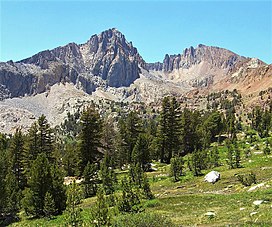
Crater Mountain, California, USA:
I am assuming that "Crater Ridge" is a ridge on Crater Mountain. The location, specified as "among the Sierras", seems to fit the reference in Clark Ashton Smith's The City of the Singing Flame (1931).
I had gone for a walk on Crater Ridge, which lies a mile or less to the north of my cabin near Summit. Though differing markedly in its character from the usual landscapes round about, it is one of my favorite places. It is exceptionally bare and desolate, with little more in the way of vegetation than mountain sunflowers, wild currant-bushes, and a few sturdy, wind-warped pines and supple tamaracks.
Geologists deny it a volcanic origin; yet its outcroppings of rough nodular stone and enormous rubble-heaps have all the air of scoriac remains - at least, to my non-scientific eye. They look like the slag and refuse of Cyclopean furnaces, poured out in pre-human years, to cool and harden into shapes of limitless grotesquerie...
Crete:
Earthquakes, eruptions and changes in sea-level have transformed the geography of the Mediterranean across which Mal Irish pursues Ricia's kidnappers in Keith Laumer's Catastrophe Planet (1966):
...At sunset I reached a swampy stretch on the far side of which the island of Crete was a dim line of light. I found a sheltered stretch of former beach under a line of giant weed-covered rocks, pulled the car over and slept until dawn.
The Cretan shore was rocky, dry, parched, a landscape in Hell under the garish colors of sunrise seen through smoke...
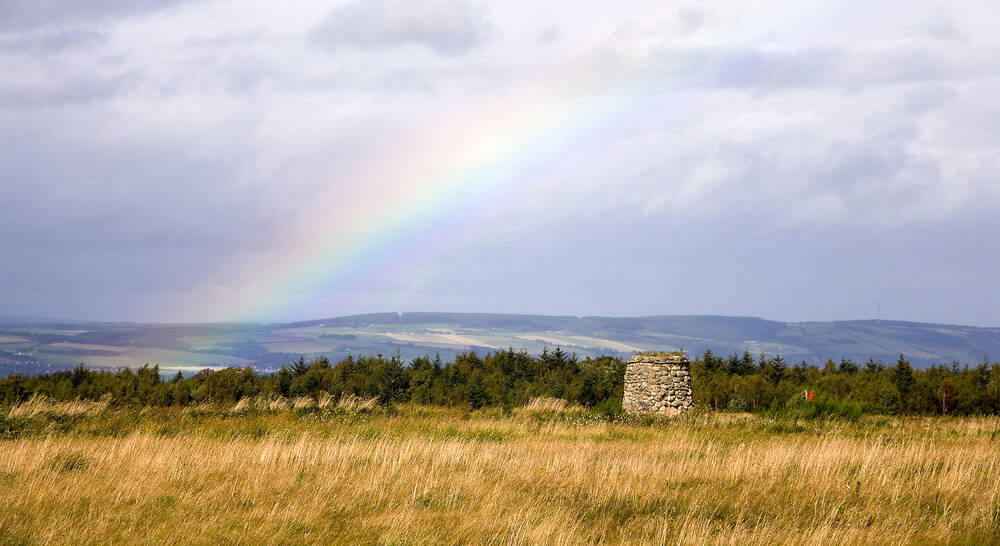
Culloden Moor, Inverness-shire, Scotland:
After a lapse of years the Highlander physicist-hero of Inferno
(1973), a cosmic-disaster novel by Fred and Geoffrey Hoyle, pays his
third visit to the historic site - shortly before the unexpected
calamity which renders most of Earth uninhabitable - and is appalled by
what he sees.
...It came as an intense shock to find the battlefield grown over by
woodland. Cameron parked the car some two hundred yards back from the
memorial cairn. Leaving Madeleine there he walked to the clan graves.
At least the graves had been left in open ground. He stood for a
while. Then walking away to the trees a black fury seized him. This
was the final indignity. Not content with cruelty and persecution. Not
content with stealing the land, not content with evictions, not content
with an endless draining of vigour from the Highlands, they must even
obliterate the very ground on which men had fought and died.
Obliterated by mean trees, not even dignified trees of good quality.
Obliterated by the very poorest quality trees. What was it but part of a
determined degradation of the old culture by these unremitting
creatures to the south?
"May the wrath of God strike you some time," Cameron muttered....
(In this book, italics mean that the words are spoken in Gaelic.)
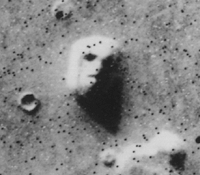 the Viking 1 image that caused all the excitement
the Viking 1 image that caused all the excitementCydonia:
The celebrated "Face" features in the 2000 film Mission to Mars, directed by Brian De Palma, in which an artificially-triggered gale abruptly strips off the outer layers of the feature, to reveal the alien physiognomy of an monumental structure designed by the extinct Martians. (This scenario would actually be conformable with the later probe results which "debunk" the Face. That's to say, a real Face could still be underneath what we see.)
The region of Cydonia, albeit Faceless, is also briefly mentioned in Evan Hunter's Terwilliger and the War Machine (Universe, September 1954):
"Confound it," Rumpelstil-Meyer shouted. "I haven't run across anything like this since the Scrimmage of Cydonia!"
"June 9, 2842. Earth was led by General Mark van der Still. A brilliant defeat. For Earth, unfortunately."
Dallas, Texas, USA:
...A brand-new six-megahorse job, it rode high and smooth on a two-foot air cushion. It was too bad about the broken hatch lock, but back in Dallas I hadn't had time to look around for the owner. The self-appointed vigilantes who called themselves the National Guard had developed a bad habit of shooting first and checking for explanations later. True, I had been doing a little informal shopping in a sporting goods store - but the owner would not have cared. He and most of the rest of the city had left for points north...
- Keith Laumer, Catastrophe Planet (1966), p.7
Damascus, Syria:
Dazed by the horror of the news of an unexplained nuclear attack on this city, mathematician Lucas Hutchman decides upon his dangerous anti-weapons gamble in Bob Shaw's The Peace Machine (1971, 1985).
"Vicky," he said, almost guiltily. "Something has happened. I just heard a news flash on the television. They say Damascus has been wiped out by a hydrogen bomb."
"How awful." Vicky turned, her hands full of diced cheese, and nodded towards a glass-fronted cupboard. "How ghastly. Be a darling and reach me down the small casserole..."
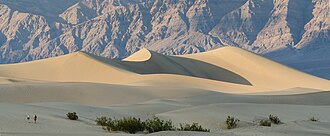
Death Valley, California, USA:
In D F Jones' Colossus (1966), Death Valley is the site of a nuclear explosion perpetrated by the despotic supercomputer as a punishment for disobedience.
Blake's head lolled to one side, yet in his eyes Forbin saw intelligence struggling with unspeakable horror and fear. He swallowed, gasped for air.
"The missile team - Death Valley - missile, missile exploded in its silo - I don't know, know any..."
In Jack Vance's Slaves of the Klau (1958) an alien admires the scene:
"...I consider Earth among the more beautiful worlds. Have you noticed the valley to the southeast, the hundred soft colours?"
"Beautiful."
"Beautiful, and also deadly. Indeed the Earthers call it 'Death Valley'."
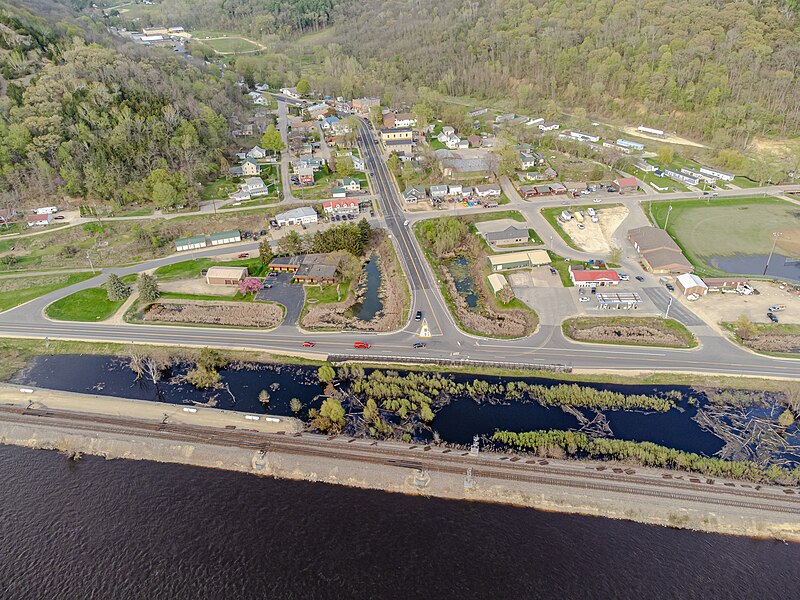
De Soto, Wisconsin, USA:
The place is featured in Clifford Simak's The Visitors (1979), chapter 53, by which stage in the story people are rushing to help themselves to free gifts (such as cars) grown by the alien visitors, plant-based organisms with fantastic powers of replication.
The South Dakotan who had nursed his dilapidated car for more than five hundred miles, the machine rattling and banging, coughing and gasping, every wheeze threatening to be its last, pulled into the small town of De Soto, a wide place in the road hemmed in between bluff and river. He tried to find a place to park, but there was no place left in the town to park. The one long street was jammed with cars and people, and there seemed to be much angry shouting and running about, and the frightening, sobering thought crossed his mind that possibly all the people here had also come for cars...
Deltaton Sinus:
From Patrick Moore's 1955 rescue-mission novel Mission to Mars, p120:
...Just about the time of sunset, they began to meet with isolated patches of the mossy vegetation, while in the distance they could just make out a more extensive area of greenness.
Mellor pointed. "See that? It's the beginning of the dark area that astronomers call the Deltaton Sinus. Frankly I'm glad to see it, because it shows me that we're just about where I thought we were...
The rescuers want to find the wreck of the Hermes, the first rocket to reach Mars, from which, some months before, a fragmentary radio message had been received on Earth (see the entry for Aeria).
I have been unable to find a picture to go with this entry for Deltaton Sinus, but Patrick Moore (1923-2012) was a famous expert on Mars and knew what he was talking about, so the feature must exist in cartographic history. Readers are welcome to help research the issue and find me a picture! Page 77-8 gives a clue, confirming that the rescuers have landed in Aeria, without being certain of the whereabouts of their goal.
Struck by a sudden thought, he reached for the map of Mars that lay on the chart table. On it Mellor had marked their estimated position, latitude 5 north longitude 320 - on the desert between the vegetation tracts of Deltaton Sinus and Sinus Sabaeus...
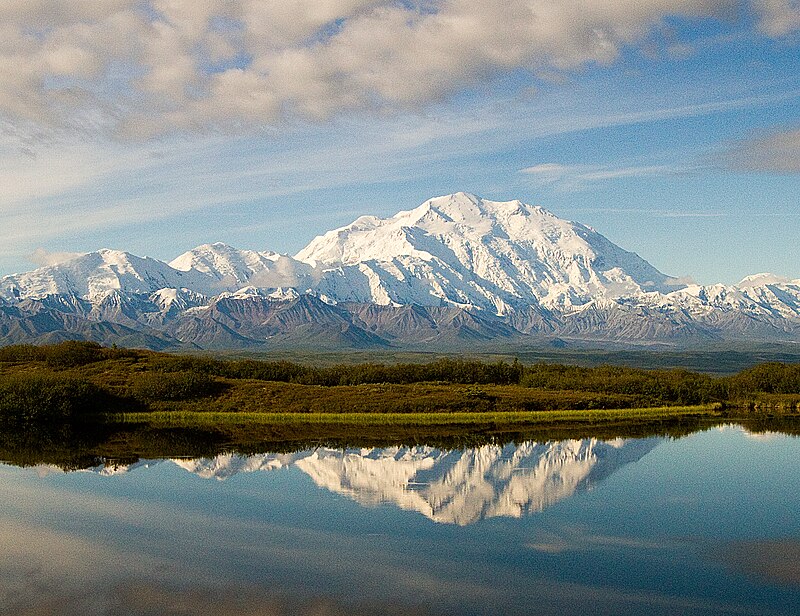
Denali, Alaska, USA:
[officially "Mt McKinley" until August 2015]
The threat of an approaching anti-matter body threatening to destroy the Earth is first discovered from here in John D Clark's Minus Planet (Astounding Stories, April 1937):
...It was on January 15, 2156, that the astrophysicist, Dr. James Carter, had the first glimpse of light - literally. He was working on the new five-hundred-inch reflector of the Mt. McKinley observatory at the time, and noticed a darkening of his photographic plate from the spectrometer focused on Polaris... a uniform darkening over the whole spectral range...
Denver, Colorado, USA:

The pioneer time-travellers in Clifford Simak's The World of the Red Sun (Wonder Stories, December 1931) start out with a faulty dial on their time machine, travelling into the future a thousand times faster than they planned.
...They were silent, studying the landscape about them. They saw only ruins which towered hundreds of feet above the sands. They were ruins of noble proportions, many of them still bearing the hint of a marvelous architecture of which the twentieth century would have been incapable. The stone was pure white, gleaming beautifully in the twilight which the feeble rays of the great brick-red sun could not expel...
...A creature, somewhat like a dog, dull gray in color, with tail hanging low, was silhouetted for a moment on a sand dune and then disappeared.
"These are the ruins of Denver," said Harl. "That sea we saw must cover the whole of eastern North America. Probably only the Rocky Mountains remain unsubmerged and they are a desert..."
A memorable glance at the future of Denver is given in Theodore Sturgeon's classic tale Microcosmic God (Astounding, April 1941):
...Built on the ruins of Denver, which was destroyed in the great Battle of the Rockies during the Western War, stands the most beautiful city in the world - our nation's capital. New Washington....
Denver is close to becoming a port city after the huge geological changes described in the earth-change tale by Allan Danzig, The Great Nebraska Sea (Galaxy, August 1963), whereby the Great Plains become an arm of the Gulf.
...It would indeed seem odd to an American of the 'fifties or 'sixties of the last century to imagine sailors from the merchant fleets of every nation walking the streets of Denver, fresh ashore at Newport, only fifteen miles away...
Denver apparently hasn't fared too well - has apparently disappeared though with no signs of destruction - in Fred Hoyle's unique novel of time-mixing, October the First is Too Late (1966).
...We came down very low over Denver. It wasn't entirely easy to be sure we had located the correct place. There were no radio beacons to guide us. All navigation had to be done with the compasses, and even by the old-fashioned method of simply looking down on to the ground. Denver was a good place to look for. The big sudden rise of the Rockies lies only thirty miles or so to the west. That landmark was quite unmistakable, so all we had to do was to fly on a north-south line until the crew felt convinced they had found the right place. Once again we came low, to a thousand feet or so. Below us there were open grasslands...
In The World Jones Made (1956) by Philip K Dick, the precog Floyd Jones,
to whom the future up to a year ahead is so real that in effect he is
"a man with his eyes in the present and his body in the past", is
looking for a way and a place to live.
...He found the Denver area painfully recovering from the blast. That was expected, as was everything else. One year before, at fourteen, he had previewed his journey. Once again, but this time at first hand, he examined the gaping crater the bomb had left, conjectured on the thousands of people who had been turned to ash in the wink of an eye. He boarded a bus and left Colorado...
The future Denver to which language-expert Paul Kosloff is summoned in Mack Reynolds' The Computer Conspiracy (Worlds of If, November 1968) is home to the huge National Data Center, whose director has beome more powerful than the President:
...They emerged into an extensive office - so extensive that Paul Kosloff hissed in surprise between his teeth. The vacuum-tube terminal from which they had just emerged had a bank of at least twenty-five entries, and Paul got the feeling that this was but one terminal of many i this building.
On top of that, literally scores of persons were either riding one or two-seater inter-office floaters or striding quickly up and down halls...
Des Moines, Iowa, USA:
Birthplace of Alan E Nourse, 11 Autust 1928.
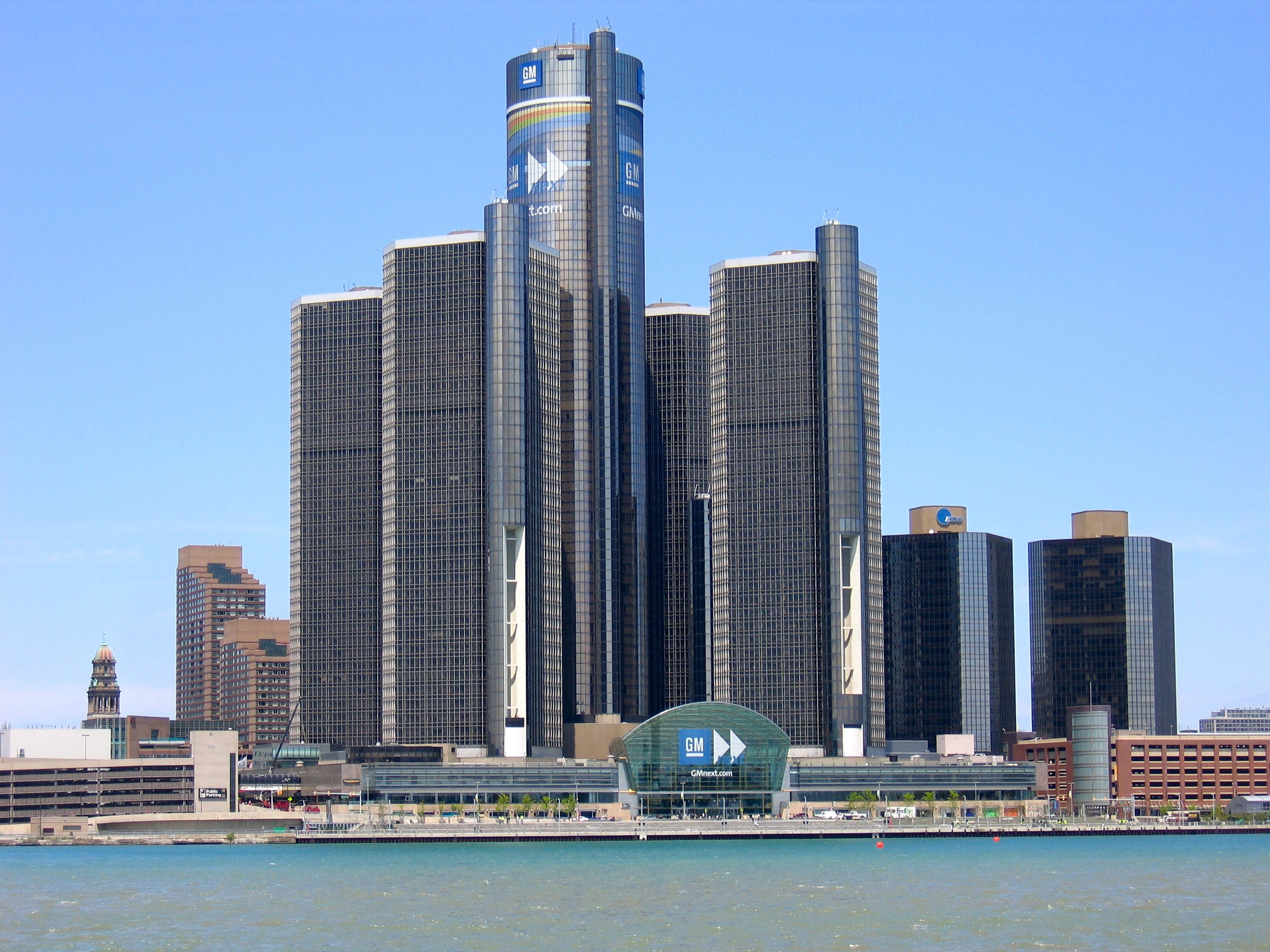
Detroit, Michigan, USA:
The city suffers a mysterious fate during the chaotic outbreak of temporal/probability shufflings in Murray Leinster's Sidewise in Time (Astounding Stories, June 1934):
We still do not understand what happened to Detroit. It was upon an oscillating segment of earth. It vanished from our time, and it returned to our time. But its inhabitants did not come back with it. The city was empty - deserted as if the hundreds of thousands of human beings who lived in it had simply evaporated into the air. There have been some few signs of struggle seen, but they may have been the result of panic. The city of Detroit returned to its own space and time untouched, unharmed, unlooted, and undisturbed. But no living thing, not even a domestic animal or a caged bird, was in it when it came back. We do not understand it at all...
Deucalionis Regio:
From Lin Carter's Martian "lost race" novel The Valley Where Time Stood Still (1974), p.22:
...What in the world did Thaklar hope to find in that part of the country? The plateau was a dead wilderness of sterile rock, cleft asunder by a thousand canyons and ravines; Deucalionis was a curved tongue of dustland that extended into the highlands between two plateaux. Seventy million years ago it had been a bay, perhaps, or a river delta, cut deep into a continental coast. Now it was nothing: dead rock, scoured with sand, where few wild beasts roamed...
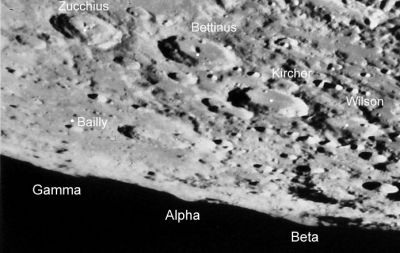
the Doerfel Mountains (=Montes Doerfel):
From R W Mackleworth's Starflight 3000 (1972), in which the Moon has acquired a proto-atmosphere:
Lower on the slope he spotted a movement.
He edged away to the southeast, into the foothills of the Doerfuls. It was not the right direction but it skirted the dangers of the crater and its red mist. He had no wish to die before his time...
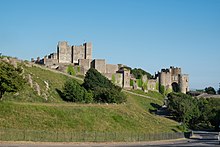 not cardboard, but admittedly smooth as if just cut out
not cardboard, but admittedly smooth as if just cut outDover, Kent, England:
Bond concentrated on his driving as he coasted down into Dover. He kept left and was soon climbing out of the town again past the wonderful cardboard castle.
There was a patch of low cloud on top of the hill and a spit of rain on his windshield. There was a cold breeze coming in from the sea...
- Ian Fleming, Moonraker (1955)
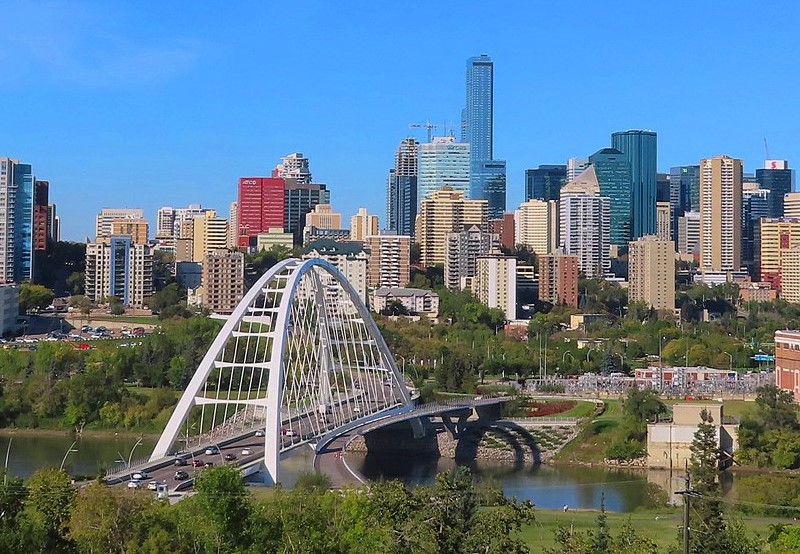
Edmonton, Alberta, Canada:
Some time in the early 36th century, the mad poet Navarth is hoping that he and his young ward may escape the attention of arch-villain Viole Falushe, in Jack Vance's The Palace of Love (1967):
...When the girl was sixteen, they lived in Edmonton, Canada, the goal of hordes of pilgrims who came to gaze upon the Sacred Shin. Navarth reckoned that here, among the interminable festivals, processions and sacerdotal rites, they might well live unnoticed.
But Navarth was wrong. Viole Falushe by some means knew his whereabouts. One night the telescreen lit up to show a tall figure standing against a flashing blue background which obscured his features...
After some rather chilling dialogue, in which the Demon Prince reproves Navarth for failing to "educate" the girl with the proper preconditioned receptivity, Falushe ends with:
"But now you know what I expect. I hope you will repair your neglect."~
The screen went dead. Navarth in a fury of frustration and resentment went striding out along the Great Nave, that avenue extending from the Plaza of Beatitudes to the Temple of the Shin. But the press of pilgrims irked him, and he took refuge in a teahouse...
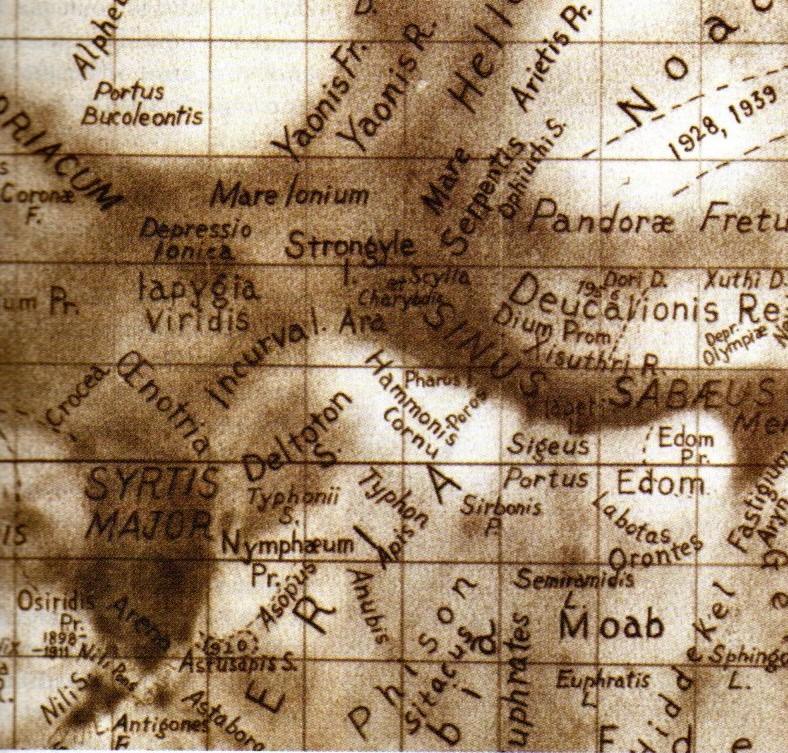 On the right, bounded by the curve of Sinus Sabaeus and (mostly off the map) Sinus Meridiani
On the right, bounded by the curve of Sinus Sabaeus and (mostly off the map) Sinus MeridianiEdom Promontorium:
Reports by observers of a flare in this part of Mars in 1954 had an influence on fiction, according to what I'm told when I google "Mars 1954 flare fiction"; for example in the film of that year Devil Girl From Mars. Unfortunately as yet I haven't found any precise literary references. See the second item for the year 1954 in the History of Hopes. (Map produced by Shiro Ebisawa; see Sky & Telescope, May 2001, p.119. of the article The Martian Flares Mystery, a goldmine of fascinating and mysterious detail.)
(Edom Promontorium is now known as the crater Schiaparelli.)
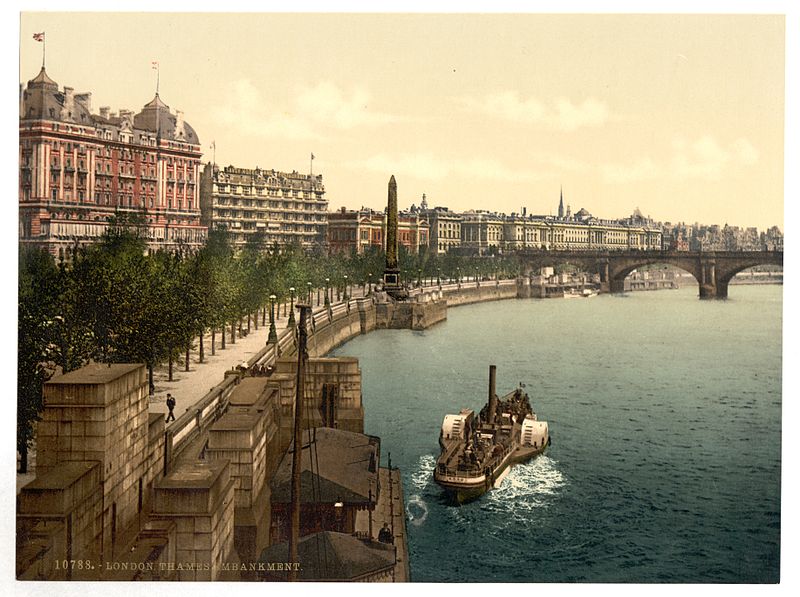 the Thames Embankment on an 1890s postcard
the Thames Embankment on an 1890s postcardthe Embankment, London, England:
In the first of Sir Arthur Conan Doyle's adventures starring the egomaniacal Professor Challenger, The Lost World (1912), Challenger and his rival, Professor Summerlee, spend much time feuding with each other. The narrator recounts:
...Last night Challenger said that he never cared to walk on the Thames Embankment and look up the river, as it was always sad to see one's own eventual goal. He is convinced, of course, that he is destined for Westminster Abbey. Summerlee retorted, however, with a sour smile, by saying that he understood that Millbank Prison had been pulled down. Challenger's conceit is too colossal to allow him to be really annoyed. He only smiled in his beard and repeated "Really ! really !" in the pitying tone one would use to a child....
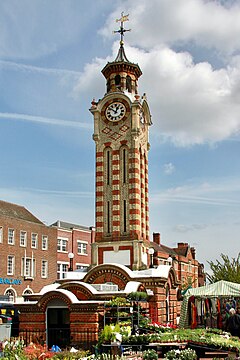
Epsom, Surrey, England:
Howell Trowman, the young protagonist of L P Davies' thriller What Did I Do Tomorrow? (1972), has been subjected to a form of mental time-travel, after which he finds himself incomprehensibly beset by enemies and the target of murder attempts. Hoping to find answers to a mysterious five-year gap in his life, he drives towards his former home, though aware that he may be going into a trap:
...Another half hour, and he was in the friendly-familiar outskirts of Epsom - sun-warm russet walls, square red-and-white towers topped with glistening weathervanes, fold upon fold of distant, gently rolling green hills...
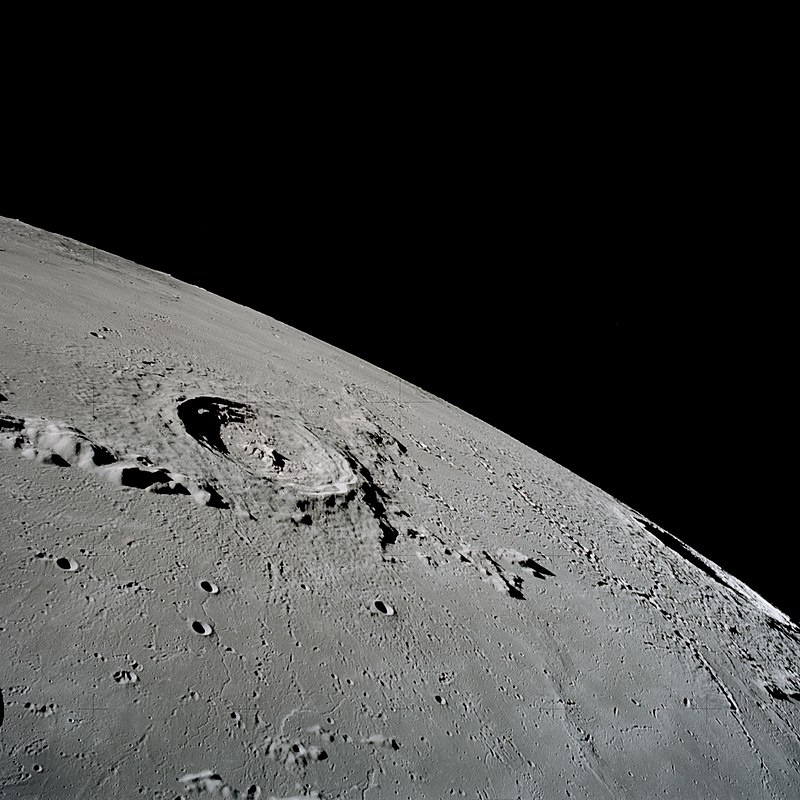 from Apollo 17
from Apollo 17Eratosthenes:
As well as the fictional, this site is intended to cover the non-fictional Old Solar System, which is to say the old ideas of what was really there; yet compared with the coverage of the fictional, I've hardly dealt directly with the non-fictional at all. Of course by implication, as story-writers have been inspired by what is now out-of-date science, I have explored that science to a fair degree; but not explicitly enough for my liking. Still, here's an exception, regarding the 35-mile-wide crater Eratosthenes.
From Wikipedia:
From 1910 to the 1920s, William H. Pickering
noted dark patches in the crater that varied in a regular manner over
each lunar day. He first put forward the speculative idea that these
patches appeared to migrate across the surface, suggestive of
vegetation. Pickering believed that the Moon had a thicker atmosphere
and reported seeing climatic variations such as frost and snow, leading
him to refer to the crater as the "Gardens of Eratosthenes". Later his views would change, and he would come to believe that the vegetation was instead "swarms of animal life",
which he often referred to as swarms of insects, or "lunar insects".
The scientific community did not share his enthusiasm for these ideas, but they received a degree of attention in the popular press of the time primarily due to Pickering's reputation.
See also the Diary entry, A Fruitful Lag.
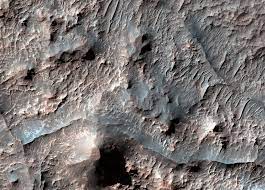
Eridania:
...By the next day we had flown across the Scamander canal and were in the dustlands of Eridania. It took us a whole day of steady travel to cross the broad bowl of yellow dust, and we were all restless and quarrelsome from being cooped up for so many endless hours in the narrow confines of the skimmer's cabin... From the quest for the Treasure City recounted in The Man Who Loved Mars (1973), by Lin Carter.
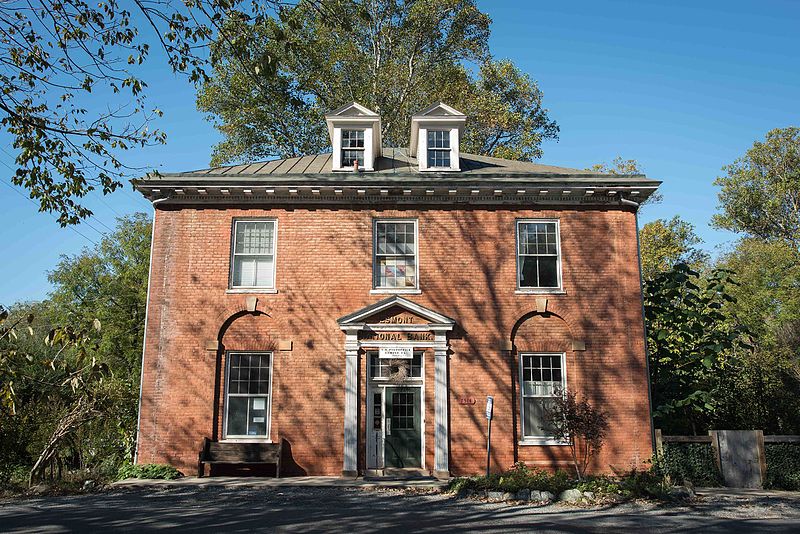
Esmont, Virginia, USA:
From John Christopher's story of an anti-machine movement, The Prophet, among the inter-linked tales of his The 22nd Century (1954):
...Esmont, in Virginia, was the centre, as far as a centre existed, of the Prophet's movement. There had been constructed the huge amphitheatre, built on Greek lines to make speech possible to a vast audience without mechanical amplification...
Fastigium Aryn:
I haven't found a picture for this Martian feature. The location is given as Latitude 10 degrees, Longitude 15, in the Gangale and Dudley-Flores list of "Proposed Additions to the Cartographic Database of Mars", which states that the name originated with Lowell. I haven't been able to ascertain whether it is still in use at all but there are plenty of post-Lowell references online, one as late as 1970 (Observational Patrol of Mars in Support of Mariners Vl and Vl, by C F Capen)..
From Signboard of Space by Frederic Arnold Kummer, Jr (Thrilling Wonder Stories, December 1939), describing an approach to the Red Planet:
...I am impressed by the similarity of certain curiously regular designs, formed by the canals, to other designs which I have previously noticed upon the Fastigium Aryn...
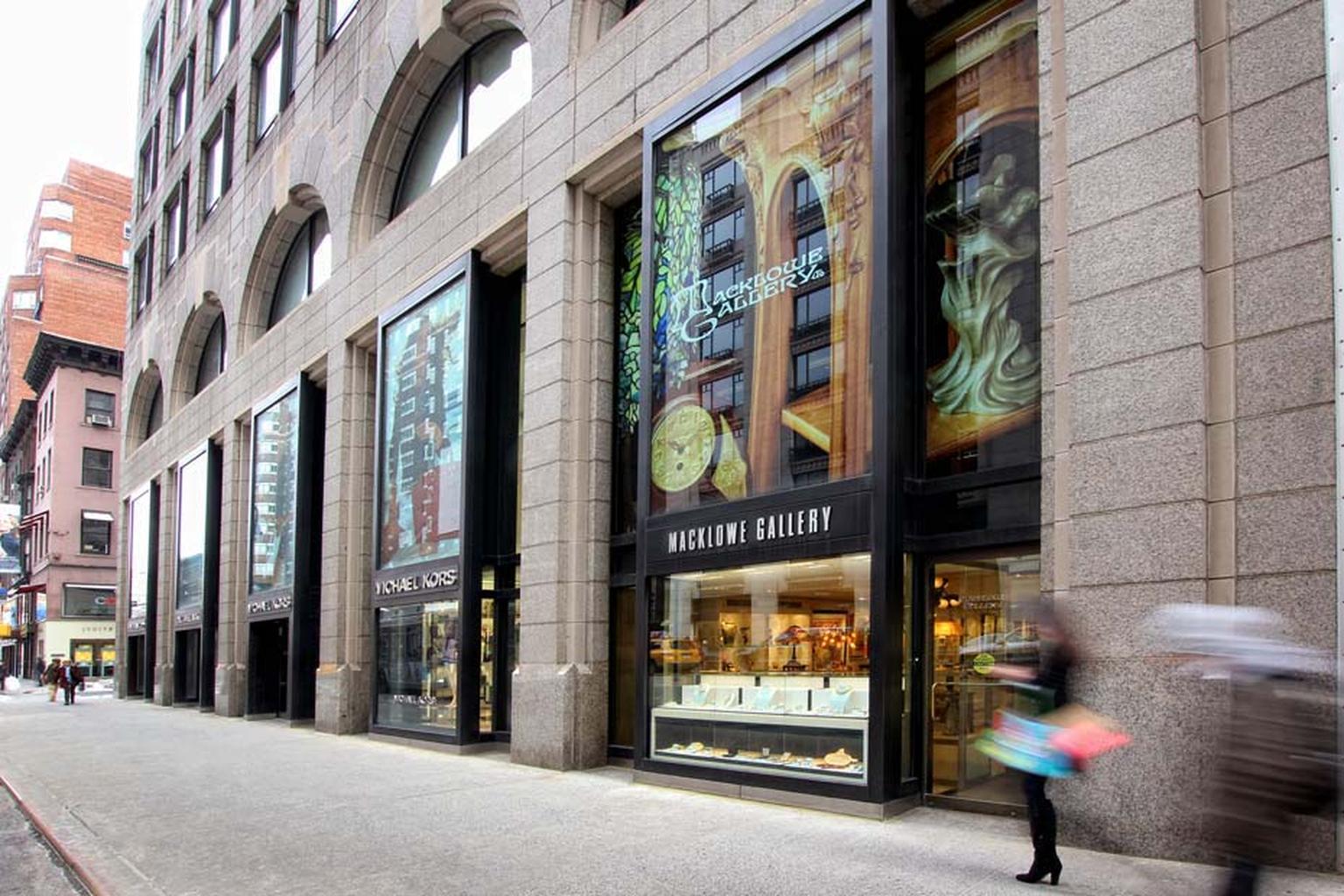
Fifth Avenue, New York City, USA:
A rare survivor of the global pandemic in George R Stewart's Earth Abides (1949) comes to deserted New York City.
In the tall windows of the fashion shops, the mannequins still postured strangely in gay costumes, their jewellery flashing. But Fifth Avenue lay before him empty, as quiet as Main Street of Podunk on a Sunday morning. The windows of one great jewellery store had been smashed. "I hope," thought Ish, "he found the diamongs good eating, poor guy. No, I hope he was somebody who liked pretty stones because they were pretty, like a child picking them up on the beach. Perhaps, with his diamonds and rubies, he really died happier."
Florin, Pennsylvania, USA:
In the invasion story Day of Succession by Theodore L Thomas (Astounding, August 1959), General Paul T Tredway, having dealt effectively with one alien lander at Terre Hill, disposes of the second in equally capable fashion:
...General Tredway had reasoned that when one object arrived, another might follow, and so he had ordered the trackers to look for it. It hit twenty-five miles west of the first one, near Florin. General Tredway and his men were on their way even before impact. They arrived twenty minutes after it hit...
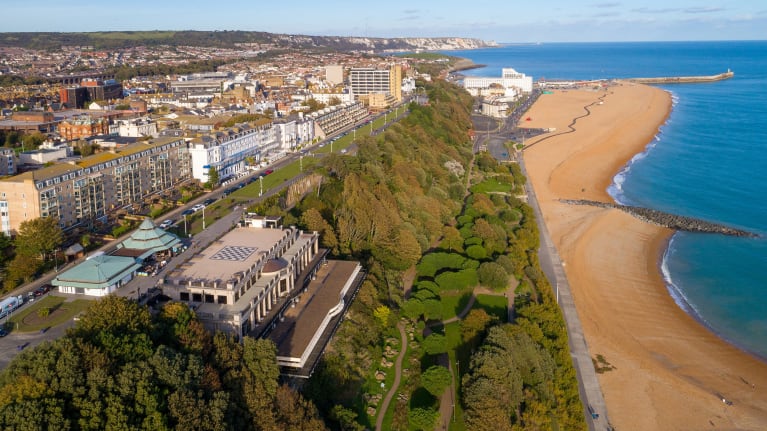 the Leas
the LeasFolkestone, Kent, England:
The cliff-top promenade known as the Leas is a scene made memorable by H G Wells in The New Accelerator (Strand Magazine, December 1901).
...I was proud to observe that I did not feel frightened - I suppose because there were two of us. "Why shouldn't we go out?" I asked.
"Why not?"
"They'll see us."
"Not they. Goodness, no! Why, we shall be going a thousand times faster than the quickest conjuring trick that was ever done..."
Assuredly of all the strange experiences that I have ever had, or imagined, or read of other people having or imagining, that little raid I made with Gibberne on the Folkestone Leas, under the influence of the New Accelerator, was the strangest and maddest of all. We went out by his gate into the road, and there we made a minute examination of the statuesque passing traffic...
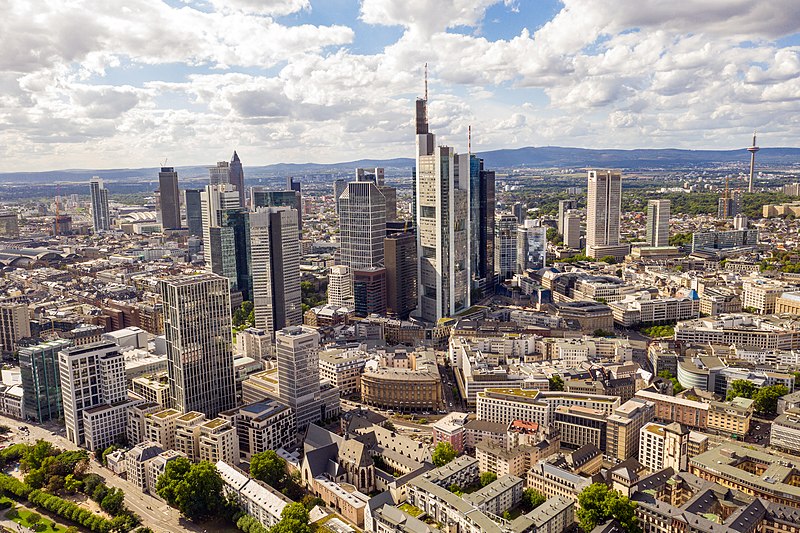
Frankfurt, Hesse, Germany:
This is the scene in chapter 13 of Philip K Dick's The World Jones Made (1956) of the attempted assassination by a Fedgov agent of the rabble-rouser Floyd Jones, who is on the way to becoming world dictator because of his precognitive ability.
...This part of Frankfurt still lay in rubble. A residential section, it was the last to be repaired. The inhabitants were living in temporary barracks erected by the Government. As Jones' speech came to an end, groups of organization workers collected here and there, obviously in pre-arranged patterns. Pratt, standing with his rifle, watched with interest.
Before him lay what looked like a cement wheel. The wheel was a solid mass of followers, assembled in a single grim heap. The crossed-retort flag fluttered on all sides. Everybody had armbands or uniforms. Ahead of the wheel of gray lay an open stretch of Landstrasse, the still undamaged highway leading into the town...
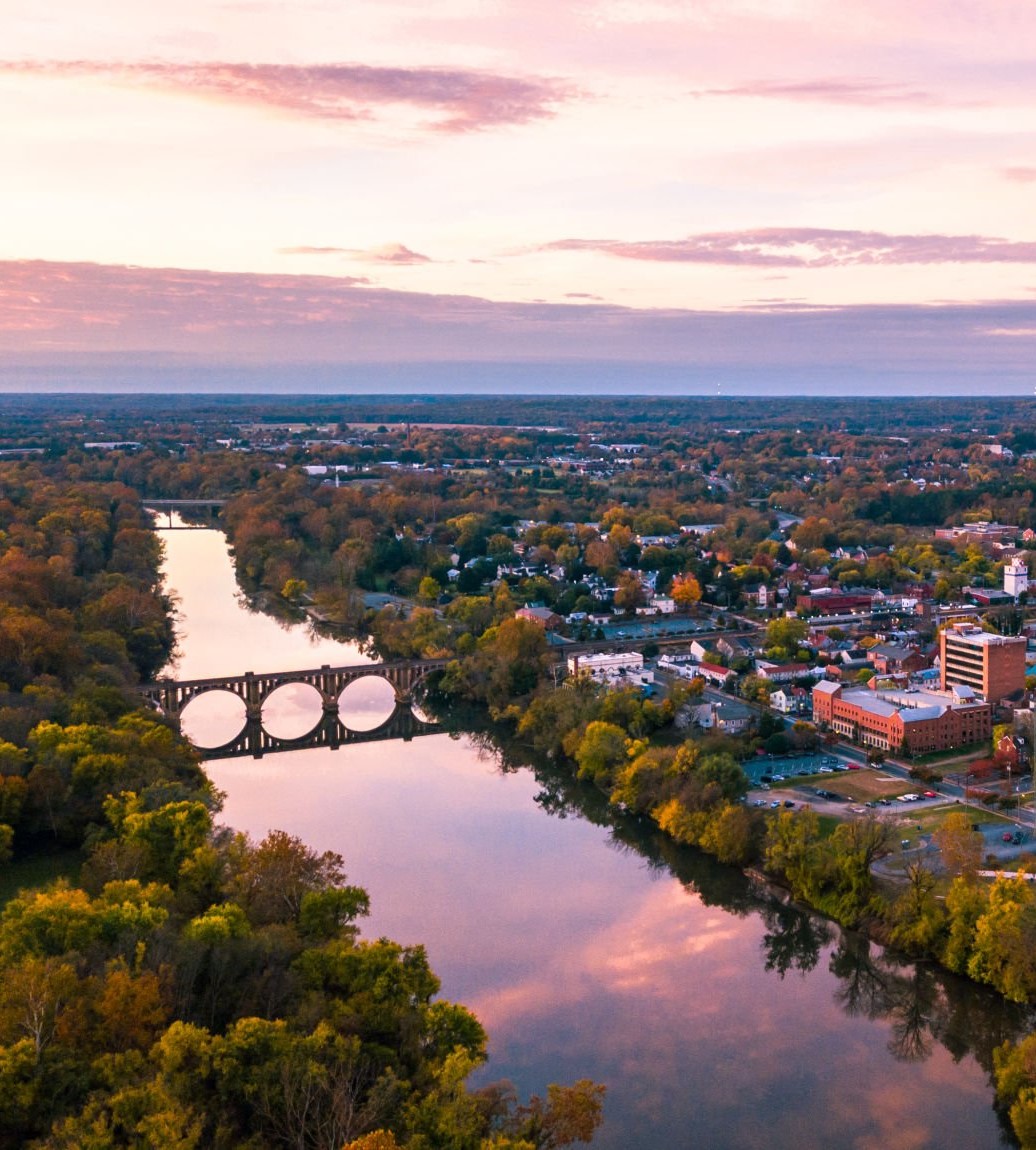
Fredericksburg, Virginia, USA:
One of the locations affected by the shifting of time-paths in Murray Leinster's novella Sidewise in Time (Astounding Stories, June 1934):
...At half past eight a.m. on June 5, 1935, the inhabitants of Fredericksburg had felt a curious, unanimous dizziness. It passed. The sun shone brightly. There seemed to be no noticeable change in any of the facts of everyday existence. But within an hour the sleepy little town was buzzing with excitement. The road to Washington - Route One on all road maps - ceased abruptly some three miles north. A colossal, a gigantic forest had appeared magically to block the way...
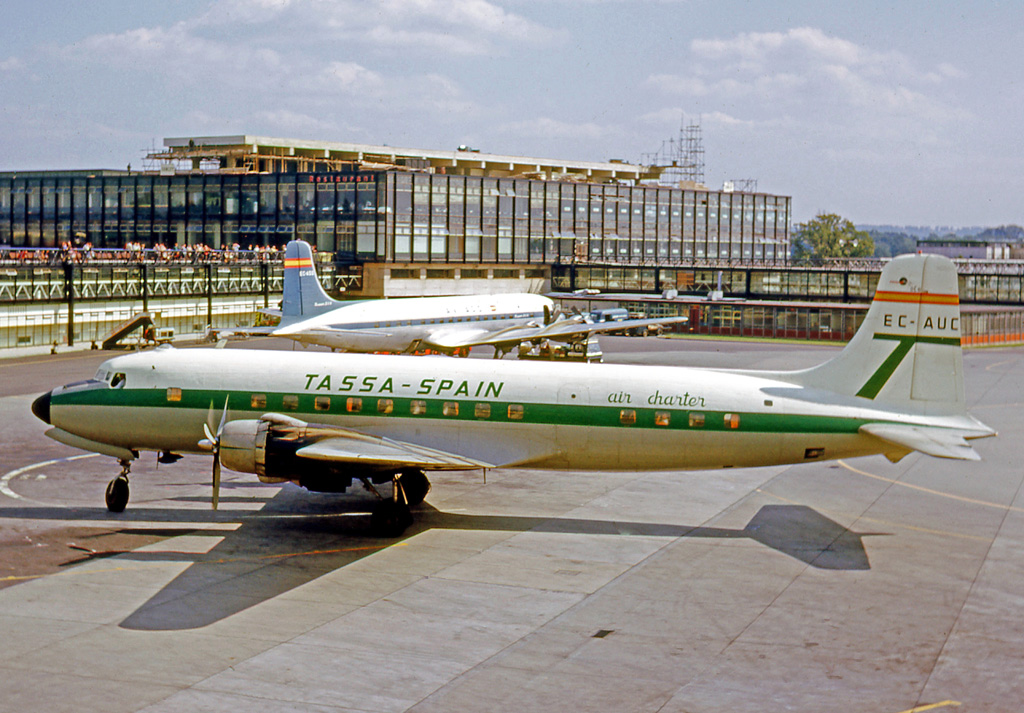
Gatwick Airport, Sussex, England:
In the climax of the third volume of Dan Morgan's "Minds" tetralogy, The Mind Trap, one telepath (the evil Henrietta) seeks to deceive and kidnap another (thrilled young Katie) to take her out of the country. Katie narrates:
...First thing we went to the airline counter, where Henrietta got the tickets and they weighed her luggage. I hadn't got any, of course, but she said that would be all right, and we'd be able to get some new clothes for me in Italy. Me - Italian clothes! I was beginning to feel like some kind of movie star.
Afterwards we went upstairs and walked along the balcony until we came to this great big lounge place, filling with people sitting at tables eating and drinking, and all one side of the room was like one big window looking out over the airport. Henrietta parked me at a table by this window and went over to the counter where they were serving drinks and stuff. I just sat there, letting it all wash over me, pinching myself every few seconds to make sure I wasn't dreaming, and looking out at the planes sitting there on the tarmac, with baggage trolleys and fuel trucks scurrying here and there between them...
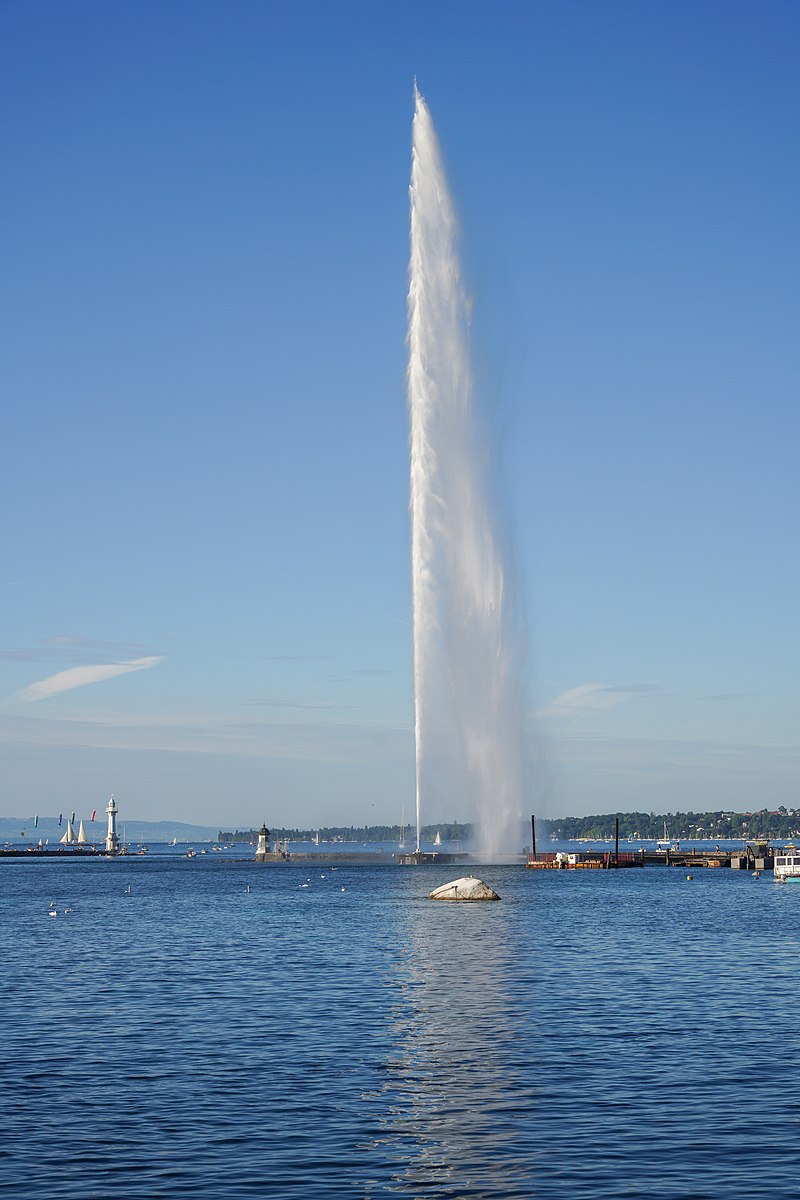
Geneva, Switzerland:
The column of the Jet d'Eau still rose like a pearl-grey, feathery giant over the lake; the mountains stood sentinel in their uncompromising purity and the Old Town was still preserved on the hillside like a museum piece - but otherwise Geneva had become a vast city of sky-scrapers set in extravagant flower gardens. Yet the city of Calvin was more than ever the centre of European political life and, since the Hyannis Agreement which divided the sessions of the United Nations between New York and Switzerland, the centre of world politics for at least six months in a year. More than a century and a half had passed since the first Red Cross Convention had been signed, attempting to regulate the conduct of war. Much had changed in these years; above all, the Convention had been repeatedly modified. The more recent wars left few survivors; there were not many prisoners and even fewer wounded... The so-called U.N. Balls - a series of dazzling social events - attracted the top thousand of the world every February. Three times a year the Bernadette, Hammerskjold and Roosevelt Memorial Banquets brought the leading politicians, financiers and intellectuals of a hundred countries into the vast armoury of the Tower of Nations; and Amazonian, Texan or Arab millionaires paid fabulous bribes for invitations. Half of Geneva consisted of hotels and apartment houses for the U.N. personnel...
Paul Tabori, The Survivors (1964)
By contrast in City (1952) by Clifford D Simak, Geneva is cut off from the rest of the world by means of a force-field, this isolation being the deliberate act of one man, Jon Webster, who wants to leave the rest of the world free for the successor species, the intelligent Dogs.
When he reached the street, he saw that the sky had changed. A grey, metallic overcast had blotted out the sun and the city lay in twilight, only half relieved by the automatic street lights. A faint breeze wafted at his cheek...
Georgia, USA:
Mal Irish looks towards this state from his wanderings in Florida during the geological upheavals of Catastrophe Planet (1966) by Keith Laumer:
...Off to the north you could see a dull glow in the sky - a reflection from the red-hot lava that was building a new mountain range across Georgia...
(Earlier in the story there is an incident in what's left of the Georgia town of "Greenleaf" - but this seems to be a fictional place; at any rate I haven't found any evidence for it online.)
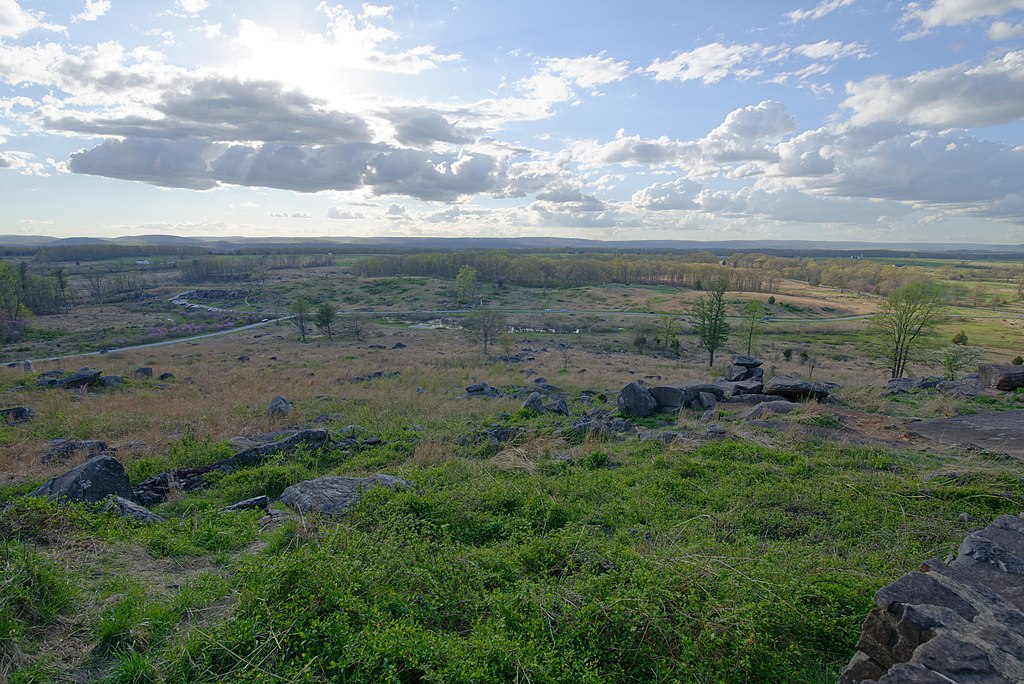
Gettysburg, Pennsylvania, USA:
In the alternate-history classic Bring the Jubilee (1953) by Ward Moore, the historian Hodge Backmaker, US citizen in the timeline in which the South won the War between the States, travels back in time to the battlefield of Gettysburg to check on some facts, and (spoiler) by his mere presence, without taking any action, involuntarily alters the outcome of the battle, turning it from a Confederate into a Union victory.
The battle also features in the haunting first chapter of Simak's Way Station (1963), which begins:
The noise was ended now. The smoke drifted like thin, grey wisps of fog above the tortured earth and the shattered fences and the peach trees that had been whittled into toothpicks by the cannon fire. For a moment silence, if not peace, fell upon those few square miles of ground where just a while before men had screamed and torn at one another in the frenzy of old hate and had contended in an ancient striving and then had fallen apart, exhausted...
Gibraltar:
I sailed north during the night... reached Gibraltar at dawn. The famous rock was gone, and a new channel that I estimated at twenty miles wide stretched ahead into the open water of the Mediterranean. A fifteen-knot current poured out through the strait...
Keith Laumer, Catastrophe Planet (1966)
Gijón, Spain:
This town on the Bay of Biscay is the scene of an alien attack from the Deeps in John Wyndham's The Kraken Wakes (1953):
...It was somewhere about ten-thirty in the evening when the sea-tanks came sliding up from the quietly lapping waters at Gijon, with not a sound to betray them until their metal bellies started to crunch up the stone ramps. The few small boats that were already drawn up there they pushed aside or crushed as they came. It was the cracking of the timbers that brought men out from the waterside posadas to investigate.
They could make out little in the fog. The first sea-tanks must have sent coelenterate bubbles wobbling into the air before the men realized what was happening, for presently all was cries, screams, and confusion...
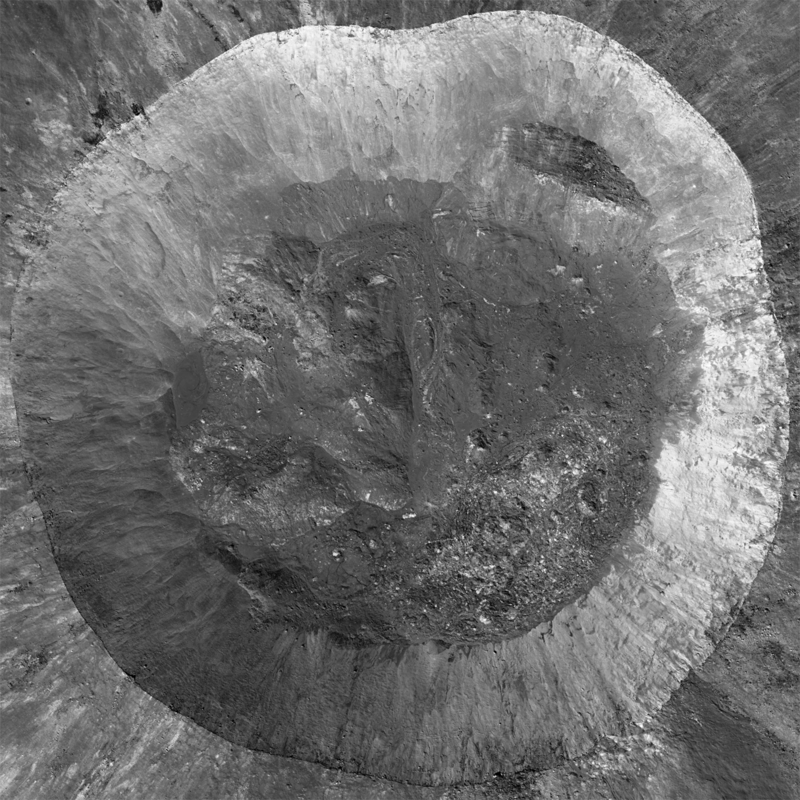
Giordano Bruno:
This lunar crater is on Farside - but only just; from Earth it's visible edge-on under favourable conditions of libration. Some have linked it to a reported sighting by chronicler Gervase of Canterbury in 1178, with the suggestion that he may have witnessed the impact that formed the crater, though the consensus seems to be that this is unlikely. The crater is mentioned as a Farside base in James P Hogan's Inherit the Stars (1977), p.60-1:
...Hunt visited the huge radio and optical observatories of Giordano Bruno on Farside. Here, sensitive receivers, operating fully shielded from the perpetual interference from Earth, and gigantic telescopes, freed from any atmosphere and not having to contend with distortions induced by their own weights, were pushing the frontiers of the known Universe way out beyond the limits of their Earth-bound predecessors...
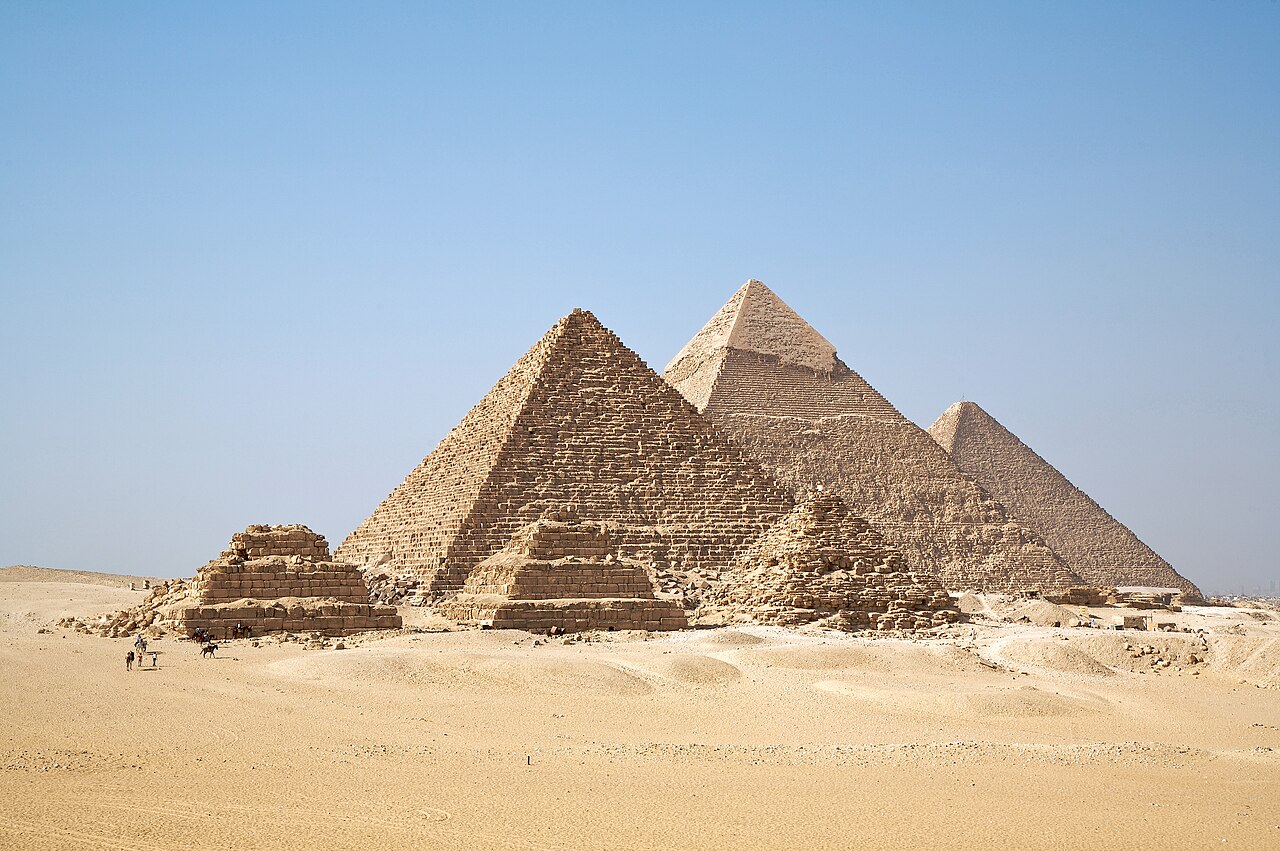
Giza, Egypt:
In the climax of Herbie Brennan's Saros (Fantasy and Science Fiction, September 1976) the Pyramid of Cheops turns out to be the focus of a form of energy which makes possible a dramatic new discovery by a team of archeologists using android help.
...It was a still, cool Egyptian night, full of the scents of history. They stopped to stare up at the world's most famous mystery.
"Nearly two and a half million blocks of stone," Mountcharles remarked. "And not one under two tons' weight."
"That was Petrie's estimage, wasn't it?" Lady Alice asked.
He nodded. The pyramid cut a deep black triangle against a darkening night sky.
"I've always felt it might be on the low side," Lady Alice said. "I wonder how they built it."
Mountcharles glanced at her, surprised. "But we know how they built it, my dear. The Euwe Papyrus solved that little mystery once and for all."
"You have a touching faith in ancient documents..."
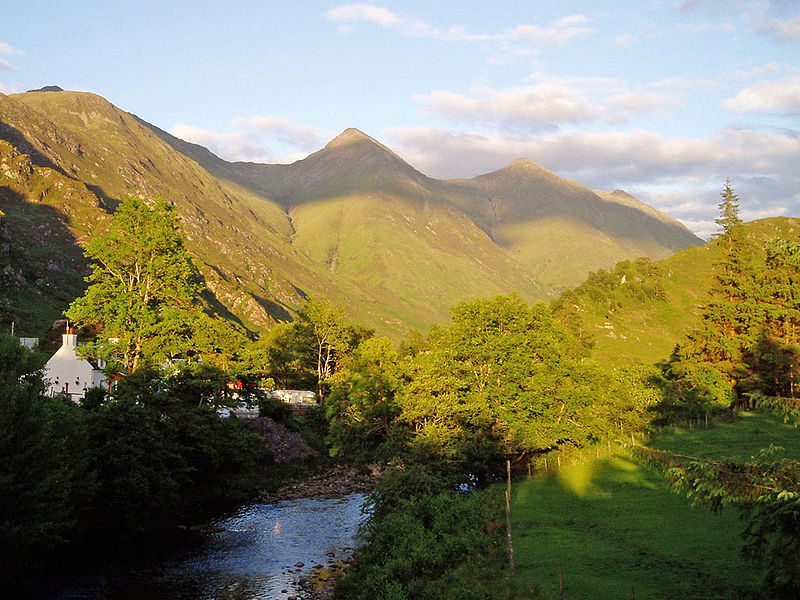
Glen Shiel, Ross-shire, Scotland:
In Fred and Geoffrey Hoyle's disaster novel Inferno (1973), in which weather extremes make Earth uninhabitable after an explosion in the galactic core, some relief eventually returns to the survivors in northern latitudes, including Scotland.
...A vague light spread gradually across the eastern sky, the light of a late November morning...
...The light had not long come to Glen Shiel when Cameron stepped outside into the bitter air. He walked to the lochside, his boots squeaking in very dry snow. The sight which met his eyes as he gazed up the glen was appalling beyond all expectations. So it must have been during the ice-age. The Five Sisters range was plastered, bottom to top, with ice and snow. So was Beinn Fhada and the mountains north of Morvich. The loch itself was thick frozen. It was a white world of intense desolation. It was the white of a shroud. Cameron found himself scarcely able to believe that the land it covered could ever come to life again.
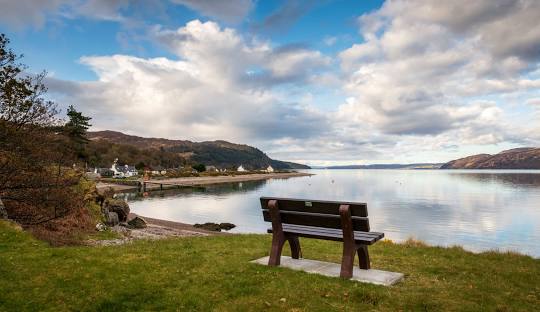
Glenelg, Ross-shire, Scotland:
The astronomer-protagonist of Inferno (1973) by Fred and Geoffrey Hoyle remains close to his roots:
...Cameron himself had spent his youth in the north, but had been educated later, both at school and university, in England. He had no accent in speech, but he retained the fluency in Gaelic which he had acquired in his earliest years through playing with lads from the crofts south of Glenelg. He had spent both school holidays and university holidays in the far north-west, maintaining the ancient language with a fervent determination, since it was only through the language that he could link himself with the past tradition of the Highland people...
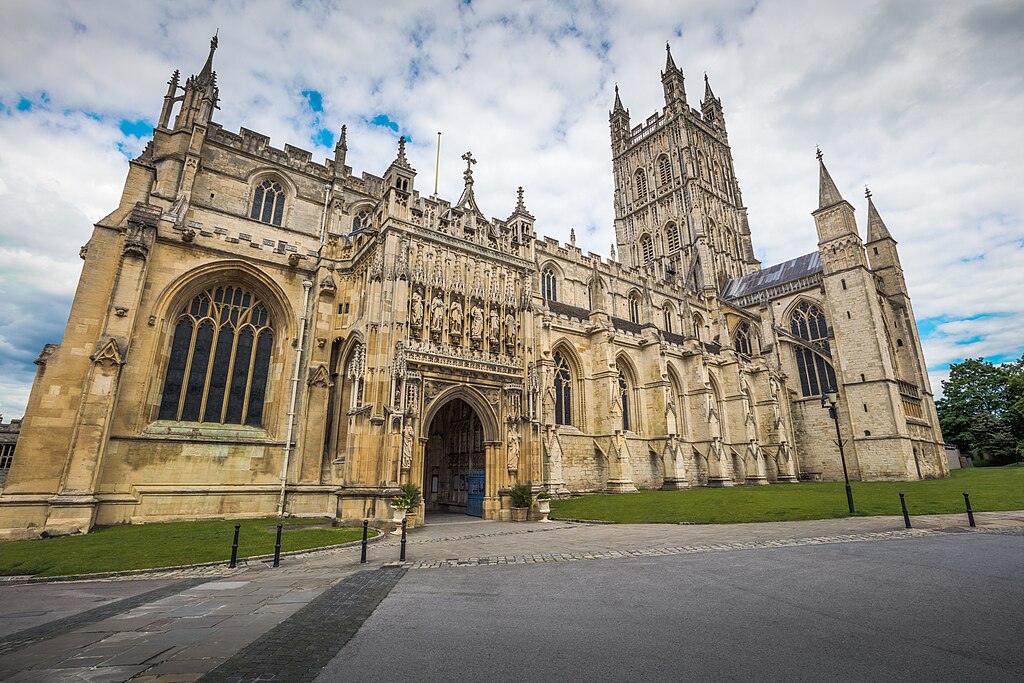
Gloucester, Gloucestershire, England:
In a macabre scene from
part three of Susan Cooper's Mandrake (1964), a meeting in a fall-out shelter below the Cathedral, in which the malevolent planetary Intelligence, speaking through a tranced medium, appears to deride its supporters, is followed by the collapse of the Cathedral itself:
...the ground shivered under their feet, and the long subterranean roar burst out after the dust, and it seemed impossible that the drifting mist should not be scattered by the noise. But still it hung in the air while they saw, terribly, the long dark stretch of grass above the shelter gently slip and slump and fall to leave a great gaping pit. It was not possible, and they watched without belief.
But Oakley was looking farther; straining to see into the darkness beyond. Suddenly he swung around and grabbed at them to pull them away.
"Get out, quick! Along the wall, in the open. The cathedral's going!"
They ran desperately through streets, round corners... The roar behind them had grown, following, and as they paused... they saw incredulously the towering bulk of the cathedral sway and lurch against the dim dark sky.
The thundering grew to a high screaming note as if the earth itself had split...
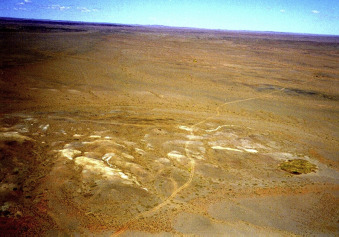
the Gobi Desert:
From Paul Tabori's The Doomsday Brain (1967):
The city which Bruno Gatterer alias Master Brug built under the rocks of the Gobi Desert had a population of seven hundred. But its extent and its production capacity were that of a large metropolis. The answer to this seeming paradox was automation. The seven hundred did little but tend the machines each of which did the work of a thousand or more...
And now he was ready. Ready to crown his life's work, to prove that he was Master Brug, the man whom the machines had made into a god and whose godhead was embodied in machines that were like men and men that had become machines...
From Frederick Pohl's The Merchants' War (1984) which is set in a "sales-fearing" commercial dystopia run by advertising agencies, and in which the "hero", Tenn Tarb, is recruited to extend their sway:
We wound up in the Gobi Desert...
The place is technically known as the Xinjiang Uygur Autonomous Region, but everybody called it the Reservation. It was where one of the last remaining batches of unconsolidated aboriginals lived, Uygurs and Hui and Kazak, the ones that never made the transition to the market society when the rest of China joined it. There's civilization all around them. There's RussCorp to the North, Indiastries South and all the China-Han complex at their gates. But the Eager Weegers just sit there and do their own thing...
Goose Island, Iowa, USA:
I haven't been able to find a picture of it but according to my online search it does really exist, not just in Clifford Simak's The Visitors (1979, 1980):
"Visitors? Visitors? Oh, yes, now I know. I've heard the name. You mean those big black boxes folks say came out of the sky."
"That's what I mean," said Jerry. "You sound as if you saw one."
"Over on Goose Island," said Quinn. "That's the big island, plumb in the centre of the river valley, four or five miles downstream from here... Just saw the tops of them, sticking out above the trees. It was getting on towards evening and I didn't linger none..."
Great Blasket Island, County Kerry, Ireland:
A device which can translate scenes from the unconscious into moving pictures on a screen, in Josephine Saxton's The Consciousness Machine (Fantasy and Science Fiction, June 1968), is situated on the island:
...They were out in mid-channel, and behind them Great Blasket looked just too much like a sea monster for anyone to comment on the fact; almost a thousand feet at its highest point, about four miles in length and a half mile wide, decorated with strands of silver sand, high, organic-looking cliffs, purple teeth of rocks and the ruins of an ancient village...
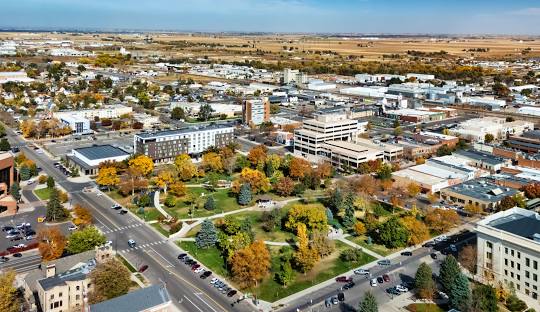
Greeley, Colorado, USA:
In 1977, during a world war, this town was the birthplace of the world-dictator whose career is described in Philip K Dick's The World Jones Made (1956).
...The war had not by-passed Greeley, Colorado; it had never come there. No war could reach into every town, to every living human being. The farm which his family maintained continued almost as usual; a self-sufficient economic unit, it carried on with its stagnant routine, ignorant of and indifferent to the crisis of mankind...
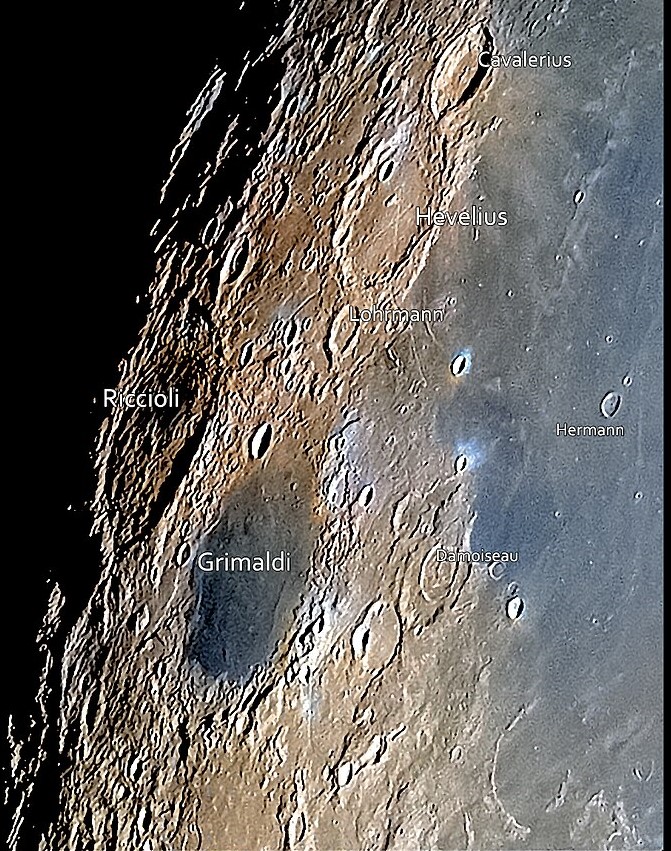
Grimaldi:
One of the chaotic effects of a time-rippling experiment is that a geranium is randomly transported to the Moon, in Damon Knight's 1965 novel The Other Foot:
...A cloud of vapour surrounded it almost instantly; the flower drooped, wilted, lost colour and finally turned as grey as the ash around it. Thirty years later a man in a mooncat, on his way from Little Washington to Grimaldi, noticed the grey skeleton and took it for an unusual mineral formation. He took the co-ordinates and make a mental note to mention it to a selenologist in Grimaldi Base, but he forgot...
(See the Fictional Dates timeline for the year 2002.)
The "Grimaldi Plateau" is mentioned in An ocean shore on the ancient inhabited Moon.
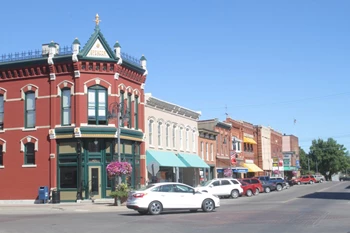
Grinnell, Iowa, USA:
Area of the first landing site of the parasitic invasion of 2007, in Heinlein's The Puppet Masters (1951).
'Seventeen hours' - the Old Man glanced at his finger watch and added - 'and twenty-three minutes ago an unidentified space ship landed near Grinnell, Iowa. Type, unknown. Approximately disk shaped and about hone hundred and fifty feet across. Origin, unknown, but - '
'Didn't they track a trajectory on it?' I interrupted.
'They did not,' he answered. 'Here is a photo of it taken after landing by Space Station Beta.'
I looked it over and passed it to Mary. It was as unsatisfactory as a telephoto taken from five thousand miles out usually is. Trees looking like moss... a cloud shadow that loused up the best part of the pic... and a grey circle that might have been a disk-shaped ship and could just as well have been an oil tank or a water reservoir...
Mary handed the pic back. I said, 'Looks like a tent for a camp meeting. What else do we know?'
'Nothing.'
'Nothing? After seventeen hours! We ought to have agents pouring out of their ears!'
'We did have. Two within reach and four that were sent in. They failed to report back...'
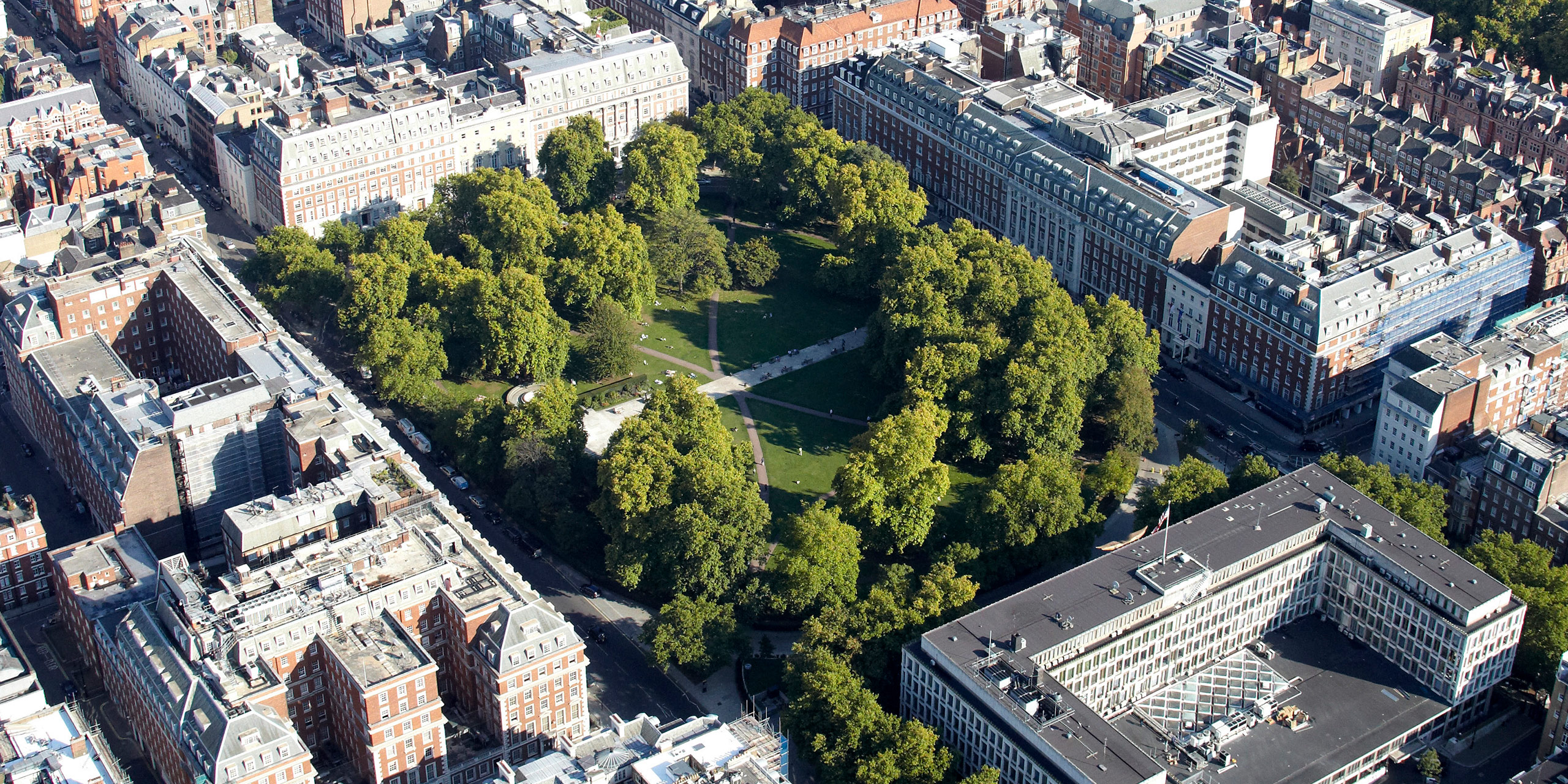
Grosvenor Square, London, England:
In the second volume of Dan Morgan's tetralogy about a community of telepaths, working-class journalist Jerry Coleman has an appointment with his formidably posh mother-in-law:
The Chalfont Hotel was located in a backwater off Grosvenor Square, a bastion of privilege in this age of the common man. As such it was quite obviously home ground for Alison Humphreys. Jerry Coleman wished he had insisted that they meet somewhere on his choosing, but the invitation had come as a surprise; apart from that, with Alison Humphreys he was infufficiently sure of himself to insist on anything.
As the double glass doors of the lounge swung shut behind him with a contemptuous hiss he squared his shoulders beneath the rumpled brown corduroy jacket and tried to rid himself of the feeling that he was an illegal immigrant travelling on a false passport...
The Several Minds (1969)
Gruithuisen's Lunar City, Mare Insularum:
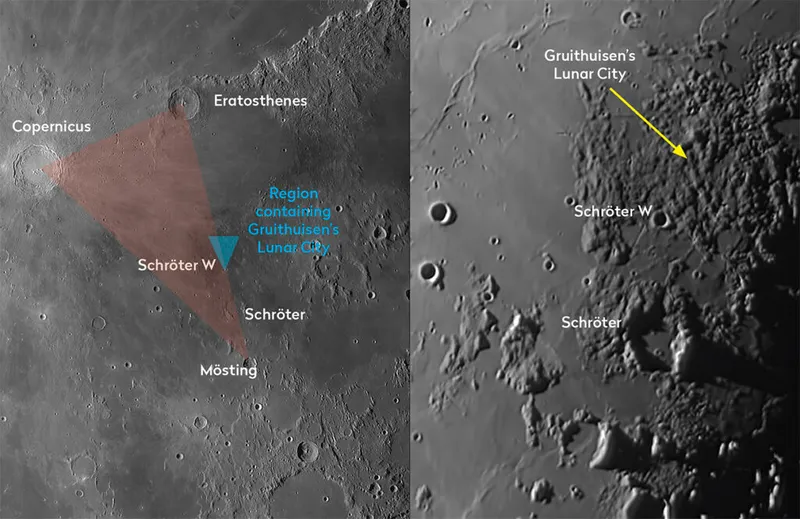 with acknowledgement to the BBC Sky At Night magazine
with acknowledgement to the BBC Sky At Night magazineIn the 1820s the Bavarian astronomer Franz von Paula Gruithuisen (1774-1852) reported having observed a city on the Moon in the region of Schröter. See this article.
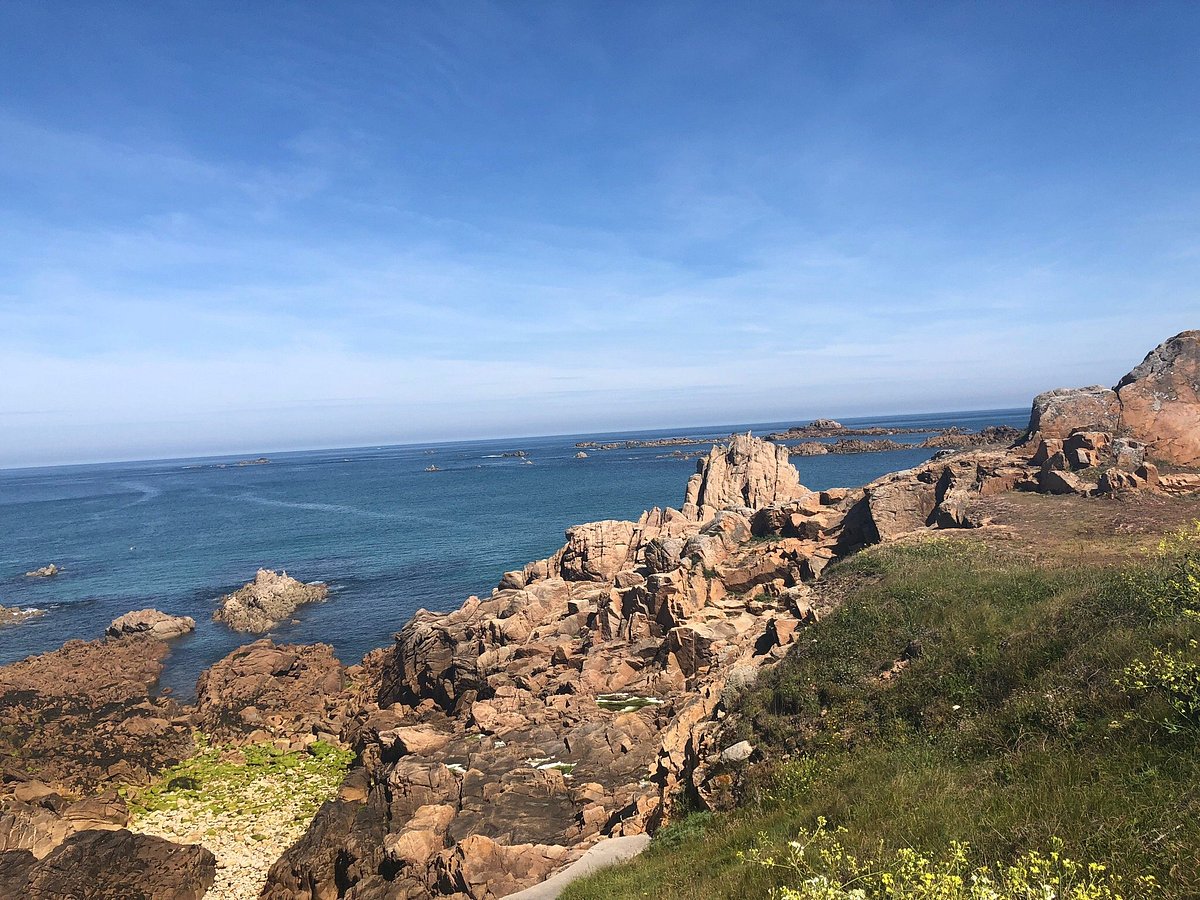 Vazon Bay
Vazon BayGuernsey, Channel Islands:
From Hugh Walters' The Blue Aura (1979), in which there is an extraterrestrial visitation in the caverns dug by the occupying Germans in World War Two:
...The setting sun glinted on the sea and threw shadows of the tumbled heaps of rock across the sands. They followed the coastal road north, skirting Rocquaine Bay and noticing Lihou Island just off the coast. Then they turned north-east past stretches of glorious sand round Vazon Bay.
It was a beautiful island, marred only by the occasional fort or gun emplacement - relics of the German Occupation during the Second World War. Most of them had been left as a constant reminder of those dark days, and had now become a tourist attraction...
Matthew Cotter, survivor of the catastrophic global quake in John Christopher's A Wrinkle in the Skin (1965), is a resident of Guernsey who is shocked to discover that it is a island no more:
He stared in disbelief as he came down the last stretched of hill, steeper now, and looked out to where the sea should have been. It was like a glimpse of another planet, a strange savage and barren world. He could see the tangled green of the great weed beds, the rawness of exposed rock and sand. Here and there the glint of water; light thrown back from pools trapped in hollows. But the blue sweep of wave was gone. A sunken land was drying in the early summer sun.
Another catastrophe-tale by John Christopher, The World In Winter (1962), has the Nigerian Expedition to the frozen British Isles begin with an investigation of Guernsey:
...They put out a hundred yards or so to sea and traversed the northern tip of the island. There were places where it would have been possible to take the craft on shore and cut across country, but Andrew ignored them. It was important, he felt, to give as little indication of the vessel's power as need be. With the same motive, he refrained from opening up the engines. They cruised at under ten knots, and as a result it was almost an hour before they came to the harbour of St. Peter Port. The sun was almost down and mist, which already shrouded the smaller islands to the east, was coming up from the sea and rising among the terraced houses of the town.
The important thing was that there was a living town here. They could see movements in the streets - there was even smoke rising from a chimney somewhere - and faces looked down as the Hovercraft eased in to the inner harbour...
Hades:
(No picture found yet.)
In chapter 11 of Arthur C Clarke's 1951 novel The Sands of Mars, a storm on the Red Planet has caused a plane-crash somewhere between the Port Lowell and Port Schiaparelli colonies. The pilot is asked whether the observatory on Phobos could have warned them:
"Phobos hasn't risen yet," he said after a brief calculation. "I guess the storm blew up suddenly out of Hades - appropriate name, isn't it? - and has probably collapsed again now..."
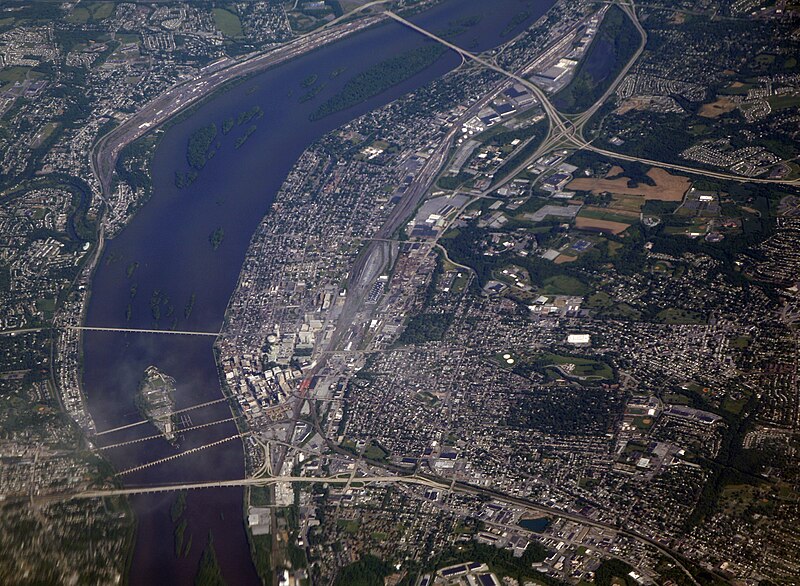
Harrisburg, Pennsylvania, USA:
A third alien spacecraft lands here, shortly after the landings at Terre Hill and Florin which were dealt with summarily by the ruthless General Tredway in Day of Succession by Theodore L Thomas (Astounding, August 1959). This time, Tredway isn't on the spot - he has been summoned to the White House to account for his actions. His replacement, General Barnes, has been ordered to give the aliens a chance. At the White House the President and other top people, including the disgraced Tredway, watch events on the TV screen.
...The familiar black at the bottom of the hatch came into view, followed closely by the top of the gleaming rose blossom. General Tredway snapped his fingers, the sound cracking loud in the still room. The men close to the set jumped and looked back at Tredway in annoyance. It was plain that the general had announced in his own way the proper moment to fire. Their eyes had hardly got back to the screen when it happened...
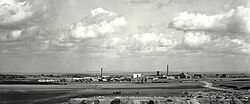 the Atomic Energy Research Establishment in 1957
the Atomic Energy Research Establishment in 1957Harwell, Berkshire [but nowadays erroneously placed in Oxfordshire], England:
The Helios Project Centre is sited here in Fred and Geoffrey Hoyle's Fifth Planet (1963), which is set in the late twenty-first century and narrates the beginnings, the course and the aftermath of mighty efforts by East and West to send astronauts to explore the planet Achilles, part of the Helios star-system which is due to pass briefly through our solar system.
...There were two ways of going between the Conways' house in the sleepy village of Alderbourne and the Helios Project Centre at Harwell, the site of which had been a nuclear research establishment in the dim distant days. There was the super-S highway, or the winding, tree-shaded lane that had not changed much since the eighteenth century...
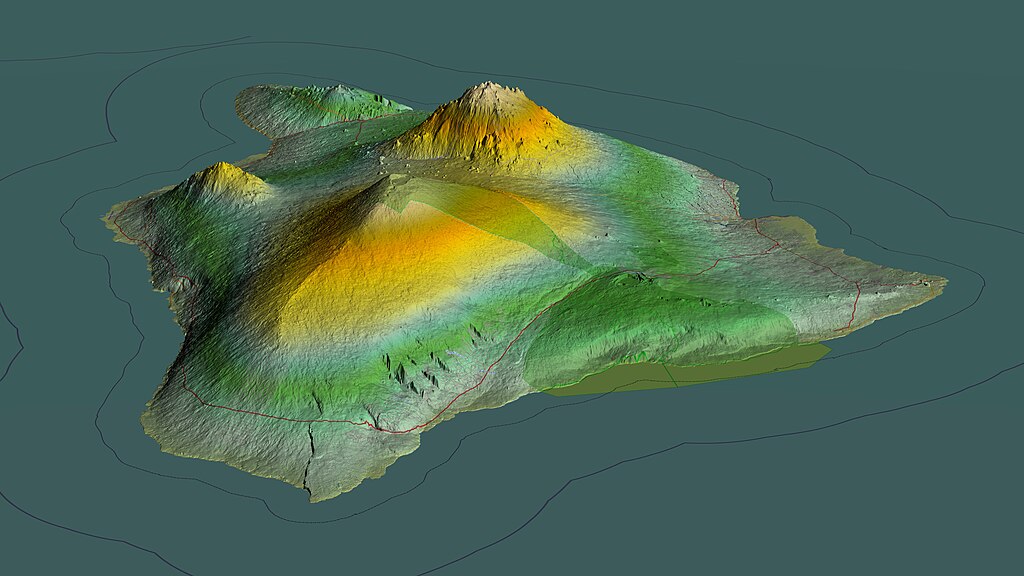
Hawaii Island, Hawaii, USA:
The composer-narrator of Fred Hoyle's October the First is Too Late (1966) is tagging along with a physicist friend during a scientific conference concerning mysterious signals from space.
...The trip from Honolulu to the big island of Hawaii was, I suppose, about one hundred and fifty miles. I was met at Waimea by a car. The country hereabouts was surprisingly flat, considering the fourteen-thousand-foot high Mauna Kea was only some fifteen miles to the south. The journey to the field-station was a short one...
...The following day I went for a drive round the island. I went to Volcano House and took a look at the active Kilauea crater. I saw sugar plantations, pineapple fields, rain forests, the sea and the mountains. When I got back to the experimental station I found the place in a wild panic...
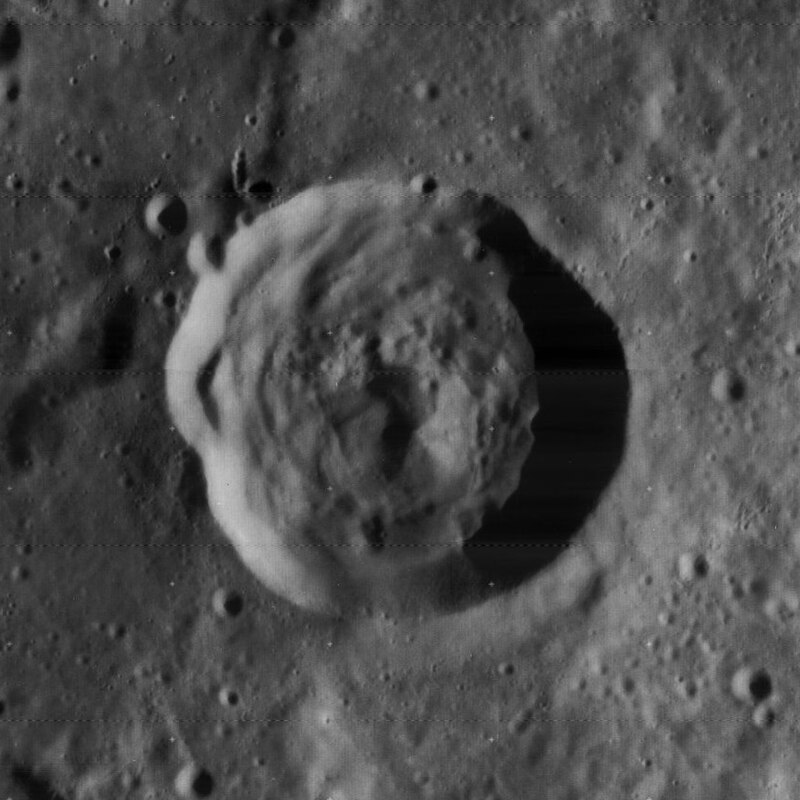
Hell (crater):
Ray Carmody and his Russian bride are to be sent to this part of the Moon - partly because the crater is fairly new and "you won't have to slog through knee-deep pumice when your're gathering the supply rockets" - in Frederick Brown's tale of benevolent but ruthless computer interefence in politics, Honeymoon in Hell (Galaxy, November 1950):
"Hell Crater?" Carmody asked. "There isn't any."
"Our Moon maps have forty-two thousand named craters. Do you know them all? This one, incidentally, was named after a Father Maximilian Hell, S.J., who was once director of the Vienna Observatory in old Austria."
Carmody grinned. "Now you're spoiling it..."
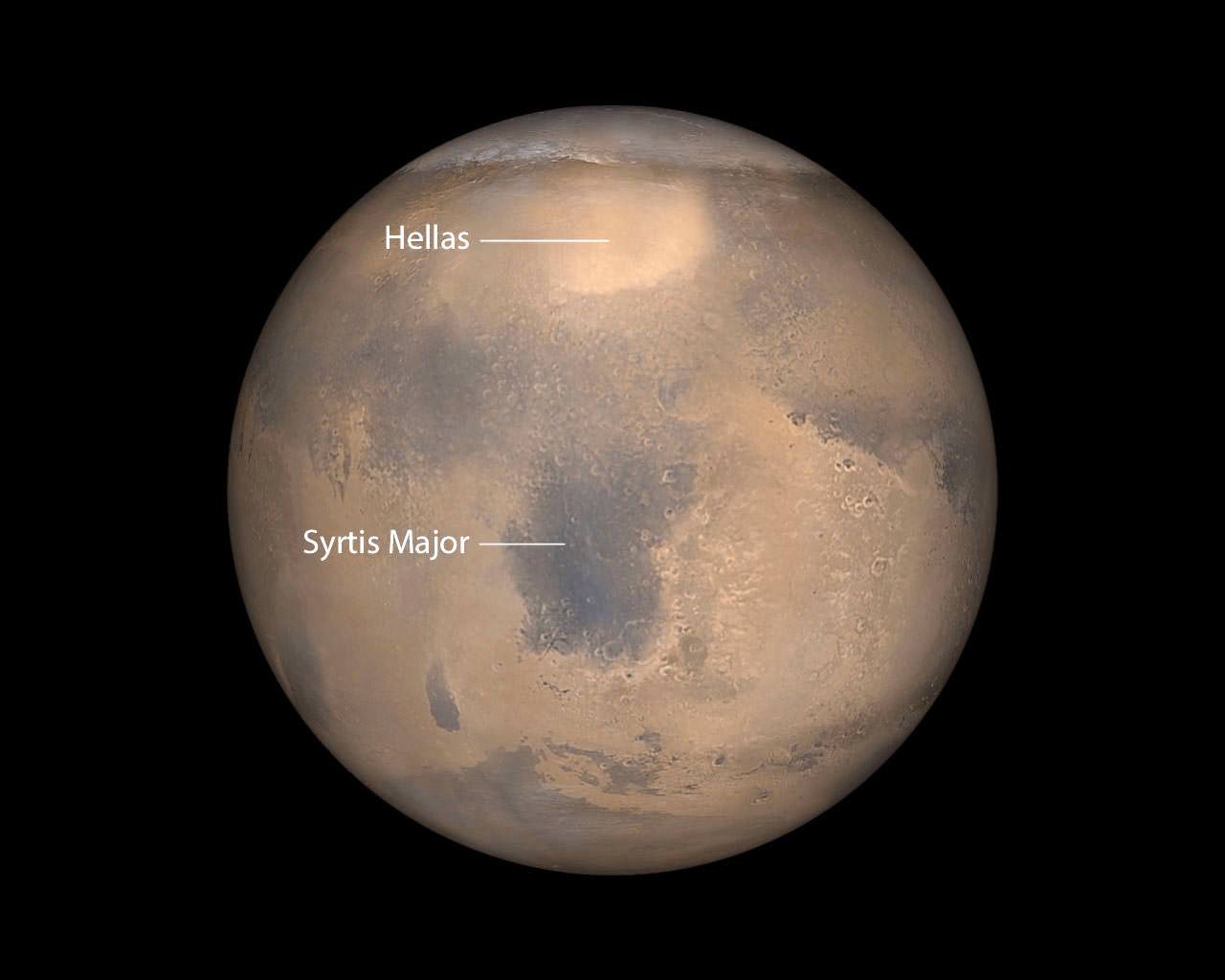
Hellas:
The likeable rogue Augie Larsen brings a gift from Mars back to his relatives in Minnesota, in Raymond Z Gallun's Prodigal's Aura (Astounding Science Fiction, April 1951).
...It was sweet, but there was a very special tang to it. A tang from Mars - from the far, intriguing distance.
Yet there was another, stronger sensation in David Jorgensen's nerves. Thrilling. Alive. Something which gave him what Augie Larsen had. Something which restored a spark in himself, and took away the restlessness.
"Go ahead, Mattie - taste it," he urged. "It's good! Those are Hellas Apples. On Mars the colonists eat 'em all the time. They could become popular, here."
The Hammer of God by Arthur C Clarke (1993) is of too late a period to count as an OSS novel (Clarke the realist wasn't one for retro sf), but it contains an interesting echo of his splendid novel of 1951, The Sands of Mars, in which the Red Planet is being gradually given a breathable atmosphere. The 1993 novel alludes to a similar project though carried out by different means. Set in 2109-2110, it depicts (in chapter 12, echoingly given the title of the 1951 novel), a promising development in the Hellas Lowlands:
...Hellas was currently popular among adventurous youngsters, who liked to show off by seeing how long they could survive without breathing gear. Atmospheric pressure was now just sufficient for such feats, though the oxygen content was still too low to sustain life. The misleadingly named "open air" record now stood at just over ten minutes...
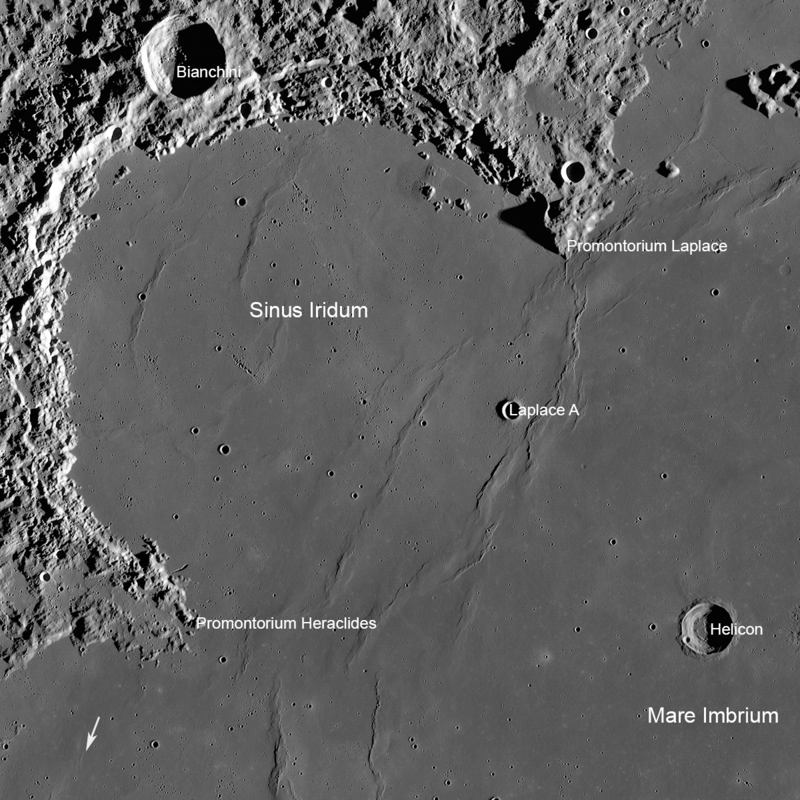
Heraclides Promontory:
Despite being non-OSS, Arthur C Clarke's 1993 novel The Hammer of God contains some scenes on the Moon which would have fitted nicely into his 1950s writing; such as those set in the Sinus Iridum. He describes this "Bay of Rainbows" as
...the surviving half of a typical crater plain, whose entire northern wall [surely he meant southern wall?] was washed away three billion years ago by a flood of lava sweeping down from the Sea of Rains. The remaining semi-circle which the lava could not breach is terminated at its western end by the kilometre-high Promontory Heraclides, a group of hills which at certain times creates a brief and beautiful illusion. When the Moon is ten days old, waxing towards full, Promontory Heraclides greets the dawn, and even in the smallest of Earth-based telescopes it appears for a few hours like the profile of a young woman, hair streaming towards the west. Then, as the sun rises higher, the pattern of shadows changes, and the Moon Maiden disappears.
But there was no sun now, as the contestants for the first lunar marathon gathered at the foothills of the promontory...
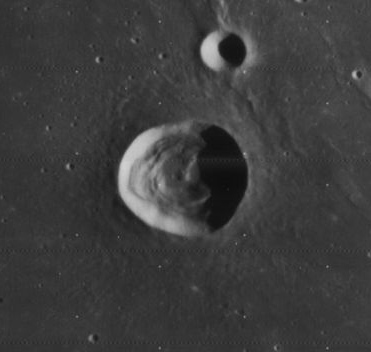
Hermann:
A terrestrial flower is transported to this region as a result of the time-ripple effect of the Klementi experiment, in Damon Knight's The Other Foot (1965). (See the Fictional Dates page entries for 1950 and 2002.)
For what happens next, see Grimaldi. Meanwhile:
...The turbulence spread onward. The trouble Klementi had started was not over yet...
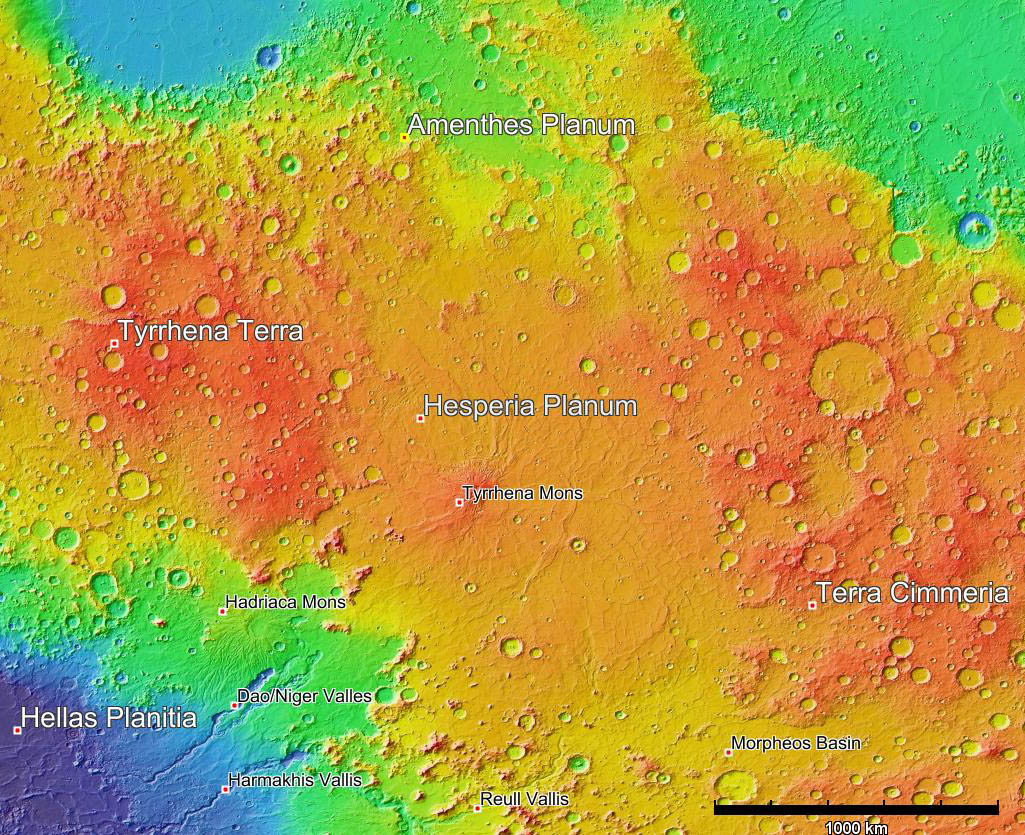 I like the false colours in these topographic maps; one can weave them into the stories...
I like the false colours in these topographic maps; one can weave them into the stories...Hesperia:
...The next day we flew north by northwest over a broad mossy zone crisscrossed by the darker belts of two minor canals, into the southern tip of Hesperia. And by sundown we were nearly as far as we could get by flying. The next morning we flew due north, feeling our way across the patchy moss-lands...
- from The Man Who Loved Mars (1973), by Lin Carter, p.47.
(In actual fact Hesperia Planum is a lava plain, centred at 20 degrees South, 240 degrees West.)
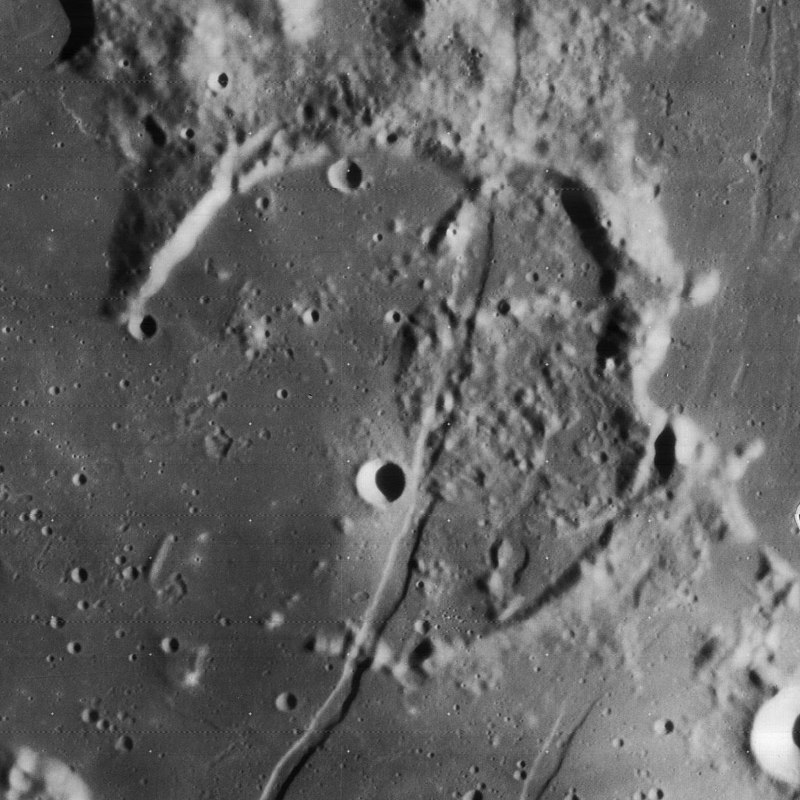
Hippalus (crater), Mare Humorum:
From R W Mackleworth's novel Starflight 3000 (1972), the first part of which is set on the Moon in a future when it has been given the chance to develop an atmosphere, hydrosphere and the beginnings of a biosphere:
He noted the clouds and the light and pressed on faster. In the late afternoon of a long day such storms were not uncommon, as the Earth exerted its pull with a special vengeance on the infant atmosphere.
To his left he saw the shadowy heights guarding the crater Hippalus. The crater opened onto the Mare Humorum like a tilted cup. When the water began to respond to the Earth's pull, the cup would be full of torment; the sea would leap in fury, tearing into the rock walls, leaving the sea bed bare in places for a second or so.
Suddenly he doubted if he dare take to the water before nightfall. At night the seas might calm down between tides but he would have to sail blind, unless the Earthshine broke through the cloud...
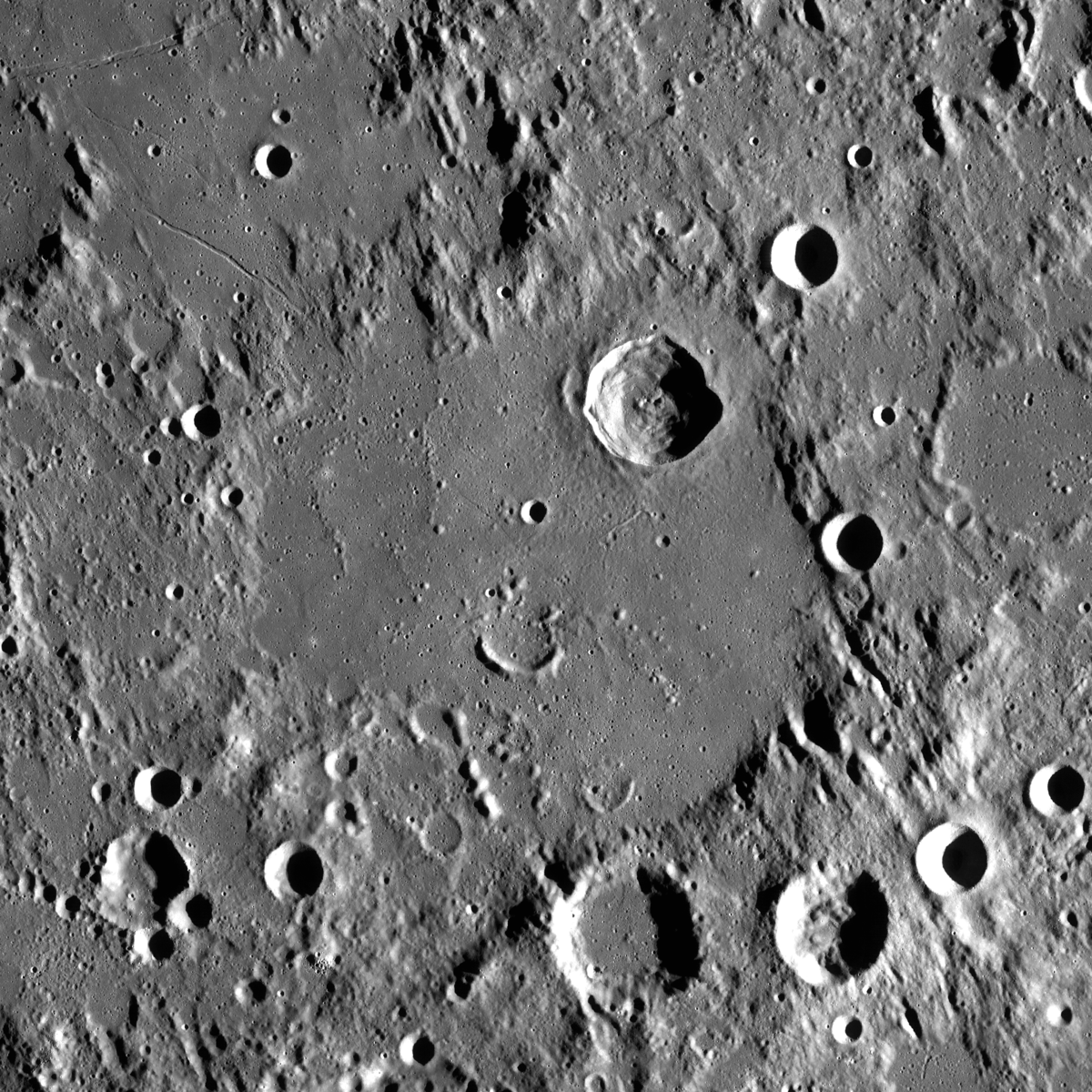 the large, degraded crater
the large, degraded crater
Hipparchus (crater):
From Earthlight by Arthur C Clarke:
...
The meal was tasty but unidentifiable. Like all food on the Moon, it
would have been grown in the great hydroponic farms that sprawled their
square kilometers of pressurized greenhouses along the equator. The meat course was presumably synthetic: it might have been beef, but
Sadler happened to know that the only cow on the Moon lived in luxury at
the Hipparchus Zoo. This was the sort of useless information his
diabolically retentive mind was always picking up and refusing to
disgorge.
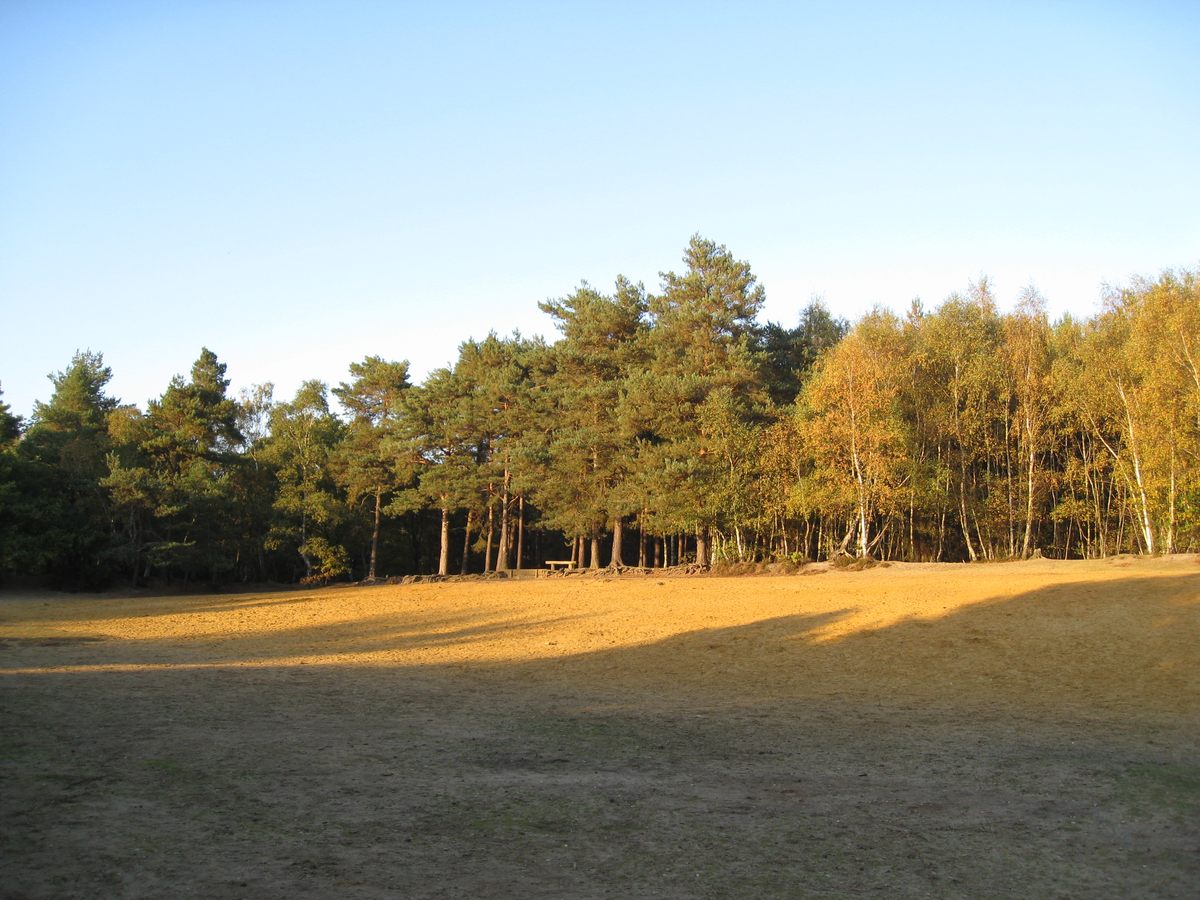 the Horsell Common sandpit
the Horsell Common sandpitHorsell Common, near Woking, Surrey, England:
Impact site of the first cylinder from Mars in the invasion described by H G Wells in The War of the Worlds (1898).
The tops of the pine-trees and the roofs of Horsell came out sharp and black against the western after-glow. The Martians and their appliances were altogether invisible, save for that thin mast upon which their restless mirror wobbled...
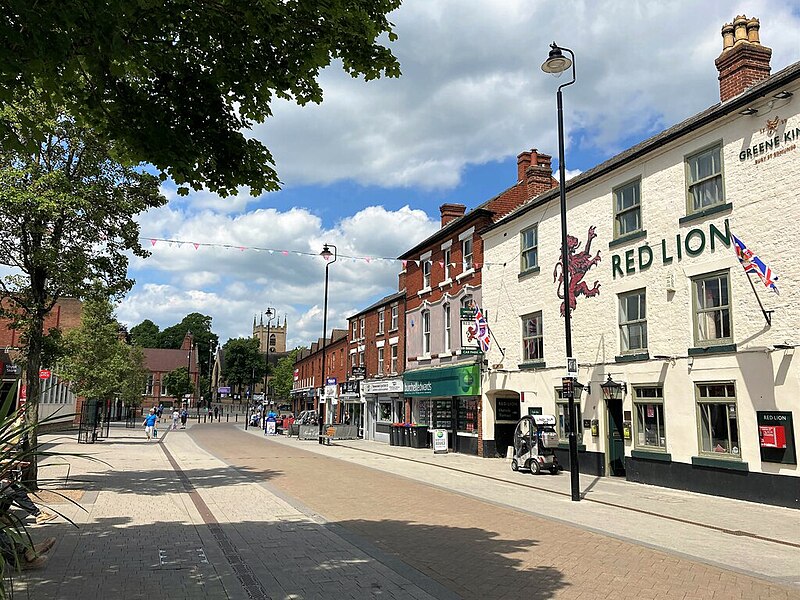
Hucknall, Nottinghamshire, England:
Howard Newman, narrator in Colin Wilson's Lovecraftian novel of expanded consciousness The Philosopher's Stone (1969), re-visits the home of his boyhood:
...A week after Christmas, I went to Hucknall to visit my family. This was an interesting experience. Although the place had changed so much since my childhood, it was still full of memories. And my ability to re-create childhood memories with Proustian intensity meant that I kept slipping back thirty or so years, and becoming a child again. The whole mystery of personality was underlined, for it became obvious that the being I normally accepted as "me" was made up of layer upon geological layer of response to experience, habit patterns. To return to my childhood was to feel half-naked. But it was also to realize that the seeds of distrust-of-life are planted in us very early, and permanently stunt most human beings...
Huygens:
This is a large Martian crater. In Patrick Moore's Peril on Mars (1958) - the fourth of the five novels in his Mars series - there is a base at a location of that name. However, it would seem that the name in the book does not refer to the location of the actual feature: the real Huygens is fairly close to Syrtis Major, whereas in the book the Dome is "on the far side of the planet" (p.25) from Syrtis.
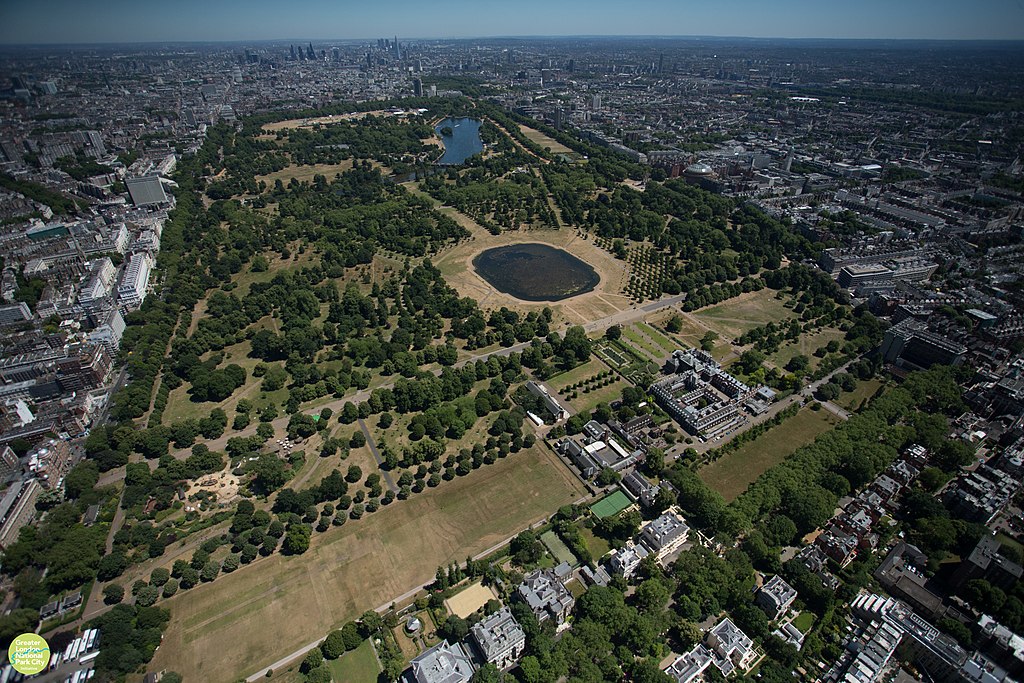
Hyde Park, London, England:
COVID was a picnic compared to the global pandemic in Charles Eric Maine's 1962 novel The Darkest of Nights - in which over half the population perishes, and rebellion and civil war break out over the government's contentious plans for shelters.
Hyde Park, site of one of the first of the underground shelters, had acquired a distinctly military aspect. Driving leisurely by, Clive saw barbed wire fencing patrolled by armed troops, and inside the wire were Nissen huts and armoured cars. At the southern side of the park, near Knightsbridge, two tanks stood squatly on their caterpillar tracks, guns facing outwards across the wide road junction...
Hyginus Cleft - see Mining the Moon.
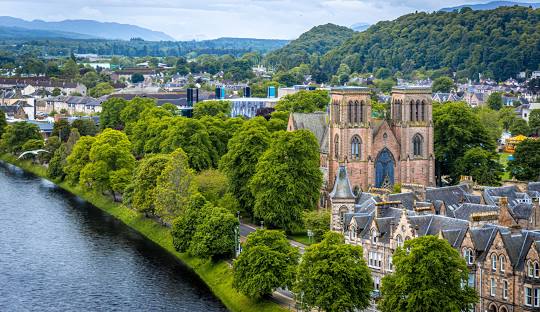
Inverness, Scotland:
A threat to clan-chief Cameron's nascent post-disaster community in the West of Scotland arises in Inverness, in Fred and Geoffrey Hoyle's Inferno (1973):
The temptation everywhere among the isolated pockets of humanity would be to live on existing stores of food, fuel and clothing. Where the stores were largest the temptation would be stongest. It could seem as if stocks might last for ever, but no stock or store would in fact last for ever. Sooner or later people would be thrown onto their own resources, and the sooner the better. Cameron had seen this plainly from the beginning. He had seen that parasites, human parasites, would arise wherever stocks and stores were ample.
This was exactly what happened in the Inverness region. The resources of Inverness were much greater than those of the western valleys. They were sufficient to maintain all survivors through the winter and early spring. Stocks of petrol were the first to run short. Restricted groups were soon in control of the remaining petrol. The groups fought and preyed on each other until one emerged stronger and more dominant than the others...
Iowa, USA:
...I stopped in a bar and looked at a newscast. There was no news from Iowa, but when is there any news from Iowa?
Robert A Heinlein, The Puppet Masters (1951)
See also Goose Island.
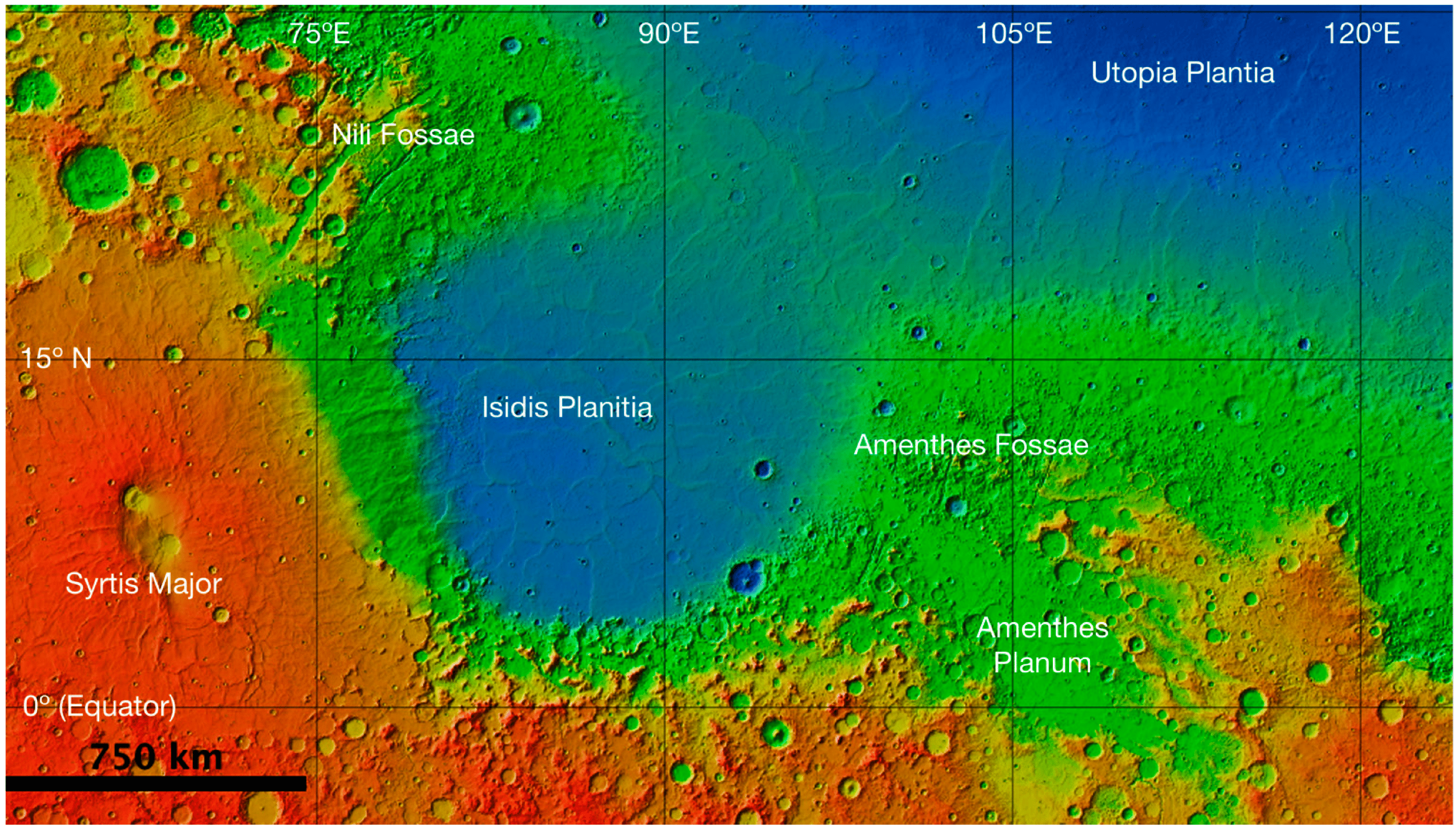
Isidis:
...My memory drifted back to my first landing on Mars, years and years ago. When I was young and raw and green and idealistic. I recalled how we had ridden down in a little, crowded, rattletrap satellite shuttle from Deimos Terminal, flying east across the Tharsis region to make planetfall at the debarkation camp in Isidis Regio. I remembered how I had felt then when I first came out of the lock with the new arrivals, breathing hoarsely through the strange, ill-fitting respirators, waiting to pile on the long tractor train for an interminable, bumpy ride across the craterlets to Syrtis... from The Man Who Loved Mars by Lin Carter (1973).
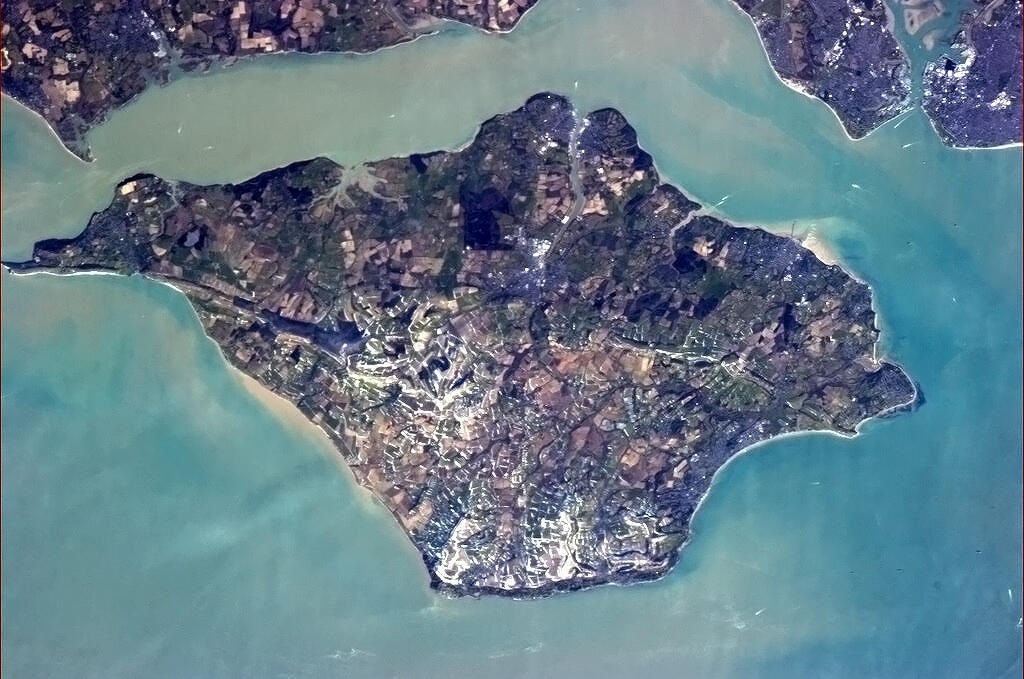 from the International Space Station
from the International Space StationIsle of Wight, England:
Commandeered by the Colossus computer.
"You want a site there?"
"No. I want the island. There is a human population of one million five hundred and twenty-seven thousand. They will have to be moved."
"What!" This shook Forbin right out of his scientific mood. "You can't mean that - move over a million and a half people! There must be some other site just as suitable!"
Colossus ignored him. "The island is 147 square miles in area, largely composed of chalk, a relatively good insulating material. Much of it will be leveled down to bare rock..."
D F Jones, Colossus (1966)
More optimistically, the Island figures as a redoubt against the vegetable scourge of the triffids:
Clearly, the best self-maintaining defence line would be water. To that end they had held a discussion on the various merits of various islands. It had been chiefly climate that had decided them in favour of the Isle of Wight, despite some misgivings over the area that would have to be cleared...
John Wyndham, The Day of the Triffids (1951), chapter 16
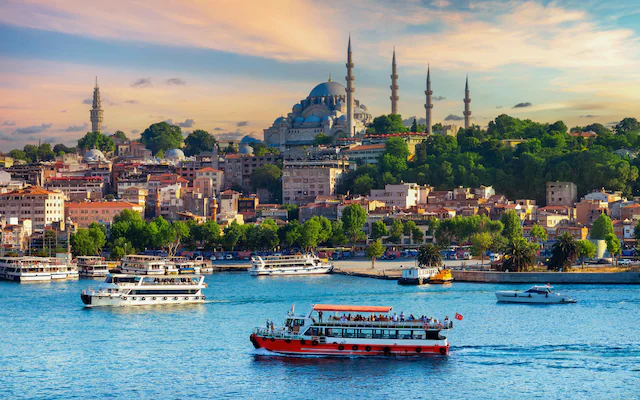
Istanbul, Turkey:
The last man alive is trying to avoid the last woman, because he feels that the human race does not deserve to continue, in M P Shiel's The Purple Cloud (1901):
...I would not let her be there with me another moment - got down into the boat, and, when she followed, rowed her back all the way past Foundoucli and the Tophana quay to where one turns into the Golden Horn by St. Sophia, round the mouth of the Horn being now a vast semicircle of charred wreckage, carried out by the river-currents; then, in the Horn, I went up the steps on the Galata side before one comes to where the barge-bridge had been; and when she had come after me on to the embankment, I passed up one of those mounting streets...
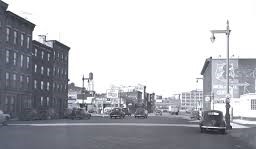
Jersey City, New Jersey, USA:
Graduate student Isherwood Williams, looking for other people who have survived the epidemic that carried off most of humanity, has gone on a long drive across the USA, in part one of Earth Abides (1949) by George R Stewart:
...When he came to the clover-leaf above Jersey City, he stopped in the middle of the Skyway to read the signs. No brakes squealed suddenly behind him; no horns blared; no truck-drivers bawled obscenities at him for blocking the road; no policeman shouted through loud-speakers.
"At least," he thought, "life is quieter."
From far off, he just caught the sound, some bird squawked twice - a seagull probably. The only other sound was the nearly imperceptible murmur of his own idling engine, as drowsy as the hum of bees.
There at the last moment he flinched from trying either of the tunnels. Untended, they might have gradually filled with water, and he had a vague fear of being trapped...
The city is where the contestants line up on Land Race Day in Robert Sheckley's satirical tale of 21st-century overpopulation, The People Trap (Fantasy and Science Fiction, June 1968):
...On his face he wore a fixed smile - absolutely essential when dealing with a high-density human configuration. He could see the Starting Line now, a raised dais in Jersey City's Glebe Park...
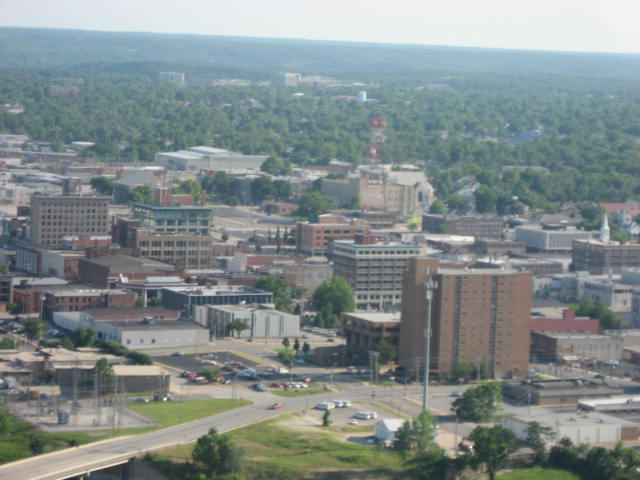 2009
2009Joplin, Missouri, USA:
In the dramatic mixture of probability-world time-paths which the world undergoes in the classic novella by Murray Leinster, Sidewise in Time (Astounding Stories, June 1934), we are shown an ordinary start to a morning that is a prelude to fantastic events in Joplin:
It was half past seven a.m. of June 5, 1935. The city of Joplin, Missouri, awaked from a comfortable, summer-night sleep. Dew glistened upon grass blades and leaves and the filmy webs of morning spiders glittered like diamond dust in the early sunshine. In the most easternly suburb a high-school boy, yawning, came somnolently out of his house to mow the lawn before schooltime...
...And then a marked command, which was definitely not in the English language.
Down the street of a suburb of Joplin, Missouri, on June 5, in the year of our Lord 1935, came a file of spear-armed, shield-bearing soldiers in the short, skirtlike togas of ancient Rome...

Kansas City, Missouri, USA:
Robert A Heinlein (himself a Missourian) in his ultra-tense invasion-novel The Puppet Masters (published 1951; set in 2007) has his agent driving into the city to determine whether it has been taken over by the parasitic Masters, who like to control humans by riding their backs. Chapter XVIII begins:
The city did not look right. It did not have the right flavour, as if it were a clumsily directed play. I tried to put my finger on the fault; it kept slipping away.
Kansas City has many neighbourhoods made up of family units a century old or more. Kids roll on lawns and householders sit on their front porches, just as their great-grandparents did. If there are bomb shelters around, they do not show. The queer old bulky houses, fitted together by guildsmen long since dead, make those neighbourhoods feel like enclaves of security. I cruised through along such streets, dodging dogs and rubber balls and toddlers, and tried to get the feel of the place. It was the slack of the day, time for a drink, for wwatering lawns, for neighbourly chatting. I saw a woman bending over a flower bed. She was wearing a sun suit and her back was bare; clearly she was not wearing a master, nor were the two kids with her. What could be wrong?
In If This Goes On - (Astounding 1940 (serialized); revised and expanded 1953 for inclusion in the Future History volume Revolt in 2100), Heinlein again brings the reader to this part of the country when his hero John Lyle, conspirator against the tyranny of the "Prophet", takes a transport rocket to KC.
...my stomach felt tight as we got off the ship in Kansas City. I expected that gentle touch on the shoulder which is more frightening than a fist in the face. But nothing happened...
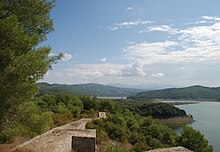
Karatepe, Turkey:
A Hittite fortress, Karatepe features in The Mind Parasites (1967), a novel by Colin Wilson related to Lovecraft's Cthulhu Mythos, as the site of the protagonist's detection, by means of an electronic probe, of a giant buried city two miles beneath the surface. At first the results are naturally disbelieved.
When I opened my eyes, I saw Reich standing beside me, staring out across the river. I looked at my watch, and sat up hastily.
"Why on earth didn't you wake me?"
He sat down on the ground beside me. His manner struck me as subdued.
"What is it? Can't you trace the fault?"
He looked at me thoughtfully.
"There is no fault."
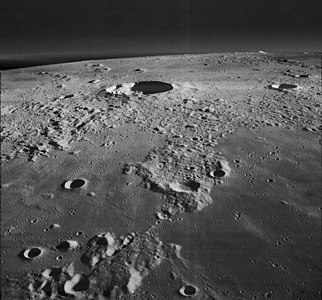
Kepler:
See The Implicizer aimed at Blowups Happen. Along with Copernicus, Kepler in Heinlein's Blowups Happen (Astounding, September 1940) is a secondary site of the ancient Lunarians' nuclear power plant network. (The main site is the location of Tycho.) The power plants all blow up together, ripping away the Moon's atmosphere and
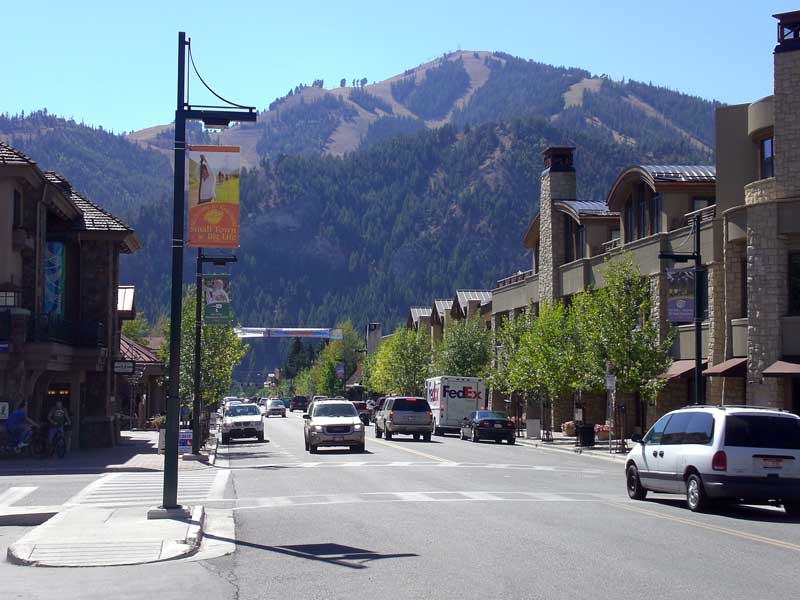
Ketchum, Idaho, USA:
This is the home town of "Peter", twenty-third-century narrator of Fred and Geoffrey Hoyle's mysterious novel The Incandescent Ones (1977), which begins in Moscow and ends on Jupiter.
...Ketchum, I might say, small place that it is, is one of the largest collection points in the United States. But, unlike Moscow, for sheep, not people. It is also near to Sun Valley, which was important to my father, for he was a keen skier of a high-grade amateur class. However, by the time I was fifteen he had to give me best on the slopes... To the time of his disappearance, we often made mountain trips together...
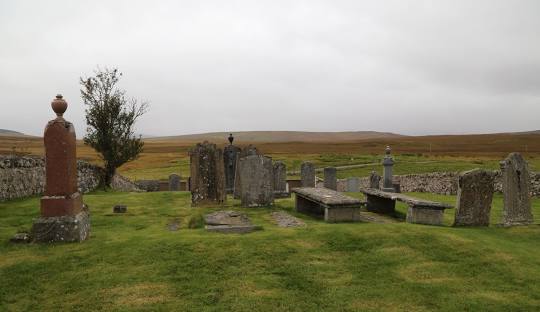
Kinbrace, Sutherland, Scotland:
In Fred and Geoffrey Hoyle's Fifth Planet (1963), this is where the astronomer and his alien-possessed wife escape via rocket in the last chapter.
...Their destination was the small launching-field in eastern Sutherland, just to the north of Kinbrace. Launchings were few and far between, perhaps once every ten days, for a few passengers on international business when that business should happen to take them up to the orbital transit vehicles. It seemed much better to wait quietly and unseen until a rocket was primed and ready in this remote place, rather than risk the major troubles they'd be sure to run into at the big continental sites...
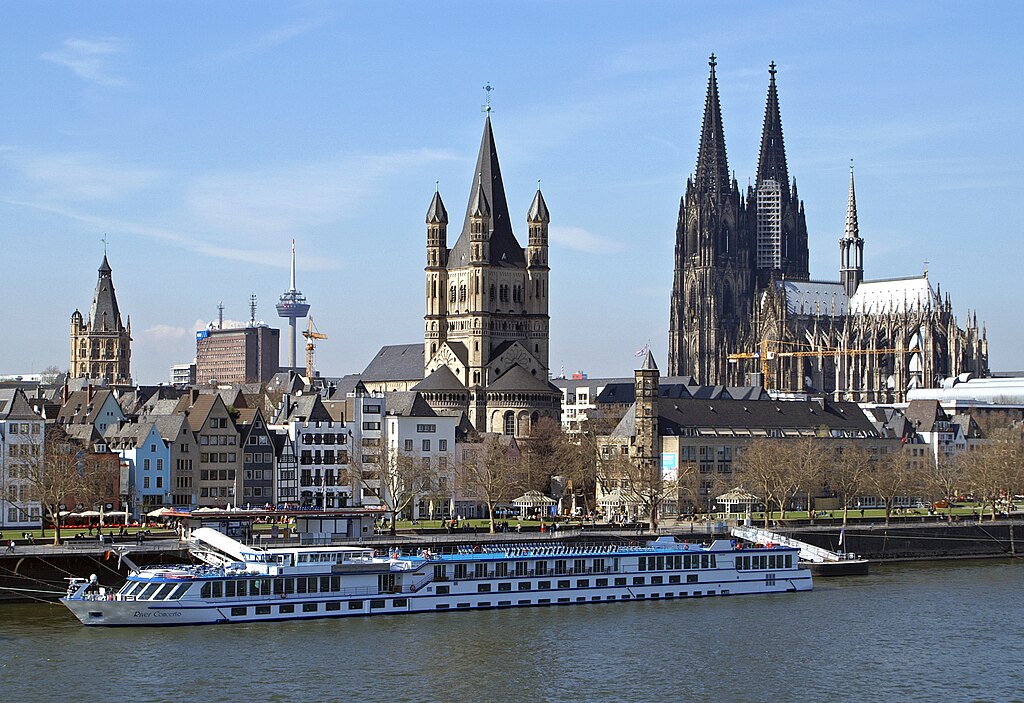
Köln, North Rhine - Westphalia, Germany:
Ghyl Tarvoke, interstellar traveller, visits Old Earth on his quest for the truth behind a legend, in chapter 19 of Emphyrio (1969) by Jack Vance.
...Sitting with Jodel Heurisx at an outdoor café of old Cologne, Ghyl remarked upon the variety of people who walked past their table.
"True enough," said Jodel Heurisx. "Other cities on other planets are cosmopolitan enough, but Earth is a universe in itself."
"I expected the people to seem old - sedate - wise. Some do, of course. But others - well, look at that man in the green suede. His eyes glitter; he looks right and left as if he were seeing everything for the first time. Of course, he might be an outworlder, like us."
"No, he's an Earthman," said Jodel Heurisx. "Don't ask me how I know; I couldn't tell you. A matter of style: small signs that betray a man's background. As for his air of restlessness, sociologists declare that material well-being and psychic stability vary in counter-proportion..."
Part of the first chapter of Fred Hoyle's great time-shift novel October the First is Too Late (1966) is set in Köln. The chapter begins:
I had been invited to compose a piece for the Festival of Contemporary Music, Cologne, 1966. My intention was a set of variations in serial form...
The protagonist's contribution does not go down well at the festival concert.
...There was scattered applause mixed with boos and hisses. Momentarily nonplussed I failed to take a quick bow and to make a quick exit. The hissing increased. Suddenly I became coldly angry. With an imperious gesture I turned to the leader and shouted loudly: "Bar one!" Such is the respect of a German orchestra for its conductor that the players all obediently turned back to the beginning...
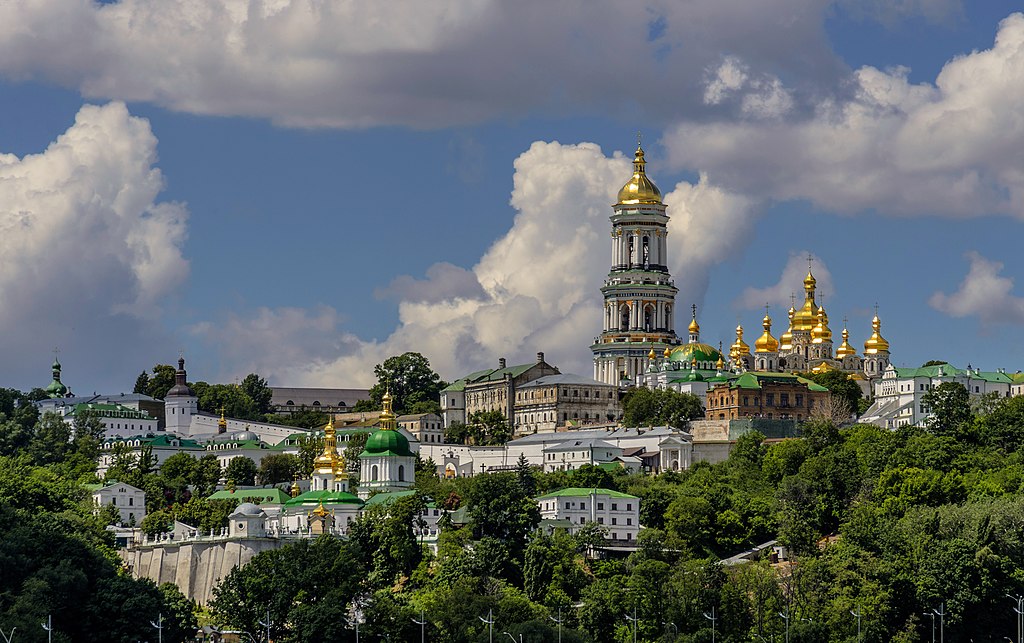
Kyiv, Ukraine:
A search for a lost and priceless Charter, which holds the key to rightful authority on her native Conservancy world, brings Wayness Tamm to various locations on Earth, in Jack Vance's Ecce and Old Earth (1991), volume 2 of the Cadwal Chronicles.
...Almost effervescent with hope, Wayness took herself far to the north and east, over mountains, lakes and rivers and finally down upon the great Altaic Steppe and the ancient city Kiev.
The Funusti Museum occupied the grandiose precincts of the old Konevitsky Palace on Murom Hill, at the back of Kiev's Old Town. Wayness took lodging at the Mazeppa Hotel... Her rooms overlooked Prince Bogdan Yurevich Kolsky Square: a roughly pentagonal area paved with slabs of pink-gray granity. On three sides, two cathedrals and a monastery, lovingly restored and perhaps reconstructed in the ancient style, held aloft dozens of onion-domes, gilded with gold foil, or painted red, blue, green, or in spiral stripes...
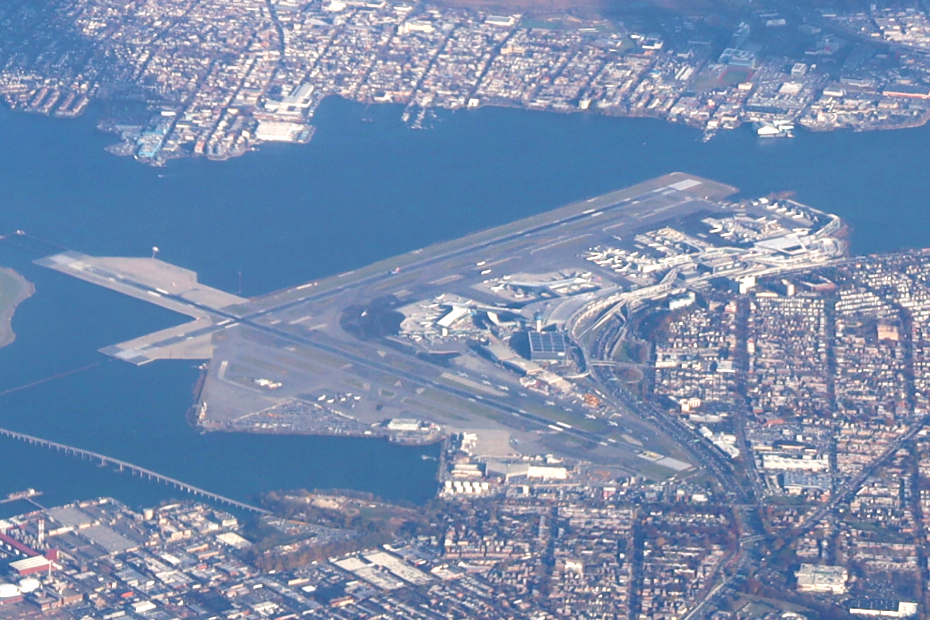
La Guardia airport, New York City, New York, USA:
The airport is the scene of an incident in Colin Wilson's novel of expanded consciousness and Lovecraftian lore, The Philosopher's Stone (1969), when the researchers, waiting in the terminal for their baggage to arrive, accidentally unleash their new powers. A bully tries to make something of an involuntary jostling:
...before I could intervene, the man had grabbed Littleway by the shoulders, and was shouting: "You trying to pick a quarrel, buster?" Littleway said, with quiet anger: "My name i not buster, and if you don't take your hands away..." "You'll what?" said the man, obviously delighted to have a real quarrel on his hands.
What happened next happened in far less time than it takes to tell. I was in a rage; hectoring and bullying make me feel like committing murder. So was Littleway. As stood there, both glaring at the man, ...There was a feeling like an explosion - although not a physical one - and the man simply dropped sideways on to the moving belt...
Labrador, Canada:
This is the province inhabited by the post-apocalypic population described in John Wyndham's 1955 novel The Chrysalids.
The world... was generally thought to be a pretty big place, and probably round. The civilized part of it - of which Waknuk was only a small district - was called Labrador. This was thought to be the Old People's name for it, though that was not very certain. Round most of Labrador there was a great deal of water called the sea... if you were to go three hundred miles or so east, north, or north-west you would come to it sooner or later. But south-west or south, you wouldn't; you'd get to the Fringes and then the Badlands, which would kill you...
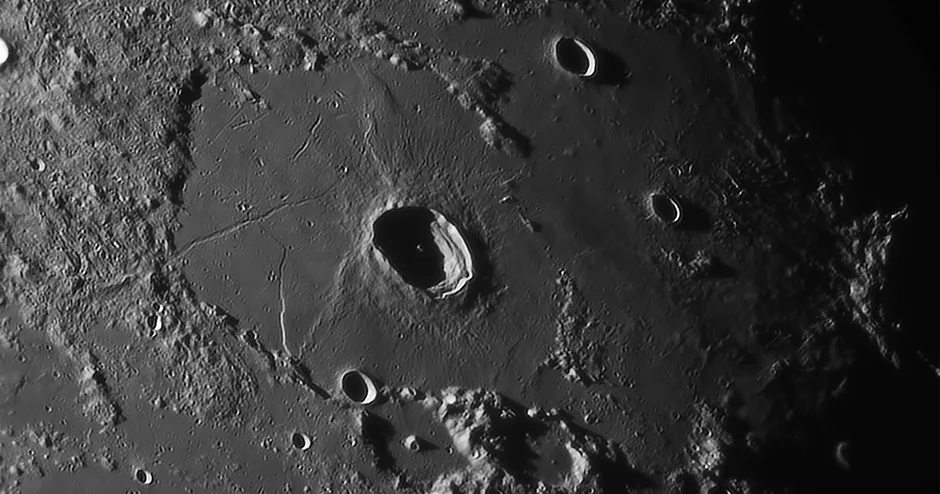
Lacus Mortis:
An area crossed by ground "tractor" in a desperate journey from Plato Base to Farside, in an attempt to warn the Russian base of a danger that threatens everybody on the Moon, in Patrick Moore's Captives of the Moon (1960). Appropriately enough the tractor encounters a near-lethal crevice.
"...It's a bit of a facer, isn't it?"
"More than that," said the Colonel grimly, clambering out of the driving seat. "I'm not generally superstitious, but I admit I wasn't looking forward to crossing the Lake of Death..."
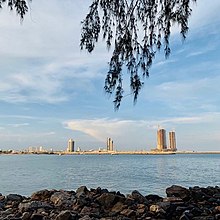
Lagos, Nigeria:
In the climate-change novel The World In Winter (1962) by John Christopher, the African nations enjoy a resurgence while Europe freezes to death. A lounge bar in Lagos is decorated to drive the point home.
...The walls had been painted with continuous murals, a series of huge concave panels. Around the bar they depicted snow and ice, from which projected broken fragments of masonry, towers, domes, pinnacles of brick and steel. These scenes changed, as one's gaze continued in either direction from the bar, into seas at first iceberg-laden, then empty, then calm and silvered by the sun. Past the seas... were the golden sands and palm-fringed shores of a warm and happy land...
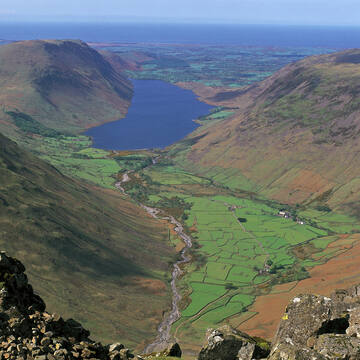
the Lake District, England:
Jerry Coleman, journalist, on his way to investigate a rumoured community of telepaths, has
...an odd feeling that, although he had never been within a hundred miles of the Lake District, the landscape was totally familiar.
Normally he might have put this impression down to the restimulation of half-forgotten memories of photographs and films of the area that he had seen in the past; but this was something more than a general impression. After they had passed through Kendal it became so strong that it could not be ignored. Time and again as he came to a corner, or to the top of a hill, it was as if he knew with certainty what lay beyond, down to the smallest detail. The view of a solitary farmhouse, the pattern of stone walls in a valley, crossing and recrossing with the jigsaw logic of some ancient rights of tenantry, a small church nestling against a clump of trees in the morning sunlight...
It was just after eleven when they began to run down a hill into the village of Alsdale. The feeling of familiarity was even stronger here; it was almost like coming home... Jerry found himself recognising the front of each stone cottage like the face of an old friend; knowing that the board outside the village pub would bear a faded picture of Nelson's flagship and the name VICTORY; that just beyond it would be the village store and post office, its brown-painted facia bearing the name GARFORTH in faded cream capitals...
- Dan Morgan, The Several Minds (1969)
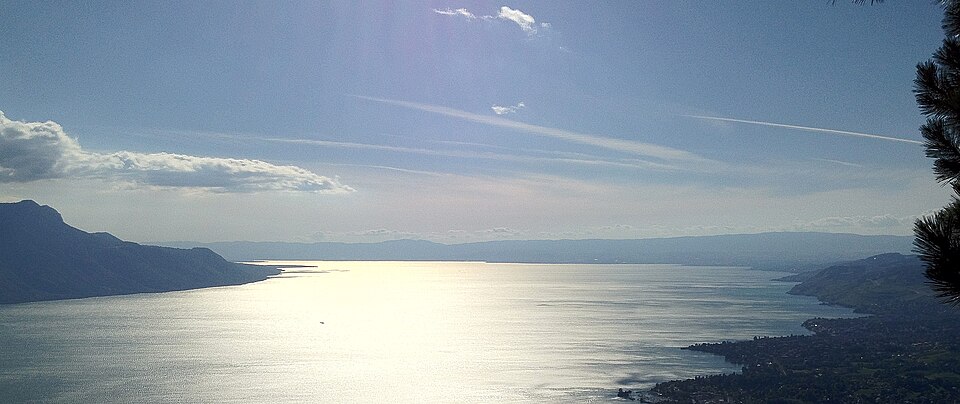
Lake Geneva, Switzerland and France:
An area on the Swiss shore of this lake was selected to receive and house the visiting survivors of the Asteroid Progenitor Planet who had returned to the System after millions of years' exile, in James P Hogan's The Gentle Giants of Ganymede (1978).
....About halfway between the city of Geneva and Lausanne, they fenced off an area just over a mile square on the edge of the lake, and inside it erected a village of chalets that had been designed for Ganymean occupation; the ceilings were high, the doorways big, the beds strong, and the windows slightly tinted...
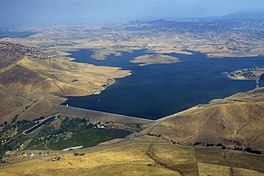
Lake Success, California, USA:
In the comet-strike disaster novel Lucifer's Hammer (1977) by Larry Niven and Jerry Pournelle, earthquakes cause the dam to collapse.
A bit later in the story, the area is a battleground between an organized group of survivors and the cannibalistic "New Brotherhood".
When the sun was high, they saw them: A hundred or more of the New Brotherhood had crossed during the night. They were concentrated now on the old Lake Success bed, and the moved back towards the ruined bridge, sweeping aside the screen of Stronghold defenders. The Brotherhood's mortars began to fire, forcing the defenders back up the valley and onto the ridges...
Laplace Promontory: (for pictures see Heraclides Promontory and Sinus Iridum)
From Arthur C Clarke's account of a lunar marathon run in The Hammer of God (1993):
...The far horizon was no longer a dead-straight line, dividing the glowing landscape from the black night of space. He was approaching the western limits of the Bay of Rainbows,and the gently rounded peaks of Promontory Laplace were rising above the curve of the Moon. The sight, and the knowledge that his own efforts had lifted those mountains into view, gave Singh a final burst of strength...
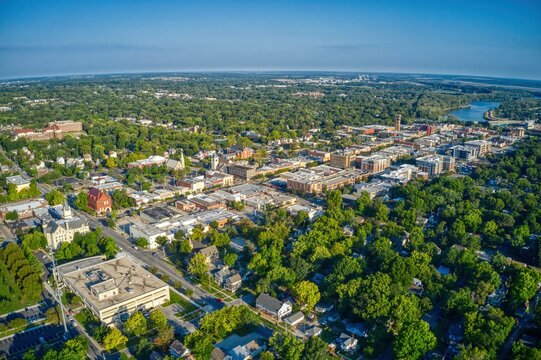
Lawrence, Kansas, USA:
In The Immortals by James E Gunn (1958, 1962) this city has taken over from Topeka as the state capital.
...They marched down the turnpike toward Lawrence...
The governor's mansion was built on the top of an L-shaped hill that stood tall between two river valleys. Once it had been the site of a great university, but taxes for supporting such institutions had been diverted into more vital channels. Private contributions had dwindled as the demands of medical research and medical care had intensified. Soon there was no interest in educational fripperies, and the university died.
The governor had built his mansion there some seventy-five years ago when Topeka became unbearable. Long before that it had become a lifetime office - and the governor would live forever.
The state of Kansas was a barony... The governor was a baron, and the mansion was his keep. His vassals were the suburban squires; they were paid with immortality or its promise...
...The mansion rose, ziggurat fashion, in terraced steps. On each rooftop was a hydroponic farm. At the summit of the buildings was a glass penthouse; the noon sun turned it into silver. On a mast towering above, a radar dish rotated...
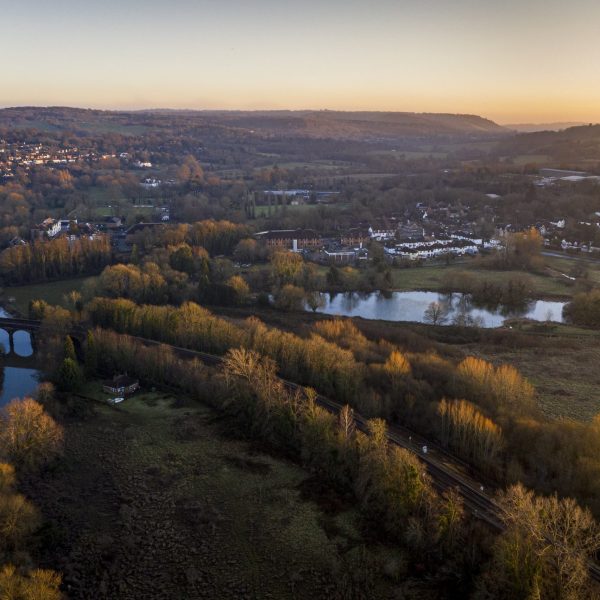
Leatherhead, Surrey, England:
The narrator in H G Wells' The War of the Worlds (1898) decides, in view of the Martian invasion, to borrow a horse and cart and take his wife to stay with relatives in Leatherhead.
Leatherhead is about twelve miles from Maybury Hill. The scene of hay was in the air through the lush meadows beyond Pyrford, and the hedges on either side were sweet and gay with multitudes of dog-roses. The heavy firing that had broken out while we were driving down Maybury Hill ceased as abruptly as it began, leaving the evening very peaceful and still. We got to Leatherhead without misadventure about nine o'clock, and the horse had an hour's rest while I took supper with my cousins and commended my wife to their care.
My wife was curiously silent throughout the drive, and seemed oppressed with forebodings of evil. I talked to her reassuringly, pointing out that the Martians were tied to the pit by sheer heaviness, and, at the utmost, could but crawl a little out of it, but she answered only in monosyllables. Had it not been for my promise to the innkeeper, she would, I think, have urged me to stay in Leatherhead that night. Would that I had!
...but he feels honour bound to return the innkeeper's cart...
Leicester, England:
Birthplace of author Colin Wilson. The city also appears, though without being described, in his Lovecraft-inspired novel The Philosopher's Stone (1969).
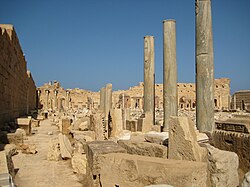
Leptis Magna, Libya:
Close to the creeping dusk-line on an Earth which has virtually ceased to rotate, this site haunts the dreams of Halliday, protagonist of J G Ballard's The Day of Forever (New Worlds, January 1967).
Half a mile from Leptis Magna he could hear the sea washing on the beaches through the darkness, the onshore winds whipping at the crests of the dunes in the moonlight. The ruined columns of the Roman city rose beside the single tourist hotel that shut out the last rays of the sun. Halliday stopped the car by the hotel, and walked past the derelict kiosks at the outskirts of the town. The tall arcades of the forum loomed ahead, the rebuilt statues of Olympian deities standing on their pedestals above him...
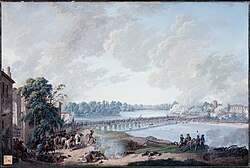 the battle of Lodi Bridge, 1796
the battle of Lodi Bridge, 1796Lodi, Lombardy, Italy:
In Frederick Brown's Come And Go Mad (Weird Tales, July 1949) the cosmic intelligences who play games with humans decide to pick on Napoleon Bonaparte at Lodi and transfer the Corsican's mind into the body of a twentieth-century reporter, George Vine.
"You want to know of yourself. Nothing is less important. A move was made, before Lodi. The opportunity was there for a move of the red; a strong, more ruthless personality was needed; it was a turning point in history - which means in the game. Do you understand now? A pinch-hitter was put in to become Emperor."
London, England:
In the hundredth century there won't be anything much left of its current self, according to Charles Eric Maine's The Man Who Owned the World (1961).
The city was unrecognizable, of course. In eight thousand years atomic bombardment, alternating with periods of rebuilding, had completely altered the geometry and appearance of the place; even the Thames, twisting and turning like a slender silver ribbon through areas of radioactive devastation, seemed to have changed its course at several points. Central London was a wilderness of fused stone and leaning skeletal buildings, blackened and oxidized by nuclear heat flash...
However, the picture is vastly different in Jack Vance's The Palace of Love (1967), third in his "Demon Princes" series. In this unputdownable novel the protagonist Kirth Gersen, on the vengeful trail of killer and slaver Viole Falushe, goes to London in order (as part of his strategy) to buy control of "Cosmopolis" magazine. The year is 3526 (1526 New Style), and despite the text's many clues about changes in infrastructure and technology, the old city has worn well:
...He rode to London by tube, and registered at the Royal Oak Hotel, a block off the Strand. The season was early autumn; the sun shone through a high thin overcast. Old London, permeated with the vapors of antiquity, shone like a fine gray pearl.
Gersen's clothes were in the Alphanor style, fuller in cut and richer in color than the clothes of London. On the Strand he went into a gentleman's outfitter, where he selected a fabric, then stripped to his underwear and was measured by photonic scanners. Five minutes later he was delivered his new garments: black trousers, a jacket of dark brown and beige, a white blouse and black cravat. Inconspicuous now, Gersen continued along the Strand...
...Gersen dined at a restaurant which had maintained an unbroken tenancy for over seventeen hundred years. The old oak beams, fumed and waxed, were as stout as ever; the plaster had recently been scraped of twenty layers of whitewash and refinished; a process which occurred every hundred years or so...
From the comparatively near future we get a view of the metropolis in the 1973 novella by Barrington J Bayley, The Seed of Evil (New Writings in SF-23):
Twenty-second-century London was bowl-shaped.
At the dead centre there still stood, as an archaic reminder, the old Houses of Parliament. Around them the numerous government departments had extended their premises until they swallowed up the previous commercial areas for a considerable distance around, stretching along Tottenham Court Road to the North, along both arms of the river to East and West, and into Waterloo to the South. The buildings were modest in dimensions, however, and mostly of a conservative twentieth-century style. Beyond the centre the suburbs had elevated themselves progressively in a step-like version of the habitat mode, rising at the perimeter to just under a mile in height. At close quarters the habitat suburbs, with their lack of any clear linear organisation, were like a three-dimensional jungle - especially since Londoners had rediscovered the pleasure of gardens. From a distance they merged into a sparkling, curved surface and gave the city the impression of being a vast arena. When the sun rose over the edge of the perimeter, the great bowl acted as a sun-trap; when it fell below it, illumination continued to filter through the myriad interstices and filled the interior with a panorama of light and shade...
We have a description of late-Victorian London in Poul Anderson's Time Patrol (Fantasy and Science Fiction, May 1955) - see the Fictional Dates timeline's second entry for the year 1894.
The Nigerian expedition to Britain reaches a frozen London by hovercraft in the 1962 novel of climatic disaster, The World in Winter by John Christopher:
...They cruised along the broad reach of the Thames, flanked by empty silent cliffs of white. Behind them the western sky was lurid, with heavy banks of cloud lit by the declining sun...
...They passed the Tate Gallery. Under the usual anonymity of white, there were signs of the ravages of fire; broken windows showed glimpses of a gutted interior. The more important canvases had been removed before the crash - flow out to the southern countries for sale at knock-down prices to glean what foreign currency they could...
A snippet of information about London comes from Clifford Simak's intersteller tale Immigrant (Astounding, March 1954), which describes the seemingly miraculous powers of the super-advanced inhabitants of the planet Kimon:
...There was, quite naturally, no mail service between Kimon and Earth, but the letters were delivered, and in a most fantastic, although when you think about it a most logical, way. They were rolled into a bundle and placed in a sort of tube... delivered, quite neatly, on the desk of the World Postal Chief in London...
Lone Pine, Minnesota, USA:
A huge black box appears in the sky above Lone Pine, heralding the invasion described in Clifford Simak's The Visitors (1980). According to Wikipedia the town does exist, though regrettably I have not found a picture to put here.
Lone Pine, though not in Wisconsin, seems to be classic Simak country:
...Outside the shop, the two blocks of stores and business places in the town of Lone Pine drowsed in the late afternoon of an early autumn day. A few cars were parked along the street. Three dogs went through elaborate, formal canine recognition rites, three old friends meeting at the northwest corner of an intersection. Stiffy Grant, tattered and disreputable man-about-town, sat on a nail keg outside the town's one hardware store, paying close attention to the smoking of a fairly decent-sized cigar stub that he had rescued from the gutter. Sally, the waitress at the Pine Cafe, slowly swept the sidewalk in front of her place of employment, making the job last, reluctant to leave the warm autumn sunshine and go inside again...
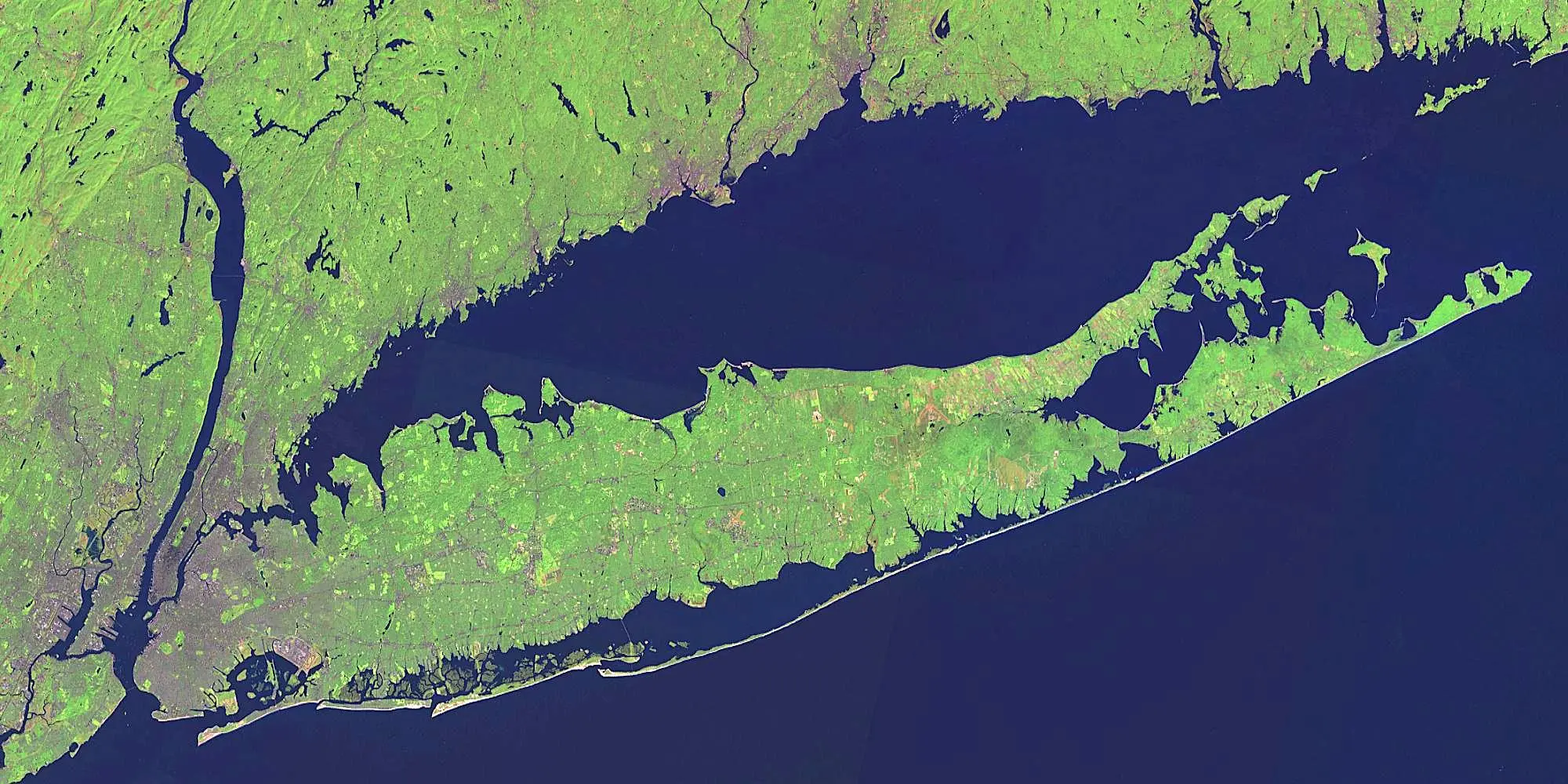
Long Island, New York, USA:
Earth's main spaceport is located on this island in The Impossible World by Eando Binder (Startling Stories, March 1939):
...Far to the west could be seen the spires of Manhattan, Earth's largest and busiest city, the beating heart of man's empire in the skies. Closer, on Long Island itself, lay Tellus Space Port, with its gigantic drome and hangars and its wide-spread landing field.
Great liners and freighters rocketed up and thundered down constantly. The bull roars of their powerful engines could be heard as a steady low undertone, like the beating of an endless surf...
Shorter, wittier and more sprightly is Edmond Hamilton's The Deconventionalizers (Thrilling Wonder Stories, Summer 19445) which suggests that some Martians will go to any lengths to destabilize Earth's culture.
The disaster that was to ruin modern civilization began when Jim Blake decided not to mow his lawn.
Blake always mowed his lawn on Saturday afternoon. Everyone in this neat little Long Island suburb did so. It was as much a custom as going to church on Sunday.
But on this particular June afternoon...
Long Valley, California, USA:
Birthplace of Clark Ashton Smith (13th January 1893).
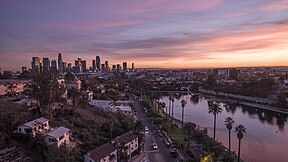
Los Angeles, California, USA:
"...TV and radio transmission from your town called Los Angeles have ceased. It is probable that the heat flash has ignited it..." reports the tyrannical computer in the sf thriller Colossus by D F Jones (1966).
The coast of Los Angeles County is the scene in Leigh Brackett's novelette The Halfling (Astonishing Stories, February 1943), featuring "Jade Greene's Interplanetary Carnival, The Wonders of the Seven Worlds Alive Before Your Eyes". It begins:
I was watching the sunset. It was something pretty special in the line of California sunsets... The pitch was in the flatlands between Culver City and Venice, and I could smell the sea. I was born in a little dump at Venice, Cal., and I've never found any smell like the clean cold salt of the Pacific - not anywhere in the Solar System...
[Note: Los Angeles was the birthplace of Leigh Brackett, 7th December 1915.]
Fred and Geoffrey Hoyle in Fifth Planet (1963), in regard to the "sprawling, amorphous character" of the cities of the late 21st century, mention (p.20) that Los Angeles had stretched out as far as Albuquerque...
The lurking carnivorous entity at Grandmother Keaton's house in Los Angeles is the subject of Call Him Demon by Henry Kuttner (Thrilling Wonder Stories, Fall 1946 and the collection The Best of Kuttner 1). Jane Larkin is visiting her cousins and soon realizes that one of the 'uncles' is not a person at all...
...The other kids watched her with impassive eyes. They knew. They saw she knew. But they said nothing just then. Jane realized she could not mention the - the trouble - either, until they brought it up. That was part of the silent etiquette of childhood. But the whole house was full of uneasiness. The adults merely sensed a trouble, something vaguely wrong. The children, Jane saw, knew.
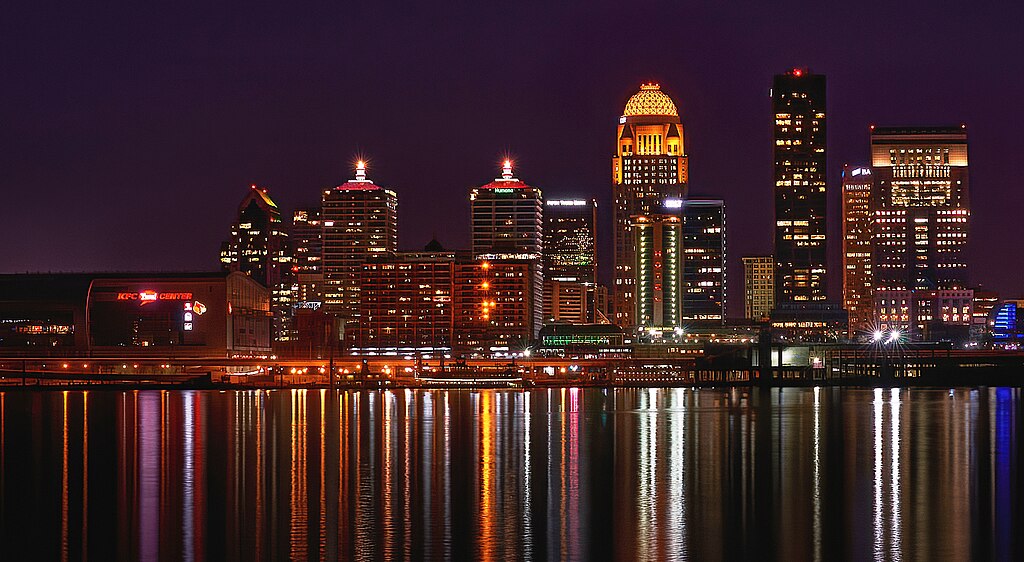
Louisville, Kentucky, USA:
Len looked at the pleasant village strung out along the canal, and at the wide green plain beyond it, dotted with farmsteads and grazing cattle... "That used to be a city, didn't it?"
"A big one."
"I remember now, it was named after the king of France. Mr. Hostetter - "
"Hm?"
"Whatever happened to those countries - I mean, like France?"|
"They're just about like us - the ones on the winning side. Lord knows what happened to the ones that lost. The whole world has jogged back to pretty much what it was when Louisville was this size before, and this canal was first dug..."
From Leigh Brackett's post-disaster novel The Long Tomorrow (1955).
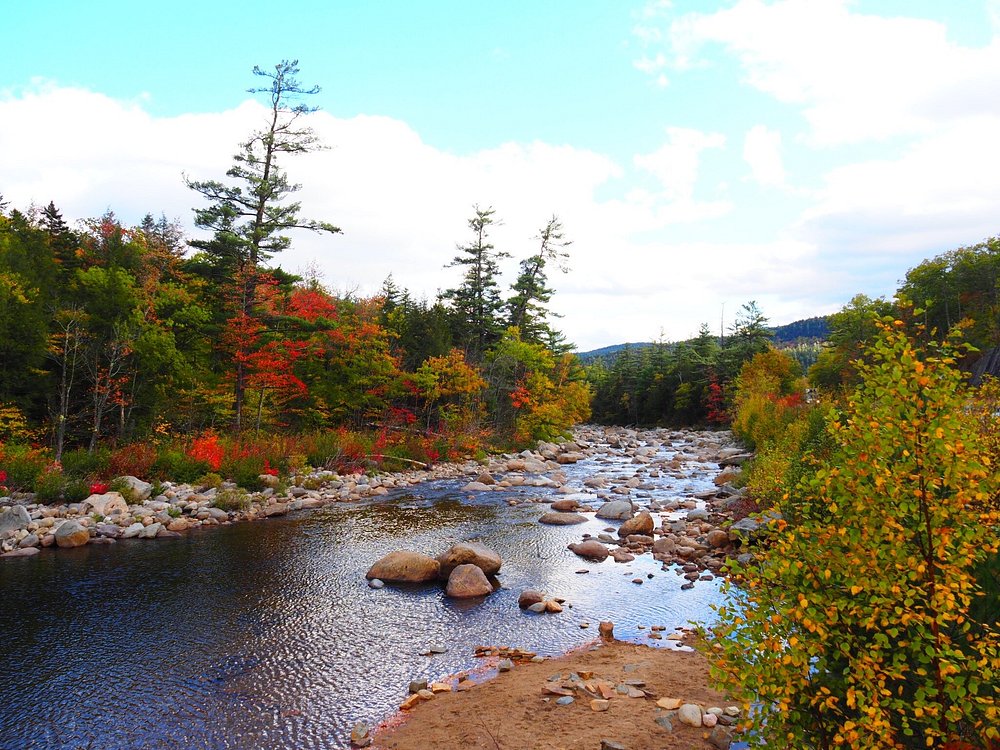
Lower Falls, New Hampshire, USA:
The four of Isaac Asimov's sf-detective tales which feature Wendell Urth, an eccentric, rotund expert on extraterrestrial life, include The Dying Night (Fantasy and Science Fiction, July 1956) at the end of which the hodophobic Urth surprisingly voices a wish to travel - by matter-transmission.
..."Now, wait. Trips through outer space are a long way off."
Urth shook his head rapidly. "Not outer space. Not at all. I would like to step across to Lower Falls, New Hampshire."
"All right. But why?"
Urth looked up. To Talliaferro's outright surprise the extraterrologist's face wore an expression compounded of shyness and eagerness.
Urth said, "I once - quite a long time ago - knew a girl there. It's been many years - but I sometimes wonder - "
A nice ending - but when I looked up Lower Falls online (half expecting it not to exist) I found that the place seems to be a solely scenic location, not a settlement, so where could Urth's girl have lived?
 Romney Marsh from Lympne
Romney Marsh from LympneLympne, Kent, England:
Certainly if any one wants solitude, the place is Lympne. It is in the clay part of Kent, and my bungalow stood on the edge of an old sea cliff and stared across the flats of Romney Marsh at the sea... It was the big port of England in Roman times, Portus Lemanus, and now the sea is four miles away. All down the steep hill are boulders and masses of Roman brickwork, and from it old Watling Street, still paved in places, starts like an arrow to the north... Thus H G Wells' narrator Bedford in The First Men in the Moon (1901)
Lyon, Lyonnais, France:

From The Many-Coloured Land (1981) by Julian May:
...Madame underwent rejuvenation and displayed an austere chic in her second lifetime. In the valley below the inn, the most ancient urban center in France also underwent graceful transition, as did all of the metropolitan centers of Old Earth in those middle years of the twenty-first century. Every trace of the ugly, ecologically destructive technology was gradually obliterated from the great city at the confluence of the Rhône and Saône. Necessary manufacturing establishments, service and transit systems were relocated in underground infrastructures. As the surplus population of Lyon was siphoned off to the new planets, empty slums and dreary suburbs faded into meadows and forest reserves, dotted here and there with garden villages or efficient habitat complexes. Lyon's historic structures, representing every century for the more than 2000 years of its lifetime, were refurbished and displayed like jewels in appropriate natural settings. Laboratories, offices, ghotels, and commercial enterprises were tucked into recycled buildings or disguised to harmonize with the ambiance of nearby monuments. Plaisances and boulevards replaced the hideous concrete autoroutes. Amusement sites, picturesque alleys of small shops, and cultural foundations multiplied as colonials began returning to the Old World from the far-flung stars, seeking their ethnic heritage...
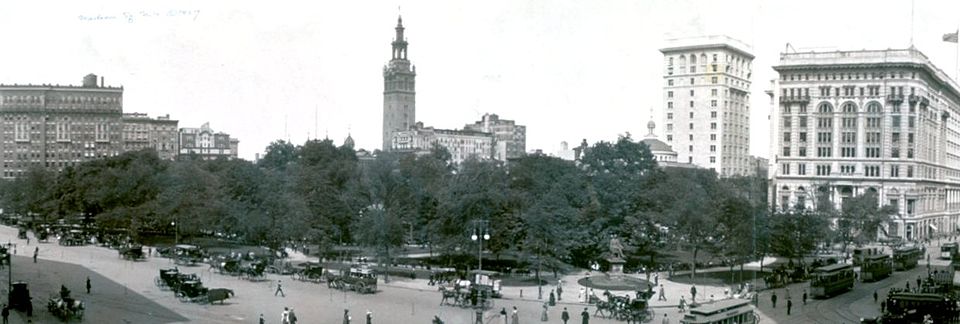 Madison Square, 1908
Madison Square, 1908Madison Square, Manhattan, New York City, USA:
Murray Leinster's first published story, The Runaway Skyscraper (Argosy, 22 February 1919; reprinted in Amazing Stories, June 1926) tells of a building which (due to an odd form of subsidence involving the fourth dimension) shoots centuries back in time.
...Here, where they had been accustomed to see Madison Square spread out before them, a clearing of perhaps half an acre in extent showed itself. Where their eyes instinctively looked for the dark bronze fountain, near which soap-box orators aforetime held sway, they saw a tent, a wigwam of hides and bark gaily painted. And before the wigwam were two or three brown-skinned Indians, utterly petrified with astonishment...
...Arthur stood at the window of his office and stared out toward the west. The sun was setting, but upon what a scene!
Where, from this same window Arthur had seen the sun setting behind the Jersey hills, all edged with the angular roofs of factories, with their chimneys emitting columns of smoke, he now saw the same sun sinking redly behind a mass of luxuriant foliage...
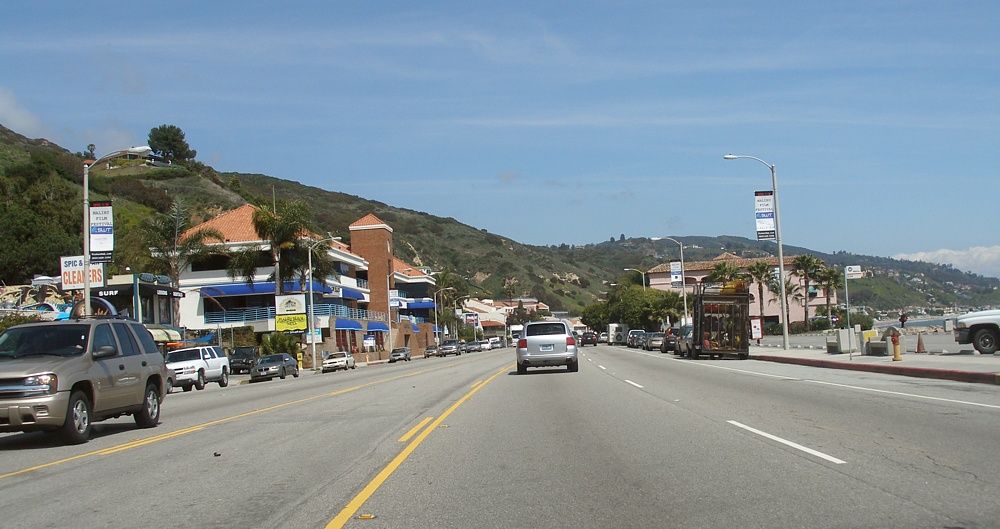 US 101 (Pacific Coast Highway) at Malibu - the road taken by Mr Jimmon in "Lot"
US 101 (Pacific Coast Highway) at Malibu - the road taken by Mr Jimmon in "Lot"Malibu, California, USA:
When the bomb drops on Los Angeles, the ex-banker David Jimmon, protagonist of Ward Moore's Lot (Fantasy & Science Fiction, May 1953), is ready to drive into the wilderness with his family - most of whom, however, are too stupid to realize the seriousness of the situation.
Wendell was already in the station wagon. With Waggie hidden somewhere. Should have sent the dog to the humane society; more merciful to have it put to sleep. Too late now; Waggie would have to take his chance. There were plenty of rabbits in the hills above Malibu, he had often seen them quite close to the house. At all events there was no room for a dog in the wagon, already loaded to within a pound of its capacity...
Mallorca, Balearic Isles, Spain:
In James H Schmitz' secret-society-of-super-scientists tale, Gone Fishing (Analog, May 1961), the "McAllen Tube" is the invention of instantaneous transportation, kept hush-hush because mankind is not yet ready for it; however, a dangerous blackmailer and conman named Barney Chard discovers proof of the Tube when he obtains photographs of its inventor at two locations mere minutes apart in time, one in California and the other in Mallorca.
....The rest was routine, not difficult to carry out. A small cottage on Mallorca, near the waterfront, was found to be in McAllen's name. McAllen's liquid assets were established to have dwindled... There had been frequent withdrawals of large, irregular sums throughout the past years...
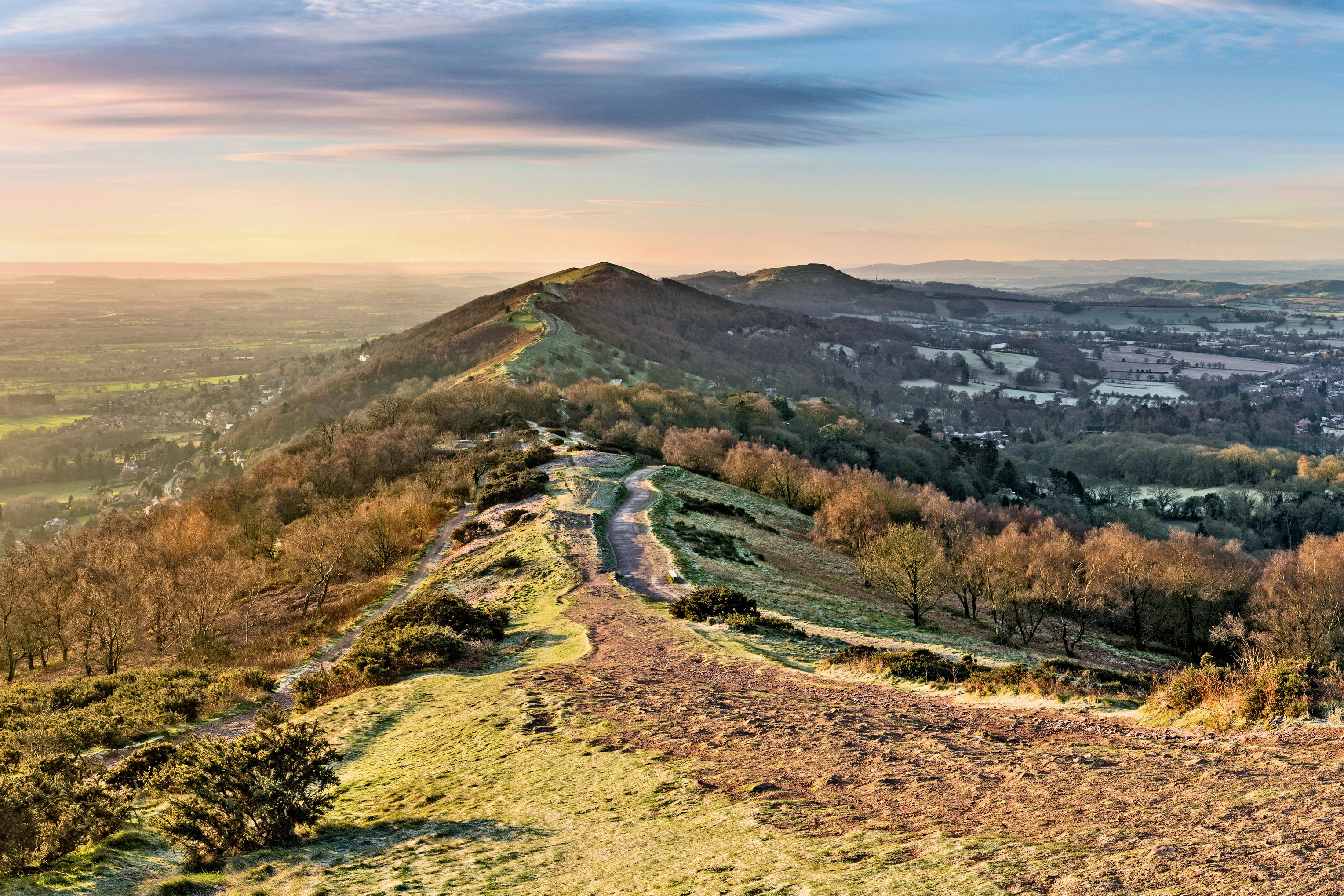
the Malvern Hills, Worcestershire, England:
This beautiful area provides the peaceful opening scene in John Boland's 1955 thriller about weather used as warfare, White August, in which an unnamed enemy seeks to destroy Britain by a radioactive snowfall:
At seven o'clock on the evening of July 28th, the sun glared down from a cloudless sky. Over the whole of the Worcestershire countryside its rays were still a burden after a day of almost intolerable heat. On the slopes of the Malvern Hills gangs of weary, sweating men had extinguished the gorse fire, although smoke still rose straight from the ashes in many places.
Three miles to the west of the hills the village of Sturridge was amost without movement; the only mad-made sounds a bumble of voices and the clinking of glasses that fliltered from the open windows of the Wheel Inn...
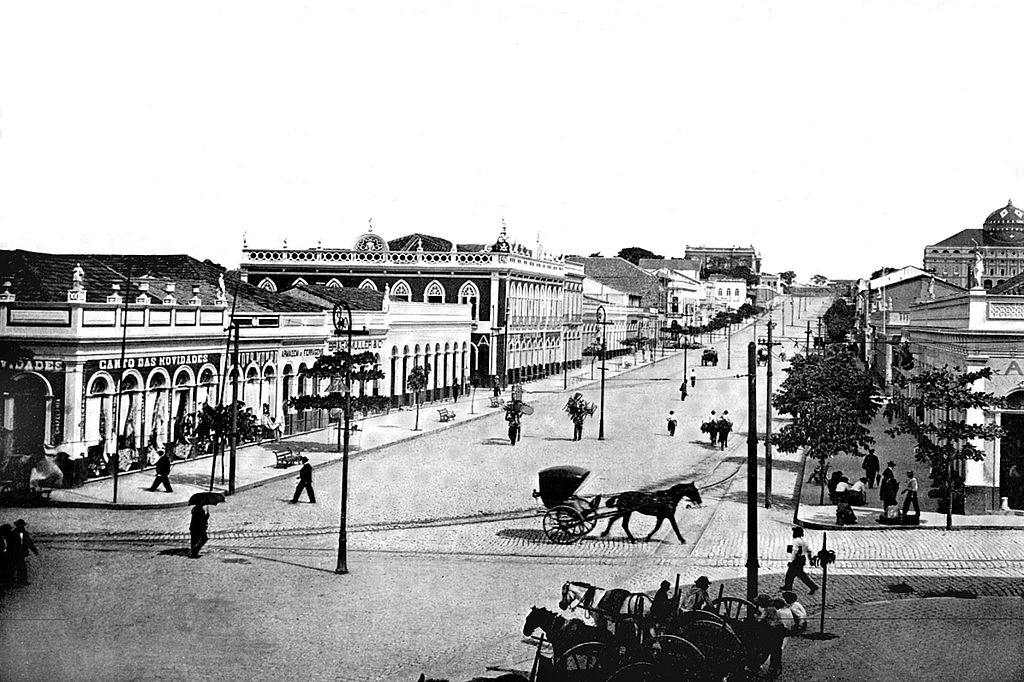 Av. Edouardo Ribeiro, 1901
Av. Edouardo Ribeiro, 1901Manaus, Amazonas, Brazil:
In Sir Arthur Conan Doyle's The Lost World (1912) Professor Challenger meets the other members of the expedition at Manaus.
"Is all ready for your journey?" he asked.
"We can start to-morrow."
"Then so you shall. You need no chart of directions now, since you will have the inestimable advantage of my own guidance. From the first I had determined that I would myself preside over your investigation. The most elaborate charts would, as you will readily admit, be a poor substitute for my own intelligence and advice..."
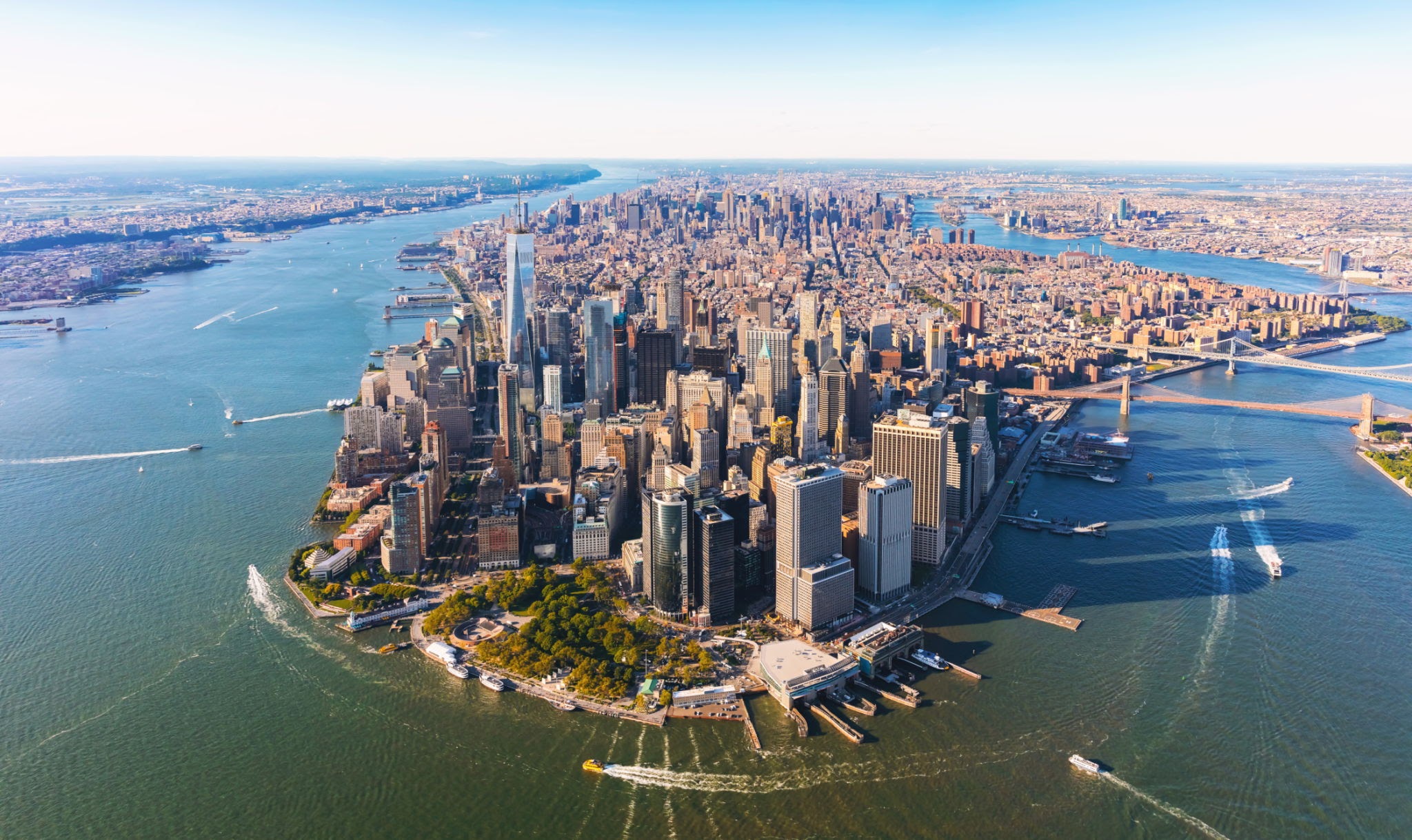
Manhattan, New York, USA:
One of the few survivors of a global pandemic, thoughtful loner Isherwood Williams travels through a USA largely emptied of humanity, and eventually reaches deserted New York City, in George R Stewart's 1949 classic Earth Abides.
...He swung north and at last crossed by the empty George Washington Bridge, and came to Manhattan.
Stretched out between its rivers, the city will remain for a long time. Stone and brick, concrete and asphalt, glass - time deals gently with them. Water leaves black stains, moss shows green, a little grass springs up in the cracks. (That is only the surface.) A window-pane grows loose, vibrates, breaks in a gusty wind. Lightning strikes, loosening the tiles of a cornice. A wall leans, as footings yield in the long rains; after years have passed, it falls, scattering bricks across the street. Frost works, and in the March thaw some flakes of stone scale off. (It is all very slow.) The rain washes quietly through the gutters into the storm-drains, and if the storm-drains clog, the rain runs still through the gutters into the river. The snow piles deep in the long canyons, drifting at the street corners; no one disturbs it. In the spring, it too runs off into the gutters. As in the desert, a year is like an hour in the night; a century, like a day.
Indeed, the city is much like the desert. From the asphalt-and-concrete-coated soil the rain runs off... Here and there in a crack the subtle grass and the hardy weeds grow up a little, but no tree or vine or tall grass takes root... after a while even the rats go away... Only the flying creatures find there a refuge... It will remain a long time, a very long time. [See also Central Park and Fifth Avenue]
The centrifugal force due to a speeding up of Earth's rotation described in Ronald M Sherin's disaster tale When the World Went Mad, set in 1938 (Amazing Stories Quarterly, Fall 1928), has a deleterious effect on Manhattan:
On lower Broadway scenes of indescribable confusion were taking place. As the solid mass of humanity swept forwrd, the steeple of Trinity Church was seen to be reeling drunkenly upon its base... In the distance, the form of the Woolworth Building, giant of skyscrapers, could be discerned, its colossal tower writhing helplessly in the grip of the invisible destroyer...
Manhattan has been transformed more peacefully in The Man Who Awoke (Wonder Stories, March 1933) by Laurence Manning, in which "sleeper" Norman Winters, having woken in 5000 AD, is taken on a flight above the site of old New York City.
...Beneath him then lay the narrow strip of Manhattan and the forest towered over everything else.
"There are ruins beneath the trees," said the Forester, noting his interest. "I have been there several times. Our historians believe the people of ancient times who lived here must have been afraid of the open air, for they either lived beneath the ground or raised stone buildings which could be entered without going out-of-doors. There are tunnels, which they used for roadways, running all beneath the ground in every direction..."
See also the entry for Madison Square.
Manhattan in the years around 2087 is described in Fred and Geoffrey Hoyle's Fifth Planet (1963), p66-7.
...With the coming of night the people who thronged the streets of Manhattan during the day mostly retired to their homes, down the Jersey coast or far up the valley of the Hudson, or into Westchester and beyond to Connecticut... The whole island, from the Battery in the south to its northernmost tip, is now solid with office premises...
Strangely enough the stresses to which the modern New Yorker is subject in his daily life are probably less than they were a hundred years ago. For nowadays nobody living there conceives that life could be in any way different from what it is. To the great mass of commuters it seems entirely natural that one should spend the whole of one's life in commuting. The very first memories almost are of the daily routine of making the school bus. The alarm bell at seven o'clock, the hurried shower and breakfast, the short walk to the end of the street...
The island is a target for investigation in Mack Reynolds' The Computer Conspiracy (Worlds of If, November 1968), though Professor Paul Kosloff, the linguist who is asked to go there, is at first incredulous.
"Manhattan! Manhattan's been deserted for years."
"Not exactly. There's a few hundred or so of what they call baboons. Possibly a few thousand. They don't exactly admit to a census. Fugitives, left overs from the riots who are afraid to come over to the mainland, mental cases, foreigners without papers who aren't eligible for being issued Inalienable Basic and hence have no way of maintaining themselves on the mainland. Then there are looters who scrounge through the ruins trying to find art objects, jewelry, saleable things they can take to the mainland and sell to antique and art dealers. And there are always a certain number of scholars going through the rubble of the museums and libraries, trying to find this or that, and sometimes investigators prowling through the Wall Street section, trying to locate some lost record or whatever. There's even a small contingent of police at the vacuum-tube terminal at what used to be called Grand Central..."
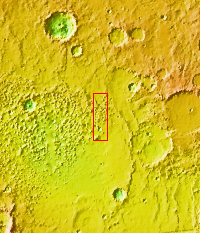
Mare Chronium, Mars:
In Stanley Weinbaum's classic A Martian Odyssey (Wonder Stories, July 1934) Mare Chronium (longitude about 180, latitude 60 South) is where the narrator is about to meet the bird-like Martian, Tweel.
"...I found an easy place, and down I went. Mare Chronium was just the same sort of place as this - crazy leafless plants and a bunch of crawlers; I gave it a glance and hauled out my sleeping bag. Up to that time, you know, I hadn't seen anything worth worrying about on this half-dead world - nothing dangerous, that is..."
Note: I have had some trouble ascertaining online whether it is Mare Chronium or Mare Chromium. I prefer the sound of ChroNium, and today (14.5.2024) was happy at last to find a Mars map (https://britastro.org/wp-content/uploads/2021/07/mars_2005dp_labeled-Damian-map-2.jpg) which spells it that way, despite the many online references with the other name.
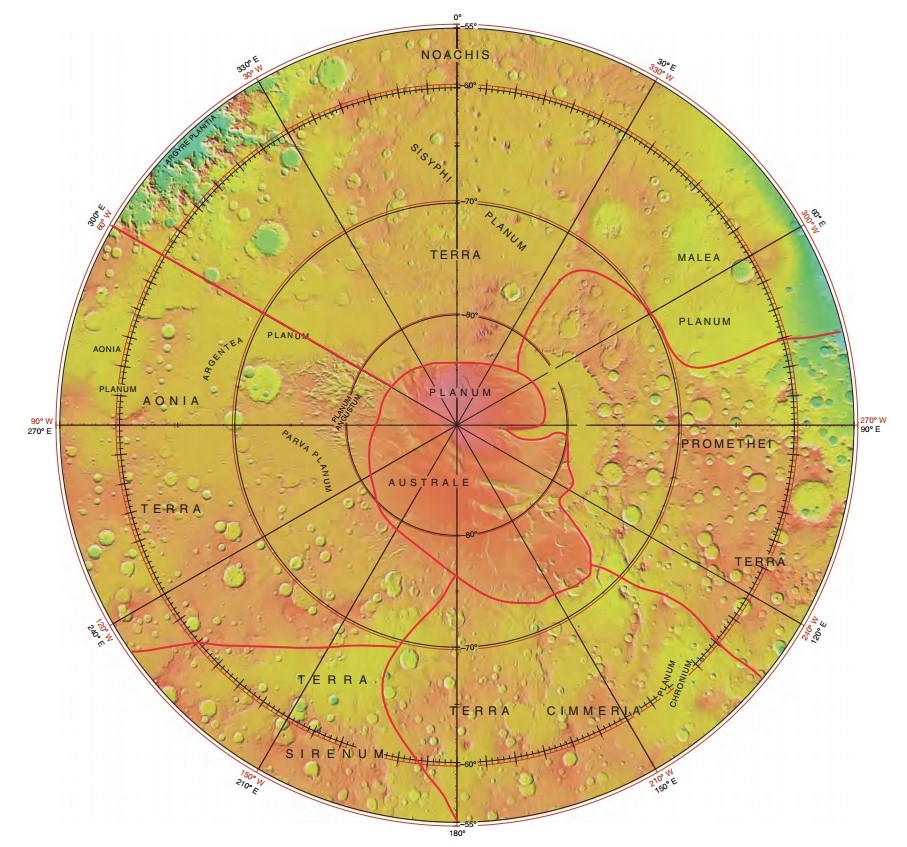 south-polar-centred Mars
south-polar-centred MarsMare Cimmerium:
The landing site of the Ares, the first spaceship to Mars, in Stanley Weinbaum's classic tale A Martian Odyssey (Wonder Stories, July 1934).
Note that on the map shown here Mare Cimmerium is renamed Terra Cimmeria. I assume that this is because the International Astronomical Union decided that "mare" (= sea) was no longer an appropriate term, since we now know there are no seas on Mars, and hence all the maria are now termed "terrae" (lands). (I also assume that the reason the IAU hasn't dared pursue the same policy with regard to our names of features on the Moon is simply that, despite their itch for literalness, they've have to accept that Mare Imbrium, Mare Serenitatis, etc, are too deeply embedded in our culture to be tampered with.)
In Lin Carter's The Man Who Loved Mars (1973) a lost Martian "Treasure City" is rumoured to lie in this region:
...I began idly questioning Keresny as to the site of the so-called Treasure City... Scholars have spent twenty years striving to figure out the peculiar geographical notation employed by the Ancients and have come up with a rough but workable system. The location revealed in the thought-record worked out to south latitude 27.11, east longitude 140.37. That would place the city very deep in the Mare Cimmerium, about equidistant between the two dustlands of Hesperia and Eridania...
"...But an old plateau like the Cimmerium is dangerous. Riddled with fumaroles that create sharp updrafts that could shatter your foils, knock you out of the air. Down below most of the Maria are pockets of natural gas that leak steadily into the atmosphere under terrific pressure..."
Over twelve thousand years in the future, the terrestrial Empire of Linn launches an invasion of Mars as described in chapter 7 of Empire of the Atom (1957) by A E van Vogt:
...Two hundred men per ship - that was the number carried by each transport of the first fleet to leave Earth. Altogether there were five hundred ships. Their destination was the great desert known as Mare Cimmerium. A mile-wide canal cut through the edge of this desert, and for a hundred miles on either side of the canal the desert was forced by green vegetation that fed on the thousands of tiny tributary canals. Oslin, one of the five improtant cities of the Martians was located in a great valley at a point where the canal curved like a winding river...
In another van Vogt classic, The Weapon Shops of Isher (1951), Mare Cimmerium is referred to as a city (p.98):
He explained his plan briefly. The toad would accompany him as hostage. They would go to the nearest airline base and fly to the city of Mare Cimmerium, at which point he would catch a regular liner for Earth. "And if anything should go wrong," Cayle Clark concluded, "at least one person will die before I do."
Nothing went wrong...
John Christopher in Decoy (collected in The Twenty-Second Century, 1954) mentions the Mare Cimmerium sandyacht race - see CLUFFs.
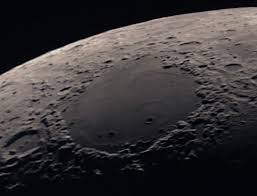
Mare Crisium:
...the great walled plain, one of the finest on the Moon... Three hundred miles in diameter - and almost completely surrounded by a ring of magnificent mountains, it had never been explored until we entered it in the late summer of 1996.
Our expedition was a large one. We had two heavy freighters which had flown our supplies and equipment from the main lunar base in the Mare Serenitatis, three hundred miles away...
Arthur C Clarke, The Sentinel (10 Story Fantasy, Spring 1951)
Reference is made to the Mare in another Clarke tale, the 1961 novel A Fall of Moondust, in which a crank has been pursued for the crime of embezzlement - his motive being to get funds with which to investigate UFO-related issues.
"...Since it makes no difference now, could you tell us what secret you were after? I'm sure we would all like to know."
"...I'll be glad to tell you," answered Radley. "It really starts back in 1953, when an American astronomer named O'Neill... discovered a small bridge on the eastern border of the Mare Crisium.
"Other astronomers, of course, laughed at him - but less prejudiced ones confirmed the existence of the bridge. Within a few years, however, it had vanished. Obviously, our interest had alarmed the Saucer people, and they had dismantled it."
...Presumably, O'Neill's Bridge had been a trick of the lighting, or of the Moon's perpetually shifting shadows - but such a simple explanation was not, of course, good enough for Radley...
>> History of Hopes for the year 1954 (when the media reports of the "bridge" appeared).
Mare Erythraeum:
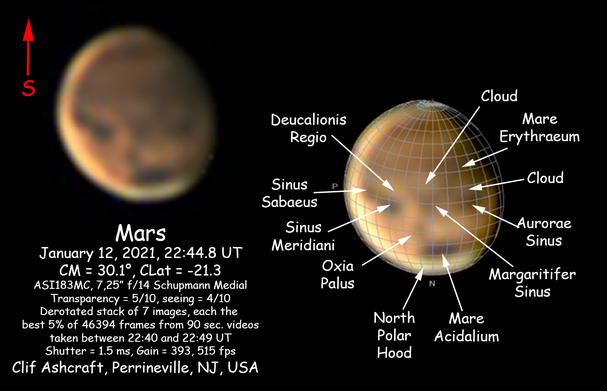
See the page on Primordial Worlds for a reference to the Mare Erythraeum area, from a memorable sight-seeing trip in The Sands of Mars (1951) by Arthur C Clarke.
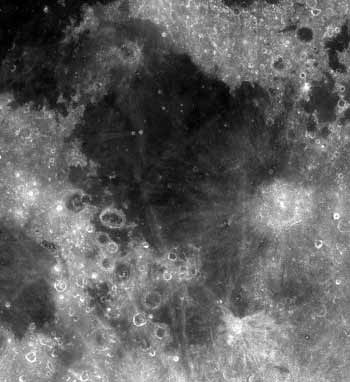
Mare Fecunditatis:
...She stepped to the window; scudding clouds had just uncovered the Moon. It was three days old and Mare Fecunditatis - the roll of hair at the back of the Lady-in-the-Moon's head - was cleared by the Sunrise line. Near the right-hand edge of that great, dark 'sea' was a tiny spot, visible only to their inner eyes - Luna City...
Robert A Heinlein, It's Great To Be Back (Saturday Evening Post, 26 July 1947)
...He picked out the landmarks made familiar to him by a thousand photographs with nostalgic pleasure, as if he were returning to his own country. McIntyre brought her slowly down as they came back around to the Earthward face, and prepared to land east of Mare Fecunditatis, about ten miles from Luna City...
Robert A Heinlein, Requiem (Astounding, January 1940)
My own interpretation of the above two passages is that Luna City stands not on the plain of the Mare itself but just past the edge of it.
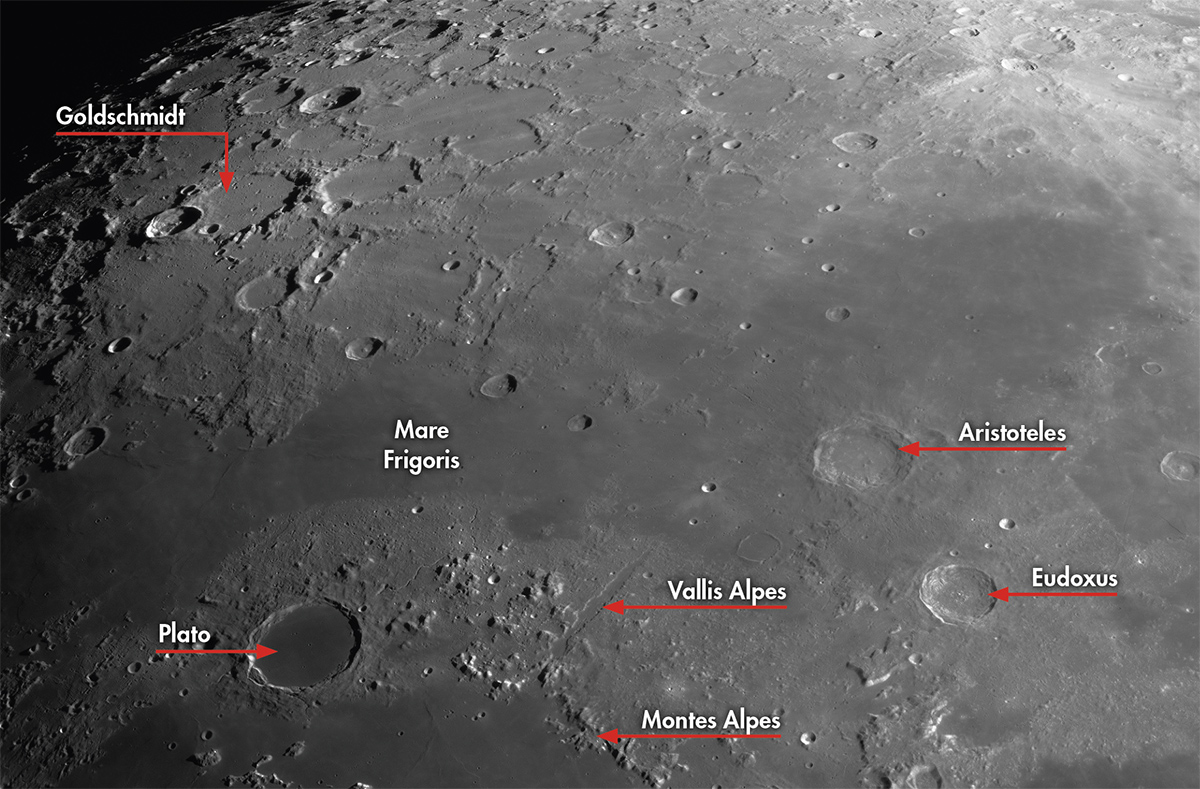
Mare Frigoris:
See The Mare Frigoris Culture, a story of a lunar colony from the time of Leonardo da Vinci, by Robert Gibson.
In Dust Rag by Hal Clement (Astounding Science Fiction, September 1956) some explorers are approaching Plato from the north:
...The course was far from straight, though it led over what passed for fairly smooth territory on the moon. Even back on Sinus Roris the tractor had had to weave its way around numerous obstacles; now well on to the Mare Frigoris the situation was no better, and according to the map it was nearly time to turn south through the mountains, which would be infinitely worse...
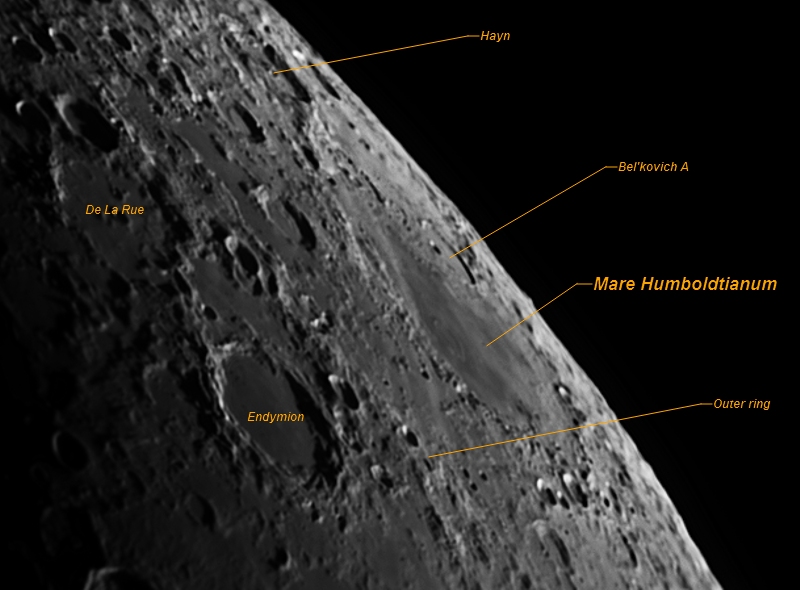
Mare Humboldtianum:
Parrott pointed to the chart. "We're crossing the Humboldt Sea. That means we've covered a lot more than half the journey, and we've only got three or four hundred miles to go. Notice the Earth?"
Robin looked through the observation window. He had been so busy and so tired that he had hardly glanced at the sky, but now he saw that the Earth had changed; it was a three-quarter disk, not half, and it was lower down. "It's darned nearly on the horizon." - from Patrick Moore's Captives of the Moon (1960).
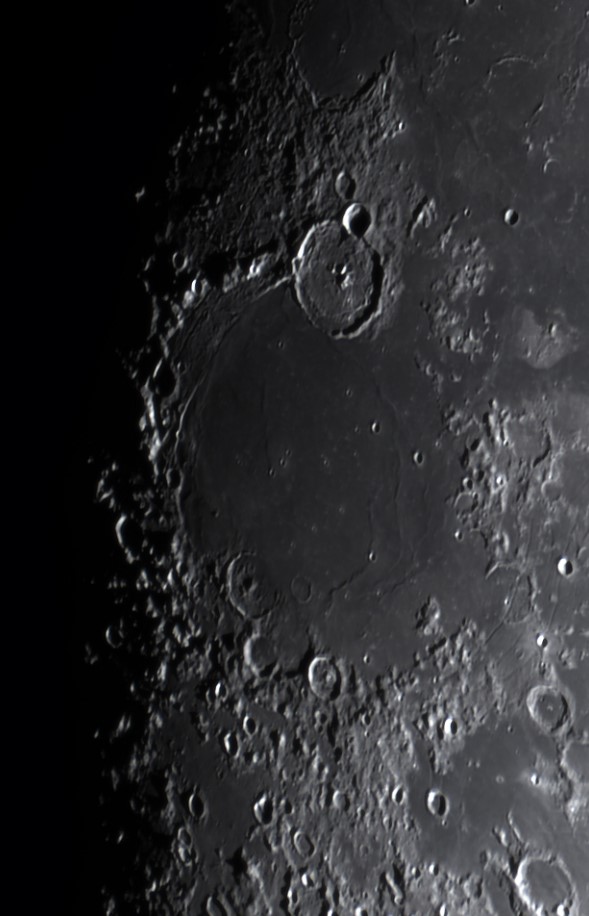
Mare Humorum:
Richard Holmes in his science-history book The Age of Wonder:
How the Romantic Generation discovered the beauty and terror of science (2008) devotes a chapter to "Herschel on the Moon"; he comments on, and quotes, from the astronomer's notebooks.
...puzzling stippled shadows, especially in the Mare Humorum, Herschel believed were enormous "forests", made up of huge, spreading leafy canopies, or at least "large growing substances". Because of low lunar gravity, this gigantic "vegetable Creation" was evidently "of a much larger size on the Moon than it is here". (See the History of Hopes page for the years 1776, 1779 and 1780.)
For R W Mackleworth's Starflight 3000 (1972), see the entry on the crater Hippalus.
Mare Imbrium:
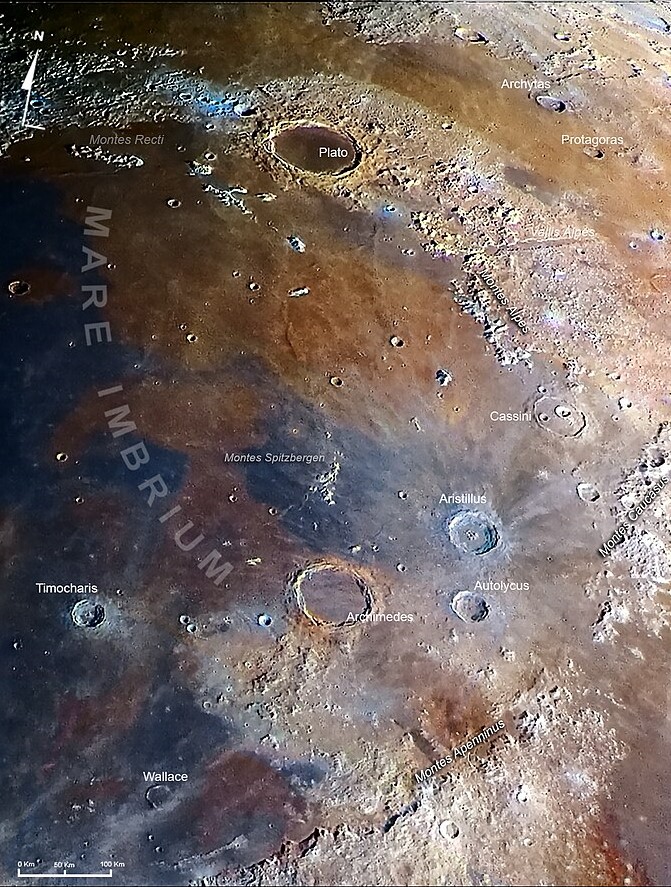
From Arthur C Clarke's first novel, Prelude to Space (written in 1947, published 1951) - the pre-flight presentation in which is revealed the landing-site for the first expedition to the Moon:
"This area is one of the most interesting ones on the Moon, and certainly has the finest scenery, but we can only explore a small region on our first visit. We shall land about here (Next Slide, please), and this is a drawing of the area under the greatest magnification we can use...
"The exact spot for the landing will be decided during the approach..."
See also under Alpine Valley.
In Raymond Z Gallun's Magician of Dream Valley (Astounding Science Fiction, October 1938)
Jack Vickers, newscast reporter, is subjected to a "spell in his brain" and caught up in an attempt of hostile etheric beings to attack the human colony at Imbrium City.
They climbed up the rugged slope, leaving Dream Valley, the haunted, the mysterious, behind them. They moved along the gloomy pass that wound down through the jagged mountains toward the undulating reaches of Mare Imbrium. And all around them, traveling like an escort of ghouls, was a host of Hexagon Lights, their forms changing constantly, their colors shifting from soft rose, through orange, yellow, green and blue, to softest violet, and back again.
Once the two men had reached Mare Imbrium, the going should have been easy and swift. But twelve hours out on its surface, the motor of one of the tractor boots of Jack's armor suffered a breakdown...
Description of the Mare in The Far Look by Theodore L Thomas (Astounding Science Fiction, August 1956) makes the lava plain seem decidedly un-smooth at close quarters:
...The two men led Fowler and McIntosh around to the other side of the spaceship and pointed westward across Mare Imbrium. One of them said, "About half a mile over there behind that rise you'll find the dome. About eight miles south of here you'll find the latest cargo rocket - came in two days ago. The terrain is pretty rough, so you'd better wait a few days to get used to the gravity before you go after it..."
John Christopher's The Lotus Caves (1969) is tantalisingly imprecise on selenography but does contain one reference to the Mare Imbrium, it being in sight of the two youngsters from a moon colony who have borrowed a vehicle to go exploring.
Their course wound on through the foothills. As the sun rose slowly in the sky they were in harsh sunlight more of the time, which meant having to use the dimming blind but also meant that the batteries were kept at full charge. For the most part they saw only the walls of the valley or ravine through which the crawler was travelling, but occasionally there were glimpses of the high dazzling peaks of the mountains and once, from an eminence, a view of the Sea of Rains behind them...
The Mare is mentioned in a tale that is concerned with environmentalism vs. spoilation on Luna: Moon Trash by Ross Rocklynne (Amazing Stories, January 1970):
...Ben Fountain, the engineer who threw up the small pre-fab city on the plains of the Mare Imbrium when Koh-He Chemical won its research rights from the Committee, went through the six-week intensive at Lunar Instruction School like anyone else...
Mare Insularum:
For the highlands on the eastern border of this mare see the entry for Gruithuisen's Lunar City.
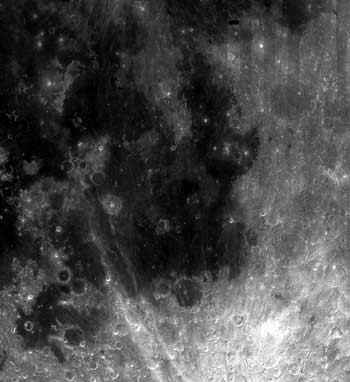
Mare Nubium:
Captain Brunel leads his crew of misfits on a strange expedition here in William F Temple's Shoot at the Moon (1966).
At 15.45 G.M.T. on June 21 the Endeavour made a perfect landing on the Mare Nubium.
...Bill Burton, in his book, praised the masterly landing... but rather spoiled the effect by adding that I had mistaken the map reference. That I'd touched down twenty miles from Bullialdus instead of the same distance from Copernicus, with which I had confused it. He was tactful about it...
From R W Mackleworth's Starflight 3000 (1972):
In less than a day, a day with a few hundred hours and a dozen sleep periods, he would reach the shallow sea they called the Mare Nubium - a sea that was once a dusty plain. Now it was a sea indeed though the water was only twenty feet in depth and in constant and violent movement for the most part...
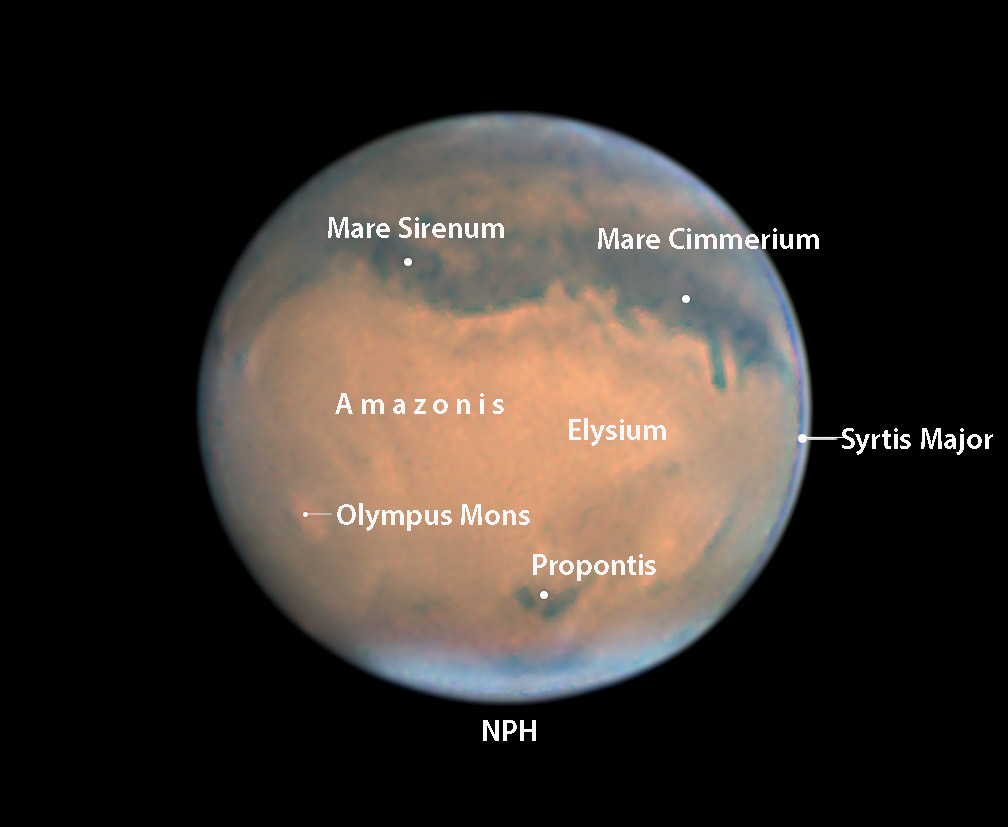 From "Sky and Telescope". South is up.
From "Sky and Telescope". South is up.Mare Sirenum:
...A fast planetfall was of the essence, since every second of time between the moment we broke out of deep space and the moment we hit topsoil we were in constant danger of being noticed on somebody's radar... The glide path took us curving across the midregions of the Mare Sirenum...
The fabric began heating up till the hull would soon be a dull cherry-red. The Sirenum went hissing by beneath us in a rusty-purplish blur, much too hazy for us to make out anything but the largest craters. It was a shame we were going too fast to see the landscape, because this was very historic country. The area we were passing over had been the first chunk of local real estate that we Earthmen had ever gotten a close-up look at, even if it had only been a passing glance. I refer to the history-making Mariner IV fly-by, way back in 1965. The tiny, unmanned craft had skimmed across this same part of the Sirenum with all cameras whirring...
Thus the narrator of Lin Carter's The Man Who Loved Mars (1973), which peculiarly juxtaposes OSS and realism, with a surgically modified Earthman able to breathe on Mars, native humans who are used to the place, and the above reference to factual space-Age observation.
The Mare is also the discovery site of the artefact dubbed the Siren Goddess - see the Clarke tale Trouble with Time, quoted in the Fictional Dates timeline for 2012.
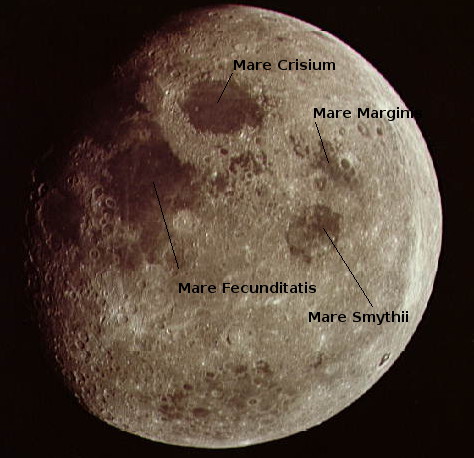 a view you'll never get from Earth
a view you'll never get from EarthMare Smythii:
From one of the articles in Sky & Telescope's "Lunar Notebook" series by Charles A Wood, this one in the May 2001 issue and titled A Privately Held Mare:
...Because Smythii is geologically diverse and situated on the lunar equator and on the limb, geologists Paul Spudis and Lonny Hood have proposed that it would be an excellent location for a lunar base. Landing sites near the lunar equator require minimum-energy trajectories (that's why most of the Luna and Apollo sites were at low lunar latitudes). Any future Moonbase will have to be on the lunar near side to communicate with Earth, but radio astronomers would prefer to see it built on the far side for access to a radio-quiet sky. Spudis and Hood suggested that the solution might be to have the main base at Smythii, right at 0° latitude and 90° East longitude. Because of the Moon's 8° libration in longitude, it would be necessary to have a communication outpost at about 82° East for continuous contact with Earth. However, to keep radio telescopes from being contaminated by reruns of I Love Lucy, an observatory outpost would have to be 8° over the limb on the far side.
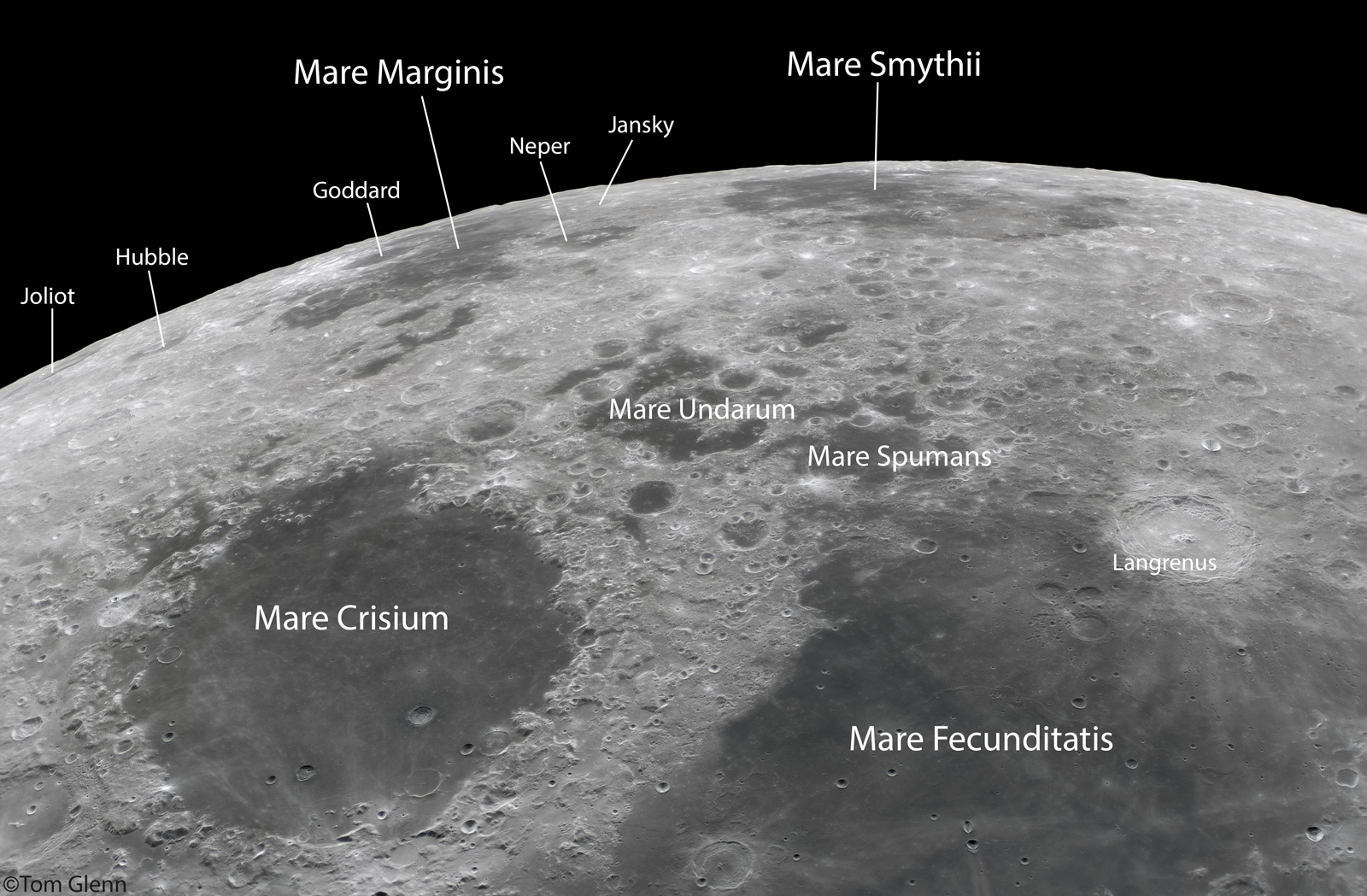
Mare Undarum:
The site of one of the capapults used in the Lunar War of Independence (or Lunar Revolutionary War) of 2076, narrated in Robert Heinlein's The Moon is a Harsh Mistress (1966); the site is mentioned on pages 228 and 241. Mike the talking computer was a bit slow to deted Earth's attack on Lunar City -
...He would have been able to see it a few seconds sooner had he been looking eastward with new radar at Mare Undarum site...
(The narrator uses a form of heavily Russified English, hence the lack of the definite article.)
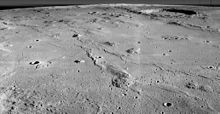
the Marius Hills:
This region, with its distinctive volcanic domes, would have been a likely destination for the cancelled Apollo 19 mission - see Lost Moon: Reconstructing the Missions of Apollos 18, 19, and 20 (Part 2). The article says of the Hills,
There is nothing else like them on the lunar surface; they represent a unique chapter in the Moon’s volcanic history. From the Command Module in close orbit, they would have been eerily beautiful to behold. For the moment, they must rest in the aura of might-have-been.
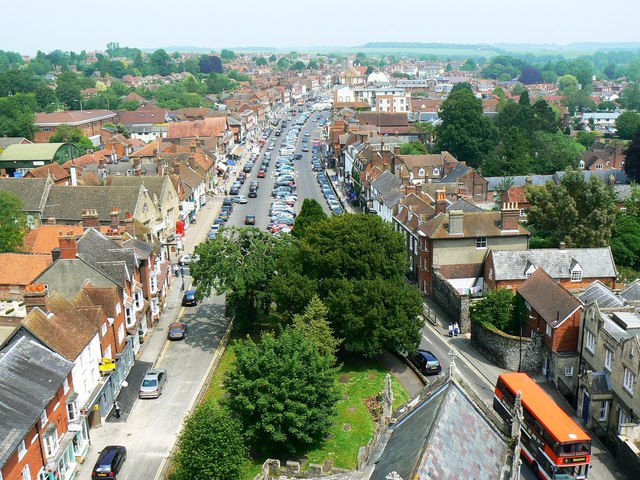
Marlborough, Wiltshire, England:
Set in a future in which the Earth has undergone violent geological upheaval, John Christopher's Beyond the Burning Lands (1971) has a scene set in Marlborough where visitors find the inhabitants to be temperamentally influenced by their town's proximity to a barrier of volcanoes.
That night when they feasted us they unbent somewhat but not much. Their eyes watched us and each other. I thought I understood them better then, because though the Great Hall was hung with lamps they were scarcely wanted: so bright was the glow that came in at the windows. The hills rose above the town and above the hills the sky was red, a heavy crimson from which now and then spouted gouts of orange flame. Seeing this I realized that darkness, which they never truly knew, could be a comforting and friendly thing. They lived their lives under this ominous light and it was small wonder they were soured by it. And there were ugly sounds as well - distant foreboding rumblings as the earth growled in pain.
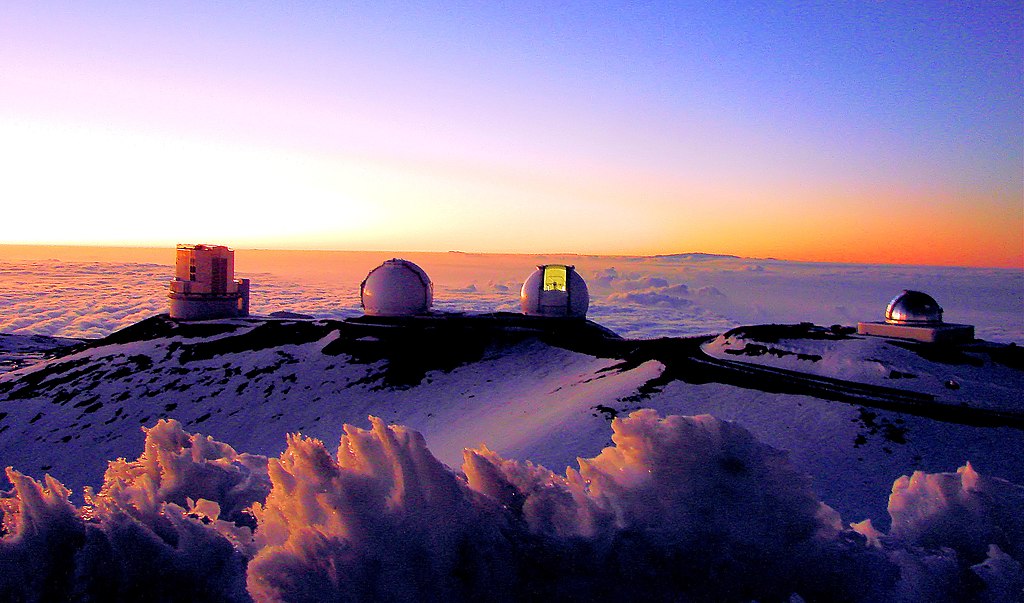
Mauna Kea, Hawaii, USA:
..."Regulations. Acclimatization. It's nearly fourteen thousand feet at the top. Pretty thin air... It's not easy to do anything, even walk, until you get used to it."
By the time they reached the clapboard barracks buildings she was ready to agree.
...There were half a dozen observatories on the lip of the volcano. Richard parked the Jimmy in front of the NASA building. It looked like an observatory in a Bugs Bunny cartoon: a square concrete building under a shiny metal dome.
"Do I get to look through the telescope?" she asked.
He didn't laugh. Maybe he had answered that one too often. "No one looks through telescopes anymore. We just take pictures." He led the way inside, through bare-walled corridors and down an iron stairway to a lounge furnished with chrome-steel office tables and chairs...
From Footfall (1985) by Larry Niven and Jerry Pournelle.
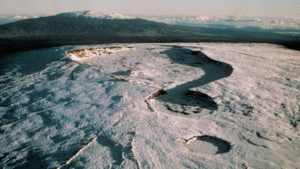 the summit caldera
the summit calderaMauna Loa, Hawaii, USA:
Her companion nodded and pointed toward the slopes off to their right. "Mauna Loa. They said it's terrible luck to take any of the lava home."
"Who says?"
"The Old Hawaiians, of course. But a surprising number of tourists, too. They take the stuff home, and later they mail it back." He shrugged. "Bad luck or no, so far as anyone knows, she - Mauna Loa is always she to the Old Ones - she's never taken a life."
from Footfall by Larry Niven and Jerry Pournelle (1985)
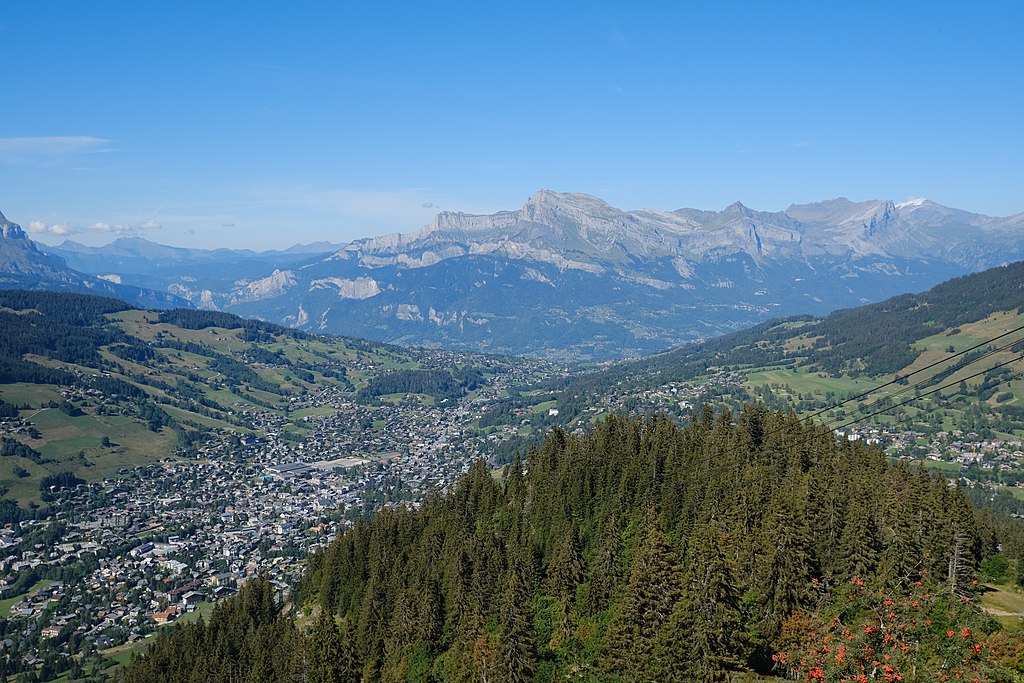
Megève, Haute-Savoie, France:
In the future history The Shape of Things to Come (1933) by H G Wells, this ski-resort town was where the World Council met to dissolve itself in 2059 - this act being the demonstration of the achieved lucidity of the human race; a witness to the complete solidarity of mankind in 2059, the disappearance of the last shadows of dislike and distrust between varied cults, races and language groups... No further need, therefore, of a World Government.
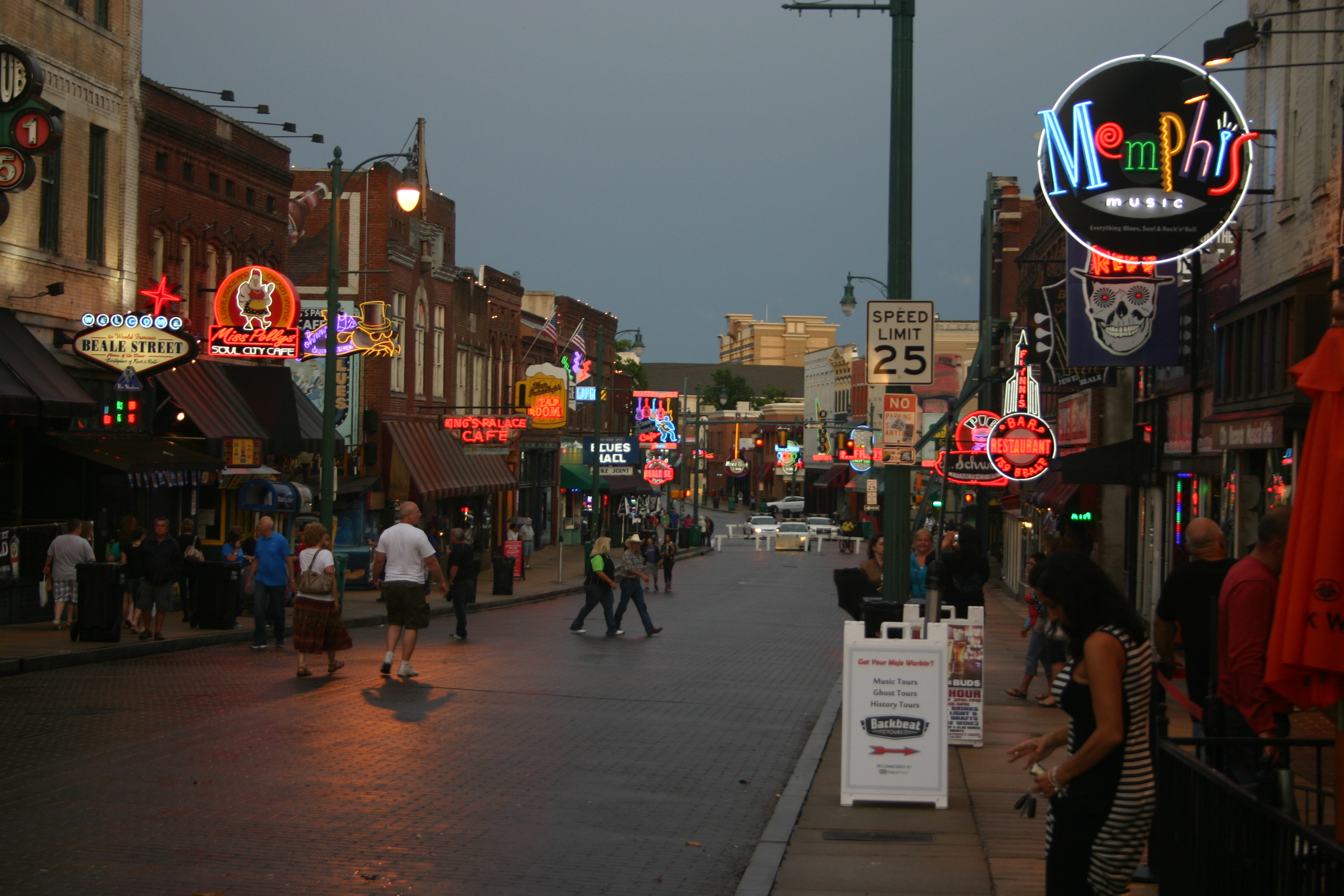 Beale Street, 2014
Beale Street, 2014Memphis, Tennessee, USA:
A few centuries in the deindustrial future, in John Michael Greer's 2014 novel Star's Reach, a "ruinman" - who makes his living from the excavation of material from our era - comes to "Memfis", which he finds is
...rich from the river trade, rich from the ships that come there from all over Mem Gaia's round belly, rich from the seafood out of Benroo Bay, rich from the farms and orchards, and... good unstripped ruins from within reach of the Memfis ruinmen. It's rich even compared to other rich towns in Meriga, and let's not even talk about what it looks like to a farmer's child like me from the Tenisi hill country...
Messier A: >> History of Hopes
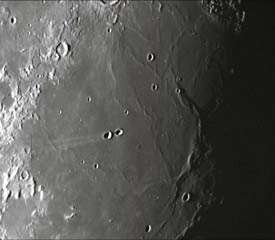 Note the streaks: a feature which Franz von Gruithuisen claimed was artificial. See "Messier on the Moon" by Charles A Wood, in "Sky & Telescope", November 2000, page 126.
Note the streaks: a feature which Franz von Gruithuisen claimed was artificial. See "Messier on the Moon" by Charles A Wood, in "Sky & Telescope", November 2000, page 126.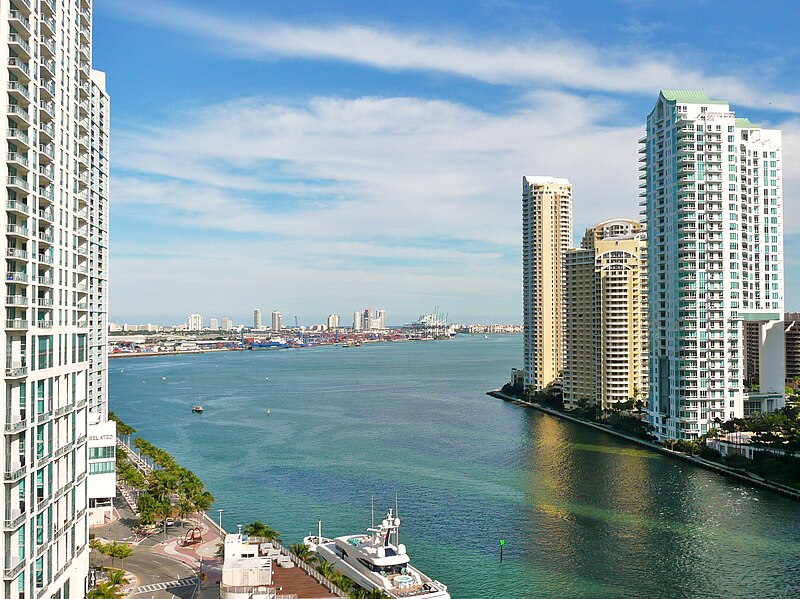 No sign of Earthport yet, but give "Miami, Fla." time to evolve via "Miamifla" to "Meeya Meefla"...
No sign of Earthport yet, but give "Miami, Fla." time to evolve via "Miamifla" to "Meeya Meefla"...Miami, Florida, USA:
By the far-future days described by Cordwainer Smith in The Dead Lady of Clown Town (Galaxy, August 1964), just one place-name from Old Earth survives, in evolved form.
Go back to An-fang, the Peace Square at An-fang, the Beginning Place at An-fang, where all things start. Bright it was. Red Square, dead square, clear square, under a yellow sun.
This was Earth Original, Manhome itself, where Earthport thrusts its way up through hurricane clouds that are higher than the mountains.
An-fang was near a city, the only living city with a pre-atomic name. The lovely meaningless name was Meeya Meefla, where the lines of ancient roadways, untouched by a wheel for thousands of years, forever paralleled the warm, bright, clear beaches of the Old South East...
Convulsions in Earth's crust in 1990 have left the city still in some sort of order the following year in Keith Laumer's 1966 thriller Catastrophe Planet:
...Early afternoon brought me into Miami. The beach was wiped clean - a bare sandbar, but the city proper still gleamed white beside a shore stained black by pumice and scum oil, and heaped with the jetsam of a drowned continent. Conditions were better here. There had been no major quakes to judge from the still-standing towers of coral and chartreuse and turquoise; maybe their hurricane-proof construction had helped when the ground shook under them. There was even a semblance of normal commerce. Police were much in evidence, along with squads of nervous-looking Guard recruits weighed down with combat gear. Lights were on in shops and restaurants, and the polyarcs along Biscayne were shedding their baleful light on an orderly traffic of cars, trucks and buses. There were fewer people on the streets than in normal times, but that suited me...
The last young woman alive in the world, a singer who now sings alone, lives in an apartment in Miami, in Eddie For Short by Wallace West (Amazing Stories, December 1953):
...But the street lights, as well as the Nemo signal on the orchestra stand, remained faithful. At dusk, electric eyes turned on the tall standards bordering the boulevards and Biscayne Bay. They switched on the proud Cadillac signs and the glow in grimy store windows. And at dawn they extinguished them all in thrifty fashion...
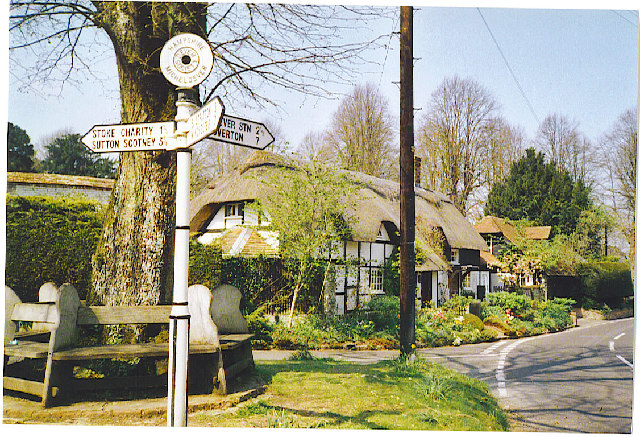
Micheldelver, Hampshire, England:
Recently returned after several years abroad, Dr Queston is not yet accustomed to the localism and topophilia taking hold of the country, a result of the Planetary Intelligence emerging in Susan Cooper's novel Mandrake (1964):
...You never liked London, said the thing in his mind, gently insistent: a pity to go on a day like this, a pity to leave home...
It was like pushing against gravity. Queston shook his head violently...
On the way, brooding over his reactions, he decided to go by train; there could be no wandering off the route then, or freak decisions to turn back for home. He made for Micheldelver, a small station on the London line, and left the Lagonda in the yard. The station was deserted, and he had to shout before an ancient, creaking little man, surly and muttering, emerged from some hidden depths; even then, before he could buy a ticket, the old man had to shuffle away to fetch the booking-office key. When the ticket was handed over at last, suspicion trickling out with it through the grimy window, it cost at least three times as much as Queston remembered for journeys of that length two years before...
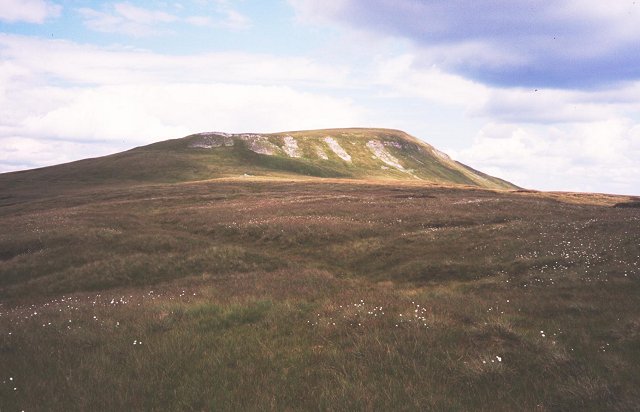 2,585 feet. Highest point in Yorkshire.
2,585 feet. Highest point in Yorkshire.Mickle Fell, Yorkshire, England:
In the unique time-mixing novel by Fred Hoyle, October the First is Too Late (1966), the composer-narrator relates how his physicist friend John Sinclair inexplicably disappears for a while after they have been walking on Mickle Fell. What seems like a bout of amnesia on the part of Sinclair turns out later in the book to have wider implications, part of a manipulation of the world by a super-intelligent cosmic power.
Middletown, Ohio, USA:
 a panorama taken about 1915 - a bit too early but a lot closer to the book's publication date than we are now
a panorama taken about 1915 - a bit too early but a lot closer to the book's publication date than we are nowThe site of an advanced weapons research unit (at which Kenniston, the protagonist, secretly works), Middletown suffers a direct hit from a nuclear weapon in Edmond Hamilton's 1951 novel City At World's End. The sky seems to split open but the town, amazingly, is not destroyed -
He ought to be dead. He thought it very probable that he was dying right now, which would explain the fading light and the ominous quiet... He looked down Mill Street. He expected to see pulverized buildings, smoking craters, fire and steam and devastation. But what he was was more stunning than that, and in a strange way, more awful.
He saw Middletown lying unchanged and peaceful in the sunlight.
The first few chapters tell how the bewildered townsfolk learn to fact the fact that their home has been catapulted through time into a far-future, moribund Earth, and that there is no going back; though eventually they also learn that the cold world can be revived...
See Life matching Art.
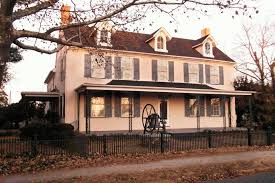 I'd rather have had a street view but this is better than nothing.
I'd rather have had a street view but this is better than nothing.Millville, Wisconsin, USA:
...The town lay dusty and arrogant and smug beyond all telling and it sneered at me and I knew that I had been mistaken in not leaving it when I'd had the chance. I had tried to live with it for very love of it, but I'd been blind to try. I had known what all my friends had known, the ones who'd gone away, but I had closed my mind to that sure and certain knowledge: there was nothing left in Millville to make one stay around. It was an old town and it was dying, as old things always die. It was being strangled by the swift and easy roads that took customers to better shopping areas; it was dying with the decline of marginal agriculture, dying along with the little vacant hillside farms that no longer would support a family. It was a place of genteel poverty and it had its share of musty quaintness, but it was dying just the same, albeit in the polite scent of lavender and impeccable good manners...
And then comes the amazing force-field around Millville! All Flesh is Grass (1965), an unforgettable alien-contact tale by Clifford D Simak, is a novel to re-read every few years.
The town it describes seems so archetypal that I was recently surprised and delighted to find that it actually exists. Not only that: it was the place where Simak was born, on 3rd August 1904.
However, it's darned difficult to find a photographic vista of Millville. While searching, I found a possible reason for this: the population at the last
count had shrunk to about 90 people! Simak would not, perhaps, have
been surprised.
The town is mentioned in another great Simak novel, Way Station (1964), the title of which refers to a secret stop-over station for interstellar matter-transmission set up with alien help in rural America in 1866. About a century later an Intelligence agent gets wind of the fact that something is going on, and seeks scientific advice:
"All right, then," said Hardwicke, "let's start over once again and take it piece by piece. You say you have this man..."
"His name," said Lewis, "is Enoch Wallace. Chronologically, he is one hundred and twenty-four years old. He was born on a farm a few miles from the town of Millville in Wisconsin, April 12, 1840, and he is the only child of Jedediah and Amanda Wallace. He enlisted among the first of them when Abe Lincoln called for volunteers..."
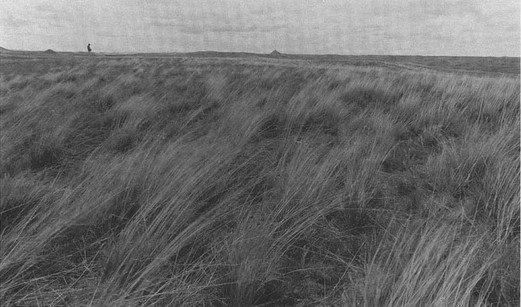
Montana, USA:
My idea of this state came originally from reading Patrick Tilley's Fade-Out (1975), a novel of extraterrestrial visitation. I read it in the late 1970s and ever since then a mention of Montana has conjured in my mind the image of an alien epiphany. Somehow the locale is so appropriate:
North of Miles City, the land is known as 'The Big Open'. Bare, rolling, high plains country with as few trees as there are people. For mile after mile on either side of the two-lane hog-backed highway, there is nothing but endless stretches of buffalo grass and sage. Cattle country, scarred here and there by poisonous salt pans, and the intertwined, weathered clusters of gumbo and sandstone buttes that make up the eastern Montana badlands...
Montes Recti - see the Straight Range.
Morbihan, Brittany, France:
A monstrous extraterrestrial peril haunts Chateauverne, a village in the department of Morbihan, in Eric Frank Russell's The Sin of Hyacinth Peuch - published in the collection Dark Tides (1962):
...To look at Chateauverne today you would find it difficult to believe that not so long ago its inhabitants feared to walk in darkness...
Chateauverne is a cluster of terra-cotta-roofed houses hugging a cobbled square where Hyacinth Peuch, the local imbecile, slumbers among the hogs and chickens. At one side rises the solemn-belled tower of the Eglise. Next to it sits the hoary home of the Abbé and the general store of the Widow Martin. At the opposite side, shading the seated cynics, is the long, low auberge of Jean-Pierre Boitavin, whose brother Baptiste was the fourth to be slaughtered before the rain came...
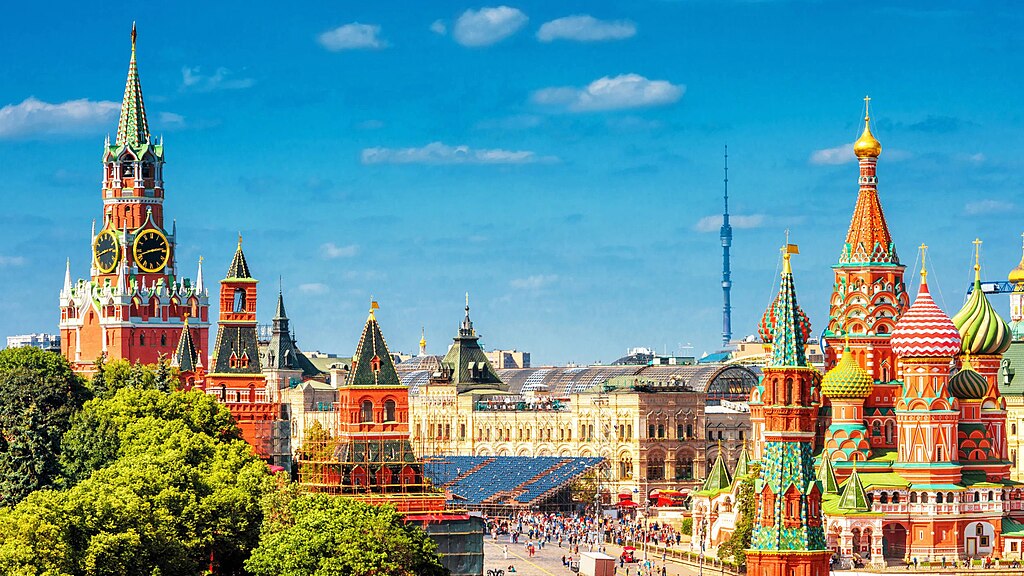
Moscow, Russia:
The opening scene of Fred and Geoffrey Hoyle's novel The Incandescent Ones (1977) takes place in Moscow University in the 23rd century.
...Instead of working on the steady droplet principle of an American shower, all the water came down on your head in a simple deluge, operating in the manner of a flush lavatory. You simply stood underneath a hole, pulled a piece of string, and down it all came - cold.
I was still gasping by the time I'd dressed, but at least I was fully awake and prepared for the day. Arriving early at the canteen safely ensured my securing a piece of bread and a bowl of sour milk. Ten minutes later I was on my way to Professor Orlov's lecture, arriving eventually at the twenty-seventh floor, after the usual cattle-truck exercise on the elevators...
Mount Erebus, Antarctica:
Tom Fiske, future astronaut, gets his break when disaster almost strikes, in chapter 5, "Personnel", of Fred and Geoffrey Hoyle's Fifth Planet (1963):
...He survived the course and got the first break of his life by being sent to winter at the Mount Erebus station in Antarctica... On the way back to base camp the following spring he and three other colleagues were overtaken by a series of furious storms... They managed to make base, but only after a desperate struggle. The doctor who examined Tom was first astonished and then suspicious. His condition when compared with that of the other three men appeared to be too good... The computer delivered its report; Tom was well within the range of physical and mental characteristics required for a candidate for space school...
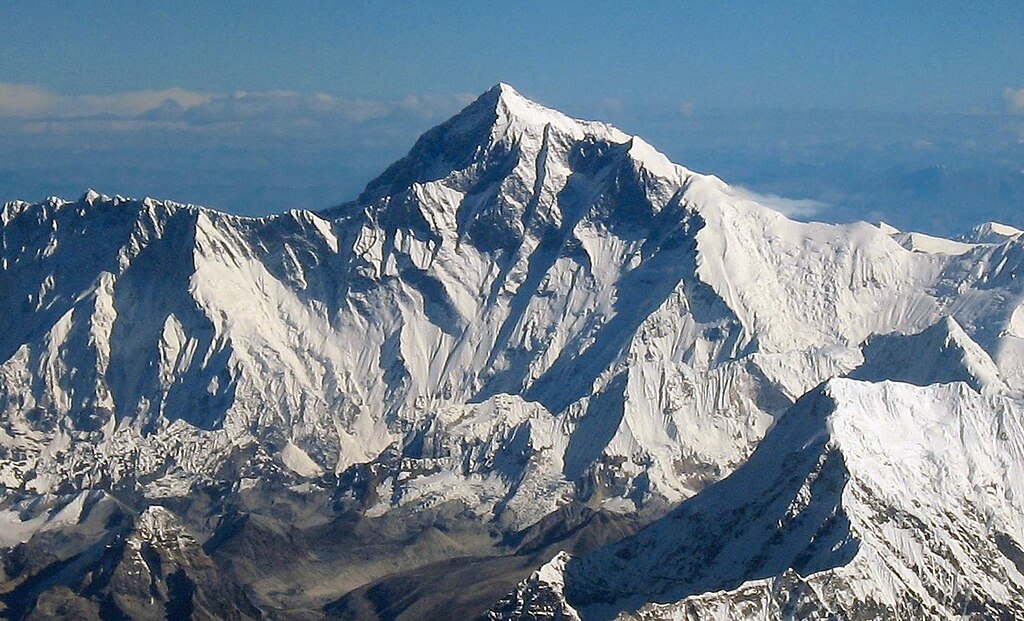
Mount Everest, China/Nepal border:
From Wolfbane (1959), a haunting classic by Frederick Pohl and Cyril M Kornbluth:
...a Pyramid squatted sullenly on the planed-off top of the highest peak of the Himalayas.
It had not been built there. It had not been carried there by man or man's machines. It had come in its own time for its own reasons...
Its fellow Pyramids, on the intruder-planet which was now Earth's binary, have stolen Earth from its solar system and pulled it out into interstellar space. Earth is now heated inadequately by the Moon which has been turned into a sun that flares up every five years. Nobody knows the Pyramids' true nature or purpose. But everybody has to adapt to the conditions they have created...
In Donald Wandrei's tale Colossus (Astounding Stories, January 1934) - written long before Everest was climbed for real - we read:
...Not so many years ago that peak had been unclimbed, almost unknown, a challenge to man. Wintry gales tore across this top of the world, and cold rivaled precipices to defeat assault. The bitter winds still blew, but a man-made tower rose higher than the old peak, and a landing field which was a triumph of engineering audacity and genius stretched over sheer space beside the tower...
Mount McKinley, Alaska, USA: see Denali
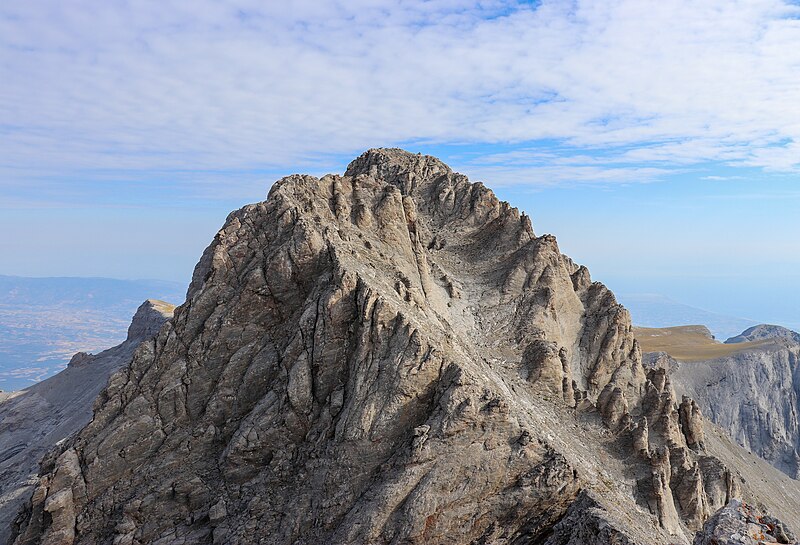
Mount Olympus, Greece:
The Immortals, Anton and Vera York, approach the legendary peak in part 3 of Eando Binder's tale about immortal Atlantean mischief-makers, The Three Eternals (Thrilling Wonder Stories, December 1939):
..."Look!" York pointed. "That large hollow to the left. Notice the shimmer over it?..."
He lowered the ship cautiously until it was no more than a hundred yards over the strange, quiescent mist that did not stir in the wind. Still nothing could be distinguished beyond it save vague shadows and lights...
Mount Rushmore, South Dakota, USA:
See the short story Pilgrimage by Nelson S Bond (original title, The Priestess Who Rebelled, Amazing Stories, October 1939).
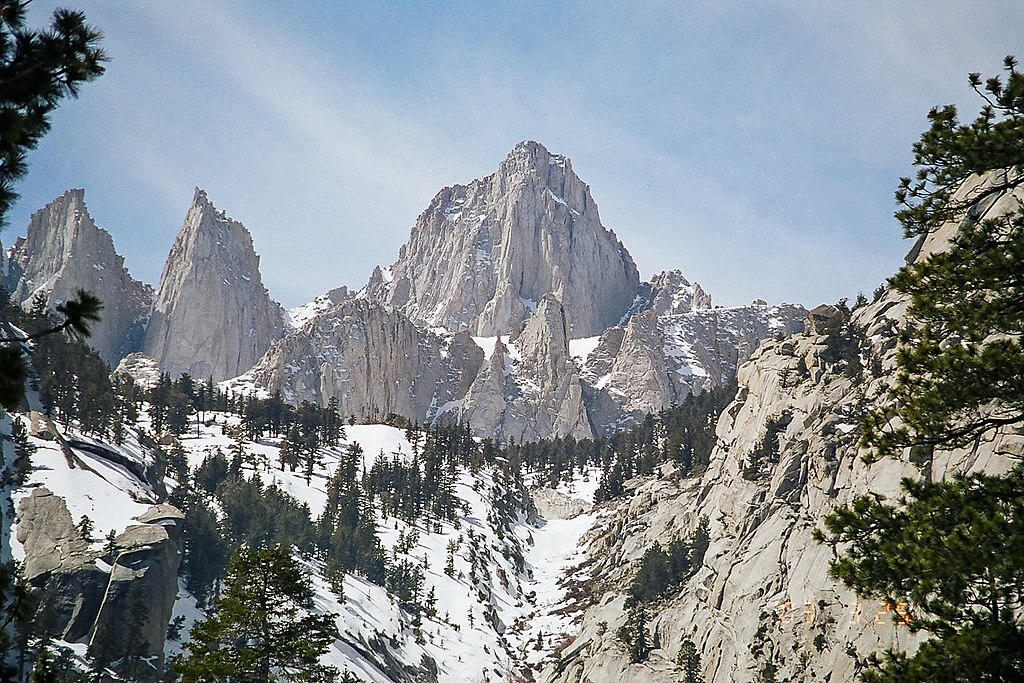
Mount Whitney, California, USA:
The opening passage of Jack Vance's 1958 novel Slaves of the Klau describes the Terrestrial home of a visitor from space who is (culturally though not biologically) alien. The home has been chosen for its remoteness and inaccessibility:
Markel, the Lekthwan, occupied a strange and beautiful dwelling on the highest crag of Mount Whitney, consisting of six domes, three minarets, and a wide terrace. The domes were formed of almost clear crystal, the minarets were white porcelain-stuff, the surrounding terrace was blue glass, and in turn was surrounded by a rococo balustrade with blue and white spiral stanchions...
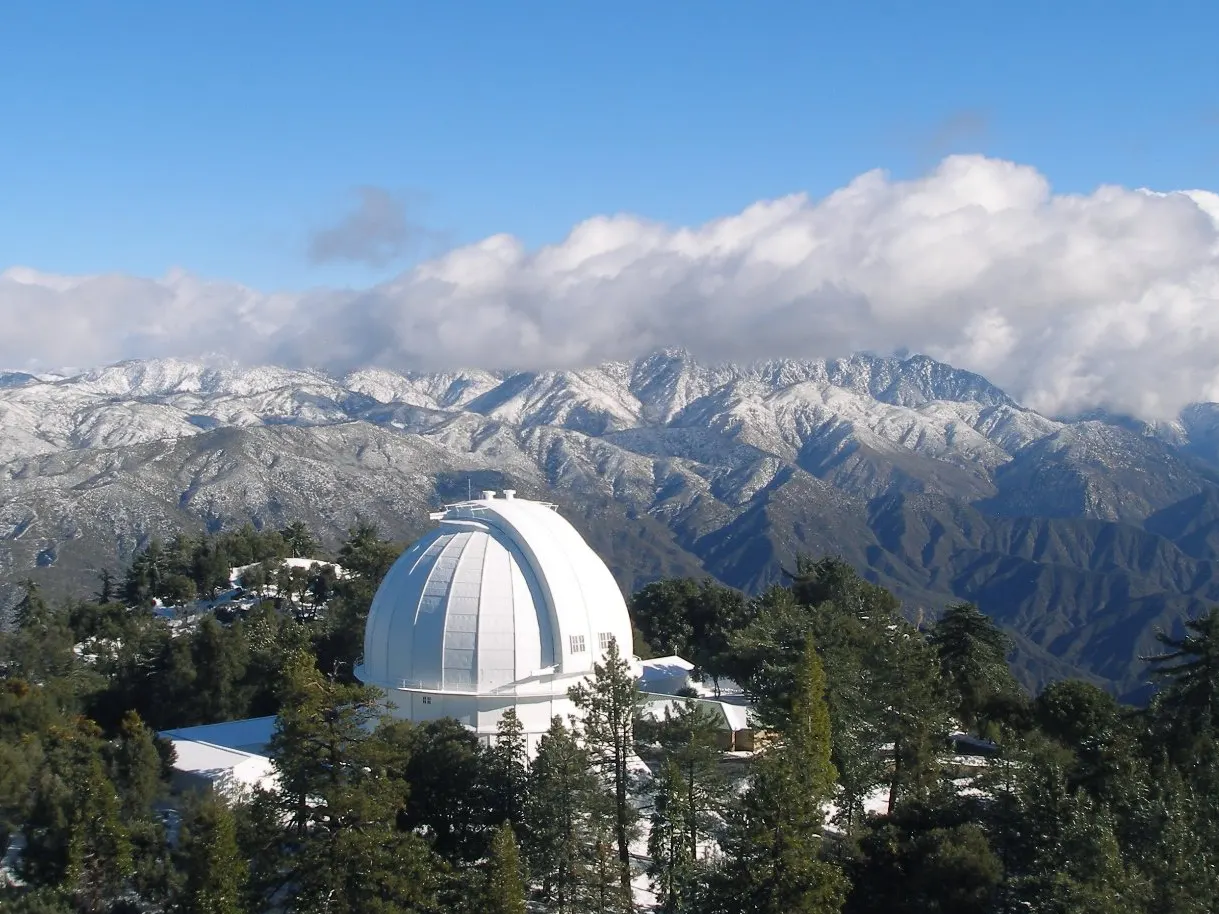
Mount Wilson Observatory, California, USA:
Confirmation of the discovery of The Black Cloud - in the eponymous novel by Fred Hoyle (1957) - is achieved at Mount Wilson (though the original discovery plates were taken at Mount Palomar):
"...as I couldn't see anything wrong with the plates, the obvious thing was to take some new pictures. If a month made all that difference between Jensen's first plate and his second, then the effect should have been easily detectable in a week... So I rushed up to Mount Wilson, bullied Harvey off the 60-inch, and spent the night photographing the edges of the cloud. I've got a whole collection of new slides here... Put them through one by one, Bert, and keep referring back to Jensen's plate of 7 January."
There was almost dead silence for the next quarter of an hour, as the star fields on the edge of the cloud were carefully compared by the assembled astronomers. At the end Barnett said:
"I give up. As far as I'm concerned there isn't a shadow of a doubt but that this cloud is travelling towards us."
Naples, Italy:
...Another half day's run over shoal water brought me into Naples harbor, still solidly at sea level under a blanket of smoke through which the glare of Vesuvius was only a bright haze. Wearing my respirator now, I tied up at three P.M. in darkness like an eclipse, within half an hour had sold my rig - no questions asked - to a quick-eyed man who looked like a Martian in an antique gas mask and the filthiest white suit on the planet. The deal was not good, but I got what I needed - a fairly sound-looking late model Turino ground car. I would have preferred to store the boat, but property not under armed guard was an ephemeral thing in Naples in the best of times... Keith Laumer, Catastrophe Planet (1966), p.87
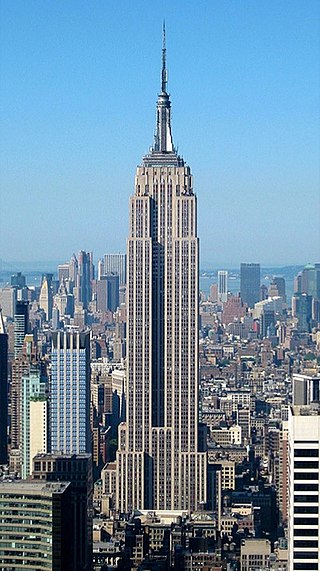
New York City, New York, USA
(and see also entries for: Central Park - Fifth Avenue - Manhattan):
Some key characters in Poul Anderson's eucatastrophic novel Brain Wave (1954), in which all neural impulses on Earth are abruptly boosted by the Solar System's exit from an "inhibitor field", witness the social and political transformations in their work-place in the city, consequent upon the sudden increase in human intelligence (while elsewhere, in the countryside, other characters experience the results of increases in animal intelligence too). Already, in Chapter One,
...He noticed vaguely that the train was quieter than ordinarily. People were less hurried and unmannerly, they seemed thoughtful. He glanced at the newspapers, wondering with a gulp if it had started, but there was nothing really sensational - except maybe for that local bit about a dog, kept overnight in a basement, which had somehow opened the deep freeze, dragged the meat out to thaw, and been found happily gorged...
By Chapter Six, researcher Pete Corinth can see that the city is
...sliding swiftly towards disruption and death.|
Only a few subways were running, an emergency system manned by those devoted enough to stay by a job which had become altogether flat and distasteful. The stations were hollow and dark, filthy with unswept litter, and the shrieking of wheels held a tormented loneliness. Corinth walked to work, along dirty streets whose traffic had fallen to a reckless fragment of the old steady river...
In Chapter Ten he reflects:
...Big cities had no real economic justification. He came from a small town, and he had always loved mountains and forests and sea. Still, there was something about this brawling, overcrowded, hard, inhuman, magnificent city whose absence would leave an empty spot in the world to come...
You get a more jaundiced view of the city in Frederick Pohl's The Merchants' War (1984):
New York, New York. What a wonderful town! All my fretful annoyances were submerged... Ten years didn't seem to have changed the tall buildings that disappeared into the gray, flaky air. The cold, gray, flaky air. It had gone winter again; there were patches of dirty snow in corners, and an occasional consumer furtively scooping them up to take home to avoid the freshwater tax. After Venus, it was heaven! I gawked like a Wichita tourist at the Big Apple. I walked like one, too, bumping into scurrying pedestrians, and things worse than pedestrians. My traffic skills were gone. After the years on Venus I just wasn't used to civilized ways. There was a twelve-pusher pedibus here, three cabs competing for one gap in the flow there, pedestrians leaping desperately between the vehicles all over...
New York City is dark and cold after the Earth has ceased to rotate, in Leigh Brackett's novella Citadel of Lost Ages (Thrilling Wonder Stories, December 1950):
...He looked out across the white river, across white snow and reaches of gleaming ice to the island city lying silent under the stars and the black sky.
There was no light in that city now but the cold shining of the Moon. No voice spoke but the voice of the wind. Yet even in death the grandeur was not gone from it. The shattered towers stood up proudly from the ice that shrouded them.... New York was not a city. It was a dream of titans and the destruction of half a world had not effaced it...
New York City, surrounded by an antigravity "spindizzy" field, has left the Earth and is flying through interstellar space in James Blish's A Life For the Stars (1962); it is seen by newcomer Chris deFord who is being swapped from another flying city, Scranton:
The sight from the gig was marvellous beyond all imagination: an island of towers, as tall as mountains, floating in a surfaceless, bottomless sea of stars...
The greatest discovery of all time is made in NYC, in Alfred Bester's 1953 tale Disappearing Act (Star Science Fiction no.2):
In March of A.D. 2112 the war came to a climax and the American Dream was resolved, not on any one of the seven fronts where millions of men were locked in bitter combat, not in any of the staff headquarters or any of the capitals of the warring nations, not in any of the production centres spewing forth arms and supplies, but in Ward T of the United States Army Hospital buried three hundred feet below what had once been St Albans, New York...
Great geographical and climatic change has come to the site of New York City by 15,000 A.D. in An Adventure in Futurity (Wonder Stories, April 1931) by Clark Ashton Smith:
"Now," said Kronous, "we are on my country estate near Djarma, the present capital of Akameria. Djarma is built on the ruins of the site of New York, but is hundreds of miles inland, since there have been extensive geologic changes during the past 13,000 years. You will find that the clilmage is different too, for it is now sub-tropical..."
...Walking slowly amid the changing scenes of a metropolis has always been a sourse of unending fascination for me. And of course, in this unfamiliar city of the future, where all was new and different, the lure of such wanderings was more than doubled. And the sensations of knowing that I trod above the ruins of New York, separated from my own period bu 13,000 years with their inconceivable historic and telluric vicissitudes, was about the weirdest feeling that I had ever experienced...
Vehicles were used, of a light, noiseless, gliding type without visible means of propulsion; and there were many air-vessels which flew deftly and silently overhead and discharged their passengers on the roofs or balconies of the high buildings. And the landing or departure of great, shining ether-ships was an hourly occurrence...
Both sexes and all ages were attired in gaily colored costumes. I was impressed by the practical absence of noise, tumult and hurry; all was orderly, tranquil, unconfused. From the scarcity of women in the crowd, I realized how true were the racial fears expressed by Kronouos. The women whom I saw were seldom beautiful or attractive according to 20th Century standards; in fact, there was something almost lifeless and mechanical about them, almost sexless.
It was as if the sex had long reached the limit of its evolutionary development and was now in a state of stagnation or virtual retrogression...
Greenwich Village, Lower Manhattan, is where young physics-genius Lucas Martino comes to work in his uncle's coffee house in 1966, in Who? by Algis Budrys (1958).
...the tourist area of Greenwich Village had spread down to include the block where Lucas Maggiore had started his coffee house when he stopped wrestling sacks of roasted beans in a restaurant supply warehouse. So now there were murals on the walls, antique tables, music by Muzak, and a new I.B.M. electric cash register...
From a future age in which time-travel can be employed as a punishment, the condemned mass-murderer in John Christopher's Sentence of Death (The 22nd Century, 1954) finds that he has been exiled to the most horrid place and time that his judges can think of:
...A street, and unbelievably congested traffic... He felt in his pocket, and found coins. He handed one across the counter, and took one of the papers. His fingers were trembling as he looked at it.
The paper was the New York Herald Tribune. The year was 1954.
People turned to look at him as he began to scream.
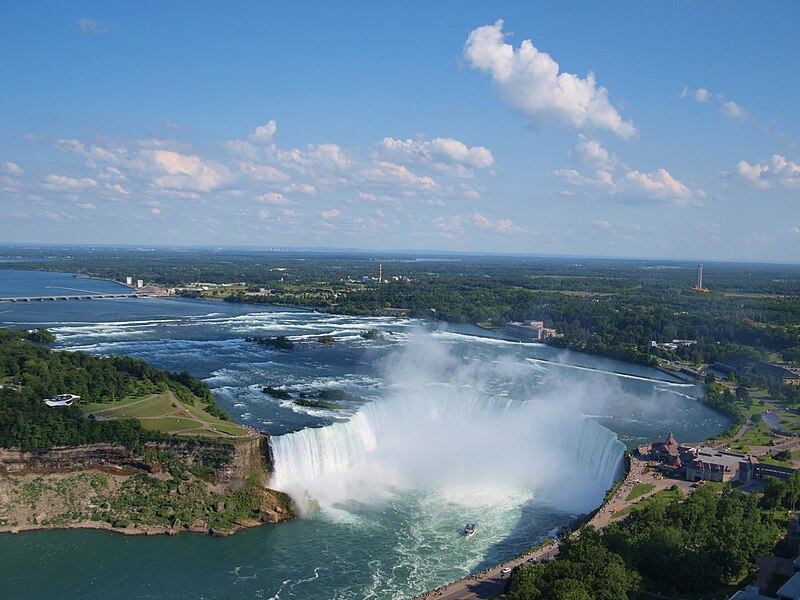
Niagara Falls, US-Canadian border (New York State and Ontario):
The scene of the showdown in Eando Binder's The Conquest of Life (Thrilling Wonder Stories, August 1937):
Vinson's voice spluttered over the radio. For the first time his companions around him saw fear on their leader's face. What man could this York be, that their hitherto confident master feared him?
Then Vinson spoke again. "Wait, York. I don't know what you have to give you such confidence against my fleet, but listen to reason. You're an Immortal, as we are. You belong with us, York - as rulers of Earth. I have no grudge against you. Join up with me and that's the end of it. Why should there be trouble between us?"
York's voice was a white-hot hiss in the microphone.
"You will rule Earth without me, or not at all. But first you must put me out of the way. Name the place!"
"Over Niagara Falls!" Vinson's voice, previously uncertain, rang now with arrogance and assurance. "What can you do against the fleet that has whipped the world?"
It must have seemed like a battle of the gods to those fortunate eyes that saw it...
Nilosyrtis:
Listed according to Wiki as a real feature, "a region just north of Syrtis Major Planum on Mars, at approximately 23°N, 76°E and an elevation of −0.5 km.
It marks a region of transition (a "crustal dichotomy") between
southern highland and northern lowland terrain, and consists of isolated
peaks and mesas."
Lin Carter in slyly pseudo-realistic mode brings this "canal" feature into The City Outside the World (1977), p.51:
...When Mars began to dry up as the free water vapor in its atmosphere escaped in ever-dwindling amounts into space, the crust of the planet had shrunk and cracked, forming a network of long, geometrical lesions in the surface. Into these titanic ravines the shrinking oceans, or what was left of them, had drained... Martian vegetation... had taken root along these fissures...
It was these broad strips of fertile vegetation the Earth astronomers had mistaken for artificial waterways. Only some of them, like Nilosyrtis, had once been the beds of primordial rivers, and only a very few showed any signs of having been engineered by human hands...
Earlier hints in the book suggest to me that perhaps Nilosyrtis is one of these rare ones because on page 37 it is referred to as the canal which had "served the old, abandoned city near whose ruins the modern colony of Syrtis Port was built" and on page 50 it is referred to as an "old waterway". Suggestive.
Nodus Laocoöntis:
This place (its name means
"Laocoön's Knot") is mentioned, with the Latin slightly shortened, in The City Outside the World (1977) by Lin Carter:
...Had they dared ride due south, they could have found water at Nodus Laocontis, the old canal which once served to irrigate the gardens of Yeolarn...
From the single reference I have found online
(Journal of the British Astronomical Association, Vol. 96, NO.1/DEC, P. 8, 1985), it seems that the feature does really exist on old Mars maps. It was first observed, according to the BAA Journal, by a Japanese astronomer, Tsuneo Saheki, on 8th January 1946, and had become much more prominent by 1948. However, I have not been able to obtain either a picture or a set of co-ordinates.
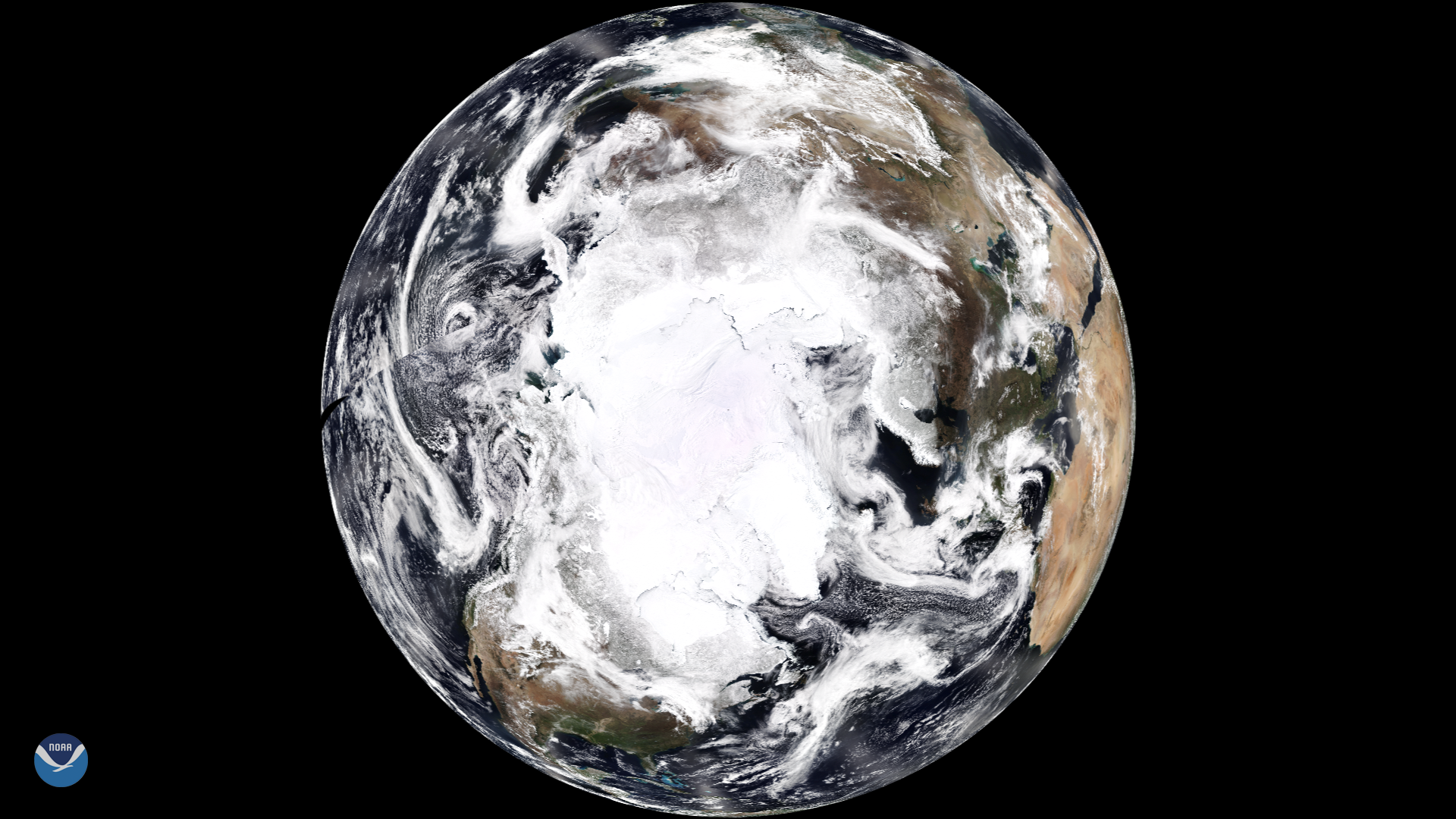
North Pole, Earth:
That very night, Curt had flown from the moon to Earth and had secretly visited the President, offering the service of his abilities in the war against interplanetary crime.
"I know you have no faith in me now," he had told the President, "but a time may come when you'll need me. When that time comes, flash a signal flare from the North Pole. I'll see it, and come."
Edmond Hamilton, Captain Future and the Space Emperor (1939, 1967).
Stid: It's cute that Cap. Future is so self-confident, he can make this offer even before he's done anything.
Zendexor: I wondered about that, myself. I am, however, a more obedient reader than you are; if I'm told to be impressed, I'm impressed. Usually.
What does bother me a bit more, is the practicality of the idea. At least one of the planeteering Futuremen must stay placed to keep an eye on Earth's North Pole at all times if the arrangement is to work...
 Lanikai Beach
Lanikai BeachOahu, Hawaii, USA:
The scene of Edgar Rice Burroughs' farewell visit from his creation, John Carter of Barsoom, Warlord of Mars.
From the Foreword to Llana of Gathol (1941, 1948):
Lanikai is a district, a beach, a Post Office, and a grocery store. It lies on the windward shore of the Island of Oahu. It is a long way from Mars. Its waters are blue and beautiful and calm inside its coral reef, and the trade wind sighing through the fronds of its coconut palms at night might be the murmuring voices of the ghosts of the kings and chieftains who fished in its still waters long before the sea captains brought strange diseases or the missionaries brought mother-hubbards.
Thoughts of the past, mere vague imaginings, were passing idly through my mind one night that I could not sleep and was sitting on the lanai watching the white maned chargers of the sea racing shoreward...
In addition to being marked by the visit from John Carter, Lanikai on Oahu is also where Burroughs receives the communication from his other planetary wanderer, Carson Napier, who telepathically relates the adventures on Amtor recounted in Escape on Venus (1946).
Historical note: in real life, Burroughs was living on Oahu in December 1941 and witnessed the attack on Pearl Harbour.
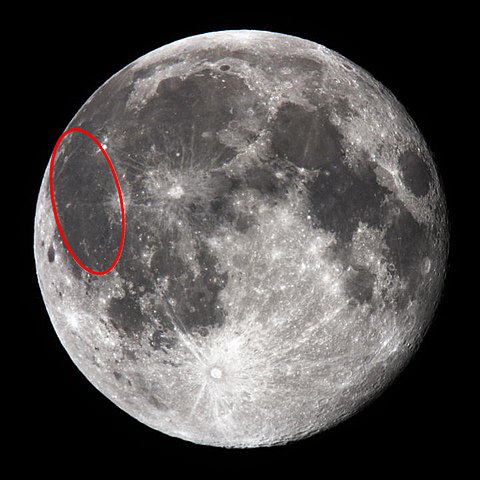
Oceanus Procellarum:
This was called Zpibaraz by the ancient Lunarians in The Archives of the Moon, a pastiche of Clark Ashton Smith's Old Solar System tales by Robert Gibson.
...Strolling onto the beach of amber shards which marked
the sinuous shore of Zpibaraz, they observed that the wide blue sky was
fortunately empty of flying beings, so that none might note their
departure. Then, unfolding their transparent vanes of fine gauze,
Dzhaoo and Vaphroo leaped into flight, choosing speed rather than
stealth as they soared over the specular ocean...
For an extract from Robert H Wilson's Out Around Rigel (Astounding Stories, December 1931) in which we are shown a beach overlooked by a Lunarian city, see An ocean shore on the ancient inhabited Moon.
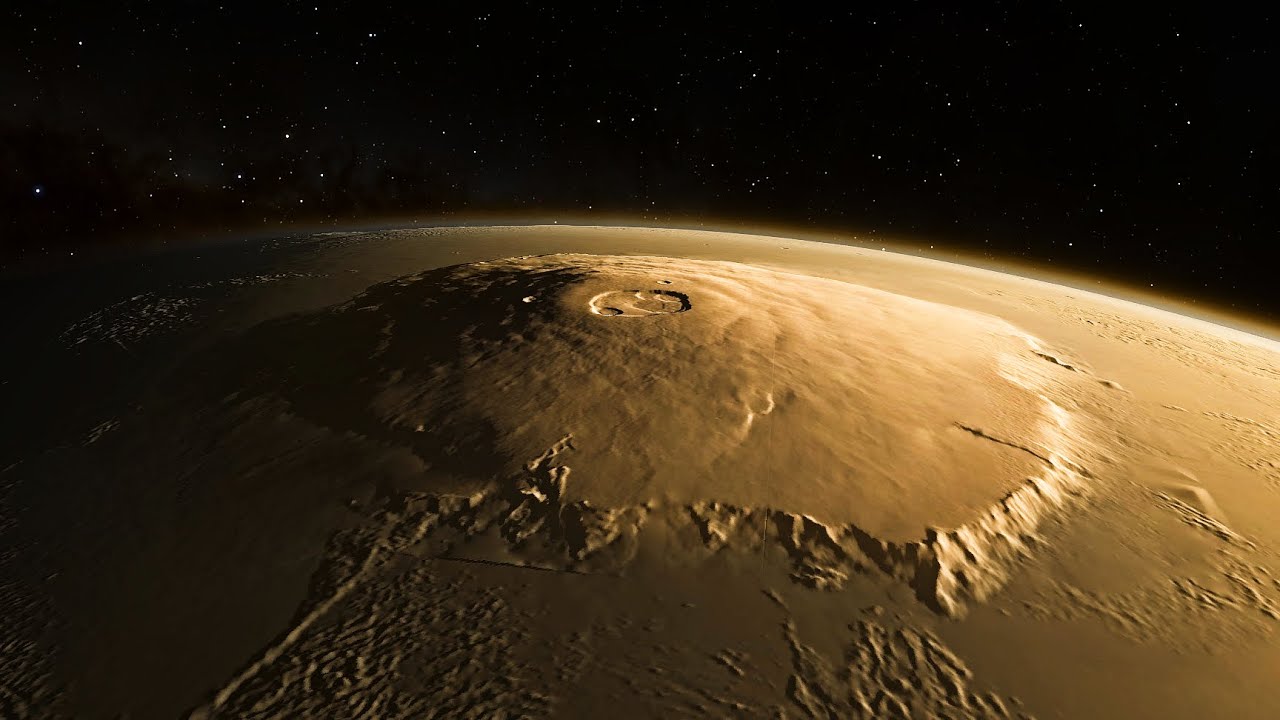
Olympus Mons:
...the vast complex of Martian buildings which had been built into the smooth, gently rising slopes of Olympus Mons. I was able to gaze out of vast windows at the dust-lashed scene outside, thinking it must have been quite a problem to find window material that would not be hopelessly scored by the fiercely blown streams of dust that were hitting them. I could not help reflecting on the paradox of a technology which was capable of erecting a planetary base of this kind and which yet permitted elementary defects, like bad plumbing and elevators that wouldn't work. The buildings I knew to be anchored by piles driven deeply into the hard-frozen ice and volcanic ash which formed most of the uplifted structure of Olympus Mons...
This excerpt from Fred and Geoffrey Hoyle's The Incandescent Ones (1977) is included for the sake of completeness, though it is only marginally OSS, and that marginal inclusion is for the sake of the remarkable scene on Jupiter rather than this obviously RSS-style scene on Mars. The name "Olympus Mons" in any case doesn't belong in an OSS tale; the traditional term, from telescopic observation, was Nix Olympica.
Likewise with only glancing relevance, but interesting, is the mention the place gets in the 1993 novel The Hammer of God by Arthur C Clarke (p.74-5):
...He had made so many virtual journeys over the Martian landscape, often at exhilarating velocities and with image enhancement, that the real thing was sometimes an anticlimax. The problem with the planet's most famous features was their sheer size: they were so enormous that they could be appreciated only from space, not when you were actually standing on them.
Olympus Mons was the best example. Martians were fond of saying that it was three times the height of any mountain on Earth, but the Himalayas or the Rockies were far more impressive, because they were so much steeper... Olympus was more like a huge blister on the face of Mars than a mountain. Ninety per cent of it was nothing more than a gently sloping plain...
Omaha, Nebraska, USA:
See 1970 for the retrospective effects of a disastrous time-experiment in 2002; from Damon Knight's The Other Foot (1965).
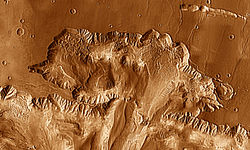
Ophir:
On the old pre-space-age albedo-features map of Mars, Ophir is at about longitude 65, latitude -10. According to Wiki, Ophir Chasma is 4 degrees South, 72.5 West.
...Mission Control's preflight plan called for the establishment of a base colony on the plains north of Ophir Chasma, the enormous northern arm of Valles Marineris... from the rather non-OSS work by Kim Stanley Robinson, Red Mars (1992), p.66.
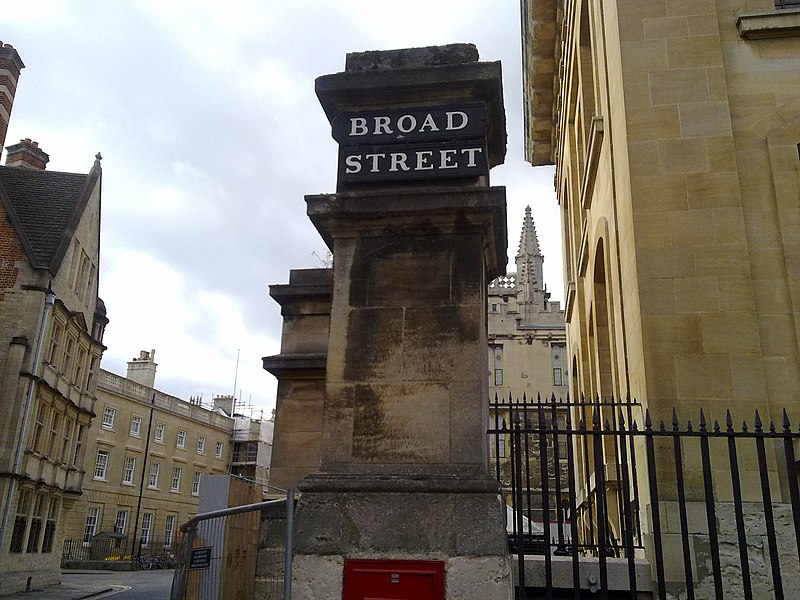
Oxford, Oxfordshire, England:
The anthropologist Dr David Queston on his return to England in 1970 after years in Brazil is puzzled by the atavistic political program of the sinister Ministry of Planning in Susan Cooper's Mandrake (1964). He sees some of its effects (which will be still more in evidence on his next return to Britain three years later):
...All around him the streets were deserted, the shop-fronts silent and dark. Oxford was asleep; enclosed, obedient. Under the lamps the pavements stretched before him yellow and empty; but the lamplight seemed dim. At the end of Broad Street he grew aware of a dark mass in the middle of the road, blotting out the great wrought-iron gates of Trinity; he crossed the road to look.
There were two machines, ancient and clumsy, great metal trolls looming out of the night... He had seen them before, used to destroy an old surface before a new one was laid.
The road felt unfamiliar and lumpy beneath his feet; he looked down. It was some seconds before he realized that the lumps were stones, set in deliberate order. The last relic of medieval Oxford, removed fifteen years ago to smooth the way for the cars. The cobbles of Broad Street were being laid again.
"Evening, sir," said a deep voice at his side. He saw the blue uniform half-consciously with his nearer eye...
"Ridiculous," Queston said irritably. "They might as well go the whole hog, and make it a beaten earth track."
"I don't agree with you there," the policeman said amiably. "The Middle Ages, that's the time we want. Oxford was strongest then..."
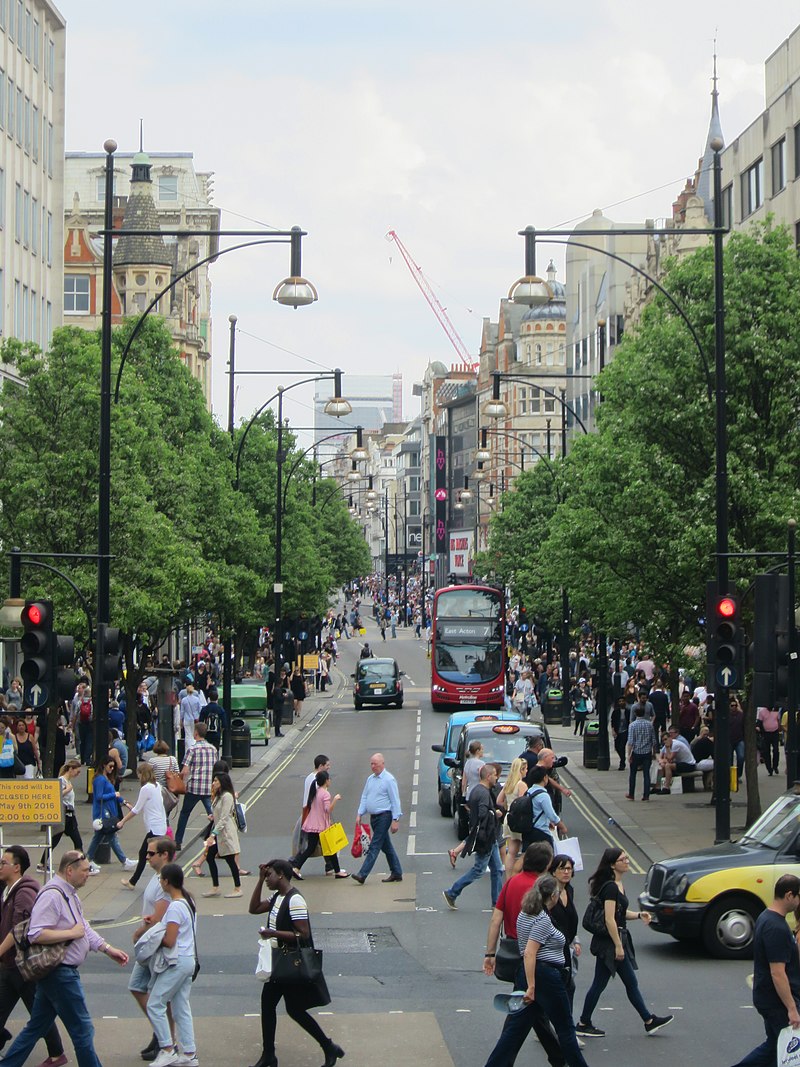
Oxford Street, London, England:
In a tragic story of unintented consequences, a man travels back in time aiming to prevent a bomb being thrown at the young King James III during the coronation procession down Oxford Street, in the short story by J G Ballard, The Gentle Assassin (New Worlds, December 1961).
Dr. Jamieson began to search the crowd again, the effort draining his face. A gigantic bellow from the crowd deafened him as the gold-plated royal coach hove into view behind a bobbing escort of household cavalry. He tried to see if Remmers looked around at an accomplice, but the man was motionless, hands deep in his pockets...
...Fifty yards away, the young king sat back in the golden coach, his robes a blaze of colour in the sunlight. Distracted, Dr. Jamieson watched him, then realized abruptly that Remmers had moved. The man was now stepping swiftly around the edge of the crowd, darting about on his lean legs like a distraught tiger. As the crowd surged forward, he pulled a blue thermos flask from his raincoat pocket, with a quick motion unscrewed the cap. The royal coach drew abreast and Remmers transferred the thermos to his right hand, a metal plunger clearly visible in the mouth of the flask.
"Remmers had the bomb!" Dr Jamieson gasped, completely disconcerted...
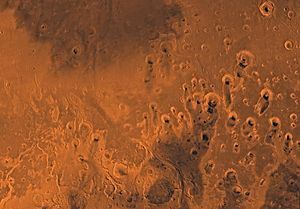
Oxia Palus:
...M'Cord was heading for Oxia Palus. There, at the junction of five minor canals, was a commo station. It was untended, of course, only an emergency radio beacon, but M'Cord knew he could put a call through to Mareotis, where the People kept a sort of embassy and where the Colonial Administration maintained a combination trading post and first aid station. A medic in a skimmer could be there in two days, three at the most, with one of the native Hndolanthi. A Hndolanth is a kind of interpreter-cum-herald...
- from The Valley Where Time Stood Still, by Lin Carter (1974), one of his four "lost-race" novels with Martian settings.
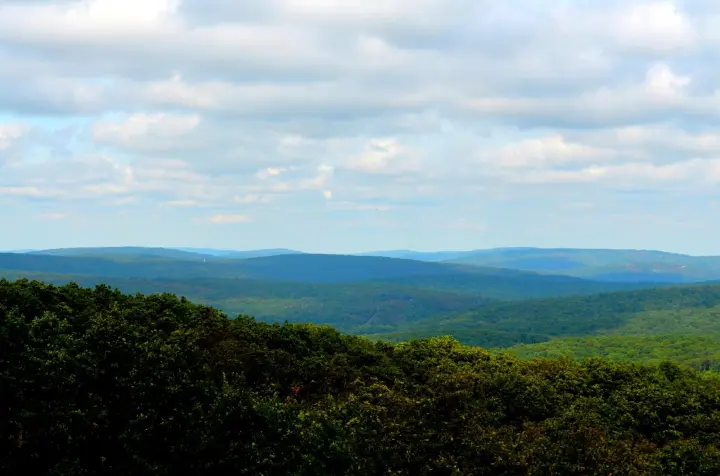
the Ozarks, Missouri, USA:
In this rural setting a researcher encounters the telekinetic "witch"-girl Abbie, in the novella by James E Gunn, Wherever You May Be (Galaxy, May 1953).
A tinkling of little silver bells. Laughter? Matt looked up quickly, angrily. The woods were thin along the top of this Ozark ridge. Descending to the lake, sparkling cool and blue far below, they grew thicker, but the only one near was the young girl shuffling through the dust several hundred yards beyond the crippled car. And her head was bent down to watch her way.
Much further futureward is the scene depicted by Stanley G Weinbaum in his posthumously published Dawn of Flame (Thrilling Wonder Stories, June 1939):
He passed the place where the great steel road of the Ancients had been, now only two rusty streaks and a row of decayed logs. Beside it was the mossy heap of stones that had been an ancient structure in the days before the Dark Centuries, three hundred years ago, when Ozarky had been a part of the old state of M'souri.
They had been mighty sorcerers, those ancients; their steel roads went everywhere, and everywhere were the ruins of their towns, built it was said, by a magic that lifted weights...
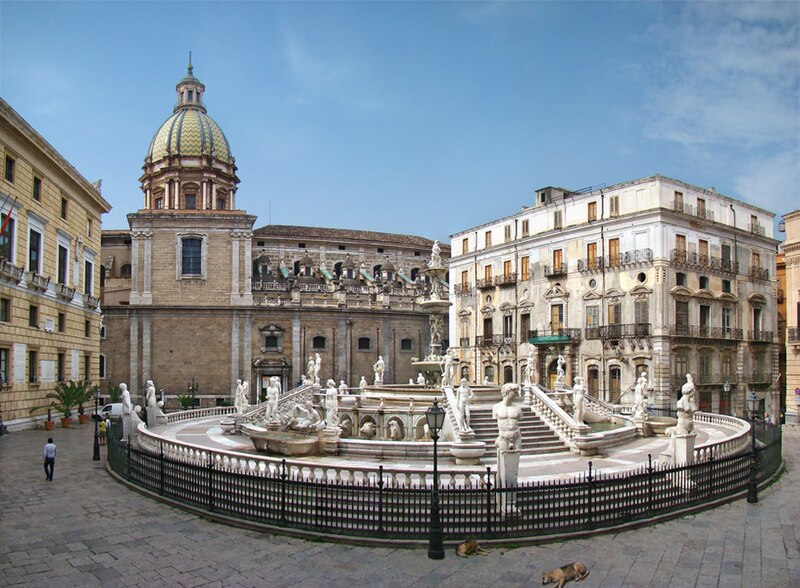
Palermo, Sicily, Italy:
The Sicilian capital is the site of the Great Hall of the global Council of the Weather Congress, the power that effectively rules the Earth in Theodore L Thomas' The Weather Man (Analog, June 1962):
...He rode the walk through the soft Sicilian air, and then became impatient with standing still. He stepped off the walk and strode alongside, and he felt pleased at the way his legs stretched. Off in the distance he could see the dome of the main Council building...
...He entered the Great Hall by the north stairs and walked along the east wall toward the stairs to his office. A group of sight-seers were being guided across the Great Hall by a uniformed guide, and the guide was describing the wonders of the Hall...
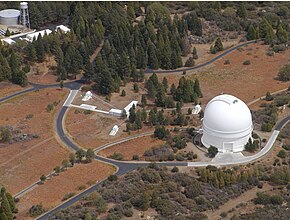
Palomar Observatory, California, USA:
Knut Jensen, a young Norwegian astronomer on a two-year studentship, working in the Observatory offices on pairs of photographic plates by means of the "blink comparator" in a search for novae, makes an epochal discovery in Chapter One of Fred Hoyle's The Black Cloud (1957).
...all in all there was quite a bit of work to do before he got through his pile of plates - work that was not a little tedious...
He finished the first of the batch. It turned out a finicking job. Once again, every one of the "possibilities" resolved into an ordinary, known oscillator. He would be glad when the job was done. Better to be on the mountain at the end of a telescope than straining his eyes with this damned instrument, he thought, as he bent down to the eye-piece. He pressed the switch and the second pair flashed up in the field of view. An instant later Jensen was fumbling at the plates, pulling them out of their holders. He took them over to the light, examined them for a long time, then replaced them in the "blinker" and switched on again. In a rich star field was a large, almost exactly circular, dark patch. But it was the ring of stars surrounding the patch that he found so astonishing. There they all were, oscillating, blinking, all of them. Why? He could think of no satisfactory answer to the question, for he had never seen or heard of anything like this before...
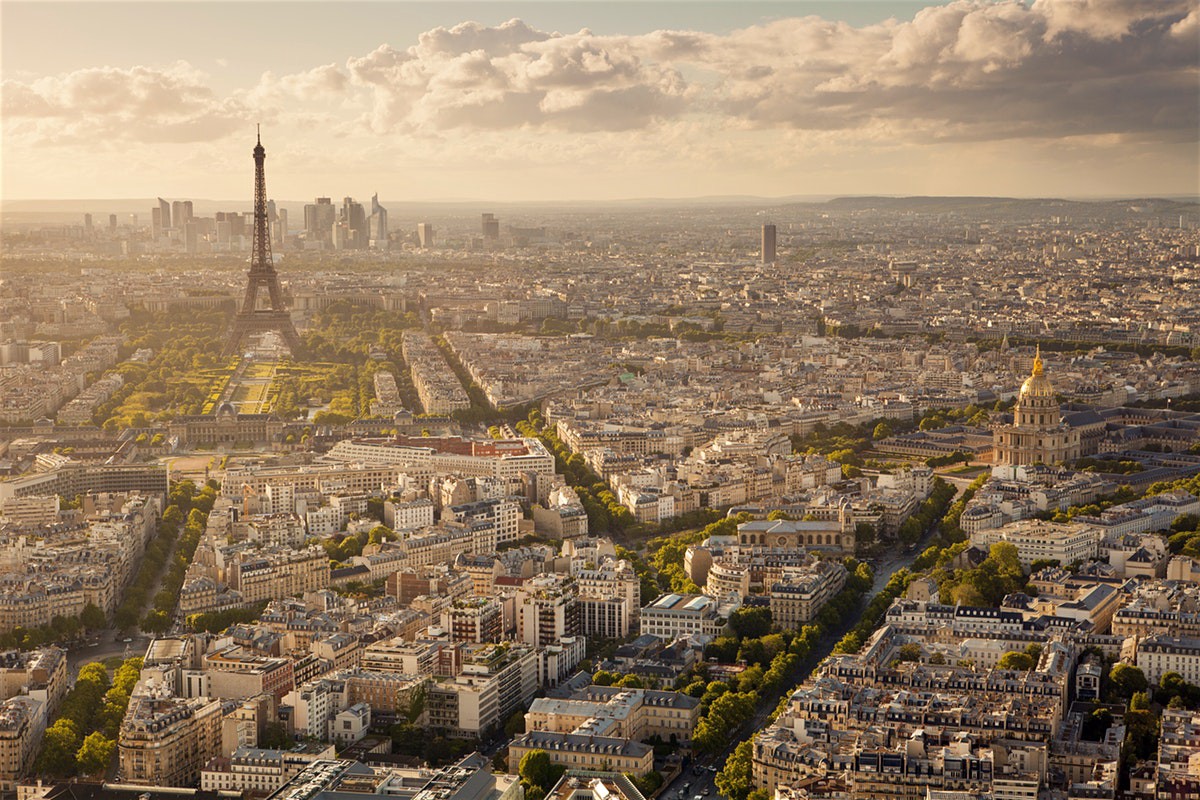
Paris, France:
The young outlaws fleeing the alien regime in John Christopher's The White Mountains (1967) approach the ruins of France's capital.
...I had never seen anything remotely like it before. It stretched for miles, rising in hills and valleys. The forest had invaded it - there was the tossing green of trees everywhere - but everywhere also were the grey and white and yellow bones of buildings. The trees followed lines among them, like veins in some monstrous creature...
...The trees followed the old streets, sprouting out of the black stone of which they had been built, and thrusting their tops up above the canyons formed by the buildings on either side...
Even further in the future - tens of thousands of years ahead - is the "Perris" of Perris Way by Robert Silverberg (Galaxy, November 1968), in which a blinded prince on a conquered Earth wanders into the old French capital:
...Perris seemed perpetually clouded over, buildings and environment both somber. Even the city walls were ash-grey, and they had no sheen. The gate stood wide. Beside it there lounged a small, sullen man in the garb of the guild of Sentinels, who made no move to challenge us as we approached...
As night falls:
...Perris, which had looked so dreary in the clouded and drizzling day, came to beauty... The city's lights cast a soft but dazzling radiance that magically illuminated the old gray buildings, turning angles hazy, hiding antiquity's grime, blurrring ugliness into poetry... The Tower off Paris, spotlighted against the dusk, loomed above us to the east like a giant gaunt spider, but a spider of grace and charm...
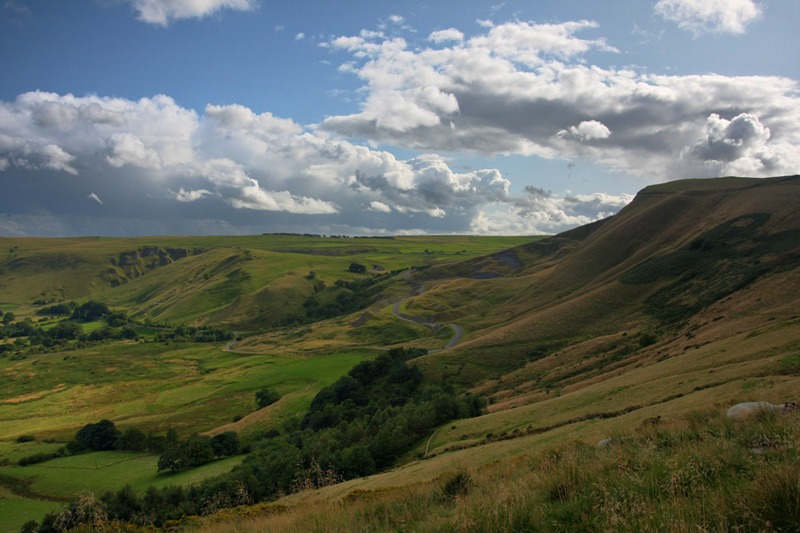
the Peak District, (mostly in) Derbyshire, England:
This area is the site of Glyn Weston's time-travel experiments, in Seeker of Tomorrow (Astounding Stories, July 1937) by Eric Frank Russell and Leslie J Johnson.
...I had set up my laboratory in the wilds of the Peak District of Derbyshire, in England, where work could be carried on with the minumum of interference. From this laboratory I had dispatched into the unknown, presumably the future, a multitude of objects... In no case could I bring back anything I had made to vanish. Once gone, the subject was gone forever. There was no way of discovering exactly where it had gone. There was nothing but to take a risk and go myself...
Peoria, Illinois, USA:
In Maker of Universes (1965) by Philip Jose Farmer, Peoria is where a "crescent" for an interdimensional gateway turns up in a pawnshop. (Such gadgets are used by the tyrannical Lords of pocket universes for travel between one private cosmos and another.)
...How it had gotten there and what Lord had lost it on Earth would never be known. Doubtless there were other crescents in obscure places on Earth...
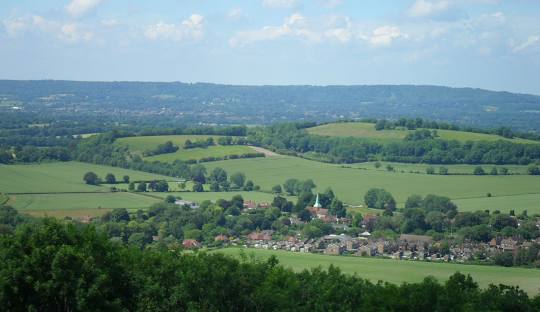
Petersfield, Hampshire, England:
In the post-disaster setting of John Christopher's The Prince In Waiting (1970), when geologic upheaval and magnetospheric change has led to widespread mutation, earthquakes and volcanism, a hierarchy of "Seers" and "Spirits" has prohibited the use of machinery by the masses. Nevertheless the defenders of Petersfield, when attacked by the men of Winchester, take the dastardly step of using cannon, with deadly effect. This does not deter the Prince of Winchester from leading his army onward against Petersfield's walls.
It seemed hopeless. They had to advance on foot with the machines, three of them, blasting down at them from above. Even without these, scaling the walls would have seemed impossible. Because of the risk of earthquakes they were of loose construction but they were steeply sloping and more than thirty feet high, manned by archers who could pick off the crawling attackers with ease. One of the Captains had suggested making the attck at some other point where there might not be machines but my father refused...
Peterson Field, Colorado, USA:
Scene of the launch of the first Moon flight, in Heinlein's The Man Who Sold The Moon (1950).
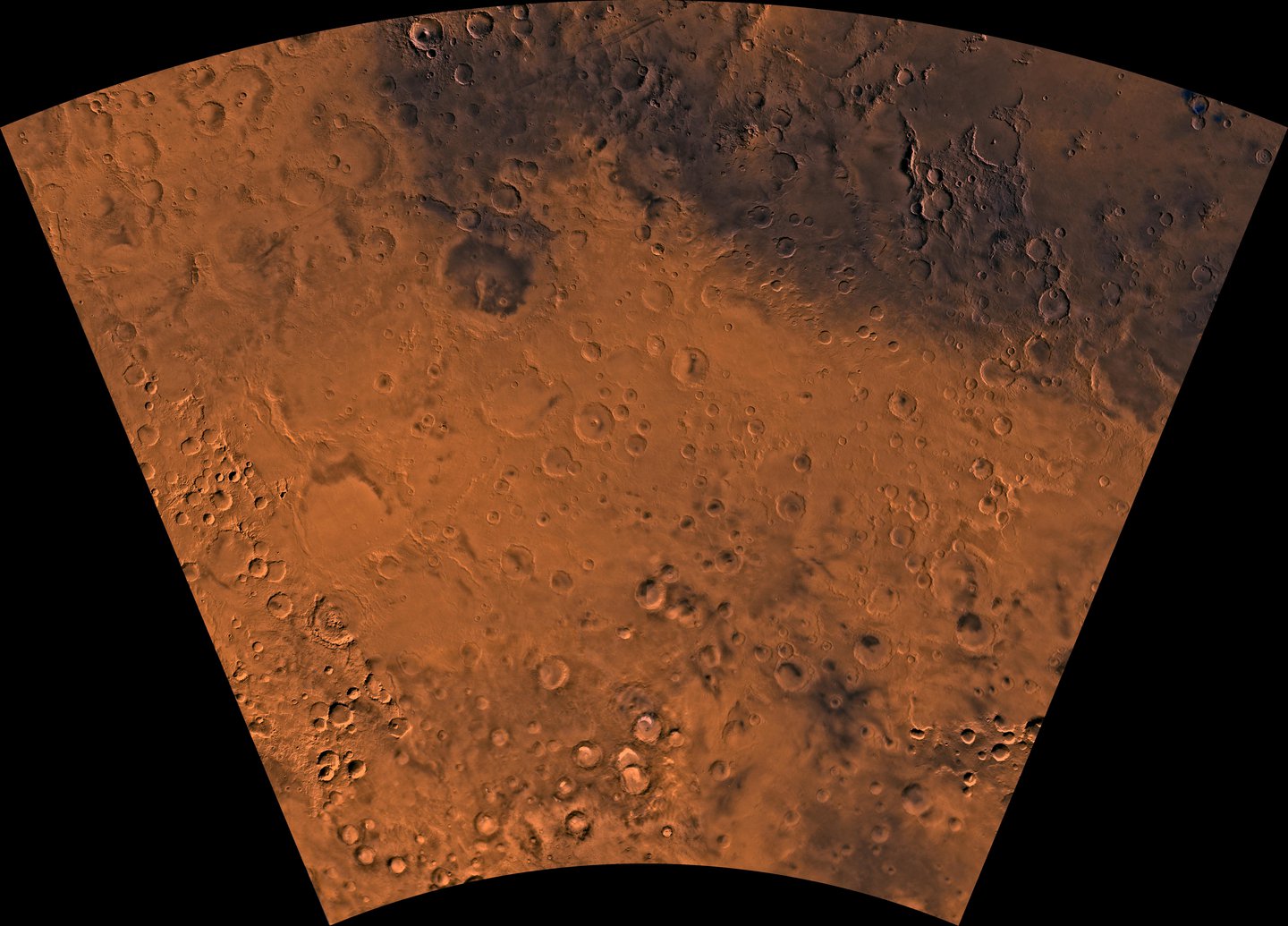
Phaethontis:
From Lin Carter's distinctive flavour-blending novel The Man Who Loved Mars (1973) which melds realism with retro OSS-style narrative:
It seemed that only the Doctor and I had ever been on Mars before. So we helped the other two accustom themselves to the use of their respirators. Of the four of us, only I had ever undergone the Mishubi-Yakamoto treatments and could do without the artificial breathing boosters.
We had come down just where the Doc had planned. All about us, but tapering off due west, the canal extended like a four-foot-high miniature jungle. Seen from above - it was to be hoped! - the Antoine d'Eauville ought to blend unobtrusively with the shrubbery. Of course, to anyone crossing Phaethontis either afoot, on slidar, or by sand-tractor, it would stand out somewhat more prominently than a dozen sore thumbs, and that we could not help. However, this was the edge of the Drylands, and nobody ever comes this far south, not even the People, for the very good reason that there is nothing here to attract them...
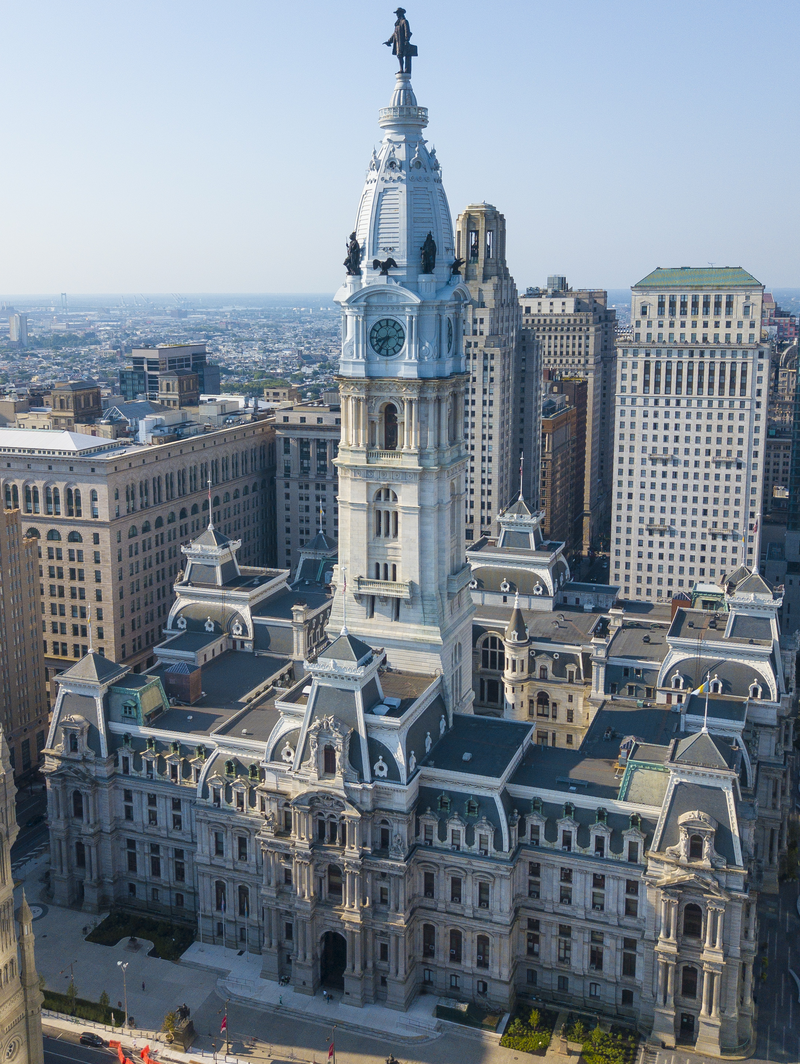
Philadelphia, Pennsylvania, USA:
In an alternate world, which compared to ours is vulnerable to physical plagues yet comparatively free of mental illnesses, Philadelphia is hard hit in the tale by Alan E Nourse, Symptomaticus Medicus (Universe, September 1954):
THE year was 1954. That it was to be a highly significant year was not surprising, for on the Kalendar of Golwal it had been marked up in illuminated gold for many generations...
...above and beyond all else, that year 1954 was to be remembered throughout the world of men as the year of the Great Philadelphia Plague...
...The city had been transformed into a huge infirmary... beds of every type and description filled the historic City Hall and lined Market Street for blocks...
Philadelphia was the birthplace of Miriam Allen DeFord, 21 August 1888.
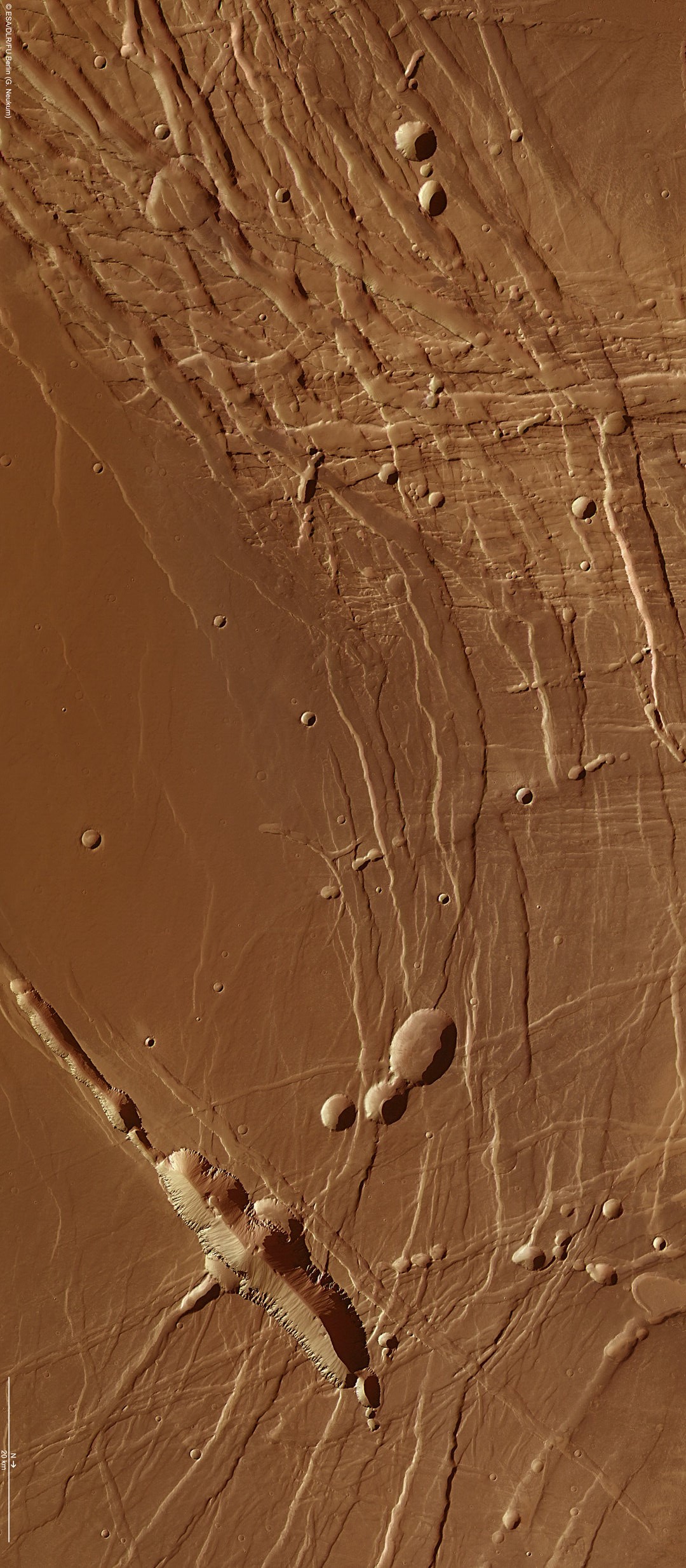 Nature not quite managing to conform to fiction but deserving some marks for effort
Nature not quite managing to conform to fiction but deserving some marks for effortPhoenicis Lacus:
In the December 1939 Thrilling Wonder Stories, and reprinted in the May 1950 Startling Stories (which is where I found it), the tale Signboard of Space by Frederic Arnold Kummer Jr. includes a view of the "Lake of the Phoenix" during an approach to the Red Planet.
...Dr Varian and I spent the day in the control room studying Mars through the telescope. It makes a wonderful sight at present. The Schiaparelli canals are amazingly clear and many new ones, invisible from Earth, are evident. Also many more dark dots, the so-called oases.
Today the Lacus Phoenicis was turned toward us, a tangle of geometrically straight lines at the joinings of which were dark spots of varying size. I am impressed by the similarity of certain curiously regular designs, formed by the canals, to other designs which I have previously noticed upon the Fastigium Aryn...
...The presence of those lines and dots which are invisible from Terra seem to tie the whole complex jumble into a regular pattern, orderly, mathematical, unquestionably the work of intelligent beings...
Phoenix, Arizona, USA:
In this area, in chapter one of Maker of Universes (1965) by Philip Jose Farmer, a former amnesiac named Robert Wolff is viewing a house with a view to purchase, when he is contacted from outside the cosmos:
...A minute ago, he had looked inside the closet. Nothing except the cement floor, the white plasterboard walls, the clothes rod and hooks, a shelf and a lightbulb was there.
Yet he had heard the trumpet notes, feeble as if singing from the other wall of the world itself. He was alone, so that he had no one with whom to check the reality of what he knew could not be real...
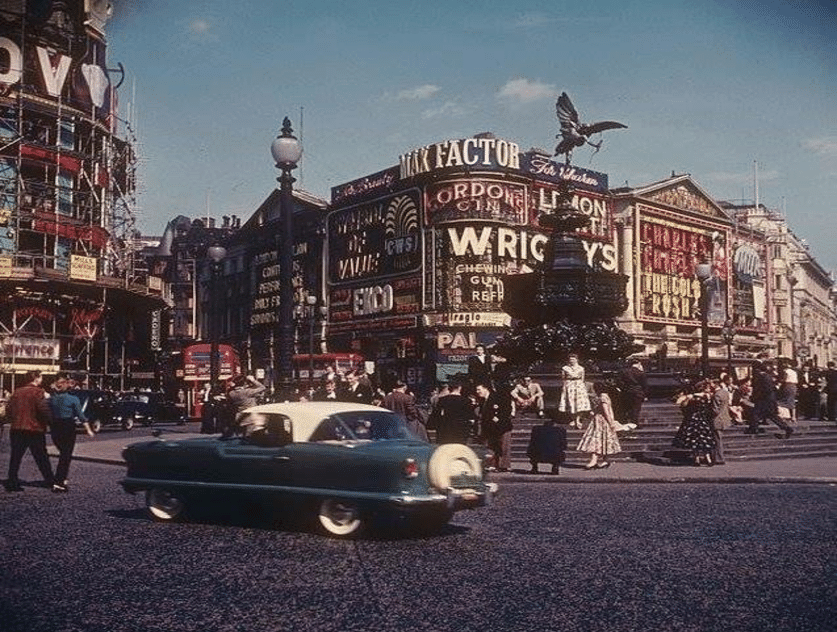
Piccadilly Circus, West End of London, England:
In chapter three ("The Groping City") of The Day of the Triffids (1951) by John Wyndham, the accidentally still-sighted narrator reaches this junction on the day when most of mankind has woken to find itself blind.
...Piccadilly Circus was the most populous place I had found so far. It seemed crowded after the rest, though there were probably less than a hundred people there, all told. Mostly they were wearing queer, ill-assorted clothes, and were prowling restlessly around as though still semi-dazed. Occasionally a mishap would bring an outbirst of profanity and futile rage - rather alarming to hear because it was itself the product of fright, and childish in temper. But with one exception there was little talk and little noise. It seemed as though their blindness had shut people into themselves.
The exception had found himself a position out on one of the traffic-islands. He was a tall, elderly, gaunt man with a bush of wiry grey hair, and he was holding forth emphatically about repentance, the wrath to come, and the uncomfortable prospects for sinners. Nobody was paying him any attention: for most of them the day of wrath had already arrived...
Picadilly fares no better in another disaster novel, All Fool's Day (1966) by Edmund Cooper, in which insanity (caused by changing conditions in space) is the culprit:
...Greville drove skilfully round the overturned bus, zigzagged among the wrecked small cars and found a clear run through Cockspur Street and the Haymarket.
Piccadilly Circus presented much the same kind of petrified desolation as Trafalgar Square, except that two massive army tanks blocked the entry to Regent Street, and Eros - the frail statue which had once seemed like an irresistible magnet for hundreds of thousands of Londoners - had been blown to glory.
Piccadilly Circus had obviously been the scene of a pitched battle. The carnage was heavier than in Trafalgar Square, and tattered remnants of uniforms still hung over the disorderly heaps of bones. The front of the London Pavilion had been shot to pieces and so had Swan and Edgars. The main entrance to the Piccadilly Tube Station was merely a pile of rubble; and large pieces of masonry lay scattered among the bones and wrecked cars that blocked the entrances to Piccadilly and Shaftesbury Avenue...
To complete a trilogy of Piccadilly-related disturbances we can feast our eyes on the cover illustration by S Drigin for G R Malloch's Winged Terror - a tale serialised in Pearson's Magazine February-April 1931 and then reprinted as a whole in the short-lived pulp Fantasy (issue no. 2 of 3) in 1939. I can't find any summary of the plot but we can deduce something from the picture:
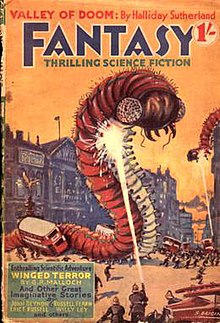
Pico, Mare Imbrium
Two writers have associated this isolated lunar mountain with the theme of conflict.
Mysterious alien domes - at first suspected to be Russian - appear in the Pico area in Hugh Walters' Blast Off At Woomera (1957). In the sequel, The Domes of Pico (1958), the aliens threaten Earth with harmful radiation.
This same region is the scene of the climacteric Battle of Pico in Earthlight (1955), a novel set in the 22nd century, by Arthur C Clarke.
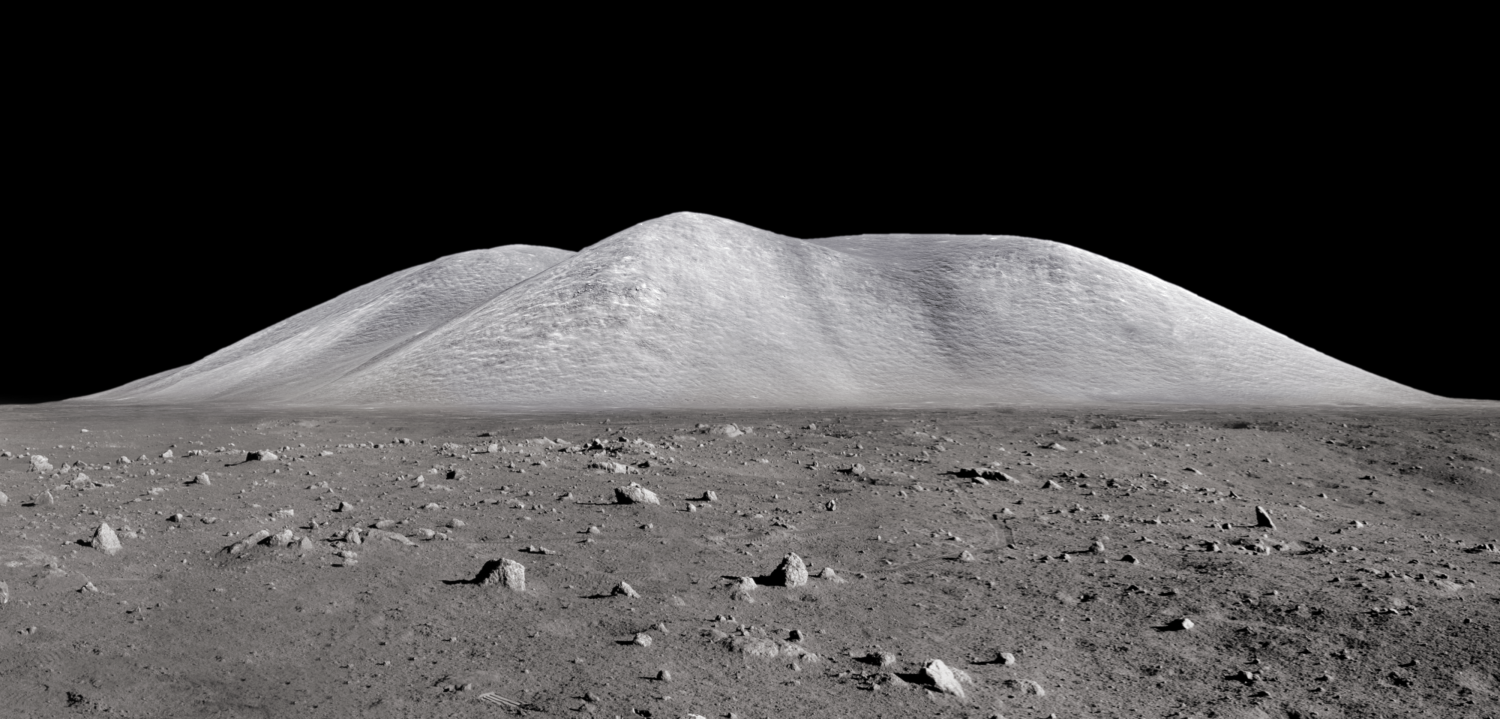 height: a little under 8,000 feet
height: a little under 8,000 feet...Like
most lunar mountains, Pico was not so formidable when seen close at
hand as when glimpsed from a distance. There were a few vertical
cliffs, but they could always be avoided, and it was seldom necessary to
climb slopes of more than forty-five degrees. Under a sixth of a
gravity, this is no great hardship, even when one is wearing a
space-suit...
See also Rugged vs unrugged Mount Pico.
Moonwalk by H B Fyfe (Space Science Fiction, November 1952) has a brief description of the mountain, which, though perhaps giving an exaggerated impression of its gradient, well captures its starkness, its isolation and its contrast with the surrounding plain:
Careful, not to admit to himself that relief might be slow in starting from Archimedes, he took a last look at Pico. Rearing starkly upward, it projected a lonely, menacing grandeur, like a lurking iceberg or an ancient monument half-buried in the creeping sands of a desert. In the light of the nearby full Earth, it was a pattern of gray angles and inky black patches...
In Patrick Moore's Invader from Space (1963) it is mentioned (p.9) that
...The astronomical observatory on the slopes of Mount Pico had proved to be invaluable...
though it is not explained why on the airless Moon an observatory need be sited on a mountain. Whatever the reason, considerable importance has been attached to the location, since (p.54): ...one of the first projects had been to build a chain of pylons between Headquarters and the foothills of Mount Pico, so that there was no difficulty in keeping in touch...
See also the Diary entry, A Fruitful Lag.
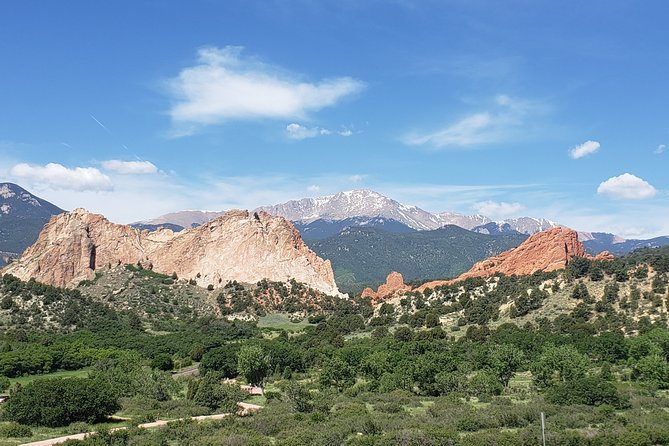
Pike's Peak, Colorado, USA:
The mountain used for the second Moon flight in Heinlein's The Man Who Sold The Moon (1950).
It was one of those glorious evenings so common in the Pikes Peak region after a day in which the sky has been well scrubbed by thunderstorms. The track of the catapult crawled in a straight line up the face of the mountain, whole shoulders having been carved away to permit it...

Pittsburgh, Pennsylvania, USA:
The evil Dr Vinson and his fellow-Immortals are opposed by Anton York the good Immortal, whose super-weapon to save the world is developed here, in Eando Binder's The Conquest of Life (Thrilling Wonder Stories, August 1937):
....Faster than they had ever moved before, the wheels of industry, lashed by a frantic government, turned out the apparatus York wanted. He had them secretly move their headquarters to Pittsburgh. The terrible weapon he had kept locked in his brain for over a century took form here...
The Steel City also gets a mention in Philip K Dick's The World Jones Made (1956), chapter six, when the future dictator, wandering after the nuclear war, visits its ruins:
Here, basic industrial activities continued. Underground, the forges still bellowed. But Jones wasn't interested; on foot he continued his journey, past the smouldering miles of metal that had once been the greatest concentrate of factories in the universe...
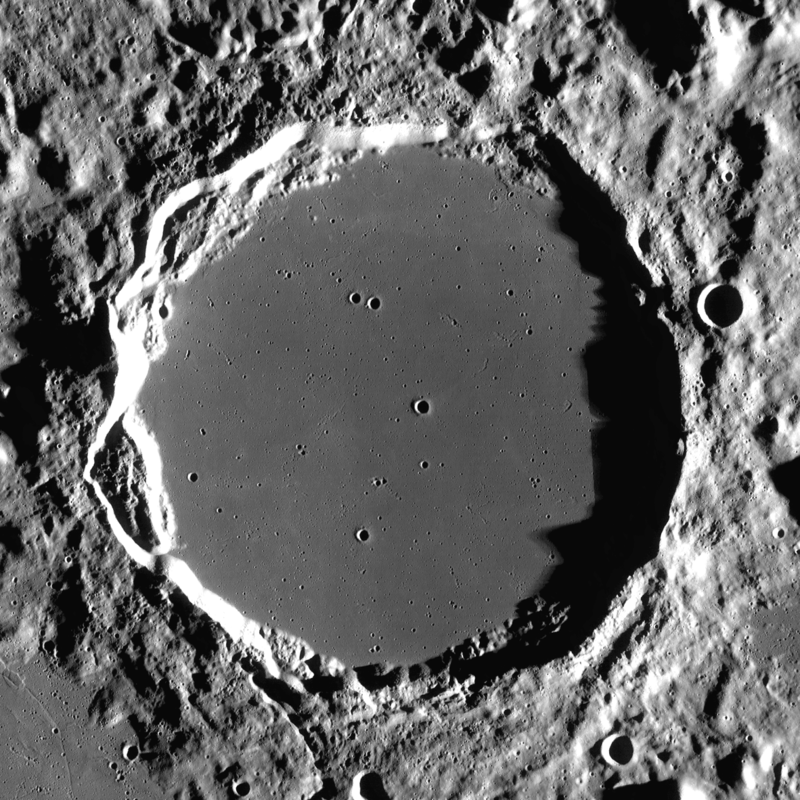 from Lunar Orbiter
from Lunar OrbiterPlato (crater), Mare Imbrium:
On the ledge atop the ringwall of Plato, Hansen teetered and tried to maintain his balance by pressing a gauntleted hand against an outcropping of gray Lunar rock. The thermal-eroded surface crumbled slightly beneath the metal-tipped mitten... H B Fyfe, Moonwalk (Space Science Fiction, November 1952).
In the same story the author or the narrator has the following very interesting comment to make:
...For centuries, the floor of Plato had been reported by Earth observers to darken with the rising sun until at noon it was nearly black. Occasionally, there were stories of misty clouds obscuring the surface, and of shifts in the pattern of light streaks and spots.
One of the expedition's first assignments, therefore, had been the investigation of Plato, to check the unlikely possibility that there might be some primitive, airless form of life present...
Now from one hard-science author to another: the crater is the site of the Lunar Observatory in Clarke's Earthlight (1955).
The horizon was almost flat in all directions. Though the Observatory was at the centre of the great walled plain of Plato, the mountain ring was hidden by the curve of the Moon. It was a bleak and desolate prospect, without even a few hills to give it interest. Only a dusty plain, studded here and there with blow-holes and craterlets - and the enigmatic works of man, straining at the stars and trying to wrest away their secrets.
In the same book we are given an idea of the crater's ring-wall:
From space - or through a telescope on Earth - the walls of Plato look a formidable barrier when the slanting sunlight shows them to best advantage. But in reality they are less than a kilometre high, and, if one chooses the correct route through the numerous passes, the journey out of the crater and into the Mare Imbrium presents no great difficulty...
...He eased the vehicle forward, gingerly skirting a vast talus slope where splintered rock had been accumulating for millennia. Such slopes were extremely dangerous, for the slightest disturbance could often set them moving in slow, irresistible avalanches that would overwhelm everything before them. For all his apparent recklessness, Jamieson took no real risks, and always gave such traps a wide berth...
Plato's wall also features in Captives of the Moon (1960), the first of Patrick Moore's five "Robin North" adventures, where on p.105-6 the crater wall is described as
...much less striking than Robin had expected; it looked like nothing more than a scattered row of hills...
(In this novel the American lunar base is "slap in the middle" of Plato.)
In a later novel in the same series, Invader from Space (1963), we read that
...By now there were several dozens of people on the Moon, scattered throughout the main research bases. The underground headquarters in Plato Crater remained the largest...
Compared with Patrick Moore's low-key topographic descriptions, Poul Anderson's Mirkheim (1977) gives us a more dramatic rendering of the ringwall at the end of the following scene (set in the 26th century):
It was close to Lunar midnight. From the main room of the suite, the view through a transparency was awesome. Buildings stood well apart and were not high. They must stay below the forcefields which kept air in this bubble and the ozone layer beneath. But between them were parks wherein the low gravity let trees soar and arch like the fountains, amidst fiercely colored great blossoms. Lamps, on posts formed to resemble vines, glowed everywhere. They did not haze view of the stark crater floor beyond the fields, of Plato's ringwall shouldering in cliffs and steeps over the near horizon...
In The Lion of Comarre (Thrilling Wonder Stories, August 1949) by Arthur C Clarke, the crater is mentioned in passing:
"Who wants to go to the stars, anyway?"
The boy made an exclamation of annoyance and jumped off the diamond block in his excitement.
"What a question to ask in this age! A thousand years ago people were saying, 'Who wants to go to the Moon?' Yes, I know it's unbelievable, but it's all there in the old books. Nowadays the Moon's only forty-five minutes away, and people like Harn Jansen work on Earth and live in Plato City..."
In Poul Anderson's The Light (Galaxy, March 1957), the astronauts who think they are first on the Moon climb the ring-wall of Plato:
...There was an easy slope at the spot we picked and a kind of pass on top, so we didn't have to climb the full height, which is a little under 4000 feet.
- and make two discoveries inside the crater. The second one is stupendous. The first is merely amazing:
When we reached the summit, we could look down on a lava plain sixty miles across; the farther side was hidden from us. It seemed almost like polished black metal, crossed by the long shadow of the western ringwall. The downward grade was steeper, its base lost in darkness, but it could also be negotiated.
My helmet, sticking into the direct sunlight, was a Dutch oven; my feet, in the shade, were frozen clods. But I forgot all that when I saw the mist below me.
Have you heard of it? Astronomers have noticed it for a long time, what seemed to be clouds or - something - in some of the craters. Plato is one. I'd been hoping we'd solve the mystery this trip. And there, curling in ragged streamers a quarter mile below me, was the fog!
It boiled out of the murk, glowed like gold for a moment as it hit the light, and then it was gone, evaporated, but more came rolling up every minute...
In Hugh Walters' Operation Columbus (1960) Chris Godfrey is about to become the first astronaut to land on the Moon, the chosen site being -
Plato! Moving slowly, the great circular feature now came on the screen. He knew that this famous crater, eighty miles in diameter and with rocky walls four thousand feet high, was thought to be the flattest part of the Moon's surface. Yet even this was not sure, for often observers had seen mysterious changes on its floor. It was generally agreed that Plato was one of those places on our satellite where a strange mist could sometimes be seen creeping across the ground. Sometimes small marks could be seen within its walls. At others, those same marks were invisible. It looked darker than the rest of the Moon as it seemed to settle fairly in the centre of the screen...
Hal Clement in Dust Rag (Astounding Science Fiction, September 1956) narrates with topographic realism the descent of explorers into the crater from the north:
The inner wall of the crater was a good deal steeper than the one they had climbed, but still did not present a serious obstacle. The principal trouble was that much of the way led through clefts where the sun did not shine, and the only light was reflected from distant slopes. There wasn't much of it, and the men had to be careful of their footings - there was an occasional loose fragment... The way did not lead directly towards the crater floor; the serrated rim offered better ways between its peaks, hairpinning back and forth so that sometimes the central plain was not visible at all. No floor details appeared as they descended, but whatever covered them was still below; the stars, whenever the mountains cut off enough sidelight, were clear as ever. Time and again Shandara stopped to look over the great plain, which seemed limitless now that the peaks on the farther side had dropped below the horizon...
See also the Diary entry, A Fruitful Lag.
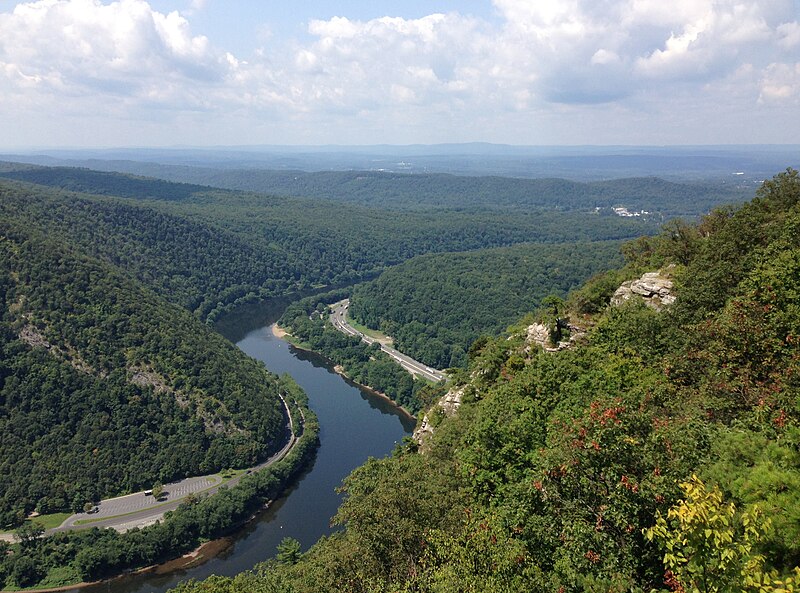
the Pocono Mountains, Pennsylvania, USA:
The trajectory of the alien spacecraft in Day of Succession by Theodore L Thomas (Astounding, August 1959) is specified as follows:
...The object came in low over the Pocono Mountains and crashed in south-eastern Pennsylvania two miles due west of Terre Hill...
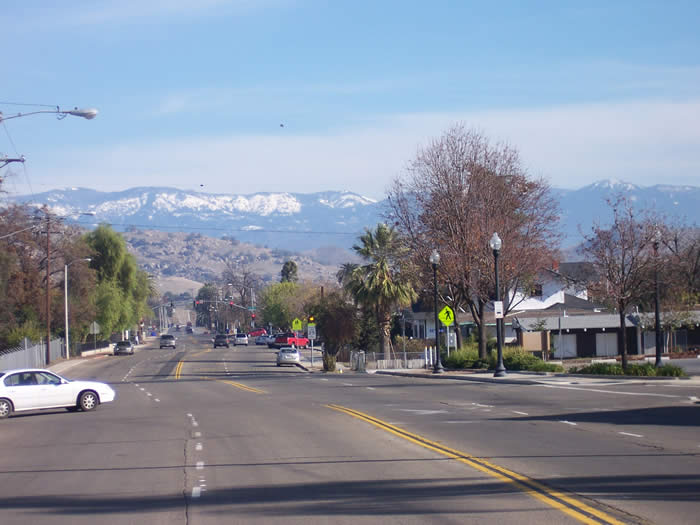
Porterville, California, USA:
George Christopher and his brother Ray drove down the highway towards Porterville. Lake Success lay on their right, high banks rose to the top of the ridgeline on their left. Rain fell steadily. Already the lake had risen nearly to the bridge where the highway crossed. Chunks of mud washed down from the ridge above and covered the road. The big farm truck went through the mud patches without slowing.
"Not much traffic," Ray said.
"Not yet." George drove grimly, his mouth a set line, his bull neck arched towards the steering wheel. "But it won't be long. All those people. They'll come up the road looking for high ground - "
"Most'll stop in Porterville," Ray said. "It's a couple of hundred feet higher than the San Joaquin."
"Was," George said. "With those quakes you can't tell. Land shifts, raises up and down. Anyway, when the dam goes, Porterville goes. They won't stay there..."
From Lucifer's Hammer (1977), the comet-strike disaster-epic by Larry Niven and Jerry Pournelle.
The town is also briefly visited in Frank Herbert's ambivalently spine-chilling story of a kind of group intelligence, The Santaroga Valley (1967). Due to the (fictional) Valley's sinister influence, investigator Gilbert Dasein does not trust the telephone lines there, and chooses to contact his superior from outside it.
Porterville loomed out of the night, the highway becoming a wide main street with a blue and white 'Bus Depot' sign on the left over an all-night cafe...
...The Sheriff's car drove past, its headlights casting enormous shadows on a white fence behind the phone booth.
Dasein sighed, went into the booth. He felt strangely reluctant to make the call, had to force himself...
Potsdam, Brandenburg, Germany:
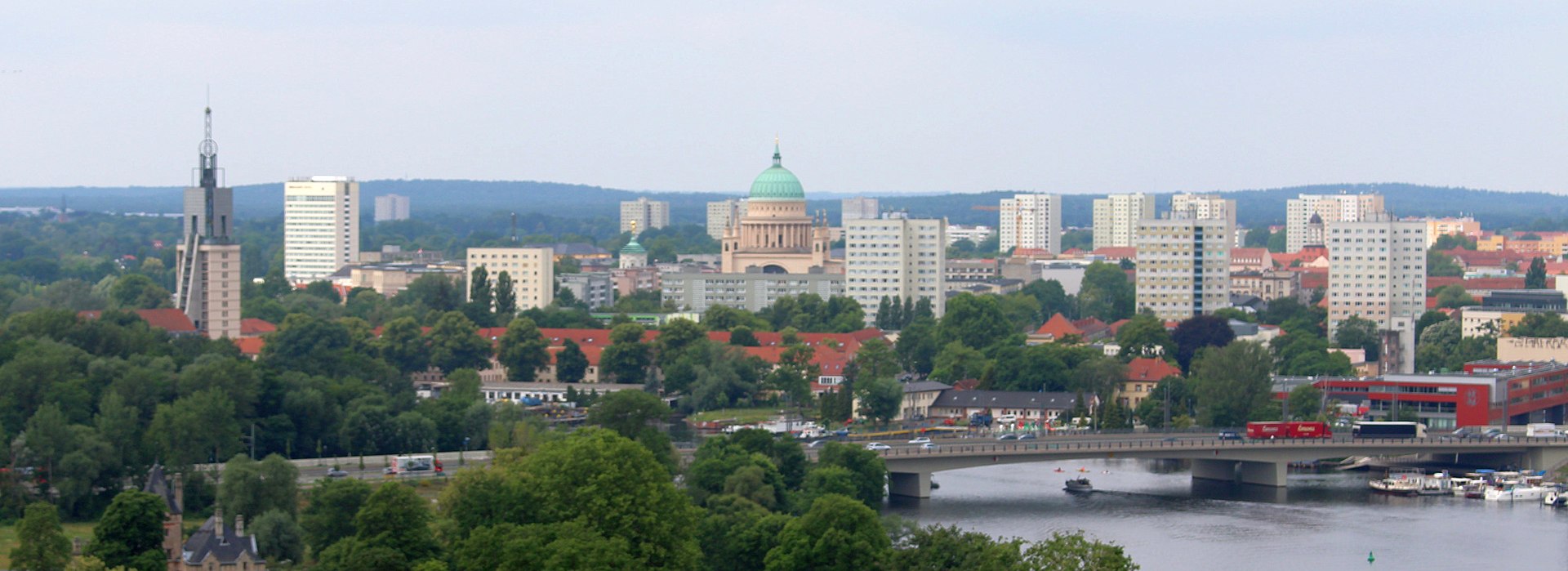
From Colin Wilson's The Mind Parasites (1967):
...Fleishman was also able to tell us about the Grau brothers, who were at present in Potsdam, their home. He had been able to contact them that morning, before reporters began jamming all out-going calls... They owed their safety to the accident of being telepathically linked. Just as they were able to use one another's minds as amplifiers for their PK powers, so they were able to draw upon one another's strength in their night battle...
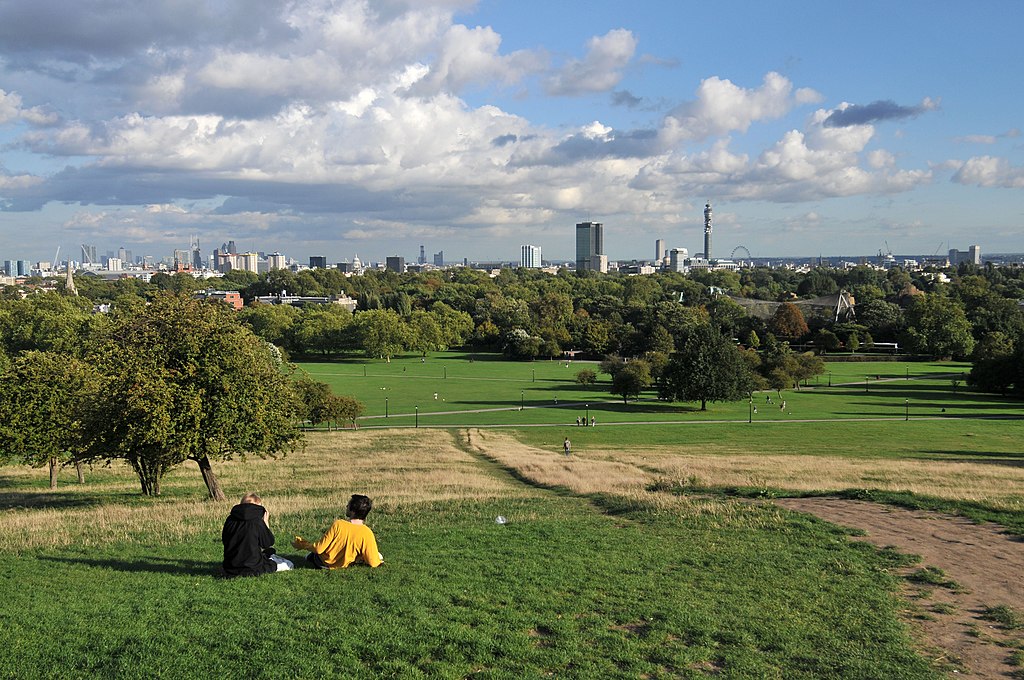 About a century after the invasion. The Martians came too early to deal with high-rise blocks.
About a century after the invasion. The Martians came too early to deal with high-rise blocks.Primrose Hill, London, England:
This is where H G Wells' narrator in The War of the Worlds (1898) finds unhoped-for relief from despair.
...I missed my way among the streets, and presently saw, down a long avenue, in the half-light of an early dawn, the curve of Primrose Hill. On the summit, towering up to the fading stars, was a third Martian, erect and motionless like the others.
An insane resolve possessed me. I would die and end it. And I would save myself even the trouble of killing myself. I marched on recklessly towards this Titan, and then, as I drew nearer and the light grew, I saw that a multitude of black birds was circling and clustering about the hood. At that my heart gave a bound, and I began running along the road...
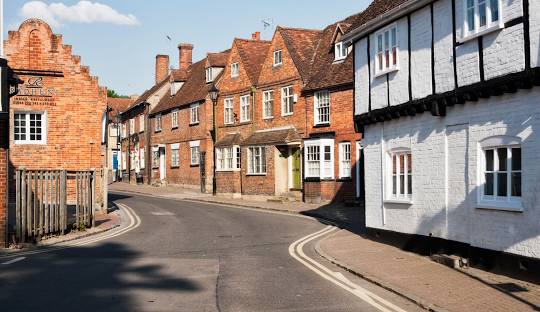
Princes Risborough, Buckinghamshire, England:
From Fred Hoyle's 1985 novel Comet Halley:
"Where have we to get to?"
"Princes Risborough."
After examining a road atlas for a while, Frances Margaret eventually said, in something more like her usual firm style:
"You know, if you designed a road system with the intention of making it difficult to get to Princes Risborough you couldn't make it worse. I suppose that's why Prime Ministers live there." [see Chequers]
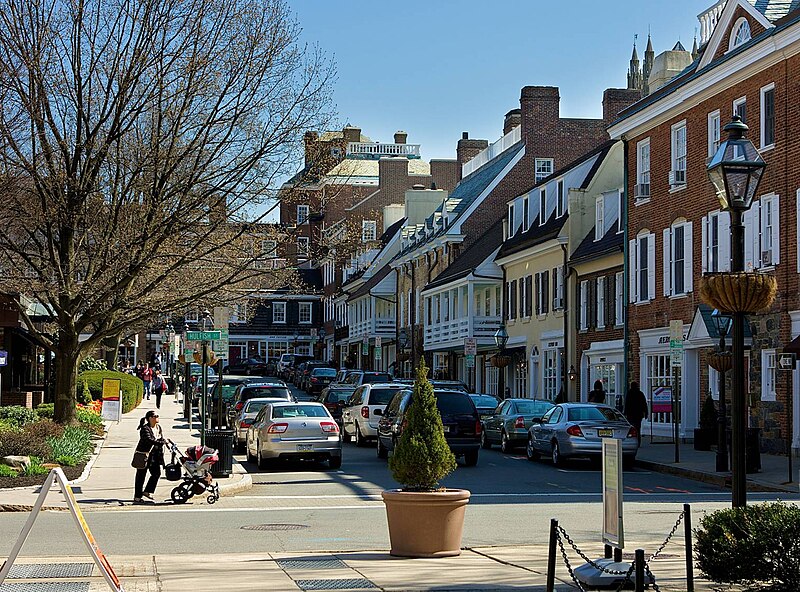 Palmer Square
Palmer SquarePrinceton, New Jersey, USA:
In Frederick Pohl and C M Kornbluth's novel Wolfbane (1959), the planet Earth has suffered two centuries of being dragged into interstellar space, warmed inadequately by an atomically kindled Moon, while the human population is divided between the majority of biddable lethargic "Sheep" and the one-per-thousand minority of energetic, assertive "Wolves". Glenn Tropile, a Wolf, fleeing from a death sentence passed upon him in Wheeling, West Virginia, finds refuge in Princeton, and notes the difference between the "Wolves" here and the "Sheep" of Wheeling:
Tropile walked through the town in the evening light...
There were other walkers in the street. Their gait was not the economical shuffle with pendant arms. They burned energy visibly. They swung. They strode. It had been painted on his brain in earliest childhood that such walking was wrong, reprehensible, silly, debilitating. It wasted calories. These people did not look debilitated, and they didn't seem to mind wasting calories...
the Pripet Marshes, Belarus and Ukraine:
From the chapter "The Russian Ship" in Fred and Geoffrey Hoyle's novel Fifth Planet (1963):
...The ancestors of Ivan Kratov and of Nuri Bakovsky had probably moved into Russia from the direction of the Pripet Marshes about fifteen hundred years ago...
Propontis:
See the entry on Cebrenia.
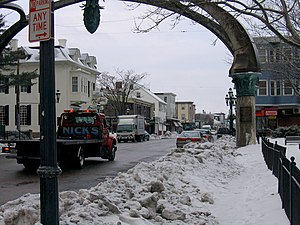 A street on Federal Hill: not quite the "spectral hump" HPL described, but still, better than nothing
A street on Federal Hill: not quite the "spectral hump" HPL described, but still, better than nothingProvidence, Rhode Island, USA:
This is H P Lovecraft's hometown; where he was born and where he is buried. Though the house where he was born (at 454 Angell Street) was demolished in the 1960s, there are still many Lovecraft links in Providence.
From The Haunter of the Dark (Weird Tales, December 1936):
Blake's study, a large southwest chamber, overlooked the front garden on one side, while its west windows - before one of which he had his desk - faced off from the brow of the hill and commanded a splendid view of the lower town's outspread roofs and of the mystical sunsets that flamed behind them. On the far horizon were the open countryside's purple slopes. Against these, some two miles away, rose the spectral hump of Federal Hill, bristling with huddled roofs and steeples whose remote outlines wavered mysteriously, taking fantastic forms as the smoke of the city swirled up and enmeshed them. Blake had a curious sense that he was looking upon some unknown, ethereal world which might or might not vanish in dream if he ever tried to seek it out and enter it in person...
References to Providence abound in Lovecraft's first masterpiece, The Call of Cthulhu (Weird Tales, February 1928) and his posthumously published novel The Case of Charles Dexter Ward (Weird Tales, May 1941 and July 1941).
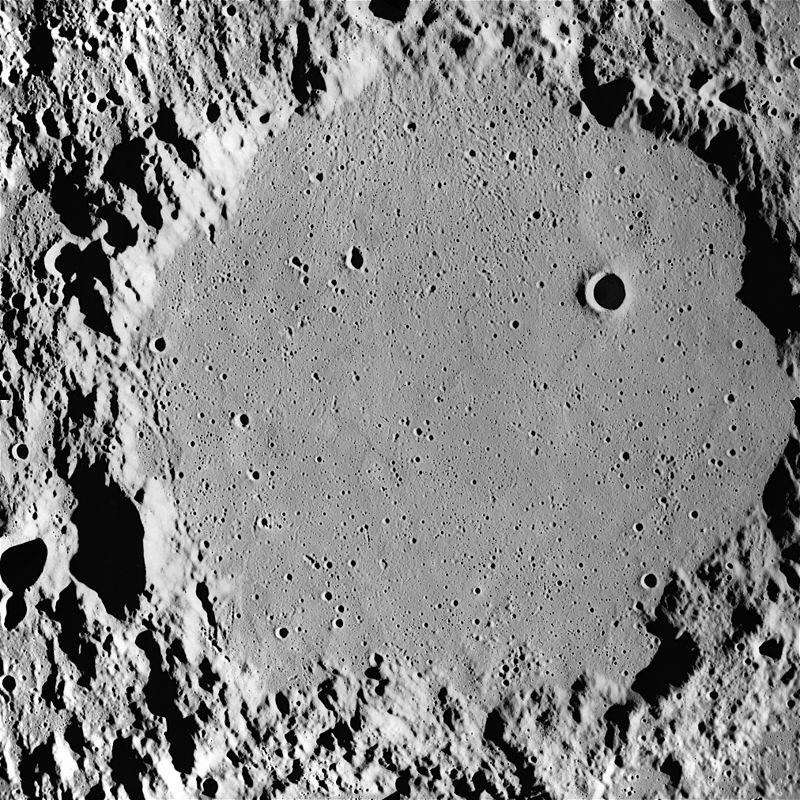 from Apollo 16
from Apollo 16Ptolemaeus (crater):
Site of the first moon-base, according to Timeliner (1955) by Charles Eric Maine.
I am going by what I wrote on the Fictional Dates page for 2029. However, to my embarrassment, I have not been able to find the reference in the book itself, though there is a mention on page 47 of one of the base's inhabitants, Bill Kyle, getting himself killed when a fall on to a jagged needle of rock in the Ptolemaeus mountains punctured his space suit and sucked the air from his lungs before he could connect the emergency oxygen feed.
Perhaps "the Ptolemaeus mountains" simply means the crater's ringwall.
The same choice of location for the same settlement occurs in Donald A Wollheim's 1959 novel The Secret of the Ninth Planet, which refers (p.8) to
...The U.S. Moon Base in the center of the Crater Ptolemaeus...
A similar importance is ascribed to the crater in James P Hogan's Inherit the Stars (1977):
Thirty minutes after clearing arrival formalities, Hunt emerged from an elevator high atop one of the viewing domes that dominated the surface of Ptolemy Main Base. For a long time he gazed soberly at the harsh desolation in which man had carved this oasis of life...
Interestingly there was a report of lunar life on the crater's floor - here is an excerpt from an article, Exploring Ptolemaeus, in Sky & Telescope's Lunar Notebook series by Charles A Wood (in the June 2002 issue):
...during the 1930s German observers reported that its color changes from gray after sunrise to olive green near full Moon, then to a yellow hue after sunset. This was cited by the eccentric British observer Valdemar Axel Firsoff as evidence of the existence of some primitive form of lunar vegetation (lichen was proposed) that would green up in response to sunlight and then wither away at sunset. Sadly for potential lunar vegetarians, Apollo samples contain neither green cheese nor green lichen.
[But, say I, none of the Apollo expeditions landed in Ptolemaeus...
The above would have belonged more fittingly on the History of Hopes page, and I would have put it there if I had been able to trace an exact date for Firsoff's report - the History of Hopes being organized chronologically.]
Pymatuning Creek, Ohio, USA:
Kenneth Farrow, suspended-animation test subject for Operation Groundhog which was supposed to last a few months, wakes unexpectedly late in Edmond Hamilton's novella Planet of Exile (Space Travel, July 1958):
...Suppose the surprise atomic attack, so long feared, had struck while he was sleeping... who would know that he, Farrow, was sleeping here?
...he stumbled out of the dark, cold vault, frantic to prove to himself that it wasn't true... stared out over the wide, shallow miles of Pymatuning Valley...
And it was all gone. All the valley as he remembered it, the roads and fields and farms and villages, the trucks and buses and cars, the distant smoke and tall buildings of Steel City. All gone.
A vast and unbroken forest rolled to the horizon, lonely under the advancing night...
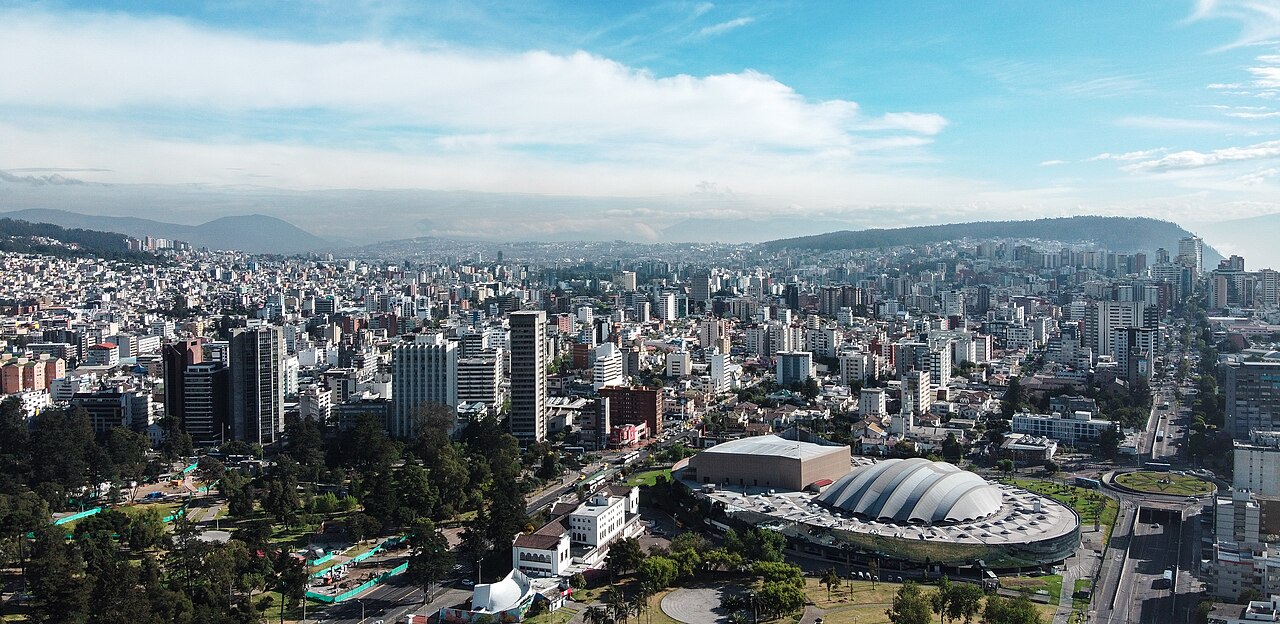
Quito, Ecuador:
This Andean city pays the penalty for its equatorial location in When the World Wend Mad by Ronald M Sherin (Amazing Stories Quarterly, Fall 1928), a disaster story in which a mad Russian scientist causes the Earth's rotation to accelerate.
On the afternoon of September 27th, 1938, the city of Quito, Ecuador, was visited by a series of phenomena never paralleled in the history of the earth...
...The first warnings of what was to follow were so inappreciable in their effects as to cause but little anxiety. In fact, the people's only sensation was one of strange exhilaration and vigor. Even the heaviest labor could be done with an amazingly small amount of exertion...
As time went by, however, this feeling of lightness grew less agreeable... in all parts of the city tramcars were leaving the rails...
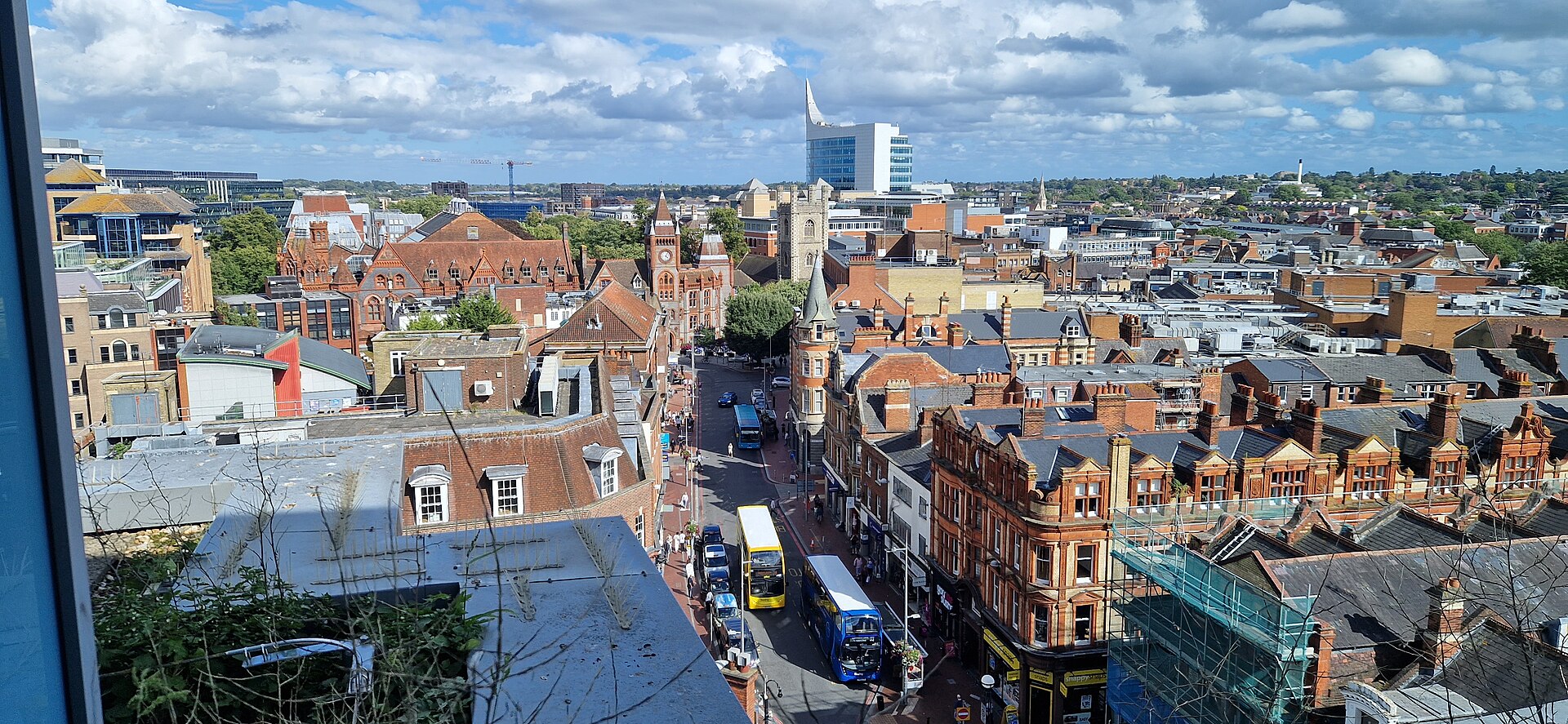
Reading, Berkshire, England:
Note from Zendexor: I have very pleasant personal memories of Reading from having attended an Open University calculus summer school at the campus in 1989, coincidentally when Voyager 2 reached Neptune.
However, the lonely narrator of M P Shiel's 1901 last-man-alive novel The Purple Cloud, Adam Jeffson, isn't so happy as, on his southward journey from the North Pole, he meets the remains of the frantic peoples of the world that mingled as they fled the deadly vapour which had spread over the globe in his absence; often he sees evidence of how they had tried in vain to lock themselves inside buildings.
...this being the town where I first observed that crush of humanity which I afterwards met in towns west of London... houses in every room of which, and on the stairs, the dead overlay each other, and in the streets points where only on bodies was it possible to step. I went into the County Gaol, from which, as I had read, the prisoners had been set free, and there found the same crowdedness, cells occupied by ten, corridors rough-paved with faces and old clothes-shops of robes; and in the parade-ground, against one wall, a mas of stuff...
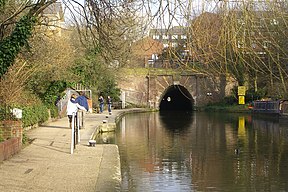
Regent's Canal, London, England:
This is where the narrator of H G Wells' The War of the Worlds (1898) hears the sudden cessation of the Martians' cry.
...I came upon the Red Weed again, and found Regent's Canal a spongy mass of dark-red vegetation.
Abruptly, as I crossed the bridge, the sound of 'Ulla, ulla, ulla' ceased. It was, as it were, cut off. The silence came like a thunder-clap.
The dusky houses about me stood faint, and tall and dim; the trees towards the park were growing black. All about me the Red Weed clambered among the ruins... Night, the Mother of Fear and Mystery, was coming upon me...
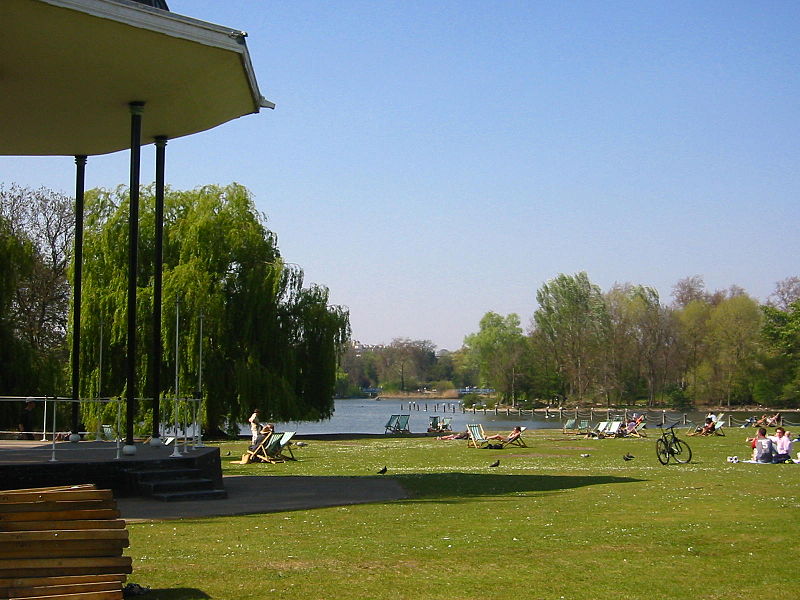
Regent's Park, London:
In Charles Eric Maine's pandemic-disaster novel The Darkest of Nights (1962), civil war breaks out as rebels fight the government responsible for setting up elite shelters. Clive Brant has been mistaken for one of the rebels and is taken to a prison camp...
...established in a vast field in Regent's Park, just north of London's West End.
The perimeter of the camp consisted of coiled barbed wire piled up to a height of eight feet or more. Several trucks were disgorging their human freight, and the prisoners were being hustled were being hustled with kicks and blows to a narrow gap in the wire...
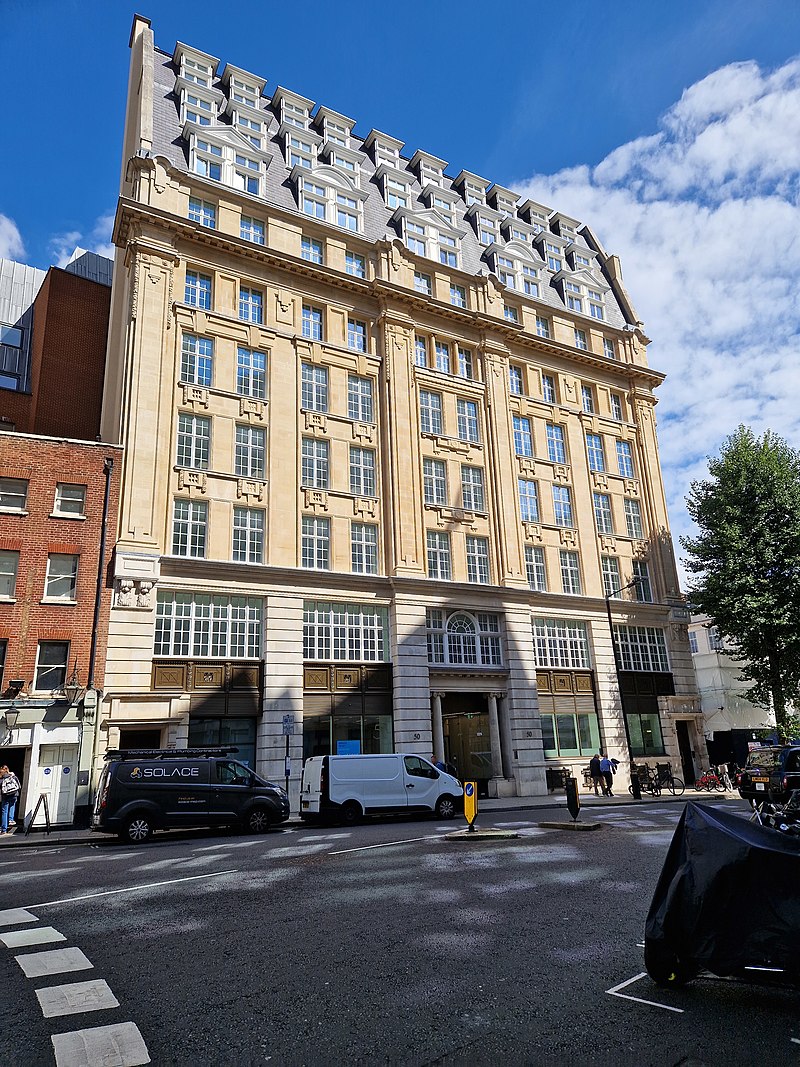 54 Broadway a.k.a Broadway Buildings: British Secret Service HQ, 1924-64
54 Broadway a.k.a Broadway Buildings: British Secret Service HQ, 1924-64
And set in the environs of the park, a scene from a different thriller-writer:
...He
shook the unfired bullets in the chamber of his gun into his cupped
hand and laid them and the gun on the table. "See you Monday. Same
time?"
"Ten o'clock'll be fine, sir," said the Instructor, jerking down the
two handles on the iron door. He smiled at Bond's back as it
disappeared up the steep concrete stairs leading to the ground floor.
He was pleased with Bond's shooting, but he wouldn't have thought of
telling him that he was the best shot in the Service. Only M. was
allowed to know that, and his Chief of Staff, who would be told to enter
the scores of that day's shoot on Bond's Confidential Record.
Bond pushed through the green baize door at the top of the basement
steps and walked over to the lift that would take him up to the eighth
floor of the tall, grey building near Regent's Park that is the
headquarters of the Secret Service...
From Moonraker (1955) by Ian Fleming
[Note: the real SIS HQ at that time, Broadway Buildings (see picture), is closer to St James' Park than to Regent's Park]
Long before all this, the narrator in H G Wells' The War of the Worlds (1898) comes to the Park during his wanderings through "dead London":
...I wandered on... and so came out at last upon Regent's Park. And as I emerged from the top of Baker Street, I saw far away over the trees in the clearness of the sunset the hood of the Martian giant from which all this howling proceeded. I was not terrified. I came upon him as if it were a matter of course. I watched him for some time, but he did not move. He appeared to be standing and yelling, for no reason that I could discover...
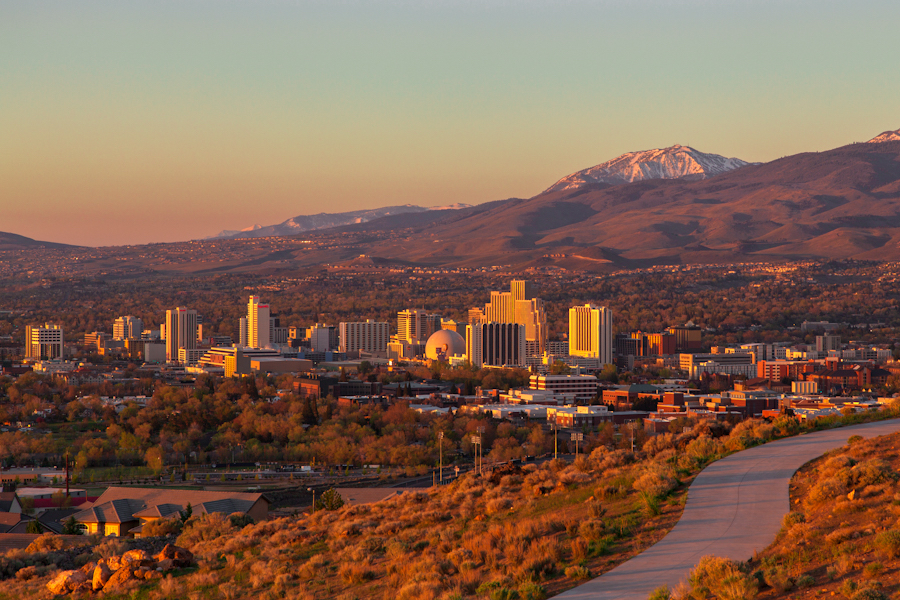
Reno, Nevada, USA:
This is where the reader is introduced to the "fake papoola" in Philip K Dick's rather complex 1964 novel The Simulacra. Chapter 5 begins:
In the little building at the back of Jalopy Jungle Number Three, Al Miller sat with his feet up on the desk, smoking an Upmann cigar and watching passers-by, the sidewalk and people and stores of downtown Reno, Nevada. Beyond the gleam of the new jalopies parked with flapping banners and streamers cascading from them he saw a shape waiting, hiding beneath the huge sign that spelled out LOONY LUKE.
And he was not the only person to see the shape; along the sidewalk came a man and woman with a small boy trotting ahead of them, and the boy, with an exclamation, hopped up and down, gesturing excitedly. "Hey, Dad, look! You know what it is? Look, it's the papoola."
"By golly," the man said with a grin, "so it is. Look, Marion, there's one of those Martian creatures..."
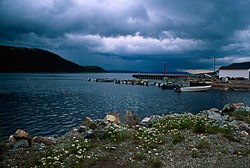
Rigolet, Labrador, Canada:
It's not surprising that the name has been shortened to "Rigo" in John Wyndham's post-apocalypse novel The Chrysalids (1955), set thousands of years in the future, when Labrador is one of the few places on Earth where what we today might call normal, un-mutated people can live (though the book calls into doubt whether "normal" is a term that can still meaningfully be used). One thing appears not to have changed: Rigo is still the capital of Labrador and the seat of executive authority. However, the state doesn't seem to be very powerful or centralised, while the level of technology has not recovered anywhere near pre-disaster levels; the people of Labrador havesteam power but no electric power.
...it was not only small children who lived in nervous awareness of the Fringes people not so far away. Their existence had become a dangerous nuisance and their depredations the cause of many representations to the Givernment in Rigo.
For all the good the petitions did, they might never have been sent. Indeed, with no one able to tell, over a stretch of five or six hundred miles, where the next attack would come, it is difficult to see what practical help would have been given...
Rima Hyginus - see Hyginus Cleft.
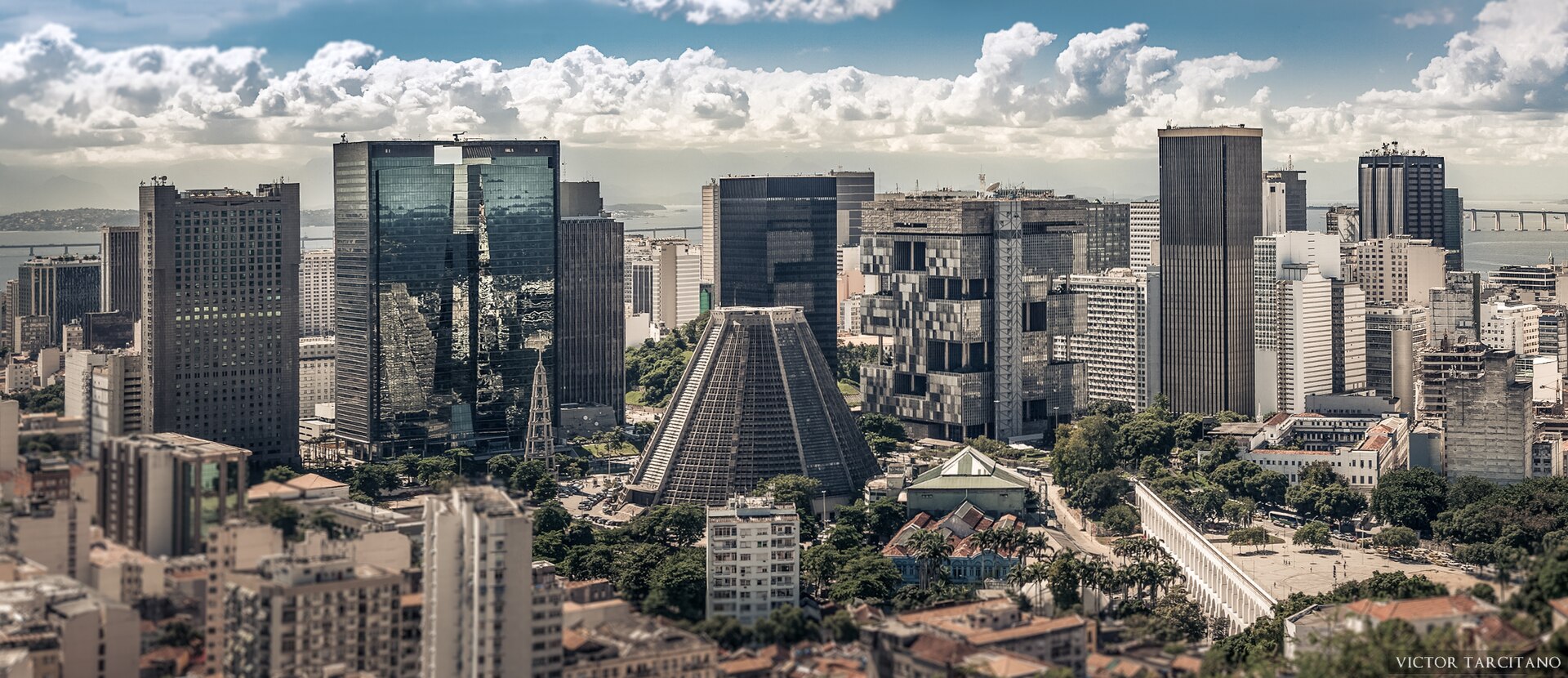
Rio de Janeiro, Brazil:
One of the places hard hit by the "cosmoquake" of 1992, in the 1945 Thrilling Wonder Stories tale by Murray Leinster, Things Pass By - in which the Earth is threatened by the gravitational "backwash" of superluminal alien craft hurtling through the System.
...the streets were crowded. It was a normal, brisk autumn morning. Then, suddenly, for just one and a half seconds, everything in the city strained savagely toward the northeast. The crowds... piled up in kicking masses against brick walls, or through place-glass windows... Buildings leaned... Everything, animate and inanimate, acted as if the city had been turned on edge. Everything fell toward the abyss which was the horizon.
In the forests outside the city the jungle trees leaned and crashed. The waters of the great estuary which is the River of January began a mighty surge. For one and a half seconds.
Then the impulse ceased and reversed...
Twenty-sixty-century Rio provides a scene in Poul Anderson's Mirkheim (1977):
...Evening was stealing across Rio de Janeiro Integrate. From his high perch his gaze swept over the flowing lines and rich tints of skyscrapers, bold silhouettes of Sugarloaf and Corcovado, bay agleam as if burnished,
Niterói
bridge an ethereal tracing. Cars torrented along streets and elevated roads below him, wove an intricate dance through the flight lanes above...
Rostov, Russia:
Regarding the Russian decision in accordance with "Popkin's Theorem" to include a woman in the expedition to the intruding planet Achilles, in Fred and Geoffrey Hoyle's Fifth Planet (1963):
...Without the work of Nicolai Popkin, a young mathematician from Rostov, a proposal to include a woman would have been regarded as an amusing and welcome joke by the higher committees, but it would not have been taken seriously...
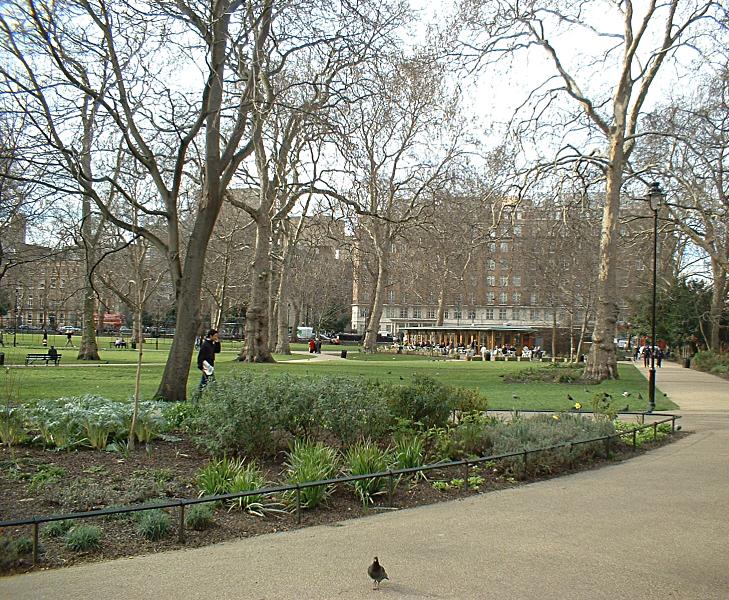
Russell Square, London, England:
The narrator in John Wyndham's post-disaster classic The Day of the Triffids (1951), as he takes the evening air, is wary of the deadly walking plants:
Before I went into the Russell Square garden I looked it over carefully. I had already begun to be suspicious of open spaces. Sure enough I spotted one triffid. It was in the north-west corner, standing perfectly still, but considerably taller than the bushes that surrounded it. I went closer, and blew the top of it to bits with a single shot. The noise in the silent Square could scarcely have been more alarming if I had let off a howitzer. When I was sure that there were no others lurking I went into the garden and sat with my back against a tree.
I stayed there perhaps twenty minutes. The sun was low, and half the square was thrown into shadow. Soon I would have to go in. While there was light I could sustain myself; in the dark, things could steal quietly upon me. Already I was on my way back to the primitive...
Less apocalyptic is the way the Square figures in Dan Morgan's The Uninhibited (1961), a novel of secret interstellar influences. Lockyer is an official of the undercover contingent from the planet Lessigia, here to prevent destabilising outbreaks of telepathic power among Earthlings.
...Lockyer lived in a street near Russell Square. The cafes and provision shops of the busy little backwater had a continental air, in contrast with the defiant Britishness of its two public houses with the frosted glass and mahogany stained fronts...
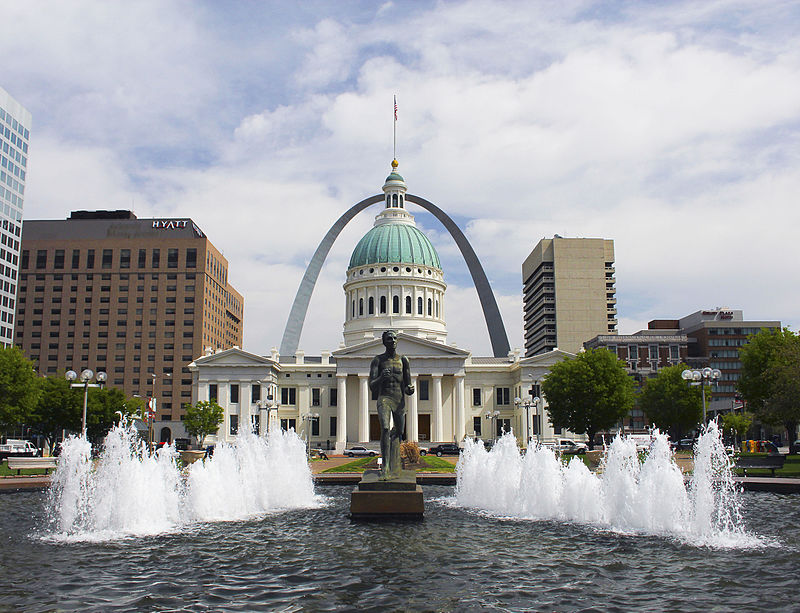
St. Louis, Missouri, USA:
The location of the provisional capital of the USA after the revolution which ousts the regime of the Prophet, in Robert A Heinlein's If This Goes On - (1940, 1953).
Temporary capital was set up at St Louis, for its central location... We took over the Prophet's proctor base there, restoring to it its old name of Jefferson Barracks. We took over the buildings of the University, too, and handed back to it the name of Washington. Of the people no longer recalled the true significance of those names, they soon would and here was a good place to start...
Over future centuries the city's name has undergone modification in Stanley G Weinbaum's Dawn of Flame (Thrilling Wonder Stories, June 1939):
Three weeks in Selui had served to give Hull Tarvish an acquaintance with the place. He no longer gaped at the sky-piercing ruins of the ancient city, and he was quite at home in the town that lay beside it...
In Edmond Hamilton's Citadel of the Star Lords (Imagination, October 1956) an airman named Price, piloting a Beechcraft plane, does not yet know that he has been knocked sixty years into the future, from 1979 to 2039, by what he thinks must have been the start of World War Three, but is actually an attack from space.
...The sun sprang up and it was day. Far ahead the Mississippi gleamed. Price sent the Beechcraft at full throttle, toward St. Louis. He could not see any smoke from the great complex of city and industry that sprawled there over both banks of the river, and he could not see any bridges. But St. Louis had to be there.
It was. But it had changed since he saw it last. The high buildings were brought low, and the low buildings were mounds, shells covered with brush and fox-grape, and trees grew in the public streets and through the broken windows. The river, vast and placid, was empty except for a floating log. Obstructions along the shores might once have been docks, but were so no longer. And there was a great stillness...
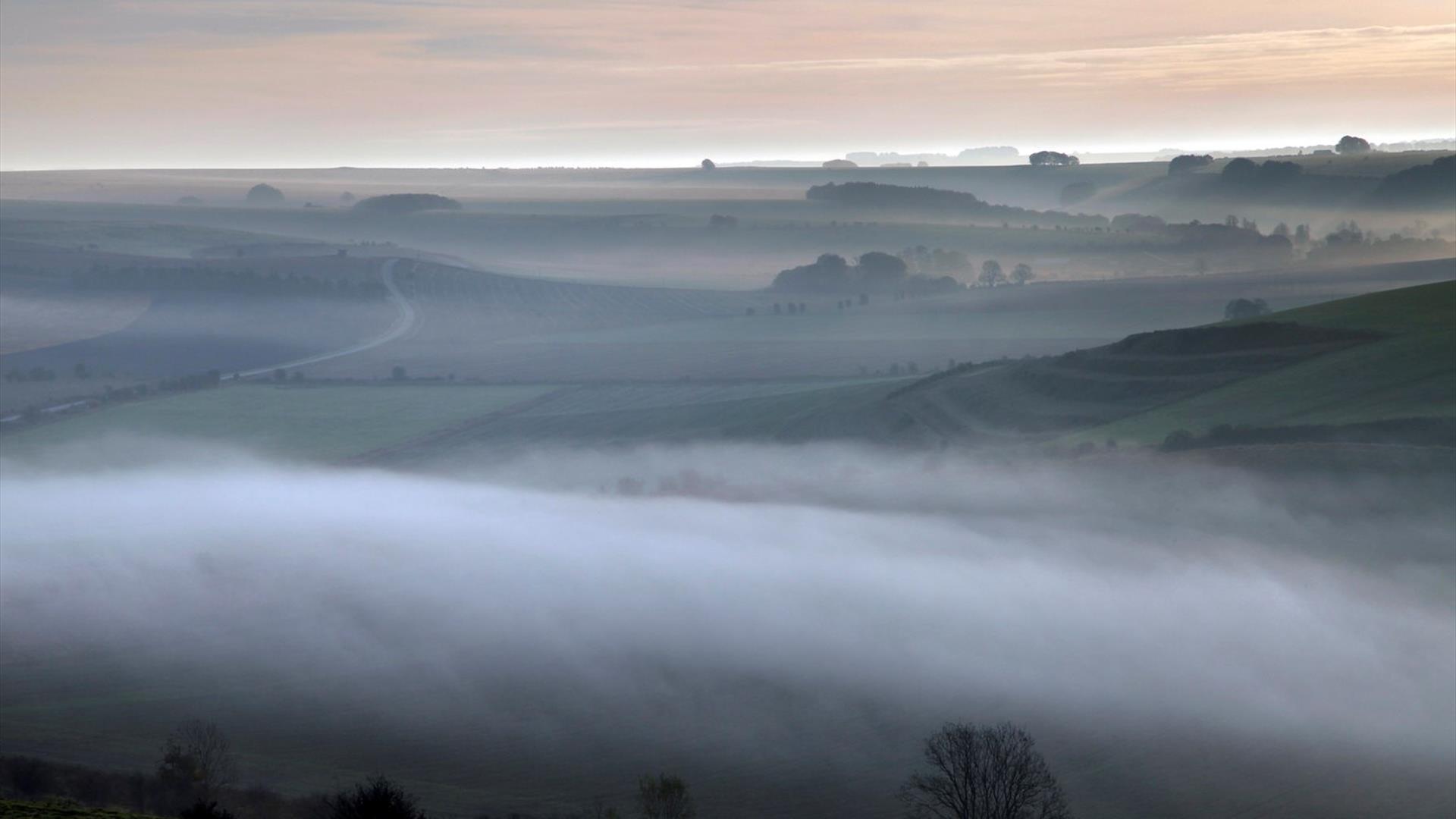
Salisbury Plain, (mostly in) Wiltshire, England:
The first Mars expedition - organized and led by a private
individual, millionaire adventurer Dale Curtance - takes off from this area, as narrated
in John Wyndham's Stowaway to Mars (1935). Chapter V, "Great Day", begins:
The
few hardy souls who had elected to spend the night upon the open
inhospitality of Salisbury Plain slept no later than dawn upon the
morning of the twelfth of October, 1981, for it was with the first rays
of sunlight that the influx which would last all day began.
The hysterical ballyhoo timed to reach its climax upon this day had
been sustained with an unsurpassed degree of journalistic art. The
birth of a son to Dale Curtance had given a fillip to interest at a
convenient moment, and every newspaper reader in the country had become
familiar with the, at present, somewhat dough-like features of Victor
Curtance. The announcement of the names of Dale's companions for the
flight had caught three unknown men and one rather more familiar figure
into an undying fulguration of publicity. Every person who could reach a
radio set had seen and heard a prince of the blood say: "I name this
ship the Gloria Mundi. May God guide her and bring safely back to us,"
and the film of the occasion had been shown at every cinema...
The Plain has a more sinister feel to it in Susan Cooper's Mandrake (1964), in which a Planetary Intelligence has reached out into the human mind to destroy civilization:
...He drove up the dark hill out of Amesbury, the Lagonda humming deeply, and out on to Salisbury Plain. The road had been climbing genly for a long time; now, suddenly, he was out on the roof of England. The darkness all round, like a black fog in the air, was the darkness not of enclosing hills or trees but of the open sky. There was no moon. He could see, beyond the down-thrown white path of his headlights, the faint bright points of stars in the night. He felt a sudden oppressive loneliness, and accelerated again... [p.80-1]
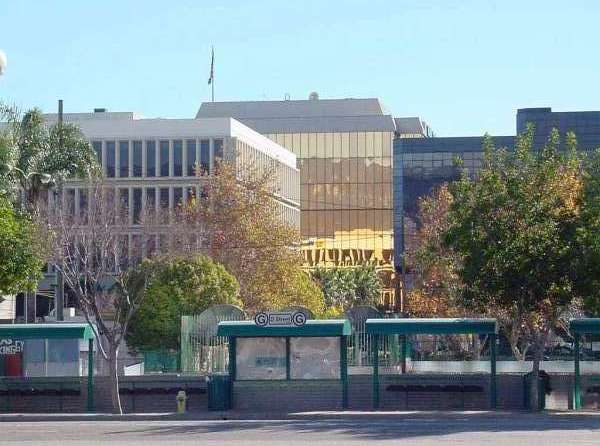
San Bernardino, California, USA:
An incident is remembered by one of the main characters in Larry Niven and Jerry Pournelle's Footfall (1985):
...It had happened several years before. Wes Dawson, two-term Congressman, stuck on the transportation safety subcommittee, interviewing bikers. He'd been young enough and new enough then to go out looking for information, rather than summoning the interested parties to Washington to testify to a committee.
And in a San Bernardino bar, Wes Dawson had let a Hell's Angel get his goat, and took a swing at the bloated barbarian, and was about to get his head stomped in, which would have been bad, and in the newspapers, which would have been worse, when Hairy Red the Minstrel made a joke of the whole affair and hustled Wes out of the bar...
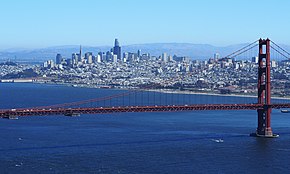 (the Bridge hadn't yet opened when CAS' tale appeared, but it would open later in the decade)
(the Bridge hadn't yet opened when CAS' tale appeared, but it would open later in the decade)San Francisco, California, USA:
A visit to a bookshop turns bad for Clark Ashton Smith's narrator in The Hunters From Beyond (Strange Tales, October 1932):
I have seldom been able to resist the allurement of a bookstore, particularly one that is well supplied with rare and exotic items. Therefore I turned in at Toleman's to browse around for a few minutes. I had come to San Francisco for one of my brief, biannual visits, and had started early that idle forenoon to an appointment with Cyprian Sincaul, the sculptor, a second or third cousin of mine, whom I had not seen for several years...
The little shop was empty of customers. Knowing my proclivities, the owner and his one assistant became tacitly non-attentive after a word of recognition, and left me to rummage at will among the curiously laden shelves. Wedged in between other but less alluring titles, I found a de lucoupxe edition of Goya's 'Proverbes'...
It has always been incomprehensible to me that I did not shriek aloud with mindless, overmastering terror, when I happened to look up from the volume...
George R Stewart's classic post-disaster novel Earth Abides (1949) is largely set in the area of San Francisco.
On pages 28-9, we are in the immediate aftermath of the pandemic that has wiped out almost all of mankind:
...he sat on the porch in the dark. In spite of his meal he felt unsteady, and he realized that he was suffering from shock.
San Lupo Drive was high enough on the slope of the hills to be proud of its view. As he sat there looking out, everything seemed just about the same. Apparently the processes behind the production of electricity must be almost completely automatic. In the hydro-electric plants the flow of water was still keeping the generators in motion. Moreover, when things had started to go to pieces, someone must have ordered that the street-lights be left turned on. Now he saw beneath him all the intricate pattern of the lights in the East Bay cities, and beyond that the yellow chains of light on the Bay Bridge, and still farther through the faint evening mist, the glow of the San Francisco lights and the fainter chains on the Golden Gate Bridge. Even the traffic-lights were still working, changing from green to red. High upon the bridge-towers the flashes silently sent their warnings to aeroplanes which would no longer ever be flying...
Much later, on pages 177-8, the protagonist contemplates the Golden Gate Bridge, twenty-two years after the catastrophe:
....The towers that hid their tops in the summer clouds, the mile-long dipping cables, the interlocked massive beams of steel - no longer they cast back the morning sun with a bright sheen of silver-grey. Over them now rested softly the neutral pall of rust, red-brown colour of desolation. Only, at the tops of the towers, and along the cables at good spots for perching, the quiet monotone was capped and spitted with the dead-white smears of the droppings of birds...
...And on the piers the rats scurried, and fought, and bred and nested...
...The broad roadway, unused, showed few signs of change - only roughnesses and a few cracks here and there. Where blown dust had settled into cracks and corners, a little grass was growing, and a few hardy weeds, not many.
...Within its deeper structure also, the bridge was still intact and unchanged. The superficial rust had done no more than wipe out a small fraction of the safety factor...
The city is the location of "the Refuge", an enclosure within which conditions replicate those on Venus, in the opening chapter of Philip K Dick's The World Jones Made (1956):
The temperature of the Refuge varied from 99 degrees Fahrenheit to 101 degrees Fahrenheit. Steam lay perenially in the air, drifting and billowing sluggishly. Geysers of hot water spurted, and the "ground" was a shifting surface of warm slime...
Outside lay San Francisco, the nocturnal city half-asleep in its blanket of chill fog. Occasional cars crept here and there; pockets of commuters emerged like segmented worms from underground monorail terminals. Infrequent office lights glowed sparsely... Louis turned his back on the sight. It hurt too much to see it, to know that he was in here, trapped, caught within the closed circle of the group. To realize that nothing existed for them but the sitting and staring, the empty years of the Refuge...
A fanatical cop named Ihren, who is determined to pursue criminals even if they have escaped into the past, pressures a professor to accompany him to view the evidence, in Jack Finney's The Face in the Photo (Saturday Evening Post, 1962):
"...We can take a cab; with you along I can turn in a chit for it. When I went by myself I took the cable car."
"On a day like this anyone who takes a cab when he can ride the cable car is crazy enough to join the police force."
Ihren said, "Okay, tourist," and we walked all the way up to Market and Powell in silence. A cable car had just been swung round on its turntable, and we got an outside seat, no one near us; presently the car bega crawling and clanging leisurely up Powell. You can sit outdoors on the cable cars, you know, and it was nice out, plenty of sun and blue sky, a typical late summer San Francisco day. But Ihren might as well have been on the New York subway...
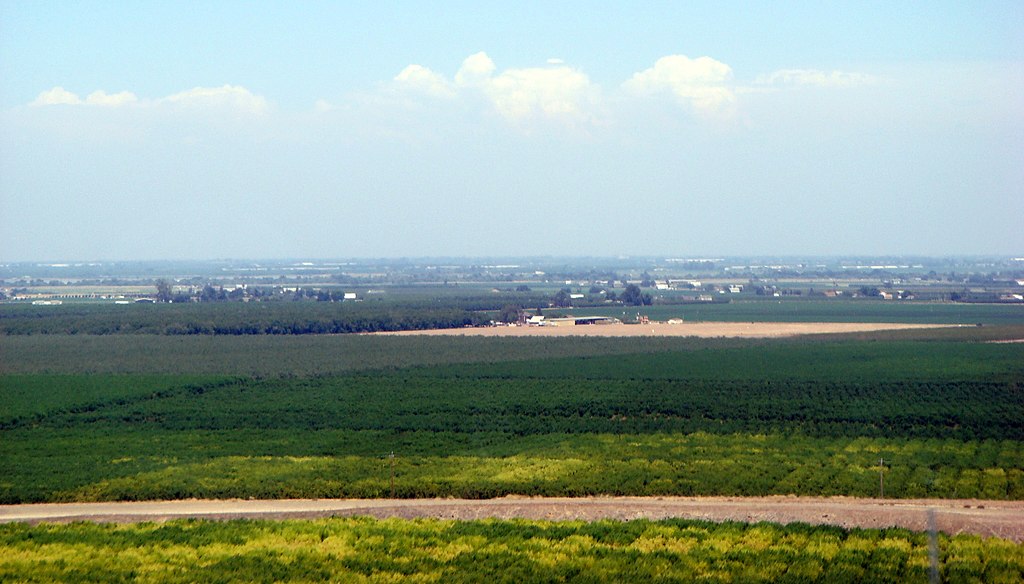
the San Joaquin Valley, California, USA:
Isherwood Willias drives through shortly after the pandemic that has killed off most of mankind in Earth Abides (1949) by George R Stewart.
He followed the Highway 99 south through the San Joaquin Valley. Although he drove slowly, he made excellent mileage. He did not have to slow down behind a truck, or to stop for traffic-lights (though most of them were still functioning), or to reduce speed for towns. In fact, in spite of his apprehensions, he had to admit that driving Highway 99 under these conditions was much safer than driving it through thick and madly speeding traffic.
He saw no man. If he had searched through the towns, he might have found someone, but there was no use of it now. A straggler here or there he might pick up at any time. How he was searching to see whether some greater remnant might be left somewhere.
The broad plain stretched away - vineyards, orchards, fields of melons, fields of cotton. Perhaps a farmer's eye could have seen that already everything showed neglect, and the absence of the hand of man, but to Ish it all still looked the same...
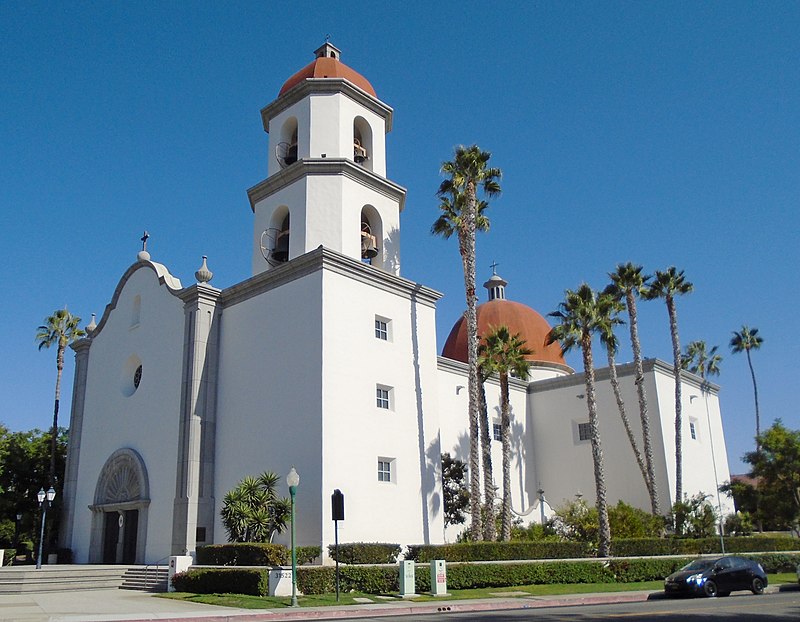
San Juan Capistrano, California, USA:
After the shattering nuclear attack on the USA at the start of The Earth Killers (Super Science Stories, April 1949) by A E van Vogt, the protagonist, a pilot named Morlake who while test-flying a new plane witnessed the bombing of Chicago, is suspected of involvement and becomes a fugitive from authority as he seeks those responsible.
...At dawn, on this third morning in the arroyo, Morlake made sure the radar screen was blank, and then flew in a great circle around the Capistrano radar station...
Later, some in officialdom begin to change their minds about the rogue pilot:
"...our radar station at Capistrano saw the image of the enemy spaceship which was searching for Morlake, and so we had definite evidence that what he stated in his letter was correct.
"When Capistrano saw it, the spaceship was about two hundred miles up. They couldn't estimate the speed, but it was terrific."
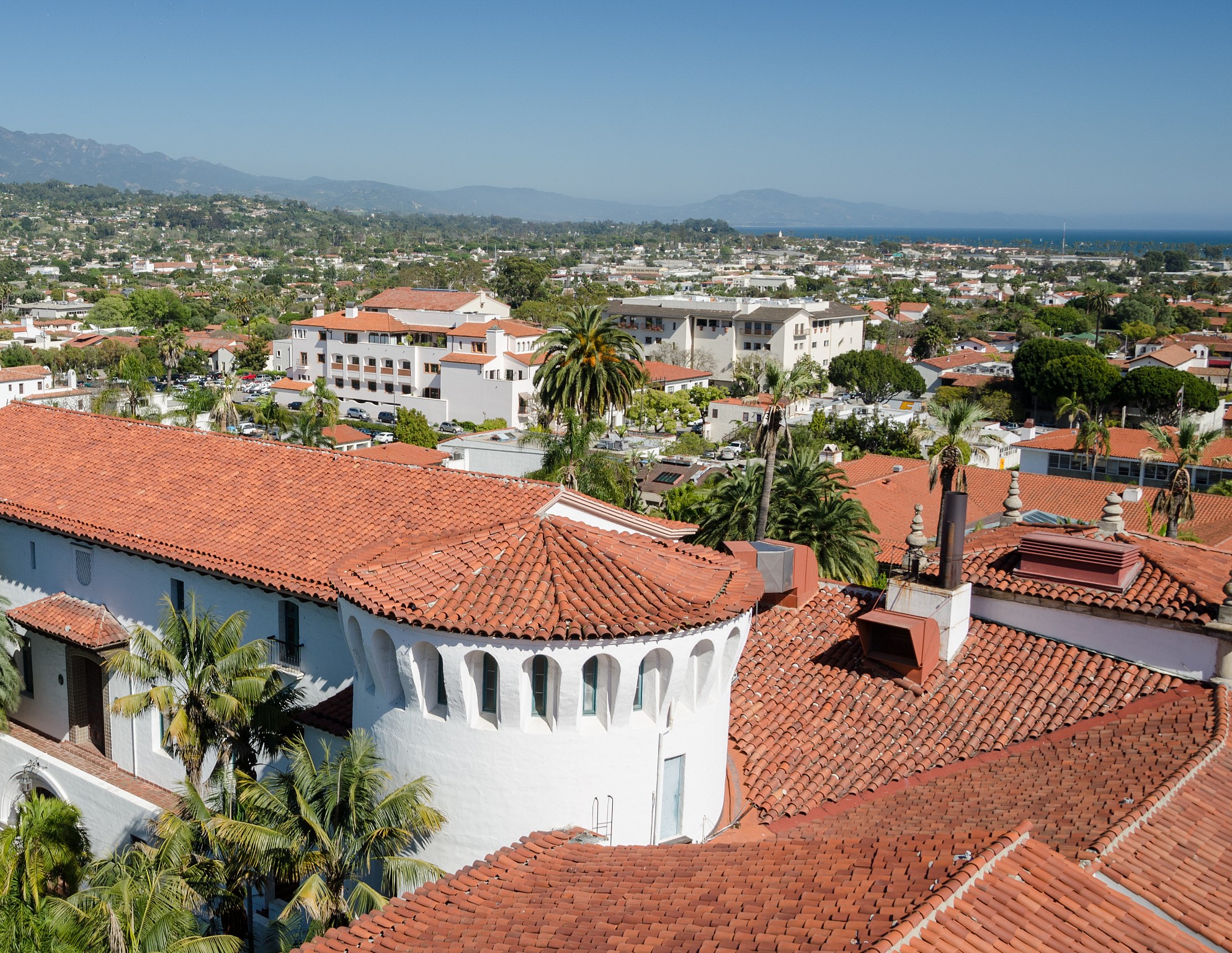
Santa Barbara, California, USA:
A genetically-engineered monstrosity lurks nearby in Watchers (1987), an sf/horror novel by Dean R Koontz, in which the 30-year-old heroine, Nora Devon, after a secluded upbringing by her repressive aunt Violet, has just begun to emerge into society.
...At the county courthouse she paused to admire the yellow blossoms of the yucca plants and the rich red bougainvillea that climbed the stucco wall and twined through the ornate wrought-iron grille over one of the tall windows.
At the Santa Barbara Mission, built in 1815, she stood at the foot of the front steps and studied the handsome facade of the old church. She explored the courtyard with its Sacred Garden and climbed the west bell tower.
Gradually, she began to understand why, in some of the many books she had read, Santa Barbara had been called one of the most beautiful places on earth. She had lived there nearly all her life, but because she had cowered in the Devon house with Violet and, on venturing out, had looked at little more than her own shoes, she was seeing the town for the first time. It both charmed and thrilled her...
The town is the scene of a short passage in chapter 5 of Fred and Geoffrey Hoyle's Fifth Planet (1963) about the career development of astronaut Tom Fiske, who is later chosen for the mission to the intruder-planet Achilles:
...The computer delivered its report: Tom was well within the range of physical and mental characteristics required for a candidate to space school. He was accordingly sent to the Department of Space Medicine at Santa Barbara, California.
The normal physical tests, endurance and reaction times, showed up nothing particularly unusual, nothing much different from hundreds of other well-coordinated candidates. But the results were sufficiently satisfactory for him to proceed to more advanced training. This meant acceleration tests. It was then that something really unusual began to emerge...
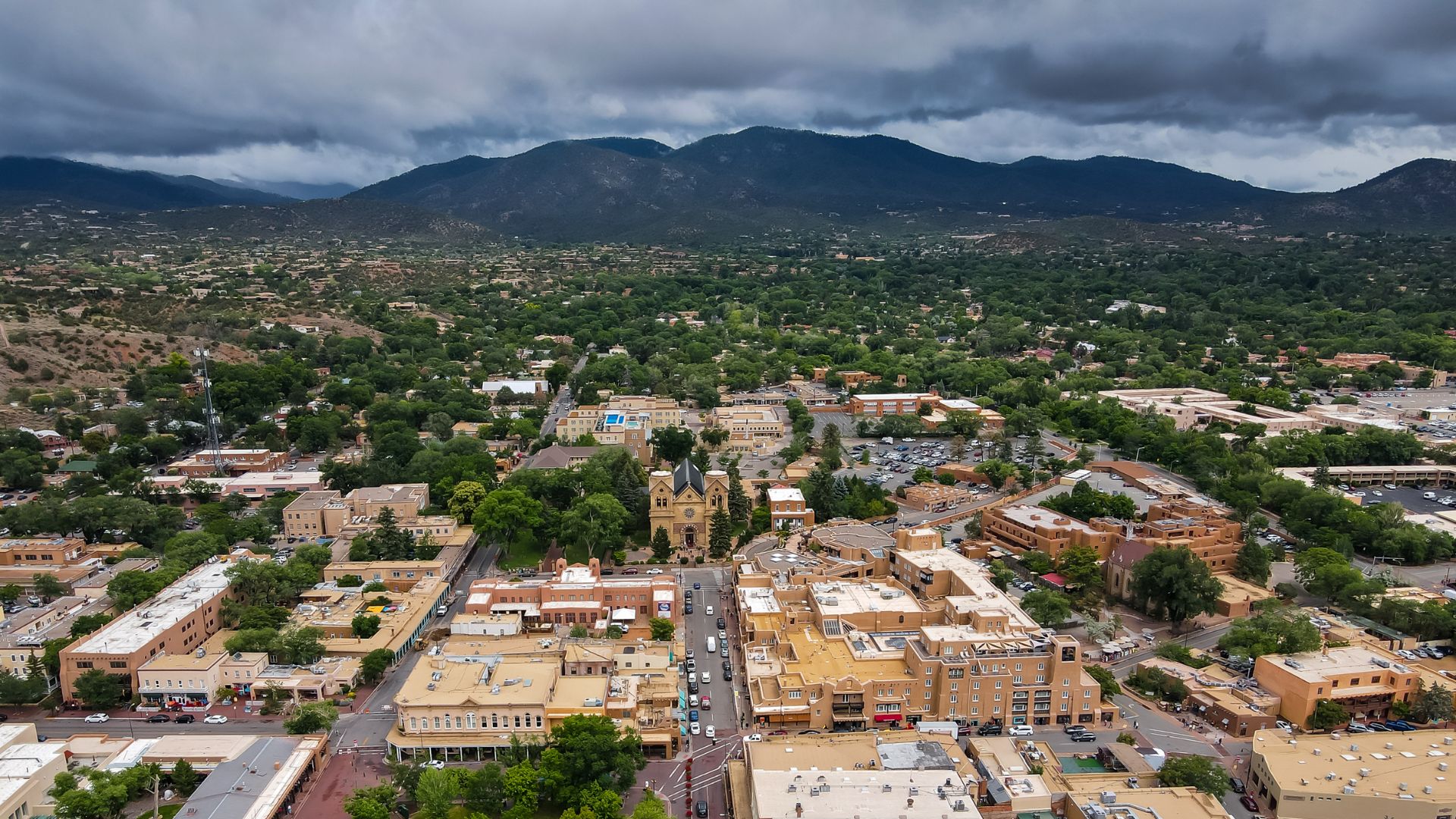
Santa Fe, New Mexico, USA:
In Jack Williamson's Seetee Shock (1949, 1950) this is where the Treaty was signed that partitioned the Solar System - see the entry and quotation from the novel in the Fictional Dates timeline for 1987.
In Robert Silverberg's Open the Sky (Galaxy, August 1967), it's the location of the Noel Vorst Center for the Biological Sciences, where research is being conducted to find ways of releasing a propulsive brain-energy to power interstellar flight.
The surgical amphitheater was a chilly horseshoe lit by a pale violet glow. At the north end, windows on the level of the second gallery admitted frosty New Mexico sunlight.
From where he sat, overlooking the operating table, Noel Vorst could see the bluish mountains in the middle distance...
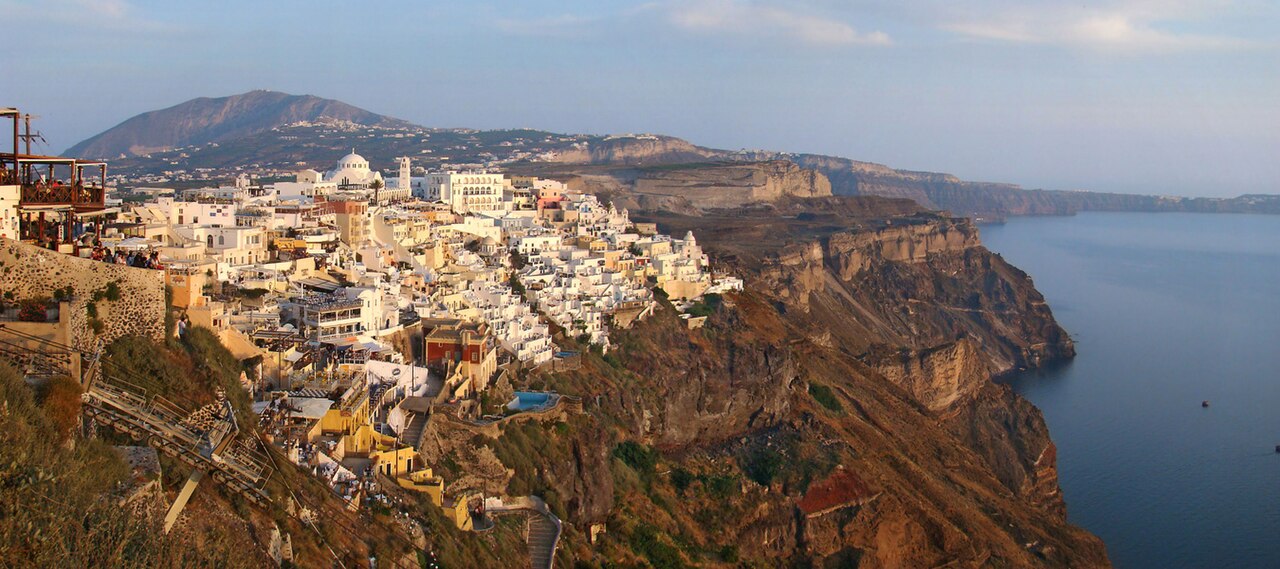
Santorini, Greece:
A comet-strike looms and a second doom for Thera/Santorini is imminent, in a scene from Niven and Pournelle's Lucifer's Hammer (1977):
Dusk faded on the waters of the bay far below. The bay was circular, surrounded by cliffs a thousand feet high, the caldera of a volcanic explosion that destroyed two thirds of the island, destroyed the Minoan Empire, created the legends of Atlantis. Now a new black island, evil in appearance and barren, rose in the centre of the bay. The Greeks called it the New Burnt Land, and the islands knew that some day it too would explode, as Thera had exploded so many times before.
Fiery streaks reflected in the bay. Something burned blue-white overhead. In the est the golden glow faded, not to black, but to a strange curdled green-and-orange glow, a backdrop for the meteors. Once again Phaeton drove the chariot of the sun...
Saratoga Springs, New York, USA:
The team fighting the "Mind Parasites" is allowed by President Lloyd C. Melville to move to "US Rocket Base 91" at Saratoga Springs, for reasons of security. See The Mind Parasites by Colin Wilson (1967).
...For the next two or three days, we spent most of the time in our hut, teaching our new pupils all we knew. Our telepathic powers made this easy. But we also came to recognize that we had overlooked one of the most important problems of phenomenology. When you teach a man that he has been completely mistaken about his own nature all his life, it is as unsettling as suddenly giving him a million pounds...
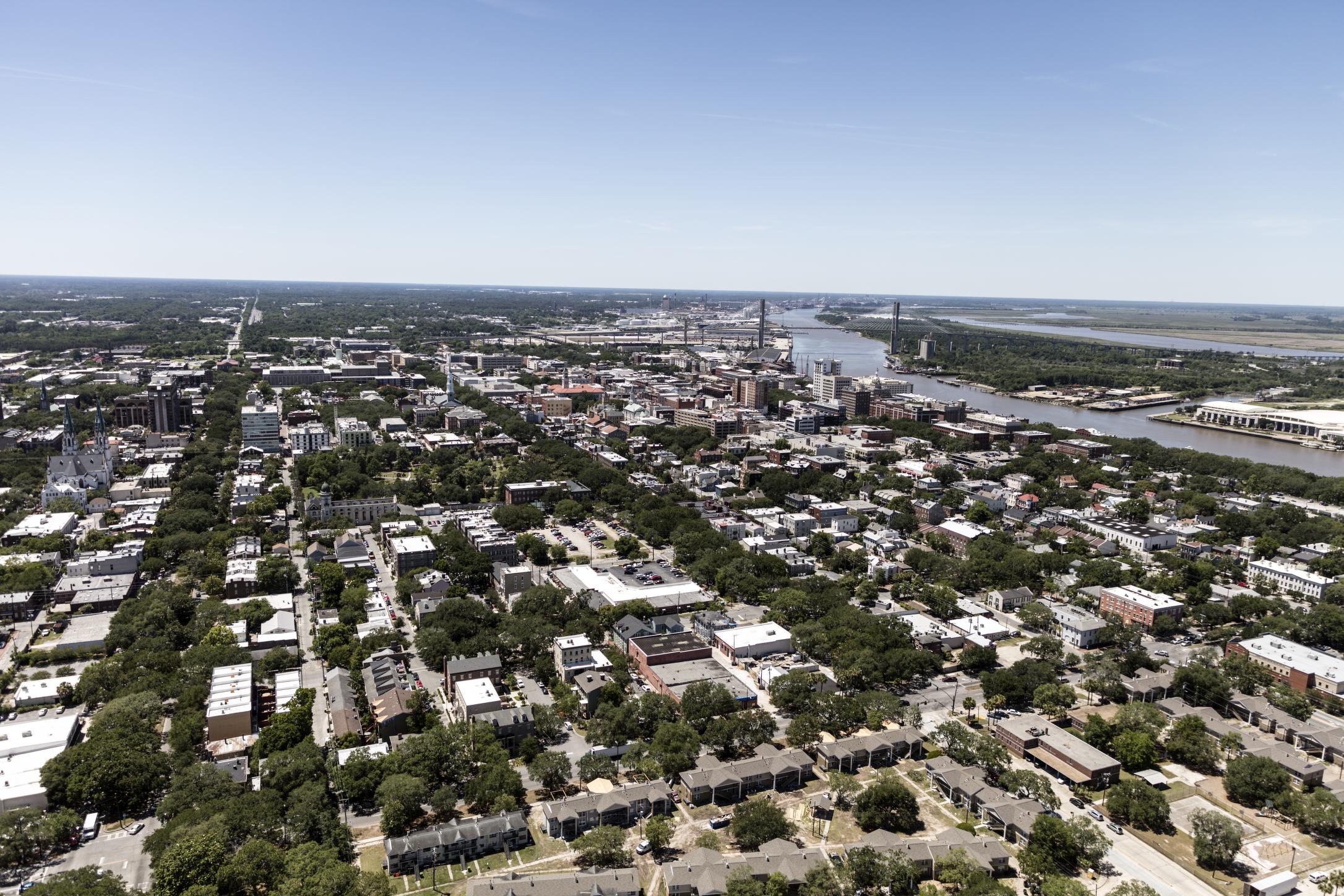
Savannah, Georgia, USA:
In Eric Frank Russell's 1955 thriller Three to Conquer, Wade Harper, the telepath employed by the Government to identify alien minds who have taken over human bodies, is chafing at his newly restricted life when he comes across a significant news item from Savannah.
...he had become fed up with being followed everywhere he went, finding G-men lounging at every street corner, occupying near-by tables in restaurants...
Monotony was broken, and faith in his purpose restored, when he arrived at the office early, spread the morning paper across his desk and found a news item tocked away at the bottom of a column inside.
Savannah, Ga. A brief but bloody gun-battle too place near here at midnight when F.B.I. agents raided the Rankovic farm. Two men were killed, four taken into custody. Two more are believed to have escaped. Declining to reveal the purpose of the raid, Area Director Stephen Maddox states that the F.B.I. acted upon direct orders from Washington.
It was a most unusual report, in several respects. For one thing, it had been played down; for another, the precise location was not stated...
Schröter (crater), Mare Insularum:
For a site in the environs of Schröter W, see Gruithuisen's Lunar City.
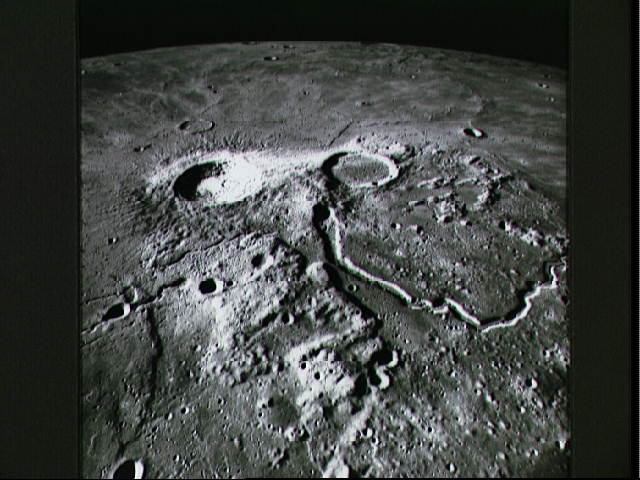 from Apollo 15
from Apollo 15Schröter's Valley:
Arthur C Clarke, writing about lunar plant life in his travelogue-of-the-future Journey By Earthlight - an essay to be found in his collection The Challenge of the Spaceship (1958) - discusses what he calls "Herodotus Valley", by which, so far as I can tell, he must mean Schroeter's (the crater Herodotus being 'next door').
...Most of the existing vegetation is found in the neighbourhood of the great lunar clefts, such as the Herodotus Valley, for traces of carbon dioxide, water vapour and sulphur dioxide occasionally gush out of these fissures - sometimes producing short-lived mists which are visible from Earth. These precious gases are eagerly trapped by the slender, cactuslike plants...
The Valley, and the Aristarchus Plateau more generally, were planned destinations for the Apollo 18 mission before it was cancelled; see Lost Moon: Reconstructing the Missions of Apollos 18, 19, and 20 (Part 1).
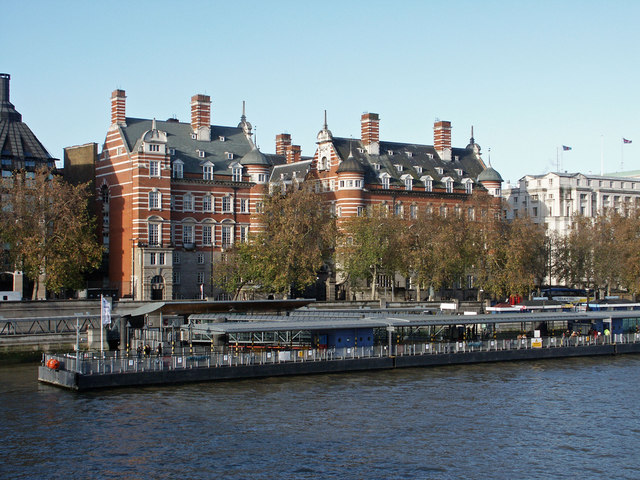
Scotland Yard, Victoria Embankment, London, England:
James Bond reflects on his appointment with Assistant Commissioner Vallance of the Metropolitan Police, in Moonraker (1955):
The courtyards and cul-de-sacs of the Yard had reminded him as usual of a prison without roofs. The overhead strip lighting in the cold corridor took the colour out of the cheeks of the police sergeant who asked his business and watched him sign the apple-green chit. It did the same for the face of the constable who led him up the short steps and along the bleak passage between the rows of anonymous doors to the waiting-room.
A quiet, middle-aged woman with the resigned eyes of someone who had seen everything came in and said the Assistant Commissioner would be free in five minutes...
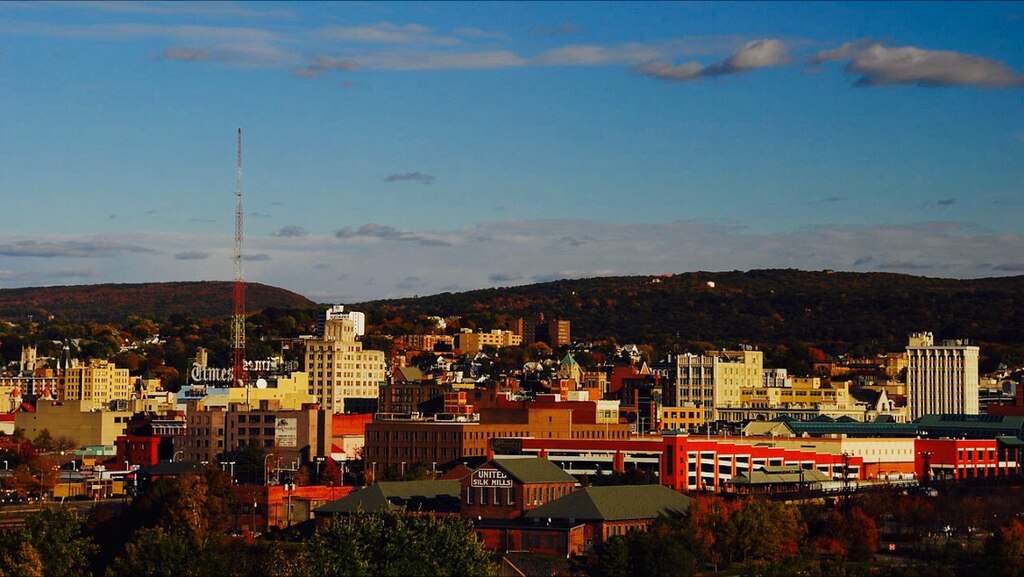
Scranton, Pennsylvania, USA:
In the late twenty-first century, this is the home town of Tom Fiske, one of the survivors of the expedition to the intruding planet Achilles in Fred and Geoffrey Hoyle's Fifth Planet (1963):
...After spending eleven of his first twelve years in an orphanage, Tom decided to chance his luck as a free-lance operator. He worked in the evening and attended high school by day. So unwilling nowadays are the inhabitants of the highly prosperous countries to engage in any form of physical activity that Tom found very little difficulty in eking out a bare living...
In James Blish's A Life for the Stars (1962), Scranton takes off - literally. The story begins:
From the embankment of the long-abandoned Erie-Lackawanna-Penn Central Railroad, Chris sat silently watching the city of Scranton, Pennsylvania, preparing to take off, and meditatively sucked the red and white clover around him.
It was a first time for each of them. Chris had known since he had been a boy - he was sixteen now - that the cities were deserting the Earth, but he had never seen one in flight. Few people had, for the nomad cities, once gone, were gone for good...
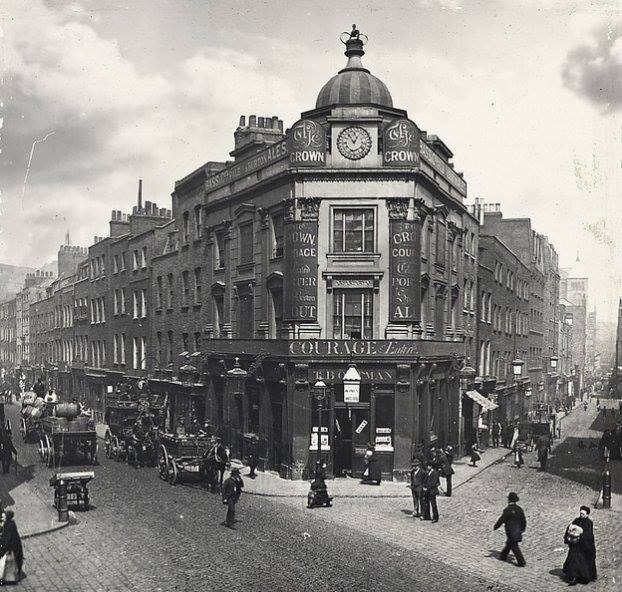 in 1900
in 1900Seven Dials, London, England:
By some mysterious means a televisual communication device from Mars has found its way to this district, as narrated in H G Wells' short story The Crystal Egg (1897):
There was, until a year ago, a little and very grimy-looking shop near Seven Dials, over which, in weather-worn yellow lettering, the name of "C. Cave, Naturalist and Dealer in Antiquities," was inscribed. The contents of its window were curiously varied...
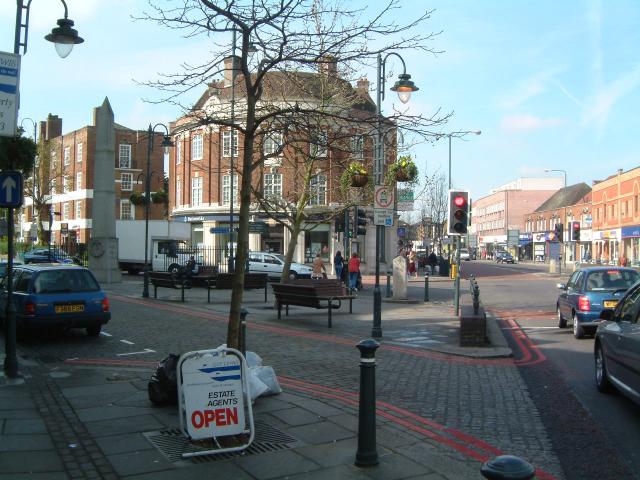
Sheen, Surrey, England [Sheen is now in the London borough of Richmond on Thames]:
A confusing place to research because it is more often called "East Sheen" and yet I can't find a "West Sheen". Historically it was the site of Richard II's palace which he destroyed in 1394 out of grief for the death of his wife. In fiction it is where the narrator is part-buried and trapped by the impact of the 5th Martian cylinder in Wells' The War of the Worlds (1898). Twenty-seven pages of the story are devoted to the tense period that follows, which includes proximity to the Handling Machine... Finally he emerges:
I hesitated for some time, and then in a gust of desperate resolution and with a heart that throbbed violently, I scrambled to the top of the mound in which I had been buried so long.
I looked about again. To the northward, no Martian was visible.
When I had last seen this part of Sheen in the daylight, it had been a straggling street of comfortable white and red houses, interspersed with abundant shady trees. Now I stood on a mound of smashed brickwork, clay and gravel, over which spread a multitude of red cactus-shaped plants, knee-high, without a solitary terrestrial growth to dispute their footing...
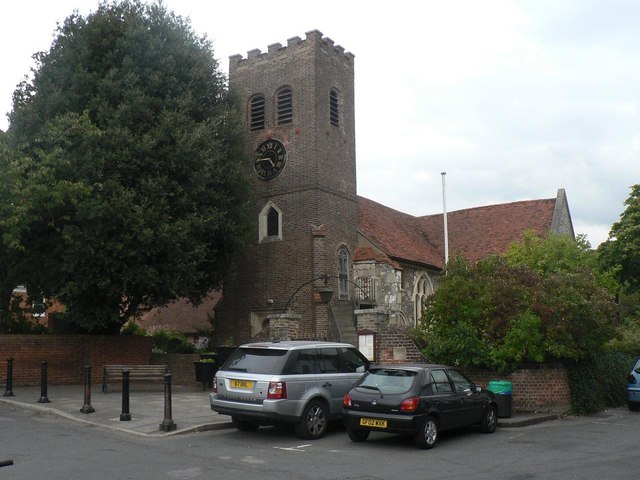 St.Nicholas Church, Shepperton. The tower must have been nicely rebuilt.
St.Nicholas Church, Shepperton. The tower must have been nicely rebuilt.Shepperton, Surrey, England:
The village suffered much damage in Book 1, Chapter 12 of The War of the Worlds (1898) by H G Wells. Defenders score a rare hit against a Martian Fighting Machine, but then:
The
decapitated colossus reeled like a drunken giant; but it did not fall
over. It recovered its balance by a miracle, and, no longer heeding its
steps, and with the camera that fired the Heat-Ray now rigidly upheld,
it reeled swiftly upon Shepperton. The living intelligence, the Martian
within the hood, was slain and splashed to the four winds of heaven,
and the thing was now but a mere intricate device of metal whirling to
destruction. It drove along in a straight line, incapable of guidance.
It struck the tower of Shepperton Church, smashing it down as the
impact of a battering-ram might have done, swerved aside, blundered on,
and collapsed with a tremendous impact into the river out of my sight...
Siberia:
This huge region figures strongly though indirectly (no scenes are actually set there) in the post-nuclear-holocaust novel Twilight World (1981) by Poul Anderson. Siberia "...set itself up as independent when the old Russian government vanished. Not being too badly hurt, and having a certain amount of industry, an energetic population, and plenty of natural resources, it came back fast - as fast as we, if not more so. It's annexed Manchuria, you can see, and Mongolia and Korea; Japan is its puppet, as are several of the North Chinese states. We don't know a great deal about it, international communication is still pretty slim, but it's a hardboiled outfit, and its Khan - well, you can learn about that later on..."
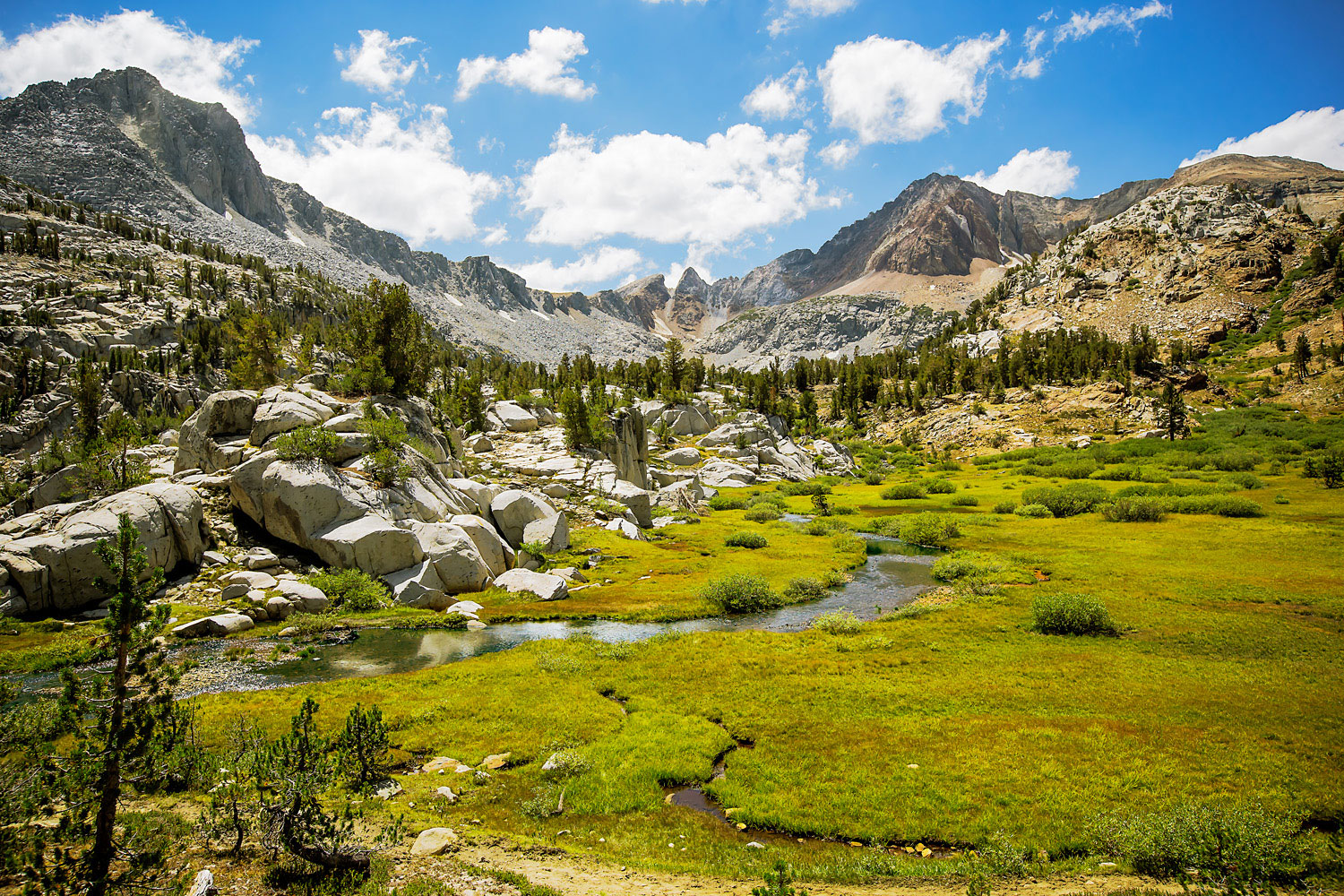
the Sierra Nevada, California, USA:
Scene of the visitation by beings from a higher dimension who need an infusion of earthier reality, in the haunting tale The Light From Beyond by Clark Ashton Smith (Wonder Stories, April 1933):
...I had decided to spend a whole year in the high Sierras. On the shore of a tiny sapphire tarn, in a valley sheltered by hemlocks and granite crags, I had built a rough cabin and had stocked it plentifully with provisions, books, and the materials of my art. For the time being, I was independent of a world whose charms and enchantments were, to say the least, no longer irresistible.
The region possessed, however, other allurements than those of seclusion. Everywhere, in the stark mountain masses and pinnacles, the juniper-studded cliffs, the glacier-moulded sheets of rock, there was a mingling of grandeur and grotesquery...
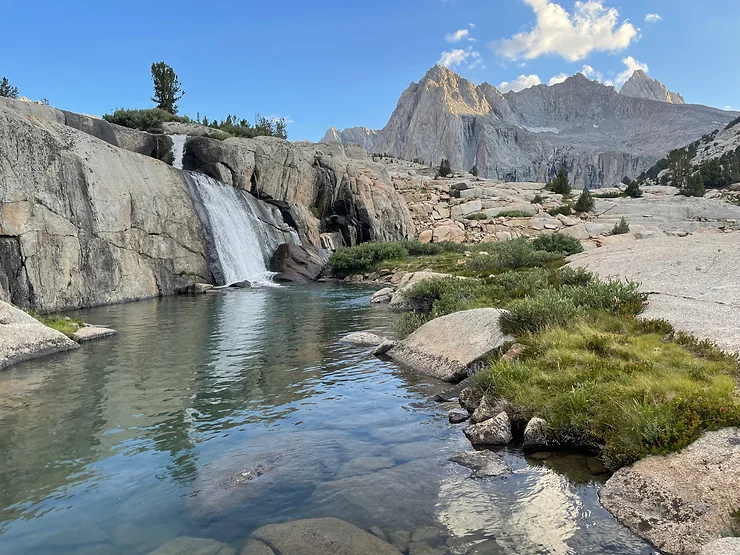 a "sapphire tarn" in the Sierra Nevada
a "sapphire tarn" in the Sierra NevadaSilver City, Idaho, USA:
From Sinister Barrier (1939) by Eric Frank Russell:
Silver City was gone; the area it once had occupied was now an enormous scar on the face of Idaho, a five-miles-wide wound dotted with wreckage through which crept, crawled and limped a pathetically small number of survivors...

Sinus Iridum: [see also Heraclides Promontory]
...As they rolled past the headland, the mighty northern wall of the Sinus Iridum - the Bay of Rainbows - swept into view. Aeons ago the Sinus Iridum had been a complete ring mountain - one of the largest walled plains on the Moon. But the cataclysm which had formed the Sea of Rains had destroyed the whole of the southern wall, so that only a semicircular bay is now left. Across that bay Promontory Laplace and Promontory Heraclides stare at each other, dreaming of the day when they were linked by mountains...
Wheeler was very quiet as the tractor rolled past the great cliffs, which stood like a line of titans full-face towards the Earth. The green light splashing down their flanks revealed every detail of the terraced walls...
Arthur C Clarke, Earthlight (1955)
Contestants in specially designed suits run across the Sinus Iridum during lunar night in the same author's 1993 novel The Hammer of God:
...For a moment, time slowed down at a crawl. He was aware of the great, glowing plain stretching out to the unbroken curve of the horizon. The Earthlight slanting over his right shoulder gave the extraordinary illusion that the Sinus Iridum was covered with snow...
John Wyndham in The Red Stuff (Marvel Science no.1, 1951) tells of a horrid gelatinous plague first discovered in the Asteroid Belt.
...Whatever the cost, this substance must be prevented from spreading; above all, no grain of it must be allowed to reach Earth.
Volunteers are already fighting and dying on the Moon in order that that shall now happen...
If anyone doubts the necessity of the sacrifices he may have to make, let him look through even a low-powered telescope at the Moon. A little east of Plato in the semi-circle of the Sinus Iridum, where Clarke Lunar Station used to exist, he will see a bright scarlet patch already flowing out across the Mare Imbrium...
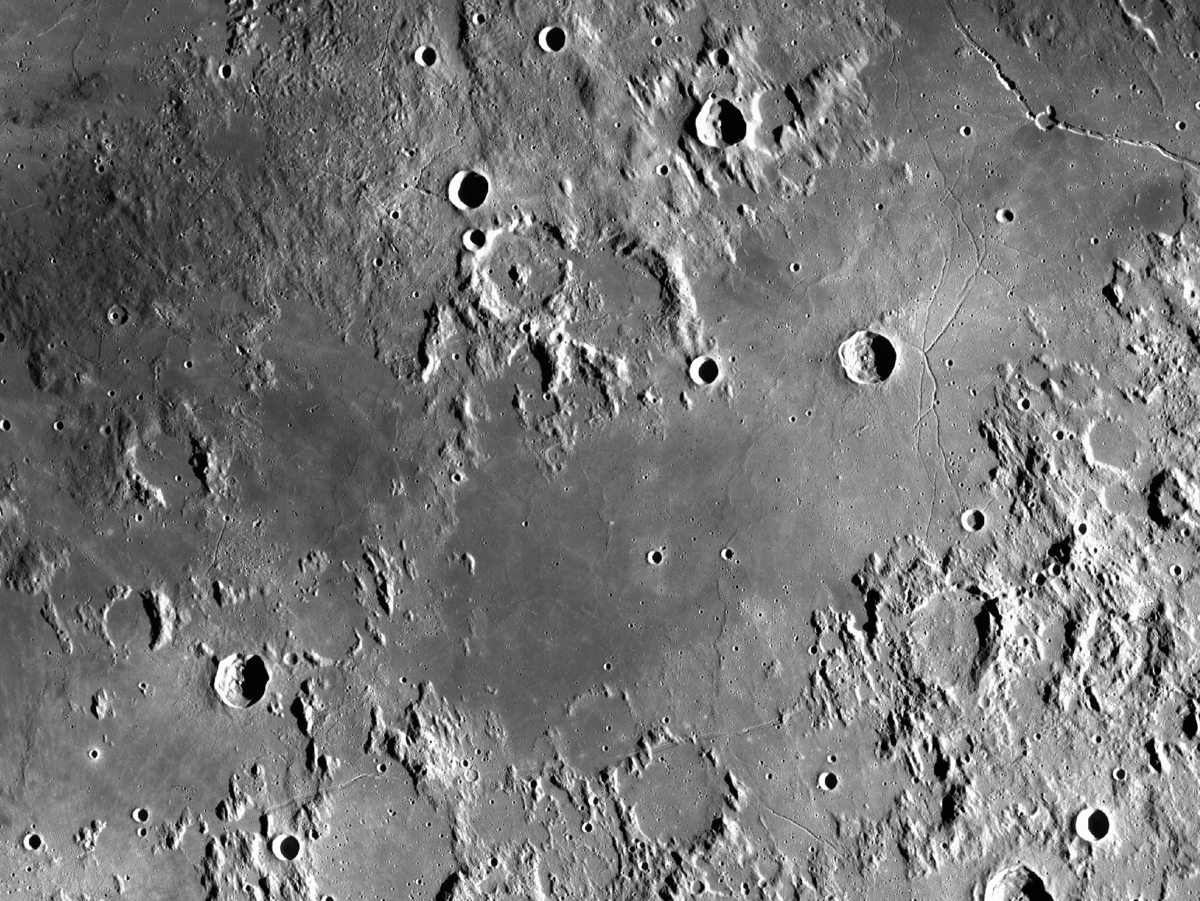
Sinus Medii:
Location of Central City, metropolis of the lunar colony, in Arthur C Clarke's Earthlight (1955).
...The cluster of great domes began to hump themselves over the horizon. A beacon light burned on the summit of each, but otherwise they were darkened and gave no sign of life. Some, Sadler knew, could be made transparent when desired. All were opaque now, conserving their heat against the lunar night.
The monocab entered a long tunnel at the base of one of the domes. Sadler had a glimpse of great doors closing behind them - then another set, and yet another. They're taking no chances, he thought to himself...
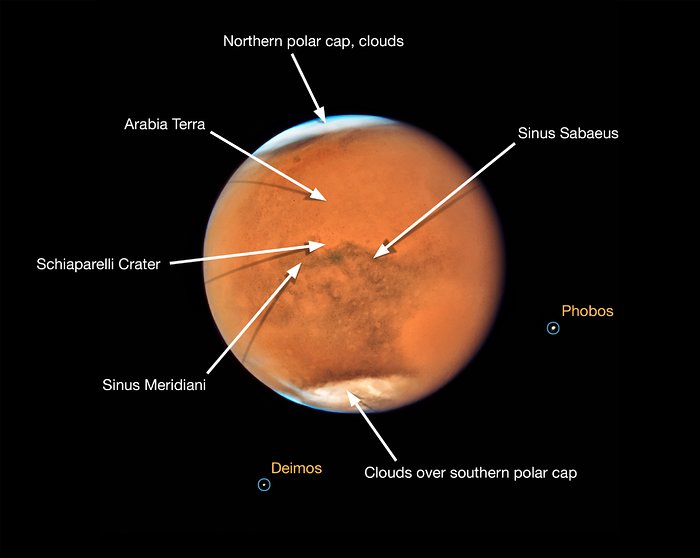 during a dust storm in 2018
during a dust storm in 2018Sinus Meridiani:
This is the general region in which Mars' Eden lies, in The Valley where Time Stood Still (1974) by Lin Carter.
...Comparing the old silver plate to CA survey charts he had seen, M'Cord realized that if the Valley existed at all, which was probably the case, it was deep in the very center of a region the Earthmen knew as Meridiani Sinus, which lay due west of the Sabaeus... [p100; see Airy]
And on p.127:
...In the brilliant dry clarity of the thin air, from his height, you could see the entirety of the Meridiani Mesa and a dim, blurred glimpse of the dustlands that ringed it on three sides. This must be one of the highest elevations on the planet, thought M'Cord. He was sweating again: whatever the mystery of Ophar was, they were about to get their first glimpse of it...
We're given a briefer mention of the same areographical feature when author Martin Gibson looks down on the Red Planet as he waits to be ferried down from Deimos, in the early masterpiece The Sands of Mars (1951) by Arthur C Clarke:
...Let's see - there was the double fork of the Sinus Meridiani (very convenient, that, smack on the equator and in zero longitude) and over to the east was the Syrtis Major...
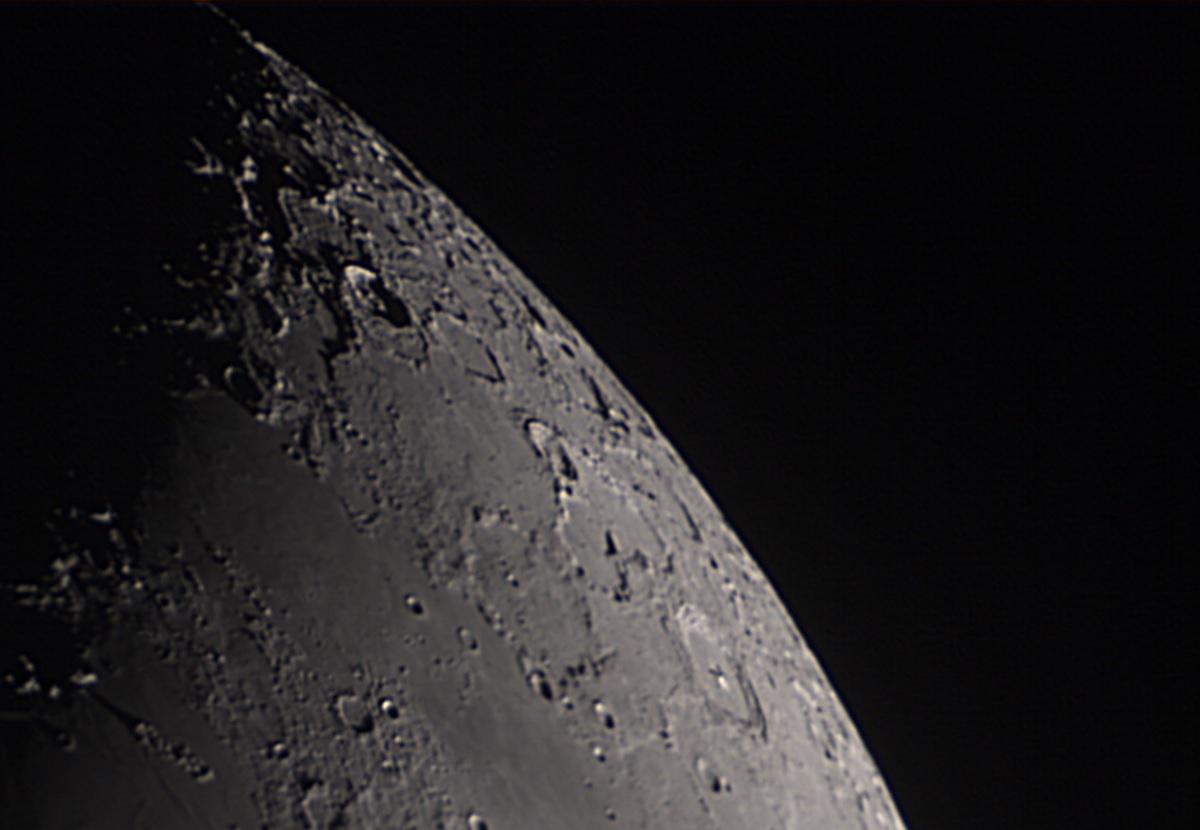
Sinus Roris
The "Bay of Dew", a northern extension of the Oceanus Procellarum, is the location of the fictional dust-bowl called the "Sea of Thirst" in Arthur C Clarke's A Fall of Moondust (1961).
...Selene surged forward. For the first time there was a real sensation of speed. The boat's wake became longer and more disturbed as the spinning fans bit fiercely into the dust. Now the dust itself was being tossed up on either side in great ghostly plumes; from a distance, Selene would have looked like a snowplough driving its way across a winter landscape, beneath a frosty moon. But those grey, slowly-collapsing parabolas were not snow, and the lamp that lit their trajectory was the planet Earth.
The passengers relaxed, enjoying the smooth, almost silent ride... (p.10)
On the next page we are told that
...the Sea of Thirst was a surprise; no one had anticipated finding a dustbowl more than a hundred kilometres across.
As the lunar "seas" went, it was very small; indeed, the astronomers had never officially recognised its title, pointing out that it was only a small portion of the Sinus Roris - the Bay of Dew. And how, they protested, could part of a Bay be an entire Sea: But the name, invented by a copy-writer of the Lunar Tourist Commission, had stuck despite their objections...
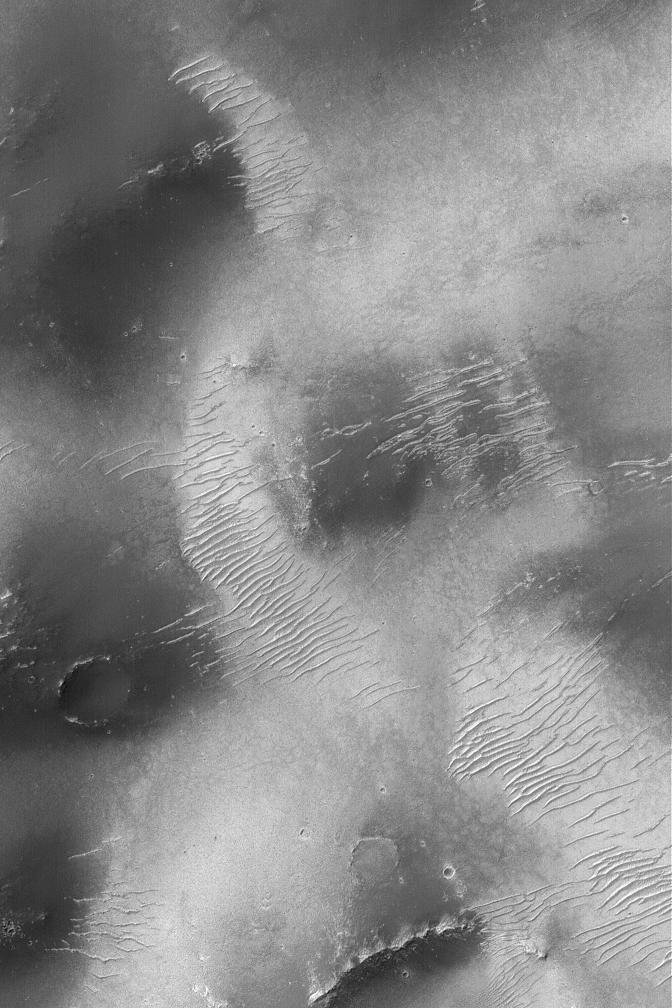
Sinus Sabaeus:
Home of the detective (a seven-foot biped of vaguely stork-like appearance) in The Martian Crown Jewels by Poul Anderson.
...The city lay gray and quiet; the sun was slipping westward over the farmlands of Sinus Sabaeus and the desert of the Aeria; he could just make out the rumble of a treadmill cart passing beneath the windows - and he sat here with a story which could blow the Solar System apart!
His hands, gloved against the chill, twisted together. "Yes, it's confidential, all right. If you can solve this case, you can just about name your own fee." The gleam in Syaloch's eyes made him regret that, but he stumbled on...
The same area is, in Lin Carter's The Valley Where Time Stood Still (1974), lent a different feel:
"...As you probably know, preliminary surveys have indicated that the Sabaeus Sinus Plateau is possibly the oldest, continuously-exposed land-surface on Mars. It was above water even when there were oceans here, millions of years ago. It has probably been surface land as far back as there was surface land - since the planet was formed, in other words... Well, not to digress further: we parted company with the geologists at Sigeus and came here by slidar with native bearers. I - we - wished to check forstnand the rumors that laid the site of the legendary "first city", Ygnarh, somewhere in this region..." (p.73) [Lin Carter has obviously absorbed his Clark Ashton Smith! Ygnarh is the Martian city in Vulthoom.]
On page 107 we are given another chunk of impressions, making much of the formation's smoothness:
...Once, long ago, this had been a peninsula which thrust deeply out between the equatorial ocean and a long, land-locked bay. Even then, perhaps, it had been level land with few hills, if any, to mar its regularity. When the oceans shrank and dried to salty puddles, what had been a peninsula became a mighty barrier of rock thrusting up some hundreds of feet above the dead sea bottoms. Whatever topsoil had once covered the rocky surface of the peninsula had long since crumbled to dust and been blown away to mingle with the talcum-fine dust of the dead ocean's floor...
See also the reference in the entry for Deltaton Sinus, from the first of the five Mars novels by Patrick Moore, Mission to Mars (1955).
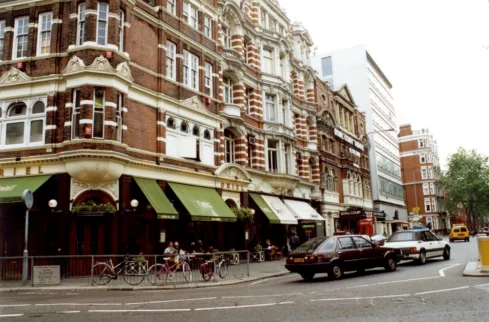 Couldn't find a pic from the 1950s so the '90s will have to do...
Couldn't find a pic from the 1950s so the '90s will have to do...Sloane Square, Chelsea, London, England:
On the way to Blades Club for an encounter at cards with the vulgar and sinister Hugo Drax, James Bond glimpses a curious portent in the heavens. From chapter III of Moonraker (1955) by Ian Fleming:
Startled at the great crimson words, Bond pulled in to the curb, got out of the car and crossed to the other side of the street to get a bigger view of the big skysign.
Ah! That was it. Some of the letters had been hidden by a neighbouring building. It was only one of these Shell advertisements. 'SUMMER SHELL IS HERE' was what it said.
Bond smiled to himself and walked back to his car and drove on.
When he had first seen the sign, half-hidden by the building, great crimson letters across the evening sky had flashed a different message.
They had said: 'HELL IS HERE... HELL IS HERE... HELL IS HERE.'
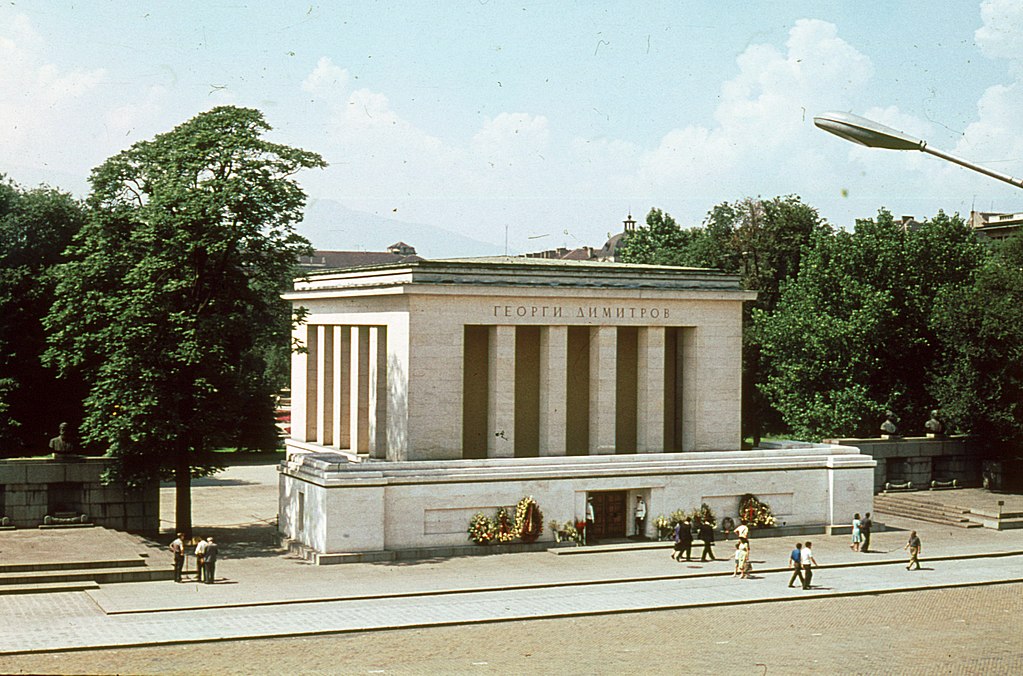 the Dimitrov mausoleum (destroyed in 1999)
the Dimitrov mausoleum (destroyed in 1999)Sofia, Bulgaria:
In The Doomsday Brain (1967) by Paul Tabori, the Hunters on the track of evil mastermind Bruno Gatterer follow a trail that leads here.
Outside the mausoleum of Georgi Dimitrov the two sentries stood like wax figures. Their uniforms were straight from the heyday of Viennese operetta with a lot of braid, polished top-boots, feathered caps; more than somewhat incongruous in the capital of a Socialist Peoples' Republic. They stood without any visible movement, their rifles at rest, probably self-hypnotised into lifeless rigidity. The tomb was guarded by two such "living statues" day and night, twenty-four hours a day, in rain and shine, frost or heat wave. Old Georgi who had won world fame when he stood up to the bullying of Hermann Goering at the Reichstag fire trial - and got away with it - died in Russia, rather unexpectedly; perhaps his Russian comrades slightly hastened his demise for his was a brand of National Communism which Stalin did not relish. However, his body was carried in state on the shoulders of the leaders of International Marxist-Leninism and in due course returned to Bulgaria - to provide the central piece of the mausoleum which the two sentries guarded with such perfect imitation of garden sculpture...
Staten Island, New York, USA:
Birthplace of Theodore Sturgeon, 26 February 1918.
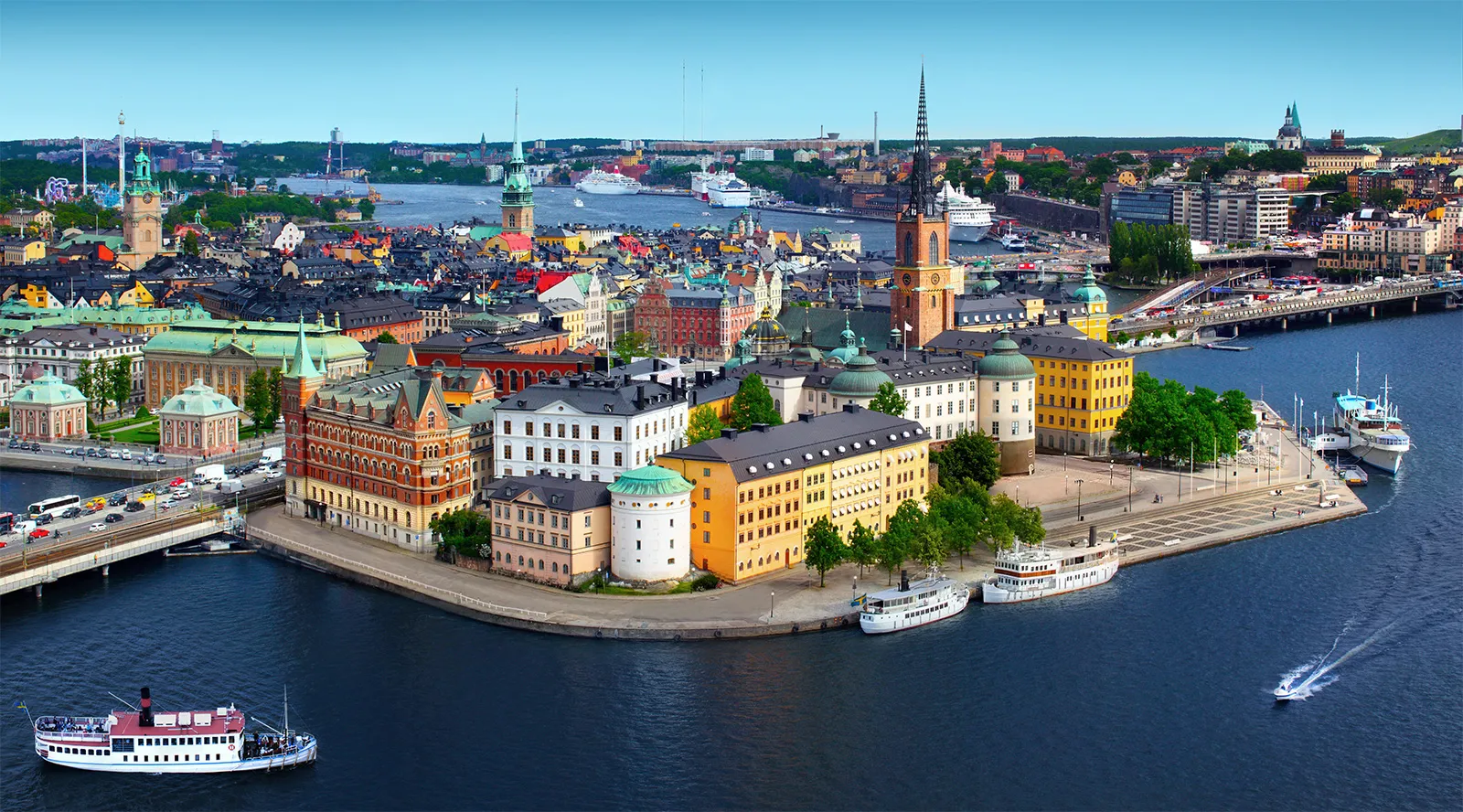
Stockholm, Sweden:
From Keith Laumer's Worlds of the Imperium (1962):
He had been following me all day.
At first I thought it was coincidence when I noticed the man on the bus from Bromma, then studying theatre announcements in the hotel lobby while I registered, and half an hour later sitting three tables away sipping coffee while I ate a hearty dinner.
I had discarded the coincidence theory a long time ago. Five hours had passed and he was still with me as I walked through the Old Town, medieval Stockholm still preserved on an island in the middle of the city. I had walked past shabby windows crammed with copper pots, ornate silver, dueling pistols, and worn cavalry sabres; they were all very quaint in the afternoon sun, but grim reminders of a ruder day of violence after midnight...
From Theodore L Thomas' The Weather Man (Analog, June 1962):
Anna Brackney wandered up the broad steps of the Weather Advisors Building half an hour early, as usual. At the top she stopped and looked out over the city of Stockholm. It was a pretty city, sturdy under its heavy roofs, sparkling under the early morning sun, and quiet and restful. Stockholm was a fine place for the Advisors. In fact it was such an excellent choice for the kind of work the Advisors did, Anna wondered all over again how it was possible for men to have chosen it... [For this story see also Piloting a boat on the Sun.]
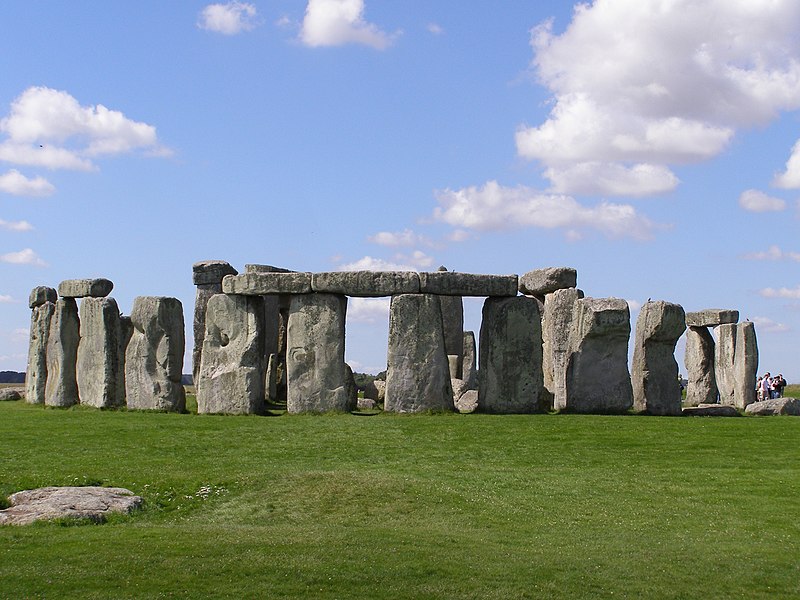
Stonehenge, Wiltshire, England:
This site resonates in many tales.
The time-traveller Malcolm Lockridge has a hand in founding the monument, as described in Poul Anderson's The Corridors of Time (1965):
...meanwhile he made alliance - with the axmakers of Langdale Pike, the settlers along the Thames, even the dour downland farmers, whom he persuaded that manslaughter was not pleasing to the gods. Now today they spoke of erecting a great temple on Salisbury Plain, as the sign and seal of their confederation...
The time-viewing mental pioneer Howard Lester in Colin Wilson's The Philosopher's Stone (1969) approaches the stone circle from the present and finds it disturbing:
The sensations were so strong when we pulled up opposite Stonehenge that I let Littleway buy the tickets, while I crossed the road towards the stones. It was a quite indescribable sensation. If I were trying to represent it in a film, I should use a curious, menacing vibration. But that would be to simplify it. In a sense, it was more like a smell, picked up by some inner sense, a smell of time...
For the narrator of Keith Laumer's A Trace of Memory (1963) - playing sidekick to the mysterious "Foster" - a more violent surprise awaits during a night visit to a hollow close to the site of the stones:
The surface of the ground before us seemed to tremble, then heave. Foster snapped on his flashlight. The earth at the bottom of the hollow rose, cracked open. A boiling mass of luminescence churned, and a globe of light separated itself, rose, bumbling along the face of the weathered stone...
What the technophobic population have learned to call the "Stones of the Sanctuary" in John Christopher's post-disaster novel The Prince in Waiting (1970) turn out to have a hidden base of secret technologists beneath them:
...They stood like jagged teeth on the skyline; tiny but, being miles away still, having the promise of enormity. The promise or the threat... There had been vague thoughts of the High Seers, of Seances, but nothing concrete, nothing, really, that meant anything. Those distant pillars were real, and foreboding. They were surrounded by empty downland, cropped only by rabbits. No man would go near, no shepherd graze his flocks in their shadow. It was the place of the High Seers, dread and holy, and that dread touched me, making me want to turn back to the world of men...
In Susan Cooper's Mandrake (1964), a night-time visitor to the ancient site unexpectedly encounters the dark power of an inimical Intelligence (p.82):
...He turned his head, and looked away from the road over the sweep of the dark land; then suddenly he was aware of a darkness more solid than the rest... His head sang with shock for a moment, until he realized that he had stopped beside the pointing circle of Stonehenge.
Wariness did not occur to him; only the warmth of recognition. He walked forward again in relief towards the stones. From visits long ago he felt vague memories of fences, and an official turnstile, and souvenir-hunting huts; but none of these seemed to stand in the way now. Only the empty grass stretched out to the old silent stones. He was moving without uneasiness, and growing accustomed to the dark. And then it hit him.
Without warning, he was flung backwards by an impact as fierce as if he had walked into a wall...
In Harry Harrison's short and ironic The Secret of Stonehenge (Fantasy and Science Fiction, June 1968), investigators bearing a time-viewer are about to learn and, accidentally, to cause the motive for the building of the stone circle.
...In the evening, under a lowering sky, that is the only way to see Stonehenge, without the ice cream cornets and clambering children. The Plain settles flat upon the Earth, pressed outwards to a distant horizon, and only the gray pillars of the sarsen stones have the strength to push up skywards...
...They stopped next to the Altar Stone and lowered the case. "We'll know soon enough," Lanning said, throwing open the latches...
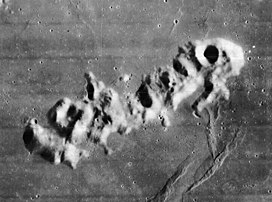 from Lunar Orbiter 4
from Lunar Orbiter 4the Straight Range (= Montes Recti):
Two astronomers from Plato Observatory decide during their free time to go exploring by turbine-driven lunar tractor, in Earthlight (1955) by Arthur C Clarke:
For the next three hours they crawled along the flanks of the Teneriffe Mountains, then struck out across the plain to the Straight Range, that lonely, isolated band of mountains like a faint echo of the mighty Alps. Jamieson drove now with a steady concentration; he was going into new territory and could take no chances...
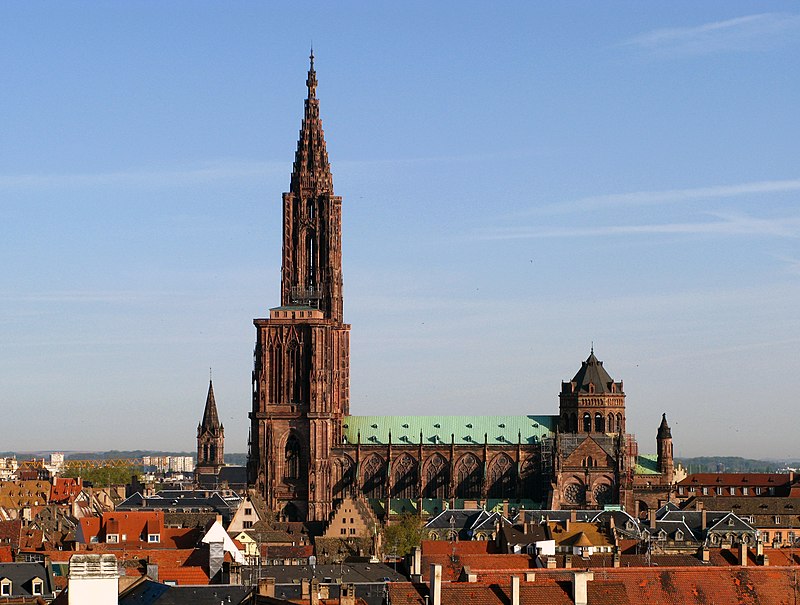
Strasbourg, Alsace, France:
Post-World-War-III, the effective dictator of what was left of humanity, in Poul Anderson's Marius (Astounding, June 157), has based himself in Strasbourg, where his erstwhile follower Etienne Foure moves to confront him.
....Strasbourg was the seat of the Council because of location and because it was not too badly hit. Only a conventional battle with chemical explosives had rolled through here eighteen months ago. The University was almost unscathed, and so became the headquarters of Jacques Reinach. His men prowled about on guard; one wondered what Goethe would have thought could he have returned to the scene of his student days...
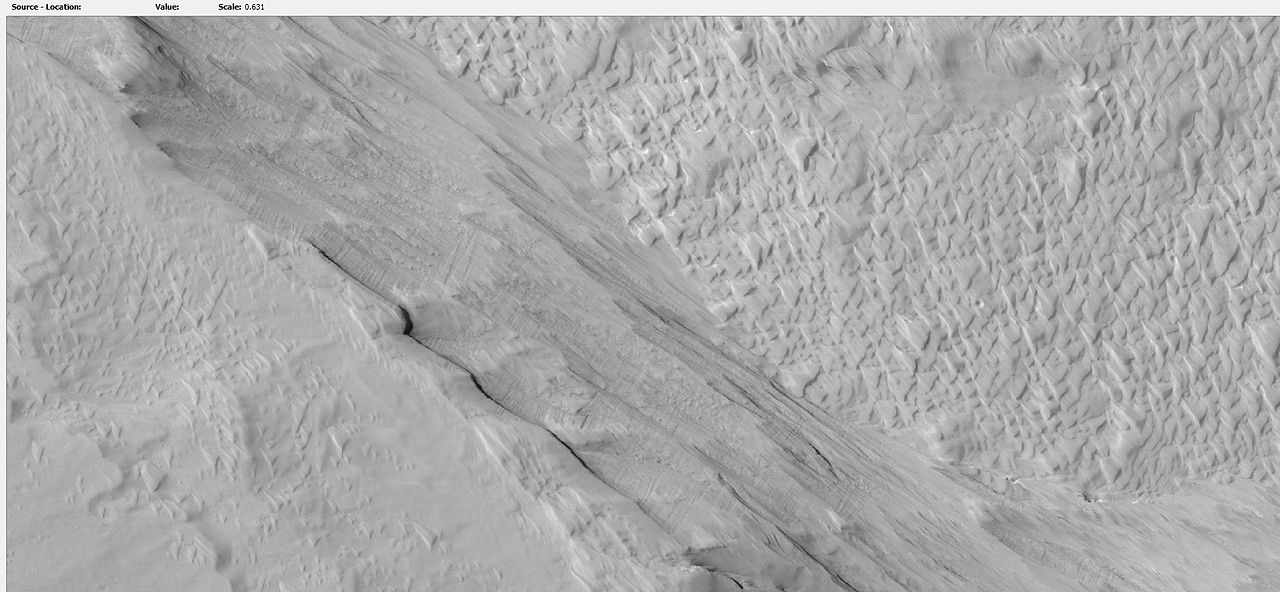 it's something that runs straight anyway - the best I could do
it's something that runs straight anyway - the best I could doStrymon canal, Mars:
The opening scene in Red Planet (1949), by Robert A Heinlein, is set in a colony in this area.
...Buildings had not even view windows, any more than a modern building in New York has. The surrounding desert, while beautiful, is monotonous. South Colony was in an area granted by the Martians, just north of the ancient city of Charax - there is no need to give the Martian name since an Earthman can't pronounce it - and between the legs of the double canal Strymon. Again we follow colonial custom in using the name assigned by the immortal Dr Percival Lowell...
[Note: Strymon, though non-existent, is locatable in, or somewhat west of, Amazonis Planitia (see Linking Lowell's Mars with the standard map).]
[Later note: or maybe much further west than Amazonis, if you have to subtract the old longitude from 360 rather than use it directly - see note after "Aetheria". Anyhow, I'll leave the picture for the entry as it is, since I quite like its canal-like appearance.]
Sussex, England:
See Locations for The Day of the Triffids.
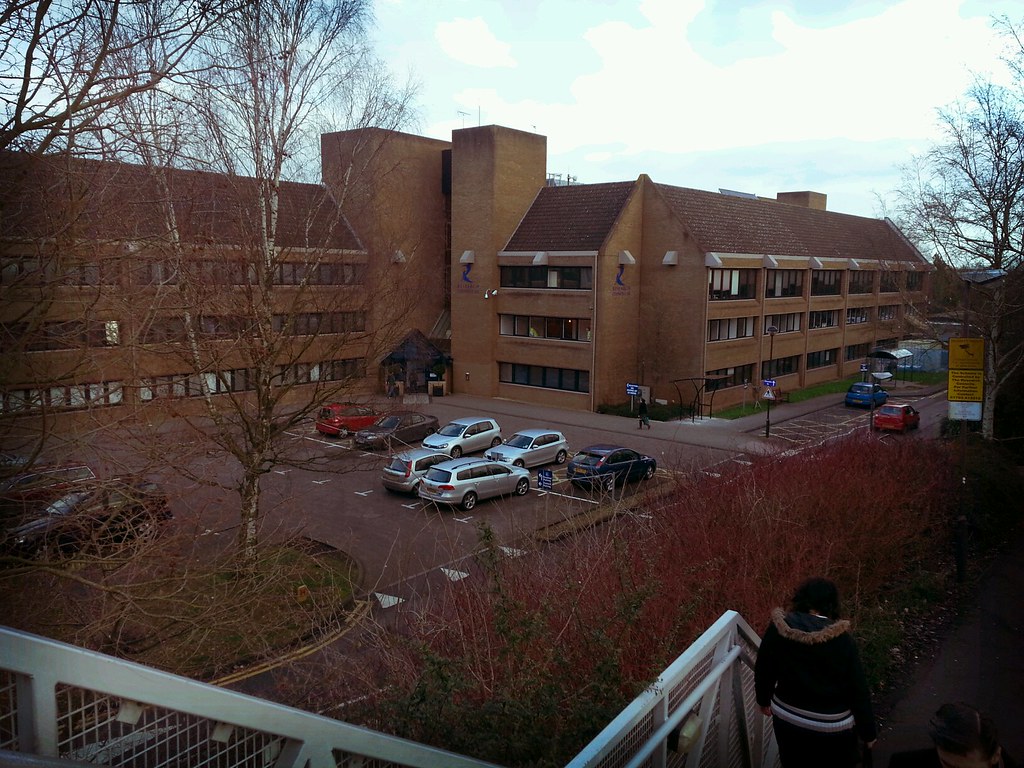 Polaris House, Swindon
Polaris House, SwindonSwindon, Wiltshire, England:
In a narrative which doubtless expresses the author's own humorous disdain for the Research Council bureaucracy, fictional professor Isaac Newton (a Devon man, unlike the Lincolnshire sage of the seventeenth century) tries to find his way on page 158 of Fred Hoyle's alien-contact novel Comet Halley (1985):
...It was an awkward cross-country drive from Cambridge to Swindon where the Research Councils were located, having moved there from central London a few years previously. The awkwardness of the cross-country route was eclipsed, however, by the difficulty which Isaac Newton experienced in finding North Star Avenue in Swindon itself. Somebody told him to make for a place which rejoiced under the name of the Oasis, but the instruction he received only contrived to get him on the wrong side of the railway, so that although he ended up only a couple of hundred yards from his destination, he could find no way to get his car across the lines. In some irritation he managed to park the car, and then cross the lines by a footbridge, only to find himself among a number of large buildings with a style of architecture that reminded him of an artist's impression of ancient Mesopotamia...
Syracuse, New York, USA:
Birthplace of Keith Laumer, 9 June 1925.
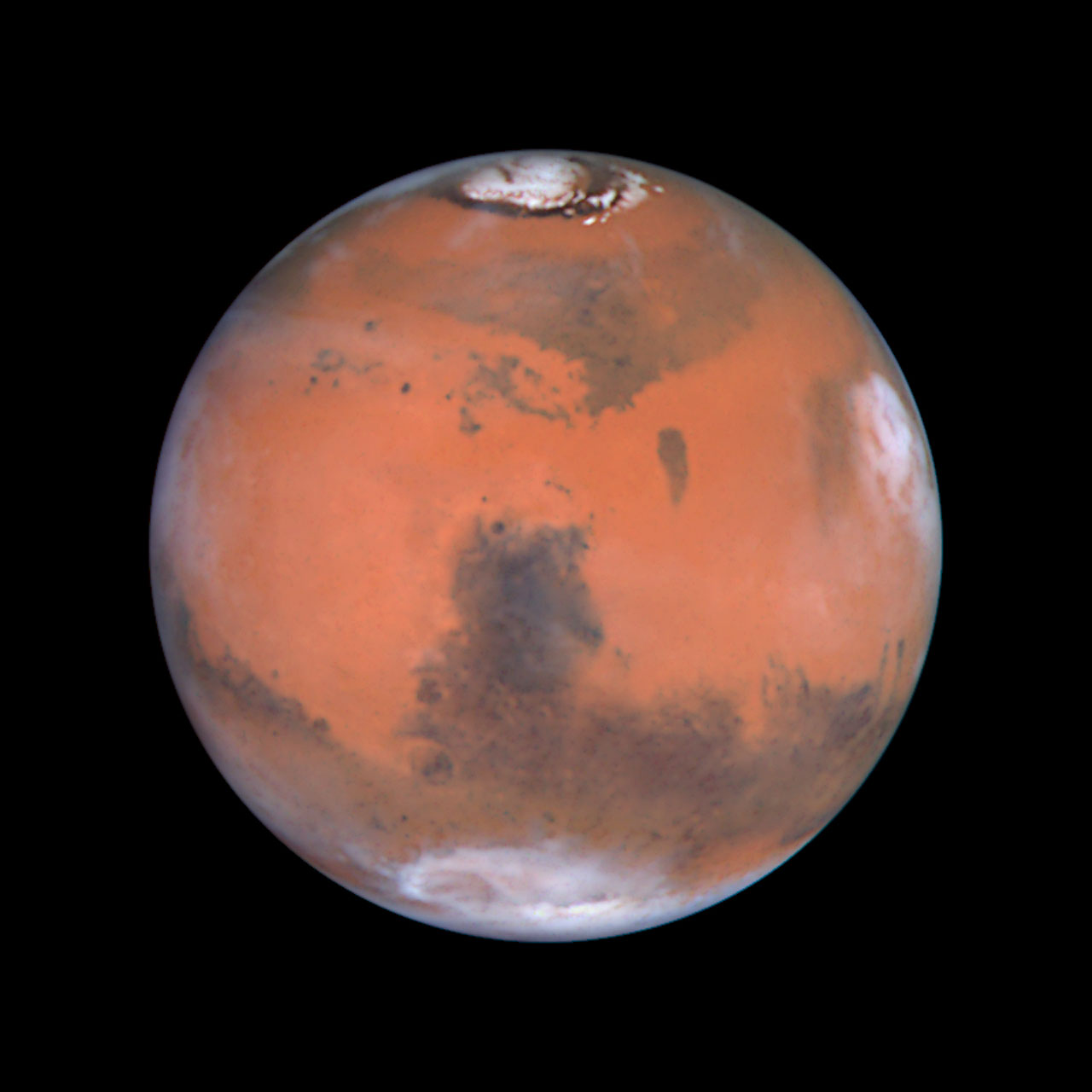 stands out well in the middle of this Hubble Space Telescope image
stands out well in the middle of this Hubble Space Telescope imageSyrtis Major:
According to Wikipedia this was "the first documented surface feature of
another planet. It was discovered by Christiaan Huygens, who included it
in a drawing of Mars in 1659." A venerable record! Syrtis, I thought, meant "bog", which would make the feature a "big bog", but looking up the word online I find it means "quicksand". (I must have been misled by Milton's "boggy Syrtis" traversed by Satan in Paradise Lost.)
"Syrtis Major" is such an old appellation and the feature itself so prominent, it's not surprising it tends to be a default choice amongst sf writers who seek the name of a location on Mars. Master of the Asteroid (Wonder Stories, October 1932) by Clark Ashton Smith.
is a classic early tale of interplanetary exploration which on its first page states that ...in 1980, a dozen voyages had been made to Mars, and a rocket base had
been established in Syrtis Major, with a small permanent colony of
terrestrials, all of whom were trained scientists as well as men of
uncommon hardihood and physical stamina...
The name of the feature gets into the name of the story in Poul Anderson's Duel on Syrtis (Planet Stories, March 1951). Riordan, a ruthless Terran hunter who wishes to "bag a Martian", is watched by his intended target, Kreega, who
...sat in a cave, looking down past a tortured wilderness of sand and bush and wind-carved rock, miles in the thin clear air to the glitter of metal where the rocket lay. The man was a tiny speck in the huge barren landscape, a lonely insect crawling under the deep-blue sky... Weak pallid sunlight spilled over rocks tawny and ocherous and rust-red, over the low dusty thorn-bushes and the gnarled little trees and the sand that blew faintly between them. Equatorial Mars!
Syrtis Major is the location of the colony-cities Lowell and Pickering in Patrick Moore's series of five juvenile Mars adventures. To quote from the fourth of them, Peril on Mars (1958), page 25:
...there was the V-shaped dark area still called by its old name of Syrtis Major, and he could even make out the tiny cluster of specks whch marked the man-made city of Lowell. The second city, Pickering, was smaller, but after a time he found that too...
For a while I was confused by an apparent contradiction between this and the statement in the final volume, Raiders of Mars (1959), page 82:
...he could even see the dot which marked Lowell Base, lying on the edge of the desert which astronomers had named Aeria...
I hoped that this would be resolved by a bit of research which would show that Aeria is just next to Syrtis Major, and thus that "on the edge of" just implies "on the edge of Syrtis Major, close to Aeria". And lo and behold my wish was granted when I found an Encyclopedia Britannica reference online which refers to Aeria as the "western boundary" of Syrtis Major. Since I possess a Mars globe I should not have had to go to such trouble, but sadly the globe is not as helpful as it should be as regards names, although topographically it's excellent.
Edmond Hamilton as far as I can recall in his numerous Mars tales uses no real geographical name other than Syrtis (though of course he invents plenty of native Martian names). For example in Planet of Exile (Space Travel, July 1958):
...reddish desert dropped gently away, a panorama of infinite desolation in all directions except one. In the direction... lay a vast bowl of pale green. He knew it was Syrtis oasis, and he saw that it was almost completely occupied by endless streets of very Earthly-looking buildings... an oddly terrestrial city to find here in an oasis of desert Mars...
The archaeologists of Omnilingual by H Beam Piper (Astounding Science Fiction, February 1957) have set up base in what is presumably this part of Mars, to judge from the name of the area given in the tale:
...She could look down on the cluster of prefabricated huts and sheds, on the brush-grown flat that had been the water-front when this place had been a seaport on the ocean that was now the Syrtis Depression...
See also Casius.
See also the CLUFFs page for a reference to Syrtis from Poul Anderson's Un-Man.
And again Poul Anderson in Moonrakers (If, January 1966) homes in on the place, in this story giving us a picture of a well-established settlement:
Though Syrtis is the biggest and busiest city on Mars, and the capital, it is also the oldest. New skyscrapers gleam for miles around the centre, each set in its own green acres, until southward the town fades into the agricultural lands that ring the equator, northward to untouched deserts of ruddy sand and raw crags. But downtown, most buildings were raised by the pioneers.
Thick walls of grey stone, red-mortared, bulk gracelessly for a few stories and end in flat rooms where flittercraft park. The trappings of modern commercialism look unnatural on such façades.
Their solidity is deceptive. Now that the atmosphere project has been completed, oxygen and water vapour are gnawing away the Martian rock so fast that the narrow, twisted streets are always dusty. This district won't last many more generations...
Tampa, Florida, USA:
The state's outline has changed drastically in Keith Laumer's Catastrophe Planet (1966):
Tampa was a reeking ruin, a seaport town miles from the sea, surrounded by a bog of grey mud left high and dry by the freakish withdrawal of the Gulf...
Tarzana, California, USA:
From Larry Niven and Jerry Pournelle's invasion-epic Footfall (1985):
Tarzana didn't have electricity. Ken Dutton and his guests stayed outdoors. Light came from the bellies of the clouds, reflected from wherever the Los Angeles and San Fernando Valleys still had electricity. Occasionally a guest would go inside, feeling his way through the darkness toward the flickering light from the bathroom. At the next Stone Soup party there would probably be no candles at all...
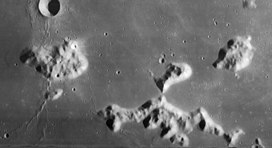
Teneriffe Mountains:
From Earthlight (1955) by Arthur C Clarke:
They came to a halt on a high escarpment overlooking the plain. Directly ahead, notching the horizon, was the pyramidal summit of Pico. Towards the right, sinking down into the north-east, were the more rugged peaks of the Teneriffe Mountains. Very few of those peaks had ever been climbed, largely because no one had so far bothered to attempt it. The brilliant earthlight made them appear an uncanny blue-green, constrasting strangely with their appearance by day, when they would be bleached into raw whites and blacks by the merciless sun...
Terre Haute, Indiana, USA:
Birthplace of Paul Janus Finnegan, alias Kickaha - see Philip Jose Farmer's World of the Tiers series.
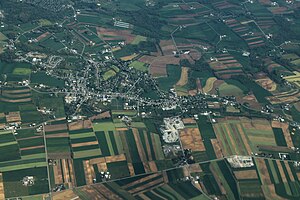
Terre Hill, Pennsylvania, USA:
The first of the alien spacecraft in Theodore L Thomas' Day of Succession (Astounding, August 1959) -
...crashed in south-eastern Pennsylvania two miles due west of Terre Hill.
The object still glowed a dull red, and the fire of the smashed house still smouldered when General Tredway arrived with the troops. He threw a cordon around it and made a swift investigation...
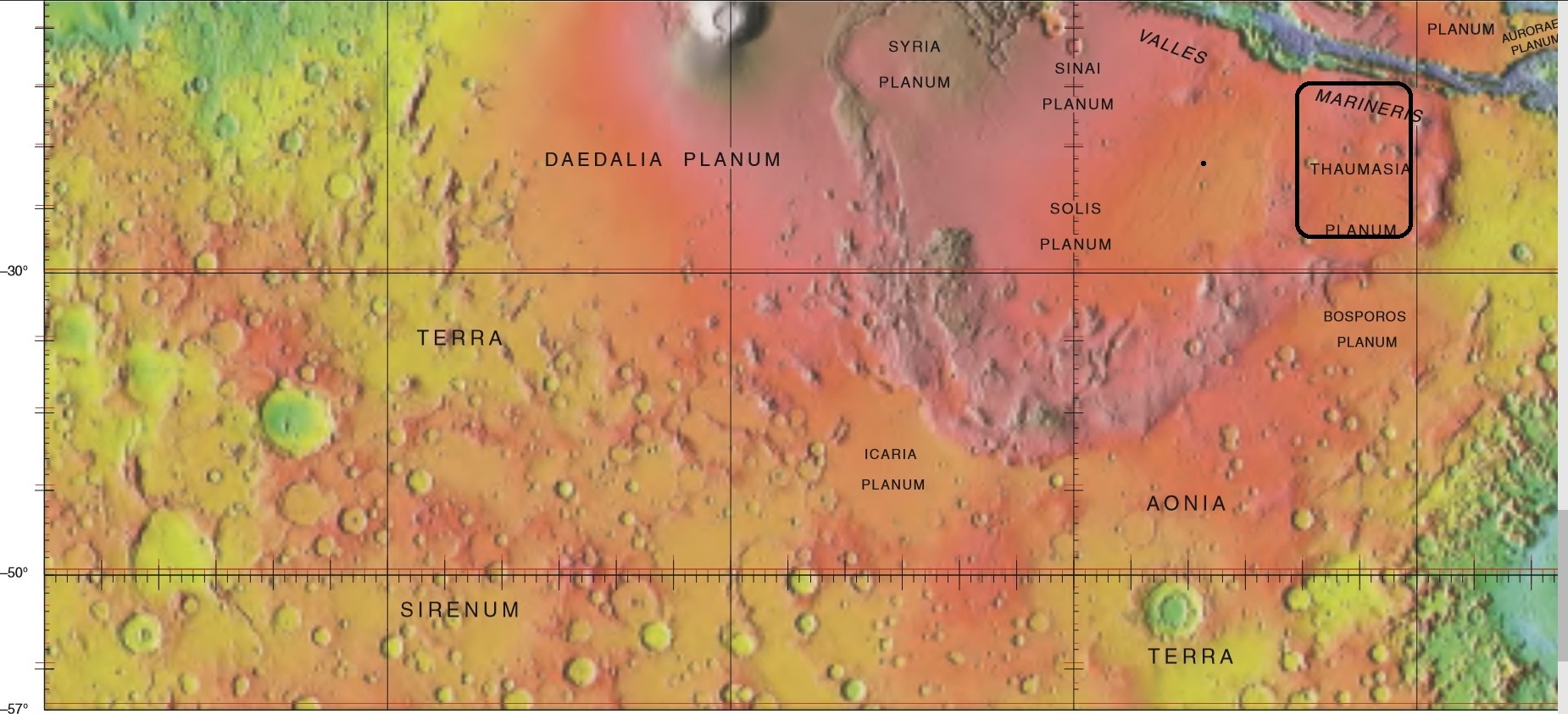
Thaumasia:
Named from a classical albedo feature, and now officially "Thaumasia Planum", this region gets a brief reference in Poul Anderson's The Moonrakers (If, January 1966):
...A man with two sons in college, a daughter soon to be ready for it - with a desire to study at the Beaux Arts in Paris to boot - could find good use for business on that scale. Also, Mary had been talking about a better house in Thaumasia, where they usually moved during the northern hemisphere's winter...
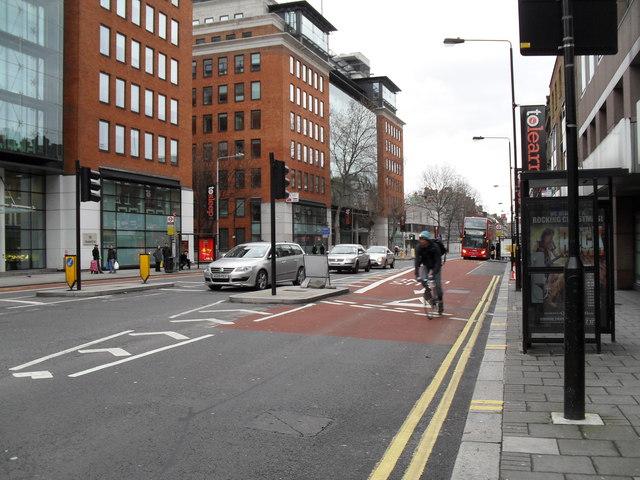
Theobalds Road, Holborn, London, England:
The scene of a crisis-briefing in Hugh Walters' The Last Disaster (1978), in which the Moon leaves its orbit and begins to spiral inward towards the Earth.
...Security for the London meeting was unobtrusive but effective. The gathering was held in the former Air Ministry Building in Theobalds Road...
[Personal note: during 1980-87 I worked in this area; every morning I walked down Theobalds Road to turn into Bedford Row for the Printing Federation.]
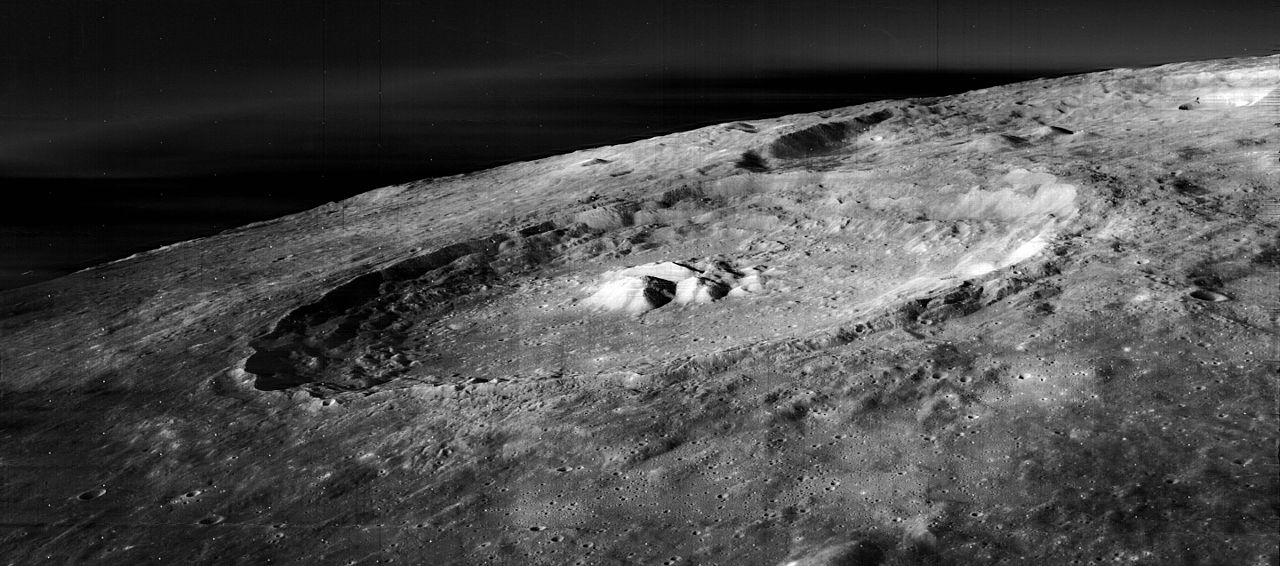 from Lunar Orbiter 3
from Lunar Orbiter 3Theophilus:
This lunar feature is mentioned briefly in Frank Herbert's Try To Remember (Amazing, October 1951), a story of the search for a means of communication with a Galactic power. The mendacious General Speidel makes a claim which may or may not be true:
"...For the past four months all astronomical activity of our nation has been focused on the near heavens, including the moon. Our attention was drawn to evidence of activity near the moon crater Theophilus. We have been able to make out the landing rockets of more than five hundred space craft!"
Thera, Greece: See Santorini.
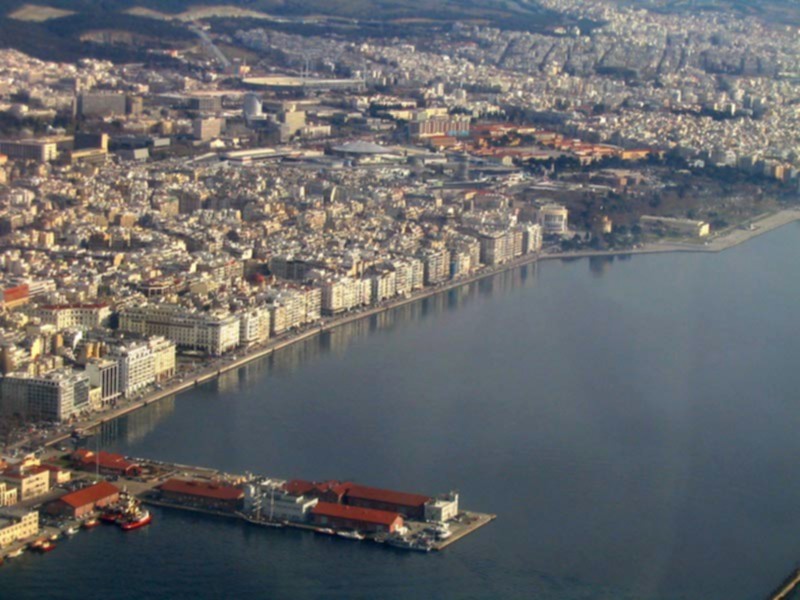
Thessaloniki, Greece:
In Murray Leinster's novella The Invaders (Amazing, April-May 1953) the flies at Salonika play their part in the unmasking of a disguised alien.
...There
was a fly in the office – a large, green-bodied fly of metallic lustre. The inhabitants of Salonika said with morbid
pride that it was a speciality of the town, with the most painful of all known
fly-stings. And Helena abhorred flies.
It landed on the bare skin of her
neck. She did not notice. It stayed there. Ordinarily she would have jumped up,
exclaiming angrily in Greek, and then she would have pursued the fly vengefully
with a folded newspaper until she killed it.
But now she ignored it…
Thoana Palus:
...Yeolarn is the northernmost of the Earth colonies, and sits smack on the 250th Meridian in the center of the Thoana Palus... - from Lin Carter's The City Outside the World (1977).
Online a source tells me the location of the feature is at 256 degrees West, 35 North.
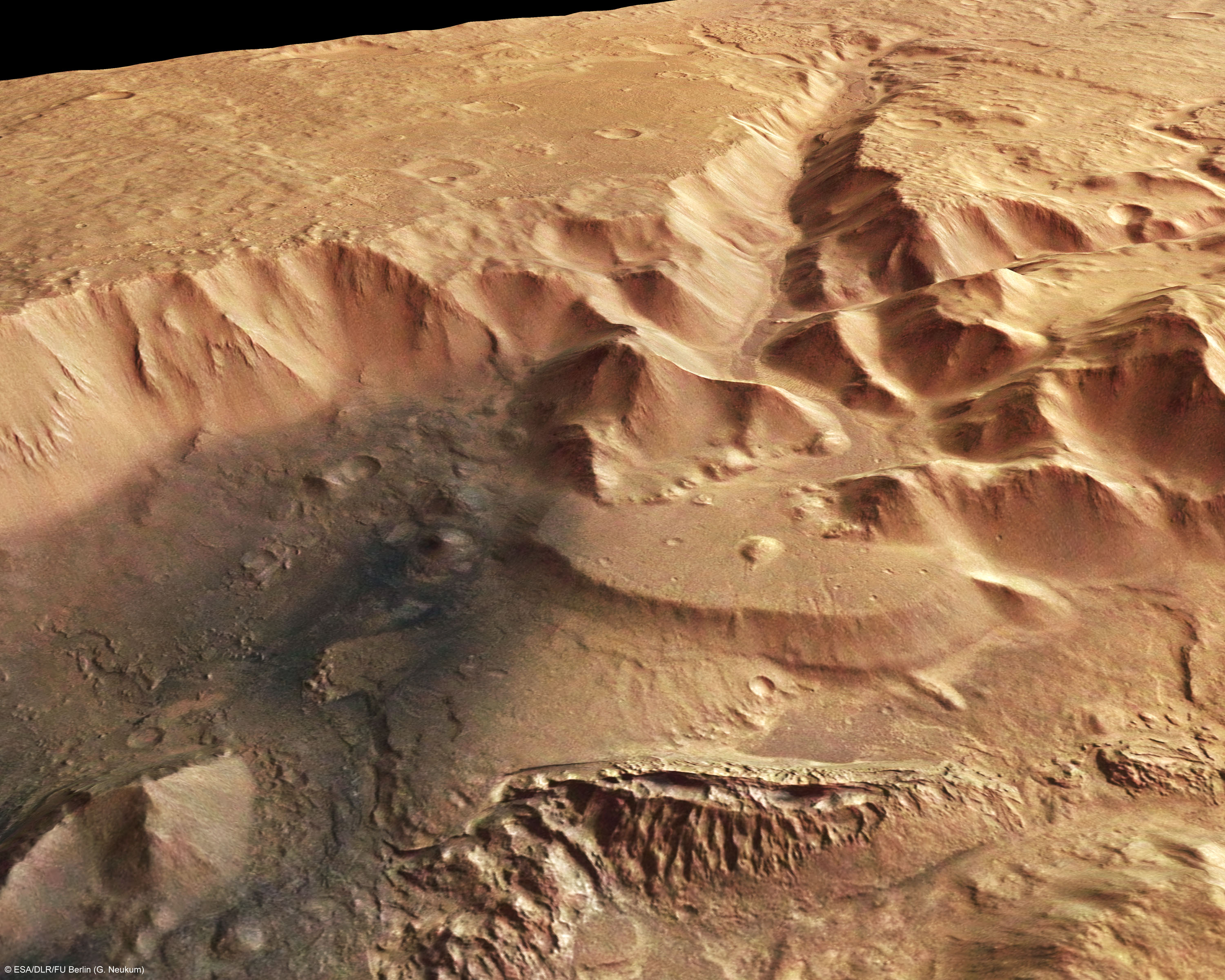 So far, unfortunately, I have not succeeded in finding a picture of Thoth-Nepenthes as such, but this picture of Nepenthes Mensae does show an interestingly straight bit...
So far, unfortunately, I have not succeeded in finding a picture of Thoth-Nepenthes as such, but this picture of Nepenthes Mensae does show an interestingly straight bit...Thoth-Nepenthes:
268 degrees west, 8 north. One of the few so-called Martian "canals" that correspond to actual dark features on the planet.
From Lin Carter's The Man Who Loved Mars (1973), p.45:
I began idly questioning Keresny as to the site of the so-called Treasure City. The ancient thought record he had found up at Thoth-Nepenthes had given the site with particular detail. Scholars have spent twenty years striving to figure out the peculiar geographical notation employed by the Ancients and have come up with a rough but workable system...
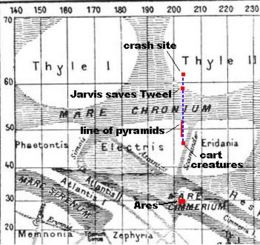 (South is up)
(South is up)Thyle II:
This is the region where Dick Jervis crash-lands one of the auxiliary rockets in which he had set out from the parent ship Ares to photograph some of the landscape of Mars, as narrated in A Martian Odyssey by Stanley Weinbaum (Wonder Stories, July 1934). Those were the days when you could believe in exploration worthy of the name:
"...I started losing altitude right away, and suddenly there I was with a thump right in the middle of Thyle! ... the bump flattened the landing-gear and busted off the under-jets... I had my choice of waiting to be picked up or trying to walk back - eight hundred miles... I chose to walk... Just as much chance of being picked up, and it kept me busy."
"We'd have found you," said Harrison.
"No doubt. Anyway, I rigged up a harness from some seat straps, and put the water tank on my back, took a cartridge belt and revolver, and some iron rations, and started out..."
The region gets a brief mention in Poul Anderson's Un-Man (Astounding, January 1953), with regard to a political conspiracy against the rule of the United Nations after World War Three:
...yes, the Guard was also using a privately owned spaceship to run arms to a secret base in the Thyle II country, where they were picked up by the Pilgrims.
So! The Pilgrims were in on the gang...
Tijuana, Baja California, Mexico:
Much of Philip K Dick's Now Wait For Last Year (1966) takes place in this city in the year 2055. Tijuana Fur & Dye was established as the receiving plant for furs created by exploiting the capacity for mimicry of the "Martian print amoeba". It had broken the natural fur market. Then war intervened.
As soon as hostilities with the reegs had begun, Tijuana Fur & Die had converted from the luxury trade of ersatz fur production to war work... Supernaturally accurate duplication of rocketship master syndromes, the ruling monad Lazy Brown Dog, was fatalistically natural for the type of operation which TF&D represented; conversion had been painless and rapid...
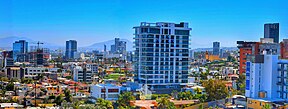
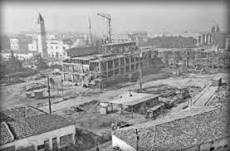 in 1960
in 1960Tirana, Albania:
From Paul Tabori's The Doomsday Brain (1967):
There were only three people who got off the small Rumanian plane at Tirana, the overgrown village that called itself the capital of the Albanian Peoples' Republic. The other passengers, continuing to Bucharest, were guarded by a platoon of soldiers with automatic rifles at the ready as if their very presence on the tarmac might threaten the security of Enver Hoxha's country...
Topeka, Kansas, USA:
Birthplace (in 2093) of Gil Hamilton - see The Long ARM of Gil Hamilton (1976), by Larry Niven.
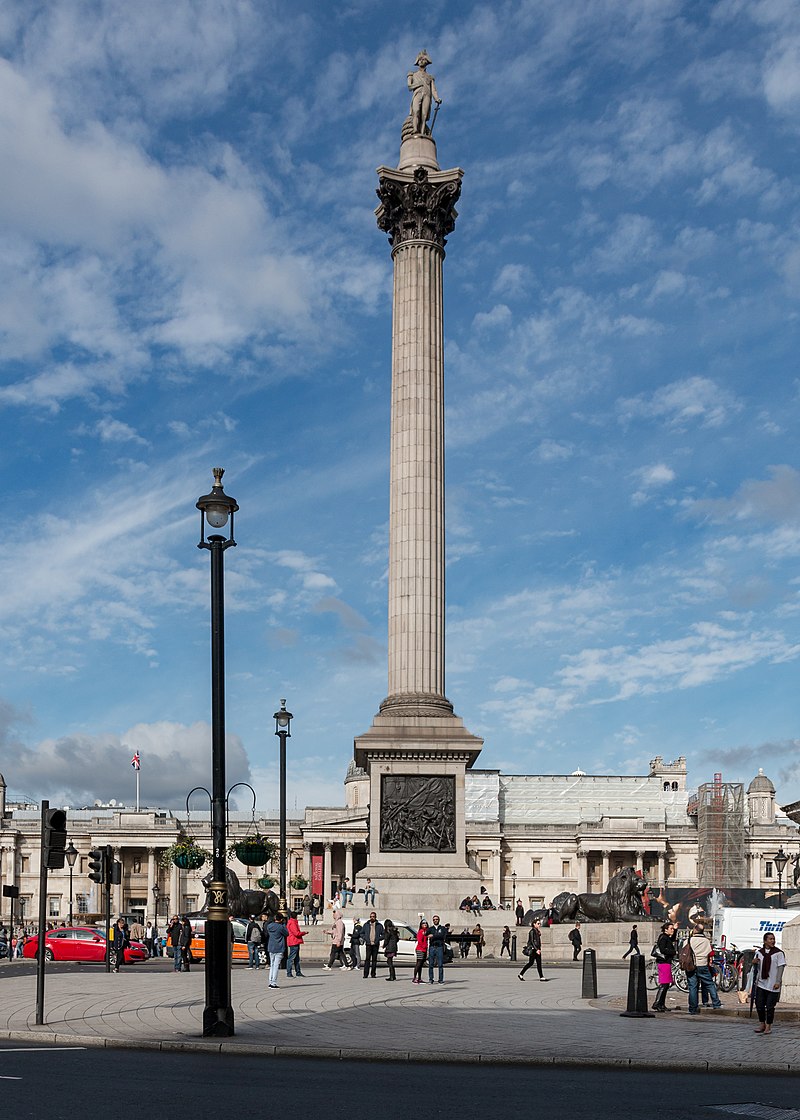
Trafalgar Square, London, England:
In the version of 1990s London portrayed by Dan Morgan in The Country of the Mind (1975), in which airborne cabs fly about the capital,
Nelson's Column loomed briefly in the right hand window as the cab dropped out of the traffic pattern and made a neat landing on a rooftop terminal at the south-east corner of Trafalgar Square. He paid the driver and took an elevator down to the pedestrian level...
In John Wyndham's The Kraken Wakes (1953), when London begins to drown because the aliens colonising the deep oceans are melting the ice cap to enlarge their domain, the flood line at one point lay across Trafalgar Square (p.221).
In Fifth Planet (1963) by Fred and Geoffrey Hoyle, the astronomer Conway witnesses a late-twenty-first-century artificial war scare:
...People were erupting out of the buildings, so that in spite of those who had managed to get away, some towards the river, others in the direction of Piccadilly, and others along the way he had come, the Square was still as full as ever. It was like an ants' nest, except that ants move in orderly columns...
Trenton, New Jersey, USA:
Not many locations are named in Robert Sheckley's The Status Civilization (1960), but this city gets a mention in the penultimate chapter when the hero, Will Barrent, nears the end of his search for the man who had informed on him and who had thereby caused him to be sent to the prison planet Omega. Barrent recovers his memory:
The robot-confessor had passed the obligatory sentence, and Barrent had left the booth. Well-trained in the lessons of the classroom, he had taken himself into custody, had gone to the nearest thought-control center in Trenton. Already a partial amnesia had taken place, keyed to and triggered by the lessons of the closed classroom...
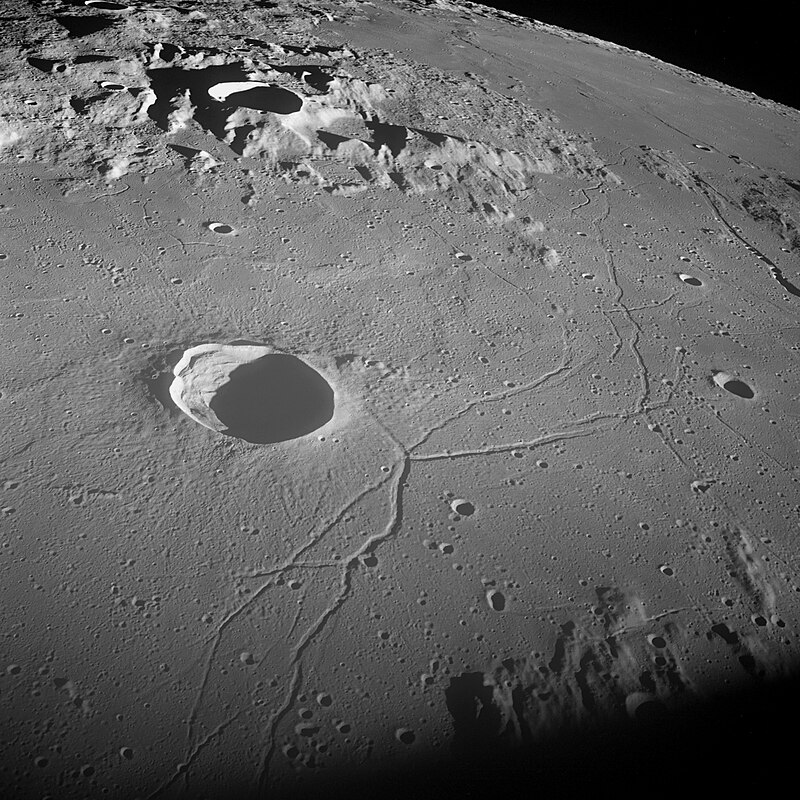 from Apollo 10
from Apollo 10Triesnecker
The crater and the rilles of that name are in the Sinus Medii. The area gets a mention in Earthlight, the 1955 novel by Arthur C Clarke. The protagonist, counter-espionage agent Sadler, is riding the monorail back from Hyginus Cleft to Central City.
He rode the spur-line back to Central City, over the incredibly broken terrain past Triesnecker. For almost all the journey the monorail track was accompanied by the pylons passing their loaded buckets out from Hyginus, and the empty ones back...
For the German novel of 1928 by Otto Willi Gail, Hans Hardts Mondfahrt, see the note after the excerpt, A snaky animal on the Moon.
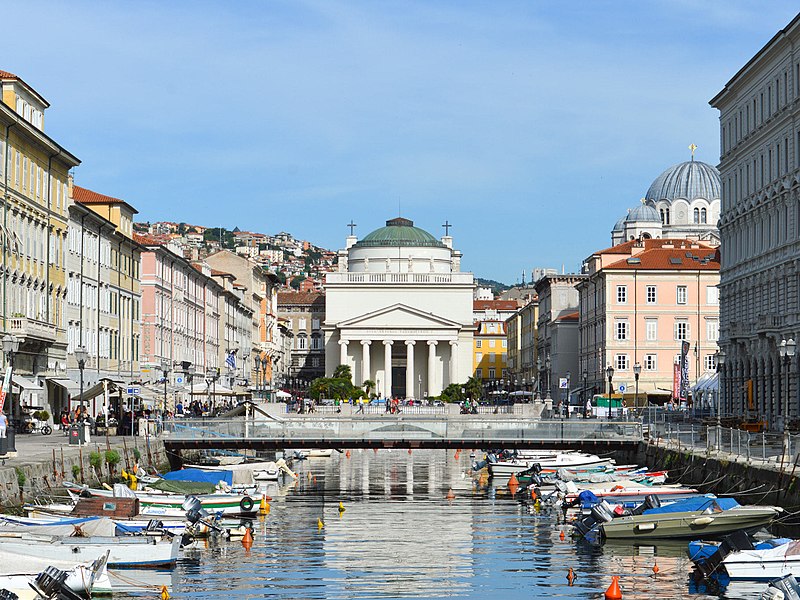
Trieste, Friuli-Venezia Giulia, Italy:
Some thousands of years hence, Wayness Tamm, the lovable investigator who is the heroine of Jack Vance's Ecce and Old Earth (1991), comes to Trieste at one stage of her search for the missing Charter of the planet Cadwal.
...Wayness unfolded the map and after a puzzled glance or two decided that she was holding it upside down. She turned it about, but nothing was clarified; she had evidently been holding it correctly in the first place...
...Wayness climbed into the cab and was whirled away through Old Trieste: a city of unique character, built half on a narrow apron of land under the stony hills and half on piles driven into the Adriatic. Canals of dark water flowed everywhere, washing the foundations of the tall narrow houses...
 Trivium Charontis / Cerberus form the dark thin triangle in the middle of this chart-fraction blown up from the NASA 1971 albedo features map
Trivium Charontis / Cerberus form the dark thin triangle in the middle of this chart-fraction blown up from the NASA 1971 albedo features mapTrivium Charontis:
Means "Crossroads of Charon". Latitude 19.7, longitude 162.
In The Sands of Mars (1951) by Arthur C Clarke, this is the location of the smaller of the two Mars settlements, Port Schiaparelli.
The second city of Mars held less than a thousand people, living under two domes on a long, narrow plateau. This had been the site of the original landing on Mars, and so the position of the city was really an historical accident. Not until some years later, when the planet's resources began to be better known, was it decided to move the colony's centre of gravity to Lowell and not to expand Schiaparelli any further.
The little city was in many respects an exact replica of its larger and more modern rival. Its speciality was light engineering, geological - or rather areological - research, and the exploration of the surrounding regions...
In a far earlier tale, The Retreat to Mars by Cecil B White (Amazing Stories, August 1927), Trivium Charontis is the site of ancient Martian canal-engineering:
...A
low range of hills formed the background and down their slope ran a
great scar. At the foot was a vast building under construction, and
leading from it to the foreground was an immense excavation at the
bottom of which were what I took to be excavating machines, whose
apparent size was enhanced by the diminutive, human-like figures I could
see here and there among them.
Translating the legend below,
Hargraves informed me that this illustrated one of the canals under
construction and that the building at the foot of the hill housed the
pumping mechanism which was to raise the water to its new level. This
particular piece of work was at what we call the northern point of the
Trivium Charontis...
(For more of this passage see Viewing some records of ancient Mars.)
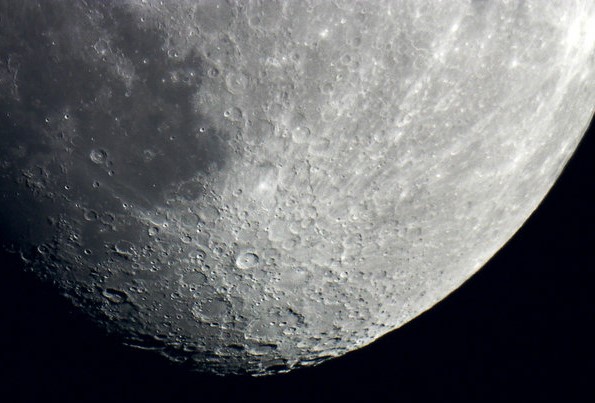
Tycho (crater):
This place is heavy with literary associations.
It's the scene of Trouble with Tycho (1961) by Clifford D Simak., in which prospectors come up against a strange form of li
You
stand up on the rim and look down and there is Tycho, spread out like a
map before you, wild and savage, raw and cold and hard, like the
entryway to hell...
This same crater is also the birthplace and home of Captain Future, whose parents, Roger and Elaine Newton, fled there to escape the villain, Victor Corvo.
...Upon
the moon, beneath the surface of Tycho crater, they built their
underground home. There a son was soon born to the man and woman - a
red-haired baby boy they named Curtis...
Edmond Hamilton, Captain Future and the Space Emperor (1939, 1967).
Tycho crater is also "the site of the buried Luna City" in Isaac Asimov's The Singing Bell (Fantasy and Science Fiction, January 1955).
The "Tycho Magnetic Anomaly" in Arthur C Clarke's 2001: A Space Odyssey
(1968) - both the book and the concurrent movie - is strong magnetism
which turns out to be caused by the alien monolith buried beneath the
crater's floor.
In Heinlein's The Moon is a Harsh Mistress (1966), Tycho Under is one of the more vulnerable lunar settlements,
a big natural bubble cave... roof only metres thick... would not take much of a bomb to crack Tycho Under.
In the same author's Blowups Happen (Astounding, September 1940) the crater's location is the site of the ancient Lunarians' main power plant, which blows up in the nuclear disaster that ends life on the Moon. See The Implicizer aimed at Blowups Happen.
Murray Leinster in Keyhole (Thrilling Wonder Stories, December 1951) has Tycho as the site of the first successful lunar base:
It wasn't until the tenth expedition of four ships established a base in Tycho crater that men had any assurance of being able to land on the Moon and get away again. Even then the staff of the station felt as if it were under permanent siege...
The source of the danger: living moon-creatures!
One of the more advanced Moon-men who figure in The Lunar Pit by Myer Krulfeld (Thrilling Wonder Stories, June 1940) enlightens his captive from Earth in the following dialogue regarding the crater's most renowned feature:
"Sun motors!" Corliss exclaimed. "Is that what makes the mysterious 'rays' around Tycho?"
"Yes, the so-called rays are merely long, curved mirrors which direct the sun's rays upon pipes at their foci, filled with water. The water turns into superheated steam which runs the motors in the crater."
In Wolfbane (1959) by Frederick Pohl and C M Kornbluth, in which Earth has been stolen from the Solar System and is being dragged through interstellar space, Tycho is the surface point where the re-kindling occurs whereby the moon's five-year cycle as Earth's artificial sun recommences. Living on subsistence level, most of Earth's citizens are lethargic "sheep" with only one in a thousand being an assertive "wolf".
"Citizen, the art of living is the substitution of unimportant, answerable questions for important, unanswerable ones. Come, let us appreciate the new-born Sun."
He turned to the window, where the spark of blue-white flame in what had once been the crater of Tycho was beginning to spread across the charred moon...
Archaeology and industry both seem to be going full blast around here in James P Hogan's Inherit the Stars (1977):
...The first thing he did was fly to Tycho by surface transporter to observe the excavations still going on around the areas of some of the Lunarian finds... He also went to see the deep mining and boring operations in progress not far from Tycho, where engineers were attempting to penetrate to the core regions of the Moon...
The eponymous settlement in Moon Base (1964) by E C Tubb - an original and inventive novel of mystery and surprise, despite its rather pedestrian title - is a British colony within sight of Tycho:
...The control was situated on his chest and he twisted it, feeling relief as a wave of coldness forced its way past his chest and over his face and head. Relaxing he leaned back and let his eyes drift over the edge towards the humped line of distant Tycho. They must be, he realized, almost at the level of the Eyrie. Far below the rocket ship looked like an expensive toy...
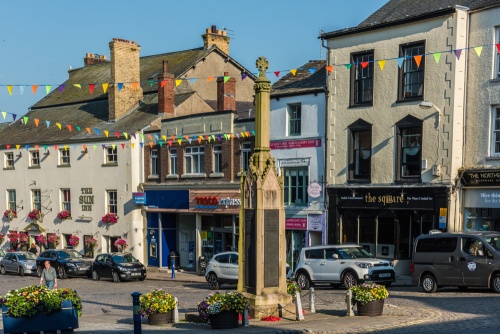
Ulverston, Lancashire, England:
[note: Ulverston is in Lancashire-beyond-the-sands, that region of Lancashire which after 1974 was put into "Cumbria", for those who take notice of such impertinences. I've been a few times to this fine old town.]
"...There I was... sat there in The Globe in Ulverston, downing a pint of Hartley's best... Used to take the bus through to Ulverston every Thursday, 'cause it's market day and the pubs stay open right through... Next thing I knew I was awakening up in this very room... just where you are now..."
Thus a character named Thwaites tells Ray Jerome, protagonist of Bob Shaw's 1984 novel Fire Pattern, of his sudden translation into a body on Mercury.
Urbana, Illinois, USA:
"I am a
Hal Nine Thousand computer, Production Number 3. I became operational
at the Hal plant in Urbana, Illinois on January 12, 1997..."
Arthur C Clarke, 2001: A Space Odyssey (1968)]
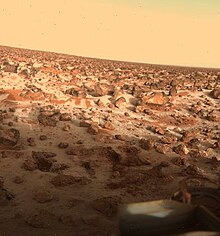 from Viking 2
from Viking 2Utopia:
From the fifth book in the Maurice Gray series of Mars adventures, Raiders of Mars (1959) by Patrick Moore, p.29:
It was at least two years since Rick had last been to Newton Base. As Mellor had said, it lay too far north to be easily reached by helicopter; it had been set up as a research outpost in the area known to the old astronomers as Utopia, and even though the rough Martian scrub had been replaced by vast areas of the leafy plants which gave off oxygen gas, so making life possible, the whole region was one of the wildest on the whole planet...
Vallis Alpes - see under Alpine Valley
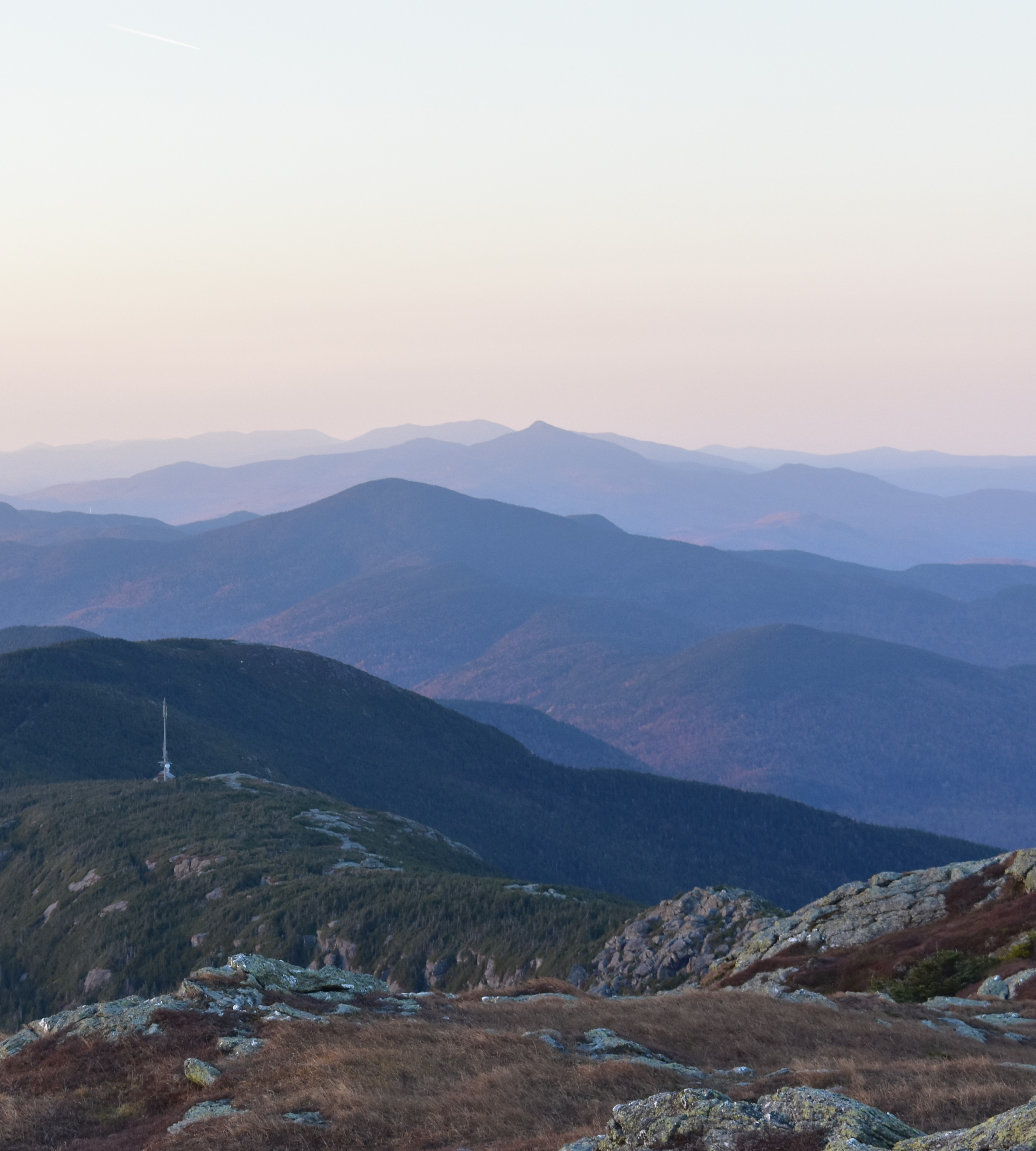
Vermont, USA:
The state is the setting for The Whisperer in Darkness (Weird Tales, August 1931), the fine science-fictional horror novella by H P Lovecraft.
The quaint, sightly village of Newfane, reached in less than an hour, was our last link with that world which man can definitely call his own by virtue of conquest and complete occupancy. After than we cast off all allegiance to immediate, tangible, and time-touched things, and entered a fantastic world of hushed unreality in which the narrow, ribbon-like road rose and fell and curved with an almost sentient and purposeful caprice amidst the tenantless green peaks and half-deserted valleys. Except for the sound of the motor, and the faint stir of the few lonely farms we passed at infrequent intervals, the only thing that reached my ears was the gurgling, insidious trickle of strange waters from numberless hidden fountains in the shadowy woods...
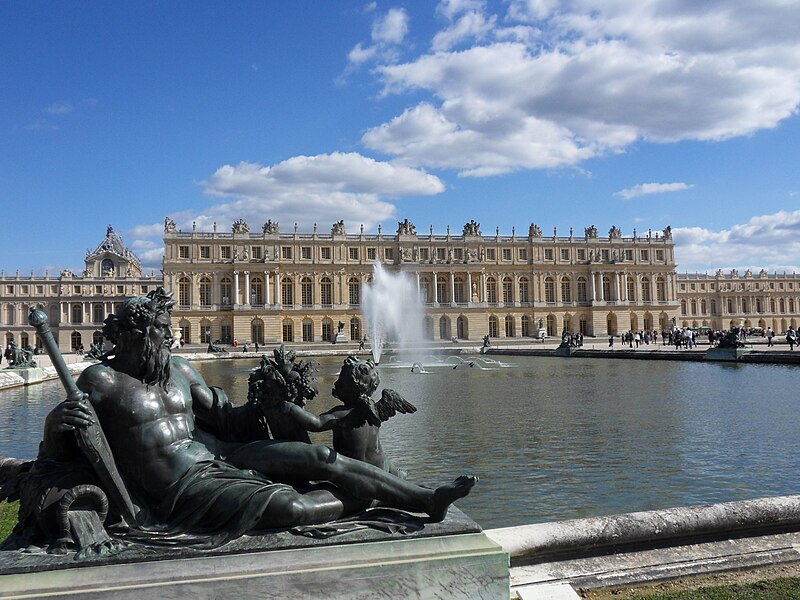
Versailles, France:
A summit meeting - soon to be interrupted by grave news - is held in the Palace in chapter 68 of Fred Hoyle's alien-contact novel Comet Halley (1985).
The day before the Summit they explored the Palace itself, with a view to checking that all arrangements were in order. So far as they seating arrangements were concerned they'd no complaints, as they discovered that they had been placed a mere five paces to the right of the spot where Queen Victoria had sat on the evening of 25 August 1855, on the occasion of a supper party given in her honour by Napoleon III. But on all other matters there seemed ample cause for disquiet, for the overwhelming reason that the Theatre of the Palace of Versailles was just about the most awkward place in which to hold a summit meeting of modern proportions. This was amply demonstrated by the army of technicians now struggling with the acoustics... Wires trailed everywhere, and threading their way among them were men with cigarettes hanging from their lips, moving backwards and forwards without discernible purpose...
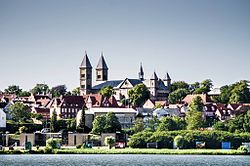 Viborg's cathedral seen from the lake
Viborg's cathedral seen from the lakeViborg, Denmark:
Kentuckian anthropologist Malcolm Lockridge, caught up in a time-war, comes to Viborg in the 1530s in the company of a girl from the far further past, in The Corridors of Time (1965) by Poul Anderson.
In awe, the Neolithic girl asked, "Is the Knossos they tell of as great as that?"
Despite weariness and unease, Lockridge had to grin. To his eyes, sixteenth-century Viborg was like the crossroads town where his parents used to shop. Much prettier, though, especially after two days of heathland. And it promised snugness, now when the last sunlight speared through rainclouds rising blue-black on a wind that flapped his cloak and wistled of winter.
Past the lake, he glimpsed through an oak grove (the beeches had still not driven the king tree out of Denmark) the warm brick hue of an abandoned monastery. Hard by, the city walls retained some green in the grass that covered their lower embankments. The same tinge was given by moss to such of the high-peaked thatch roofs as he could see. Spare and graceful, the cathedral's twin towers reached for heaven.
"I think Knossos may be a little bigger," he said.
the Virginia Capes, Chesapeake Bay, USA:
Ray Cummings' tale of an attack on Earth launched from the (purely fictional) Jovian moon Phorgos, Rain of Fire (Future, August 1942), begins thus:
The first outbreak of the fire-rain occurred in a farming section of the Eastern Atlantic seaboard, not far from the Virginia Capes on the night of June 4th, 2013...
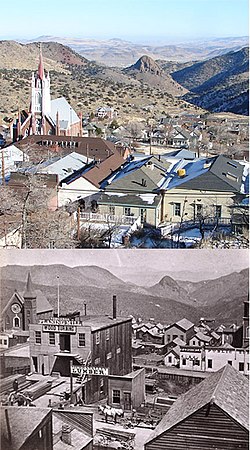 in 2007 (upper) and in the 1870s
in 2007 (upper) and in the 1870sVirginia City, Nevada, USA:
Here we find the hidden headquarters for the revolt against that dicatatorship known as the Protectorate, in Poul Anderson's ironic post-World-War-III political tale, For the Duration (Fantastic Universe, March 1957):
...The Hideout was, of all places, Virginia City, Nevada. I could remember when it was a booming tourist trap, but in this era of scarcity and restrictions, when nobody except the highest officials owned cars, it was a ghost town. A few bearded, half-crazy squatters remained, ignored by the police as harmless, shunned by the rancher and Renoite as unconventional and therefore possibly subversives.
Only... when those grizzled forms had tottered into the underground rooms and joined the several hundred people who never looked on the sun, their backs straightened and their voices grew crisp and they were on the Committee for the Restoration of Freedom...
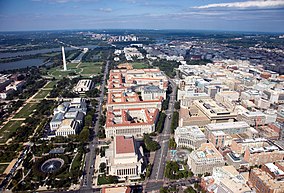
Washington, D.C., USA:
Congressman Wes Dawson is euphoric as he contemplates being allowed into space to meet the alien vessel which is approaching Earth, in Footfall (1985) by Larry Niven and Jerry Pournelle.
Wes strolled quickly through the Federal Triangle and along Independence Avenue. He'd done that often, but he still tended to gawk at the great public buildings along the way. It was all there. Government granite, magnificent buildings in the old classic style, built to last back when America had craftsmen able to compete with the great builders of old Greece and Rome...
Some Martian intruders - in the form of forty-foot decapods - also show interest in the capital's architecture in Leslie F Stone's The Human Pets of Mars (Amazing Stories, October 1936). They finally use the view from one spire to help find their way back to their spacecraft:
...in a body they headed for the Washington Monument, like a finger pointing to the sky. Reaching its foot, one of their number proceeded to climb the obelisk - on the OUTSIDE.
A few minutes later it descended once again, joining its fellows. It had taken bearings, found the drum-ship, and under its leadership, the five others started back for the municipal links, crossing the railed embankment to do so...
A refugee from the year 2498 when the city no longer exists, a young woman is a guest of the President in Our Children's Children by Clifford Simak (1974), while her people are preparing flee far further into thepas.
....Alice Gale stood in the window, gazing across Pennsylvania Avenue to the gathering crowd in the park beyond it. She hugged herself in shivering ecstasy, not daring to believe that she actually was there, that she could be back in twentieth-century Washington, where history had been made, where legendary men had lived, and at this moment in the very room where crowned heads had slept.
Crowned heads, she thought. What an awful, almost medieval phrase. And yet it had a certain ring to it, a certain elegance that her world had never known.
She had caught a glimpse of the Washington Monument as she and her father had been driven into the White House grounds, and out there, just beyond it, a marble Lincoln sat in his marble chair, with his arms resting on its arms and his massive, whiskered face bearing that look of greatness, of sorrow and compassion that had quieted thousands into reverent silence as they came climbing up the stairs to stand face to face with him.
Just across the hallway her father was in the Lincoln Room, with its massive Victorian bed and the velvet-covered slipper chairs. Although, she recalled, Lincoln had never really slept there.
It was history brought back to life, she thought, history resurrected. And it was a precious thing. It would be something to remember always, no matter what might be ahead. It would be something to remember back in the Miocene...
Waukegan, Illinois, USA:
Birthplace of Ray Bradbury, 22 August 1920.
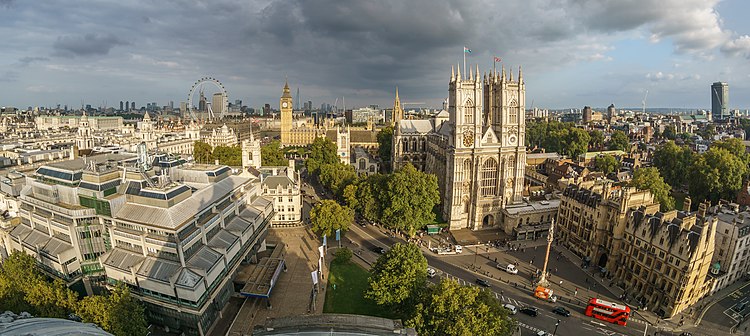
Westminster, Middlesex, England:
The political nerve-centre of Britain has become extremely security-conscious in the 1990s, in Dan Morgan's The Country of the Mind (1975).
The twenty-metre high grey walls of the Westminster Citadel enclosed a rectangular area bounded on the north by Trafalgar Square and Northumberland Avenue, and on the south by Horseferry Road. Its western border cut through part fo what had once been St.James's Park, and on the east the wall followed the line of the river bank, from the Victoria Embankment to Millbank. A fortress enclave within the city, it contained most of the institutions of government including the new Houses of Parliament and all the major ministries, as well as living accommodation for four thousand people. Another five thousand Civil Servants of various grades commuted daily from other parts of the city, entering the Citadel through one of the four gates...
The area is almost deserted in the following passage from Chapter 9 of John Wyndham's post-disaster classic The Day of the Triffids (1951), in which all but a tiny fraction of humanity has been blinded by a burst of artificial satellite-explosions which destroyed the optic nerve. Bill Masen, who escaped this fate through being bandaged in hospital during the fatal night, surveys the desolation.
And so I came to Westminster.
The deadness, the finish of it all, was italicized there. The usual scatter of abandoned vehicles lay about the streets. Very few people were in sight. I saw only three who were moving. Two were tapping their way down the gutters of Whitehall, the third was in Parliament Square. He was sitting close to Lincoln's statue, and clutching to him his dearest possession - a side of bacon from which he was hacking a ragged slice with a blunt knife.
Above it all rose the Houses of Parliament, with the hands of the clock stopped at three minutes past six. It was difficult to believe that all that meant nothing any more, that now it was just a pretentious confection in uncertain stone which could decay in peace. Let it shower its crumbling pinnacles on to the terrace as it would - there would be no more indignant members complaining of the risk to their valuable lives. Into those halls which had in their day set world echoes to good intentions and sad expediencies, the roofs could in due course fall; there would be none to stop them, and none to care. Alongside, the Thames flowed imperturbably on. So it would flow until the day the Embankments crumbled and the water spread out and Westminster became once more an island in a marsh.
Marvellously clear-fretted in the unsmoked air, the Abbey rose, silver-grey. It stood detached by the serenity of age from the ephemeral growths around it. It was solid on a foundation of centuries, destined, perhaps, for centuries yet to preserve within it the monuments to those whose work was now all destroyed...
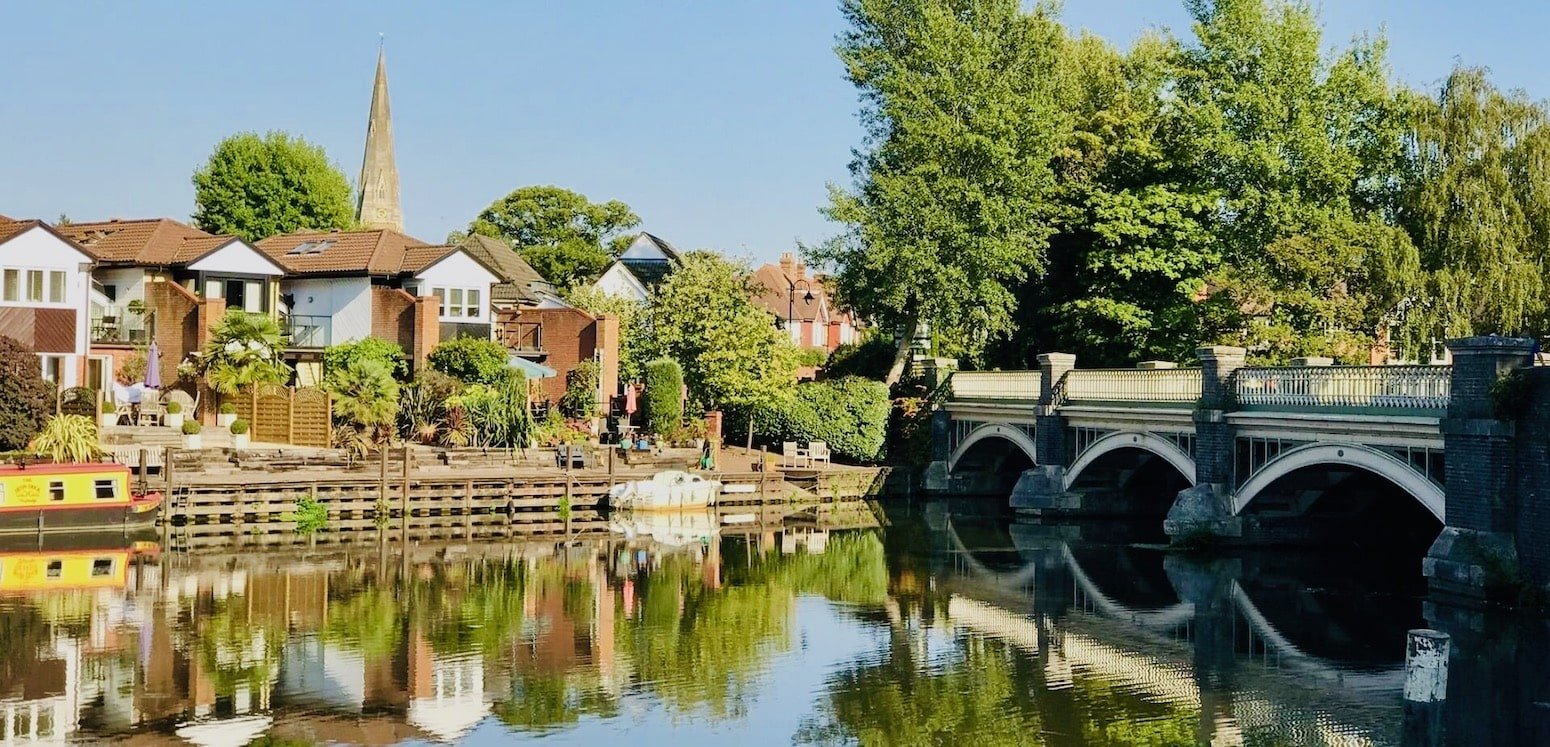
Weybridge, Surrey, England:
Suffered in the Martian invasion described by H G Wells.
Further on towards Weybridge, just over the bridge, there were a number of men in white fatigue jackets throwing up a long rampart, and more guns behind.
"It's bows and arrows against the lightning, anyhow," said the artilleryman. "They 'aven't seen that fire-beam yet..." The War of the Worlds (1898).
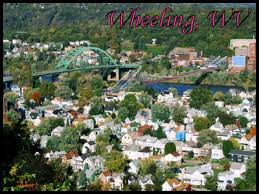
Wheeling, West Virginia, USA:
Chapter One of Pohl and Kornbluth's classic 1959 novel Wolfbane opens in this town, in the early 23rd century, when for the past two hundred years Earth has been stolen from the Solar System and is being dragged through interstellar space by the intruding planet which is now its binary. Wheeling is mostly populated by "sheep" - meek people who comprise the majority of what's left of humanity; who shuffle through life on a minimum-calorie diet... though an occasional "wolf" shows up.
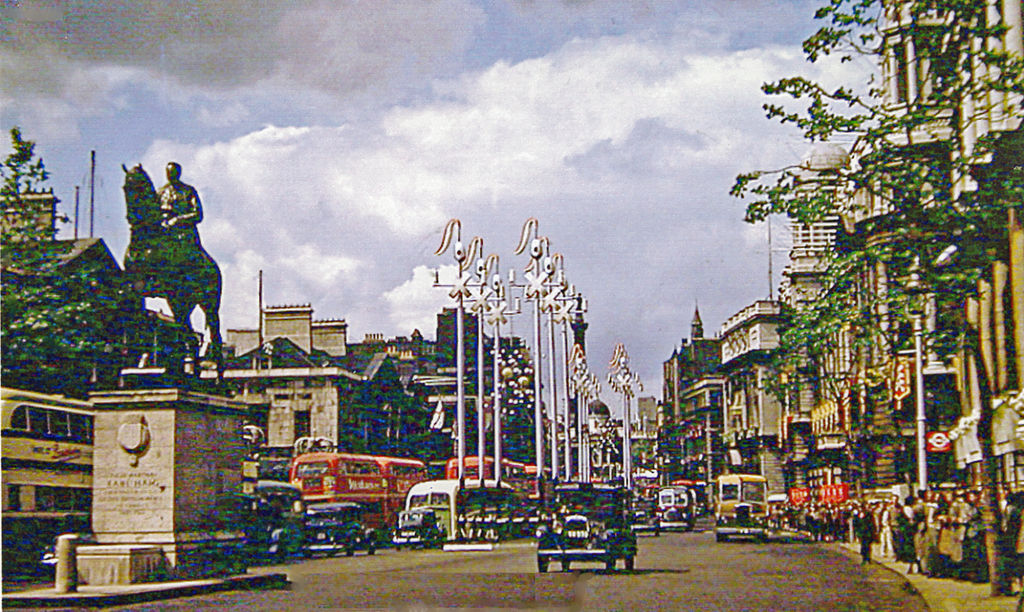 in 1953
in 1953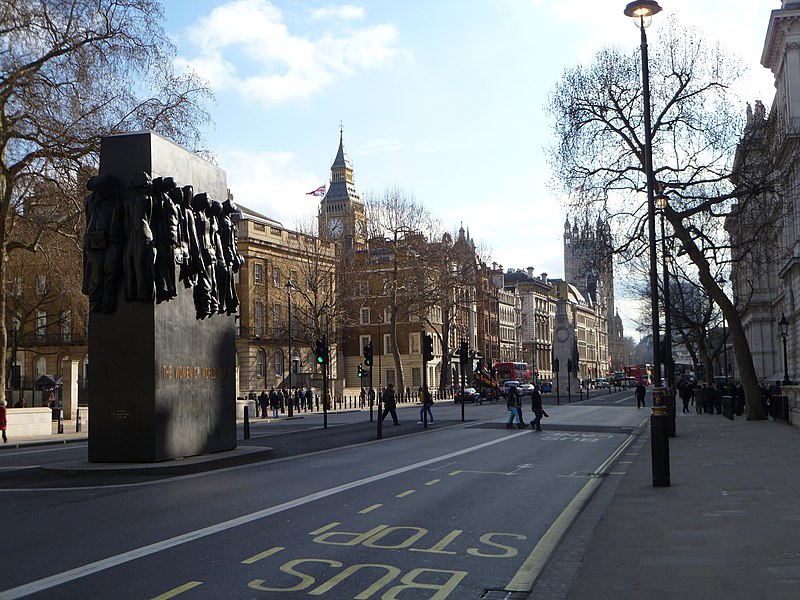 in 2012
in 2012Whitehall, London, England:
From the climate-warfare novel White August (1955) by John Boland:
...The Prime Minister had also decided on new quarters for himself. A bedroom and study had been fitted out for him, just off the War Room, one hundred and forty feet below street level in Whitehall. His study opened directly off the huge map room, whose walls were covered by gigantic maps of every country and every sea and ocean in the world. On the opposite side of the map room a steel lined door led to the communications room...
...Warburton returned to the map room and walked round the gigantic plotting-table. The table, fifty feet by forty feet, had an outline of the British Isles upon its glass surface. This was the room from which the Battle of the Atlantic had been fought in World War II. Now it was destined to be the nerve-centre of a new, more deadly struggle...
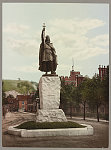 the King Alfred statue, High Street, Winchester
the King Alfred statue, High Street, WinchesterWinchester, Hampshire, England:
Luke Perry is the headstrong heir-apparent to his father who rules the town in the post-disaster novel The Prince in Waiting (1970), volume one of a trilogy. Author John Christopher, in narrating Luke's story, allows us snapshots of Winchester in that future era.
Winter ended at last in a thaw accompanied by rain-storms which made the river flood its banks; the waters rose at one point to lap against the block of stone in the High Street which still carried the broken legs of what had been a statue - of a great Prince of ancient times, it was said...
In the same novel, what are presumably the remains of the Cathedral are described simply as The Ruins.
[Personal note: I saw the Alfred statue and visited the Cathedral when looking around Winchester in the late 1980s, on the occasion of an unsuccessful job-application.]
The same author, in his climate-disaster novel The World in Winter (1962), briefly describes the town as the Nigerian expedition passes through:
...The squadron pushed on in the afternoon, north-east in the direction of London. They followed the Itchen valley to Winchester, where they saw the first signs of human life in England. Figures moved across the snow at the edge of the town. They fled to the cover of the buildings when Mutalli diverted the squadron towards them...
Winchester is the location of a scene in Susan Cooper's Mandrake (1964) in which the dissident Dr Queston has an interview at the office of the sinister Ministry of Planning, an organization unwittingly doing the will of the malevolent Planetary Intelligence.
...Queston was in a lofty, echoing hall with thick wooden beams spanning the roof. He saw, hanging on the front wall, the painted wooded circle that was Winchester's Table of King Arthur, and remembered his first sight of that spurious piece of enchantment when he was a boy. He remembered the hall from those days, too, splendid and mysterious; it had been the seat of the county assize court. It was not a courtroom now...
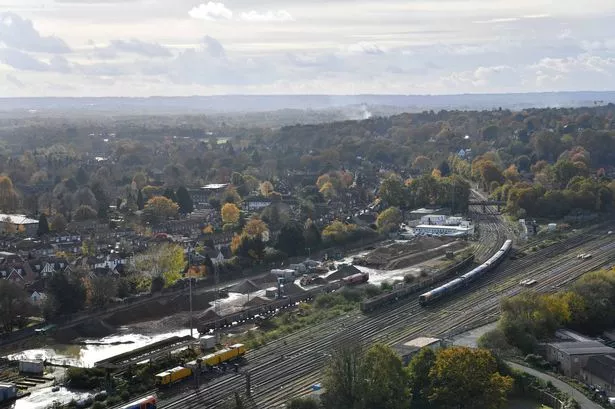
Woking, Surrey, England:
This is where the first Martian invasion-cylinder landed in H G Wells' The War of the Worlds (1898). For the immediate scene of the landing see Horsell Common. But the scene where the narrator first sees a Martian tripodal Fighting Machine, amid a storm of lightning, is Maybury Hill. For pictures of that, see the online cycle guide which is illustrated with scenes as Wells would have known them.
...At first I regarded little but the road before me, and then abruptly my attention was arrested by something that was moving rapidly down the opposite slope of Maybury Hill. At first I took it for the wet roof of a house, but one flash following another showed it to be in swift rolling movement. It was an elusive vision - a moment bewildering darkness, and then in a flash like daylight, the red masses of the Orphanage near the crest of the hill, the green tops of the pine-trees, and this problematical object came out clear and sharp and bright.
And this thing I saw! How can I describe it? A monstrous tripod, higher than many houses, striding over the young pine-trees, and smashing them aside in its career; a walking engine of glittering metal, striding now across the heather; articulate ropes of steel dangling from it, and the clattering tumult of its passage mingling with the riot of the thunder...
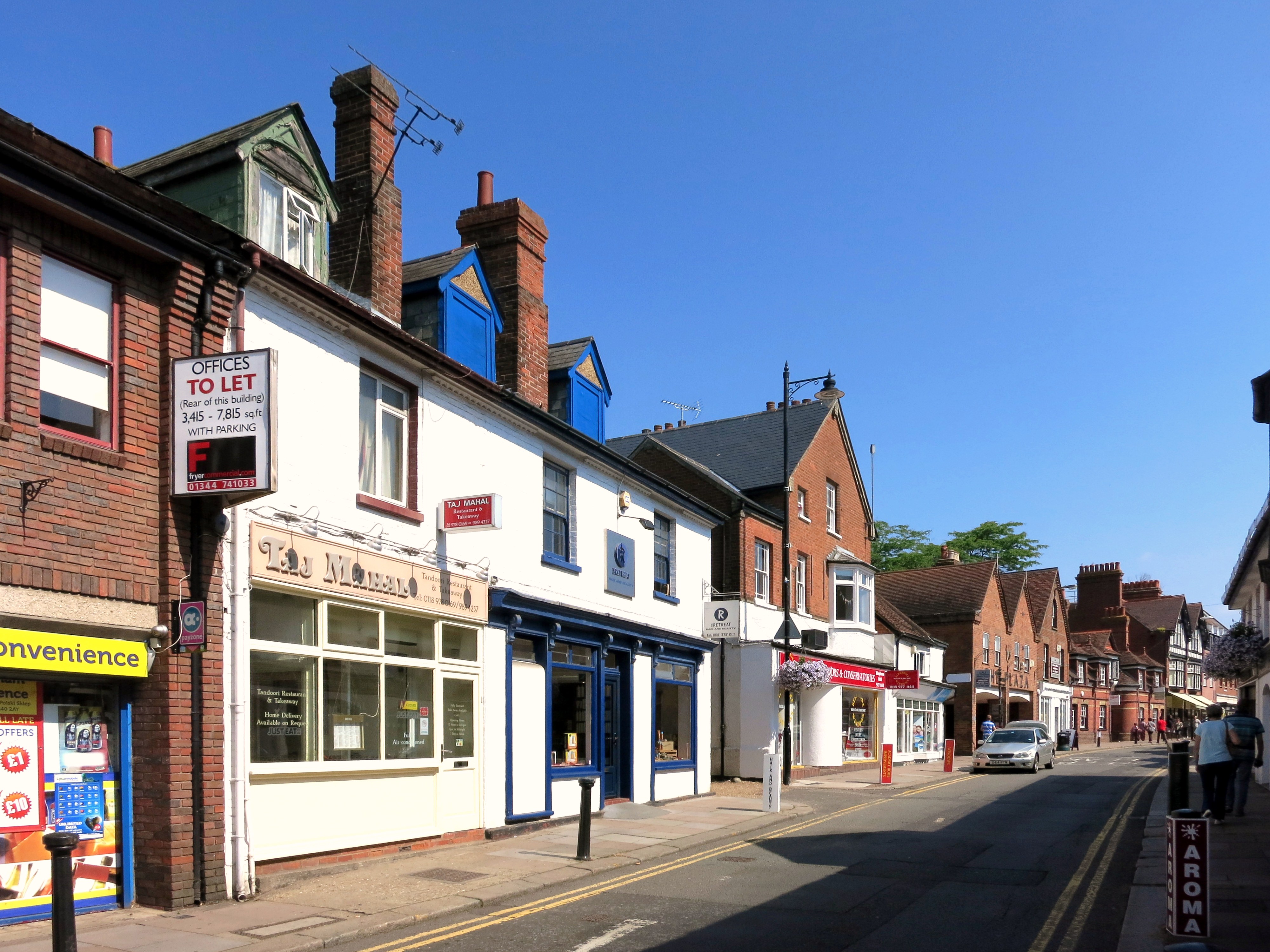
Wokingham, Berkshire, England:
The narrator of M P Shiel's The Purple Cloud (1901) has returned from a mysterious polar expedition to find people lying dead all over the place, the world's population having apparently succumbed to a mysterious gas; he passes through Wokingham on his way to London.
...There I slept on a mat in the passage of a tavern named The Rose, for there was a mad Russian-looking man with projecting teeth on a bed in the house, whose appearance I did not like, and I too tired to walk further...
Woomera, South Australia:
Launch site of the first manned space-rocket (a sub-orbital flight) in Hugh Walters' Blast Off At Woomera (1957) and of the first manned rocket (to Mars) in Rex Gordon's No Man Friday (1956). See also The Old Space Program.
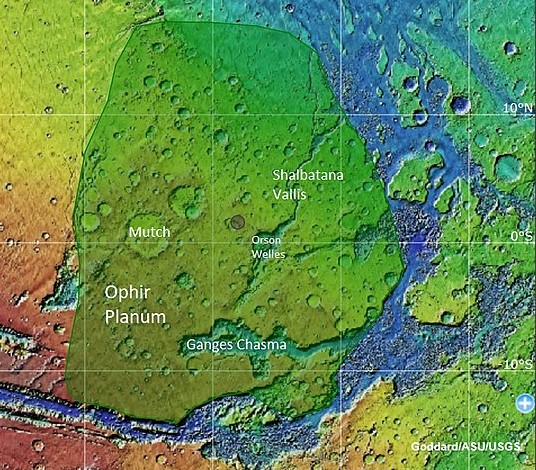
Xanthe:
In The Sands of Mars (1951) by Arthur C Clarke, this region of Mars is mentioned as a natural resource of magnesium for the colony:
"...The best source of that's the old sea bed: there are some salt flats a hundred metres thick out in Xanthe and we just go and collect when we need it."
Note: I've been trying, and failing, to find evidence to identify the "Xanthe" of the above quote with the "Xanthus" of Weinbaum's A Martian Odyssey - the place where the narrator meets the barrel-creatures. "Xanthus", an old telescopic albedo feature, is given online as being at 45 South, 125 East; Xanthe Terra at 3 North, 312 East. Not much relation. It is tentatively identified as an "orange desert" on the second page of the story:
"A hundred and fifty miles south," continued Jarvis imperturbably, "the surface changed to a sort of low plateau, nothing but desert and orang-tinted sand. I figured that... this grey plain we dropped on was really the Mare Cimmerium which would make my orange desert the region called Xanthus..."
In Terwilliger and the War Machine by Evan Hunter (Universe, September 1954) the Battle of Xanthe is an engagement in a war between Earth and Mars, in which Private First Class Terwilliger Appleby is captured by the Martians. It turns out that the Terran soldier has a phenomenal memory and vast administrative ability, and the loss of his talents is something the Terran forces must somehow make good.
Xanthus:
See: Xanthe
Yarborough, Lincolnshire, England:
In the second volume of Dan Morgan's tetralogy about a community of telepaths, a working-class journalist has problems with his post in-laws.
Jerry Coleman eased his foot off the accelerator, as he recognised the familiar, tree-lined avenue. London Road was traditionally the 'better end' of Yarborough. Most of the big houses that stood on either side of the highway behind tall hedges were forty or fifty years old, built in the days of cheap domestic labour and gracious living for the privileged few. This was the secure, upper middle-class environment in which Sue had spent her childhood, and as such she was naturally at her ease here. He, on the other hand, found the very sight of these houses an inhibiting influence. In such surroundings his accent thickened, his limbs seemed to become automatically oversize, and he was once more the engine driver's son from the council houses on the wrong side of the gas works...
- The Several Minds (1969)
Youngstown, Ohio, USA:
Birthplace of Edmond Hamilton, 21st October 1904.
Zürich, Switzerland:
In Philip K Dick's Ubik (1969) Zürich is the location for the Beloved Brethren Moratorium, an institution whither you can go to visit your dear departed who are kept in transparent caskets, "encased in an effluvium of icy mist" in a state of "half-life", that's to say, of gradually dwindlling post-mortem consciousness.
